• Athens • Mykonos • Greece
• All destinations
• Santorini – favorite hotels
• Santorini – favorite towns
• Santorini – favorite beaches
• Santorini – favorite restaurants
• Santorini maps
• Santorini buses
• Santorini ferry port
• Santorini airport
• Santorini things to do
• dave@santorinidave.com
Santorini Travel Guide
Last updated: June 7, 2025

The view of Oia from Skaros Rock in Imerovigli, Santorini. The hike along the caldera is my favorite thing to do in Santorini.
Santorini is the most spectacular island in Greece and one of the geologic treasures of Europe. The five villages of Fira, Oia, Imerovigli, Firostefani, and Akrotiri sit atop the caldera and offer spectacular views into the crater created from a 16th-century BC volcanic eruption. What remains is an incredible sight and a magical setting for island hikes, infinity pools, luxury hotels, clifftop wineries, and dreamy sunset dinners.
Santorini Basics
Santorini Hotels
- Best Hotels in Santorini
- Best New Hotels in Santorini
- Best Cheap Hotels
- Best Beach Hotels
- Best Luxury Hotels
- Best Villas & Rentals
- Best Boutique Hotels
- Best Hotels for Families
- Hotels with Caldera Views
- Best Honeymoon Hotels
- Hotels with Private Pools
- Hotels with Sunset Views
- Cave Hotels
- Wheelchair Accessible Hotels
- Hotel Infinity Pools
- Cheap Hotels with Caldera View
- All-Inclusive Hotels
- Fira Hotels
- Oia Hotels
- Imerovigli Hotels
- Firostefani Hotels
- Perissa & Perivolos Hotels
- Kamari Hotels
- Megalochori Hotels
- Pyrgos Hotels
- Akrotiri Hotels
- Airbnbs in Santorini
- Santorini Hotel Reviews
Santorini Activities
- Best Things to Do
- Best Restaurants
- Best Bars & Nightlife
- Wineries & Wine Tours
- Museums and Cultural Sites
- Fira to Oia Hike
- Skaros Rock Hike
- Santorini Walking Tours
- Santorini with Kids
- Santorini Private Tours
- Photography Tours
- Boat Tours
- Jet Ski Tour
- Scuba Diving
- Open Air Cinema in Kamari
- Ancient Ruins of Akrotiri
- Ammoudi Bay
- Santorini Views
- Santorini Coloring Pages
Santorini Trip Planning
- Where is Santorini?
- How to Get to Santorini
- Santorini Holidays: Planning a Trip
- First Time: Where to Stay in Santorini
- Ferry Port Guide
- Airport Guide
- Getting Around by Bus
- Renting a Car
- Santorini Taxis
- Athens to Santorini by Ferry
- Mykonos to Santorini by Ferry
- Crete to Santorini by Ferry
- Santorini Helicopter Tours & Transfers
- Day Trips to Santorini
- Santorini Travel Agencies
- Santorini Vacation Packages
- Weddings & Reception Parties
- Cruises to Santorini
- Santorini Cruise Excursions
- 1, 2, 3, & 7 Days in Santorini
Latest Articles & My Travel Newsletter
Frequently Asked Questions about Santorini
See Also: Greece: Tips & Information for First-Timers
How Many Days Do I Need to Explore Santorini Properly?
For a quick taste of Santorini’s iconic beauty, plan on at least 3 full days (4 nights) to catch the greatest hits without sprinting between sights. Two nights is possible in a pinch, but you’ll spend half your time negotiating ferries, flights, and hotel check‑ins rather than soaking up caldera views. To truly experience the island’s diverse offerings – caldera walks, boat trips, beaches, Akrotiri, and maybe a winery – without feeling overly rushed, 4 to 5 days is the ideal sweet spot for most visitors. If you’d prefer a deeper dive and a more relaxed pace, allowing ample time for beach days, winery rambles, and exploring the charming inland villages, then a full week is fantastic.
2-3 full days: The essentials
This timeframe covers the absolute must-sees and gives you a strong taste of Santorini’s magic. It makes sense as part of a larger island-hopping itinerary.
• With 2 days: Focus on the caldera edge. Explore Fira, walk part of the caldera path towards Firostefani and Imerovigli for stunning views, and dedicate an afternoon/evening to Oia for exploration and the famous sunset. You might squeeze in either the Akrotiri archaeological site or a caldera boat tour.
• With 3 days: You have a bit more breathing room. You can comfortably cover Fira, Oia (including the sunset), visit Akrotiri, and take a caldera boat tour or a sunset cruise. You could even attempt the Fira-Oia hike on one of the days (start early) or visit a winery briefly.
• The Reality: It will feel hurried, especially with just 2 days. You’ll likely miss the inland villages and have limited time for beaches or just relaxing. Prioritize your absolute must-dos.4-5 full days: The sweet spot
This is often the ideal duration for a first visit, balancing sightseeing with some relaxation.
• You can comfortably explore the main caldera towns: Fira, Oia, Imerovigli, and Firostefani.
• Dedicate a morning to the full Fira to Oia caldera hike (approx. 10km, 3-4 hours).
• Enjoy a caldera boat tour – sailing to the volcano, swimming in hot springs, seeing the caldera cliffs from below. Sunset cruises with dinner are appropriately popular.
• Thoroughly explore the Akrotiri archaeological site. Combine it with a visit to the nearby Red Beach.
• Spend time at the black sand beaches like Perissa or Kamari.
• Visit one or two wineries for tastings (Santorini’s Assyrtiko is unique). Venetsanos has the best views.
• Explore at least one inland village like Pyrgos for its traditional architecture and panoramic views.
• You’ll have time for leisurely meals, browsing boutique shops, and finding different spots to enjoy the sunset without feeling constantly on the move.7+ full days: In-depth exploration & relaxation
A full week allows you to truly immerse yourself in Santorini and explore beyond the main tourist trail at a relaxed pace.
Do everything mentioned in the 4-5 day plan without rushing.
• Explore multiple inland villages: Pyrgos, Emporio (with its intricate castle), Megalochori (charming traditional village).
• Visit several different beaches: Red Beach, Perissa, Kamari, Vlychada (with its unique wind-carved cliffs), maybe even quieter spots like Katharos near Oia.
• Consider a cooking class focusing on Santorini specialties.
• Visit the Museum of Prehistoric Thera in Fira.
• Hike to Ancient Thera (ruins atop Mesa Vouno mountain, accessible from Kamari or Perissa).
• Take a day trip ferry to the neighboring island of Thirassia to see a quieter side of the caldera.
• Revisit favorite spots – perhaps explore Oia in the quiet morning light, or enjoy another sunset from a different viewpoint.
• Plenty of time for relaxing by your hotel pool, enjoying long lunches, and simply soaking up the atmosphere. You could even fit in a sea kayaking tour.My personal recommendation:
While 2-3 days lets you tick off the iconic sights, you’ll likely leave wanting more. 4-5 days remains my top recommendation for a first-time visitor to get a well-rounded experience that balances the must-dos with time to relax and enjoy. However, if you have the time and desire to explore more deeply, unwind properly, and see beyond the caldera highlights, a full 7 days on Santorini will not feel too much.
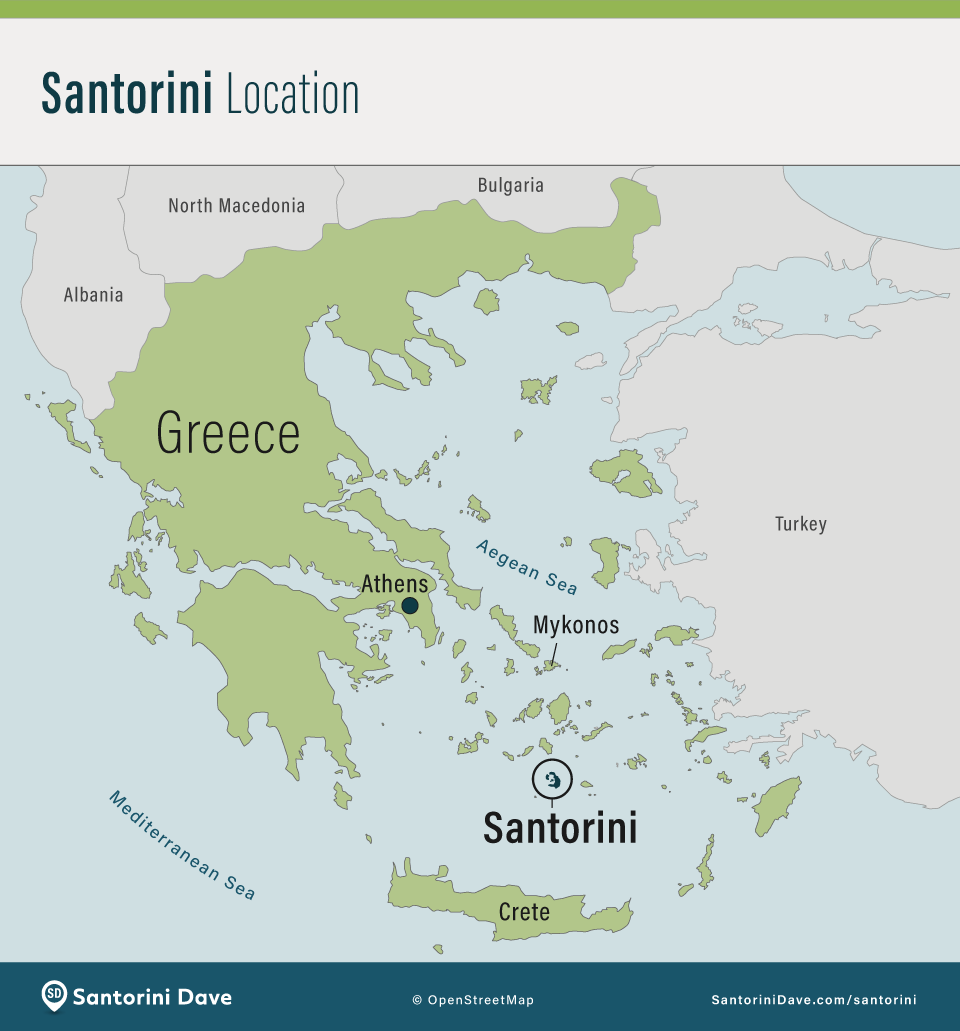
What’s the best way to get to Santorini – fly or take a ferry?
There are multiple daily Athens to Santorini ferries (4.5 to 6 hours by highspeed ferry). The islands of Naxos, Paros, Ios, Milos, Folegandros, Mykonos, and Crete (1 to 3 hours) will have direct ferries from April to early November, and sometimes year-round for Naxos and Paros. Flights from Athens to Santorini take less than 1 hour, direct flights from western Europe (London, Paris, Amsterdam, Rome, Venice) take 2 to 4 hours.
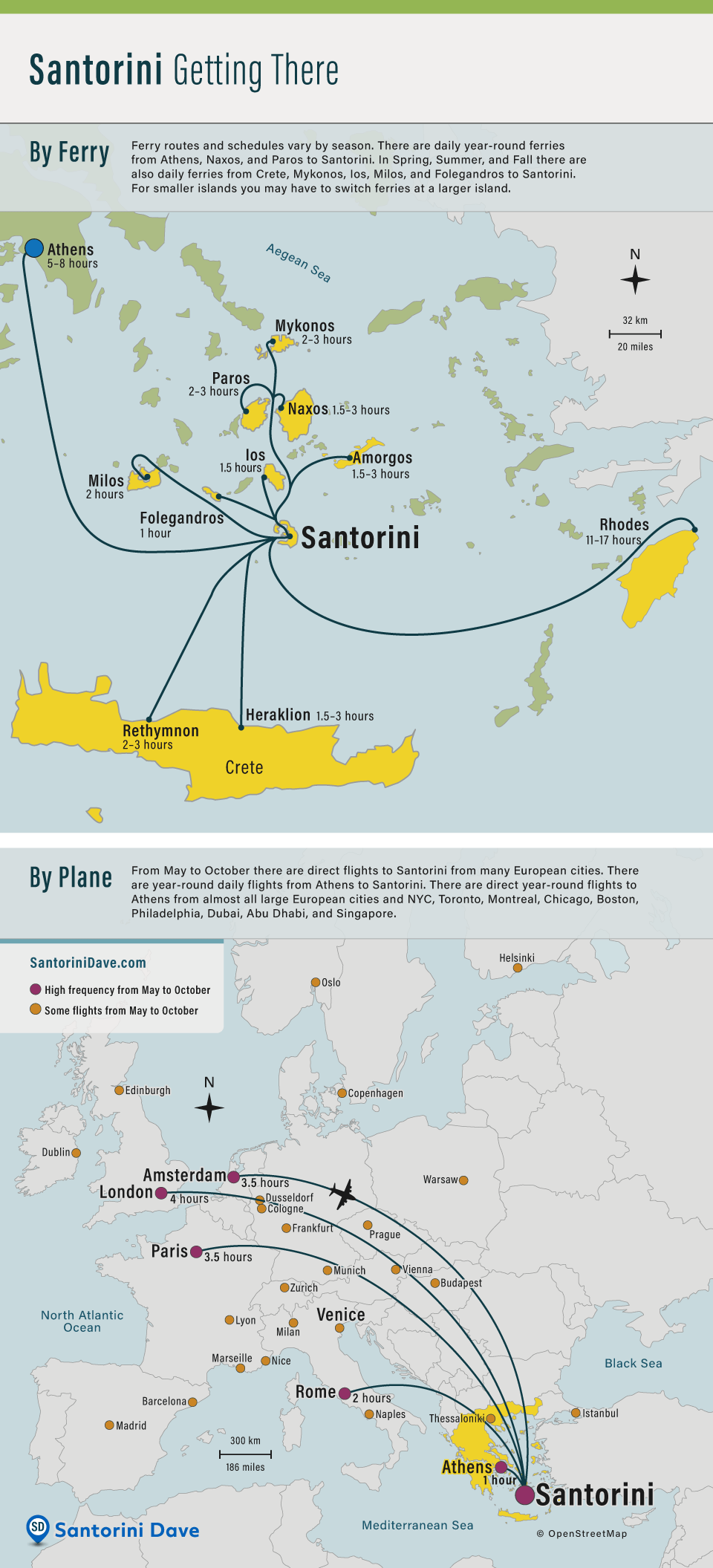
Fly to Santorini if…
• Speed is your absolute number one priority: A flight from Athens takes only about 45-50 minutes compared to 4 to 6 hours by ferry.
• You prefer the general predictability of flight schedules and the convenience of a quick flight outweighs the desire for the iconic sea arrival into the caldera. Flights are rarely canceled due to sea conditions, unlike ferries.
• You’re connecting directly from an international flight: Arriving at Athens Airport (ATH) makes hopping onto a domestic flight to Santorini (JTR) very efficient.
• You’re traveling directly from another European city: Many cities (most commonly London, Paris, Rome, and Amsterdam) offer direct seasonal flights, bypassing Athens altogether.
• You have very limited time on your overall trip: Maximizing your hours on Santorini might outweigh the travel experience itself.
• You strongly dislike sea travel or suffer from severe seasickness: Flying guarantees avoiding the water (though large conventional ferries are usually quite stable).
• Airport logistics seem easier for your mobility needs: Airports are generally predictable environments compared to the potential chaos, bustle, and uncertainty of the ferry ports. The Santorini port, in particular, can be complete chaos when multiple ferries arrive at the same time.Ferry to Santorini if…
• You are island hopping: Ferries are the primary (and often only) way to travel between Santorini and other islands like Mykonos, Naxos, Paros, Crete, Ios, Milos, etc.
• You want the truly spectacular, iconic sea arrival: Sailing into the caldera is breathtaking – choose a conventional ferry (like Blue Star) for open decks to fully enjoy it.
• You are traveling on a tighter budget: Conventional ferries from Athens are usually the most cost-effective option.
• You enjoy a slower, more relaxed pace of travel: The ferry journey itself can be part of the Greek island experience.
• You have a lot of luggage: Rolling suitcases onto a ferry is generally much simpler than dealing with airline baggage restrictions and fees. Bring as much luggage as you can carry, ideal for extended stays.
• You’re starting from central Athens: The Piraeus ferry port is easily accessible via the metro, making the journey straightforward.
• You want the classic Greek island travel atmosphere: Ferries are an integral part of Greece’s island culture. Even in high season locals make up a healthy percentage of ferry travelers. Ferries have cafes, decks, and seating areas, great for meeting travelers.
• You are traveling with a vehicle or a pet: Car ferries are available and are the only option if you need to take a car to the island. Most ferries allow pets in designated areas.
• You prefer to avoid airport check-in lines and security procedures: Ferry boarding is generally a faster, simpler process.
How big is Santorini?
Santorini has a population of 15,500 and a land area of 76 square kilometers (an area a little bigger than Manhattan). The length of the island is 16 km and its width varies from 1 to 5 km. It takes 45 minutes to drive from one end of Santorini to the other.
What is the best way to get around Santorini?
Santorini may look pocket‑sized on a map – barely 18 km tip to tip – but getting around is rarely as quick as the distances suggest. A single cliff‑top road links the caldera towns (Fira, Firostefani, Imerovigli, Oia) along the western edge of the island; a newer wider road runs along the east coast and links Fira to Oia – but bypasses Firostefani and Imerovigli. Pretty much everything else spins off into narrow switchbacks that drop to beach settlements or wind through farmland. In July and August the main caldera road crawls with tour buses, ATV convoys, and rental cars hunting for nonexistent parking, so the “best” mode of transport often changes by time of day and which corner of the island you plan to explore. First‑timers based along the caldera can cover most sights with the excellent public bus network and the occasional taxi or hotel shuttle. Add a one‑day or two-day car rental if you want to visit outliers like Akrotiri’s lighthouse, a trio of wineries, and the quieter inland villages. Confident riders sometimes swap the car for a scooter or ATV, but recent police crackdowns and a spike in accidents make two‑wheels a choose‑carefully proposition. In short: arrange a transfer on arrival, rely on buses within the central corridor, and rent a compact car only for the day or two you roam farther afield.
Your main options:
1. Rental Car
• Pros: This is often the most comfortable and flexible way to see the entire island at your own pace. You get air conditioning (a lifesaver in summer), space for luggage or beach gear, and the freedom to explore hidden gems beyond the main tourist hubs. It’s the safest option among self-drive vehicles. Great for families or those wanting to visit wineries, quieter beaches, and archaeological sites like Akrotiri or Ancient Thera without relying on bus schedules.
• Cons: Parking can be a real headache, especially in popular towns like Fira and Oia during high season. The roads can be narrow, winding, and busy with buses, ATVs, and scooters sharing the space. Rental costs (plus fuel) are higher than the bus.
Need to Know: An International Driving Permit (IDP) is no longer required to rent a car in Greece though it’s still good to have if you ever get in an accident.
• Book well in advance, especially for automatic transmission cars, as they are less common and in high demand.
• The airport is the easiest place to pickup a rental car.
• Recommendation: A great choice if you prioritize flexibility, comfort, and plan extensive exploration beyond the main caldera towns.2. ATV / Quad Bike
• Pros: Super popular and can be a fun way to get around. Easier to park than a car. Good for accessing some areas with rougher roads (though main roads are paved). Offers an open-air experience.
• Cons: Safety is a major concern. ATVs offer little protection in an accident, and Santorini’s roads (narrow, busy, steep, sometimes dusty with unclear junction rules) see numerous ATV accidents, some serious. (I’m aware of 5 ATV-related deaths on Santorini in the last 10 years. All tourists.)
• Daily rates are often around €30-€50.
• Recommendation: While popular for the “fun factor,” I strongly advise caution. Not recommended for nervous drivers or long distances.3. Scooter / Moped
• Pros: The cheapest rental option, very easy to park, and fuel-efficient. Can navigate narrow village streets easily.
• Cons: A high-risk option. Scooters offer zero protection, are less stable than ATVs (especially on windy days or uneven surfaces), and struggle on steep hills. Not practical for luggage. Intense sun and dust exposure. Accidents are unfortunately common.
• Need to Know: Helmet use is legally required.
• Recommendation: I advise against renting a scooter unless you are a very experienced rider and are fully aware of the significant risks involved on Santorini’s roads. There are safer ways to enjoy the island.4. Local Bus (KTEL)
• Pros: By far the cheapest way to get around, with tickets typically costing €1.80 – €2.50 per ride (cash only, pay onboard or just before boarding). The buses are modern, air-conditioned, clean, and reliable (especially on main routes in high season). They connect all the main towns and beaches (Fira, Oia, Kamari, Perissa, Akrotiri, airport, ferry port). Allows you to relax and enjoy the views without worrying about driving, parking, or alcohol consumption. Eco-friendly!
• Cons: All routes radiate from the central hub in Fira. This means if you want to go from, say, Oia to Kamari beach, you must take a bus from Oia to Fira, then change (and buy another ticket) for a bus from Fira to Kamari. This can be tiring and time-consuming. Buses can get very crowded, especially on popular routes (like Fira-Oia), especially after sunset in Oia. Schedules are less frequent in the shoulder/off-season, and while generally reliable in summer, minor delays can happen due to traffic. Stops aren’t always clearly marked in less central areas.
• Need to Know: Check the latest schedules at the Fira bus station, as they change seasonally (and daily for the ferry port route). Keep small change handy for tickets. Be prepared for standing room only on busy routes.
• Recommendation: An excellent, budget-friendly option, especially if you’re staying in or near Fira, or primarily plan to visit the main towns and beaches.5. Taxis
• Pros: Offer door-to-door convenience. Faster than the bus for most routes.
• Cons: Very limited supply – there are only around 40 taxis serving the entire island. This means they can be extremely difficult to find, especially during peak hours, at night, or when multiple ferries/flights arrive. They are expensive, with fixed rates for routes (no meters) that are often high (€35-€55 for airport/port to Oia/Fira is common). You should agree on the price beforehand. Getting one on demand can involve long waits at taxi stands (main ones are in Fira and Oia, plus airport/port). Strict 4-passenger limit. Usually cash only.
• Need to Know: You can try calling the central taxi station (+30 22860 22555), but pre-booking (often via your hotel or a transfer service) is more reliable than hailing one.
• Recommendation: Okay for a quick, specific trip if you happen to find one easily, but don’t rely on taxis for general sightseeing or timely airport/port connections unless pre-booked well in advance.6. Pre-booked Transfers / Private Car Service
• Pros: The most reliable and stress-free option, particularly for airport and ferry port arrivals and departures. You book in advance for a fixed price, and a driver meets you (often with a sign). Vehicles are usually comfortable minivans or cars with A/C. Avoids taxi queues and uncertainty. Great for groups or families with luggage.
• Cons: More expensive than renting a small car or taking the bus, though often comparable to or even better value than trying to get a taxi on the spot, especially for longer distances or groups.
• Need to Know: Welcome Pickups is what I use, which has online booking with fixed prices. Many hotels can also arrange transfers.
• Recommendation: Highly recommended for your arrival and departure transfers to/from the airport or ferry port – it just makes things smooth and easy after your journey. Also a good option for specific point-to-point trips if you value comfort and reliability over cost.My Recommendations
• Arrival/Departure: Use a pre-booked transfer (Welcome Pickups) for maximum ease and reliability.
• Main Towns/Beaches: Use the local bus (KTEL) for cheap and relatively easy travel between Fira, Oia, Kamari, Perissa, Pyrgos.
• Full Island Exploration: Rent a small car if you want the freedom to explore the whole island, visit wineries, find secluded spots. Approach parking challenges with a large store of patience.
• ATVs/Scooters: Only for experienced riders who prioritize the thrill over comfort and safety.
• No matter how you choose to get around, book rentals and transfers ahead of time if traveling during peak season (June-September), and never drive a car, ATV, or scooter if you’ve had anything with alcohol.There will always be a public bus to meet all arriving ferries. Buses in Santorini are comfortable, cheap, and have plenty of room for luggage.
What is the best time of year to visit Santorini?
This is one of the most common questions I get, and the honest answer is: it depends on what you’re looking for. But for most people aiming for that perfect balance of great weather, manageable crowds, and having everything open, there’s a definite sweet spot.
My Personal Recommendation: The Shoulder Seasons
If I had to pick the absolute best times, I’d say late May, June, September, or early October. Why? You get the best combination of factors:
• Fantastic Weather: Days are reliably sunny and warm, perfect for exploring and lounging, but usually without the intense peak summer heat.
• Warm Seas (Mostly): The Aegean Sea has had time to warm up by June, and it stays beautifully warm through September and often into early October – ideal for swimming. Late May is getting there, but might still feel ‘refreshing’. April sea temps are generally too cool for comfortable swimming.
• Fewer Crowds: While still popular, these months see significantly fewer people than the absolute peak of July and August. You’ll find it easier to navigate Oia’s pathways, get photos without a hundred other people in them, and find spots at viewpoints.
• Good Value: Prices for hotels and sometimes flights are generally lower than in July and August, though demand is still high, so booking ahead is smart.
• Everything’s Open: Restaurants, shops, tours, beach clubs – they are all generally up and running, especially from June to September.Peak Season: July & August
• Weather: Hot, sunny, and dry. Average highs hover around 26-29°C (79-85°F). The Meltemi wind can blow, which helps temper the heat but can sometimes make seas choppy. Guaranteed beach weather.
• Crowds: Maximum capacity. Expect packed villages (especially Oia for sunset), busy beaches, and fully booked popular restaurants and tours.
• Cruise ships add thousands of day-trippers. It’s buzzing and energetic, but can feel overwhelming.
• Prices: Peak season means peak prices for accommodation and flights. Book months in advance.
• Nightlife: Everything is open and lively, from the beach clubs in Perivolos and Perissa to the bars and clubs in Fira. The island buzzes late into the night.
• Best For: Sun worshippers, beach lovers, those seeking vibrant nightlife, travelers restricted to school holidays.Shoulder Seasons: April-June & September-October
• Weather: Generally excellent.
• Spring (April-May): Temperatures are milder (around 16-23°C / 61-73°F), the island is greener after winter rains, and wildflowers are blooming. Evenings can be cool. Sea is still warming up (cool in April, potentially swimmable in early May). Higher chance of occasional rain shower than in summer/fall.
• Fall (Sept-Oct): Often considered ideal. Warm days (21-26°C / 70-79°F), the sea is at its warmest from the summer sun, and skies are usually clear. Crowds thin out noticeably as October progresses.
• Crowds: Busy, especially May, June, and September, but much more manageable than July/August. April and October feel significantly quieter.
• Prices: Better value than peak summer. Good deals can be found, especially in April and late October.
• Nightlife: Most places are open, especially May-September. Things start winding down in October, but Fira stays active into November.
• Best For: Sightseeing, hiking, photography, swimming (esp. June, Sept, Oct), honeymoons, finding a balance between good weather and fewer crowds. This is generally the best time for most visitors.Off-Season: November – March
• Weather: Cool, damp, and can be windy. Average highs are around 12-14°C (54-57°F). Rain is more frequent, especially December-February. There will be sunny days, but they aren’t guaranteed.
• Crowds: Minimal. You’ll often have viewpoints and sites almost to yourself. It’s incredibly peaceful.
• Prices: Lowest hotel rates of the year. Flights can also be cheaper.
• Nightlife: Very quiet. Most tourist-focused bars, clubs, and many restaurants are closed. Fira has some year-round local spots.
• Activities: Swimming is off the table. Focus on sightseeing (check reduced winter hours), hiking (if the weather cooperates), enjoying the dramatic views, photography, and experiencing a more local, tranquil vibe.
• Best For: Budget travelers, those seeking solitude, photographers wanting dramatic, crowd-free shots, experiencing local life. Keep in mind ferry schedules are reduced.Specific Interests:
• Best Weather: June to September for consistent heat and sun. May and October for pleasant warmth.
• Swimming: Late June through September is prime time. Late May and early October are usually good too.
• Sightseeing & Hiking: April, May, September, and October offer the most comfortable temperatures for walking around ancient sites and tackling the Fira-Oia hike.
• Avoiding Crowds: November to March. Or, aim for April or late October in the shoulder season. Even in busy months, visiting popular spots early morning (before 10 am) helps.
• Saving Money: November to March offers the biggest savings. April, May, and October offer a good balance of decent weather and better prices than summer. Avoid Oia for the best deals; look at Fira, Firostefani, Imerovigli (caldera views) or Kamari/Perissa (beach towns).
• Nightlife: July and August for the peak party scene. June and September are still very lively. April, May, October, and early November have options, but mainly in Fira.
• Honeymoon: September is fantastic – romantic sunsets, warm sea, great vibe but fewer crowds than summer. June is also a prime choice. May and October are lovely for a quieter, more relaxed romantic getaway (consider a hotel with a heated plunge pool if swimming is a priority in these months).Final Thoughts:
While Santorini is captivating year-round, the shoulder seasons – particularly June and September – strike that near-perfect balance for weather, activities, swimming, and atmosphere without the peak summer intensity and prices. Late May and early October are excellent runners-up, especially if you prioritize value and fewer people over guaranteed hot swimming weather.Santorini does not have the best beaches in Greece – they’re mostly pebble beaches – but the swimming is divine.
What are the main towns in Santorini?
The towns of Fira, Oia, Firostefani, Imerovigli, and Akrotiri cling to the 300m cliffs and have magical views of the caldera and volcano to the west. The beach towns of Kamari, Perissa, Perivolos, and Agios Georgios are on the east and south sides of the island (not the caldera).
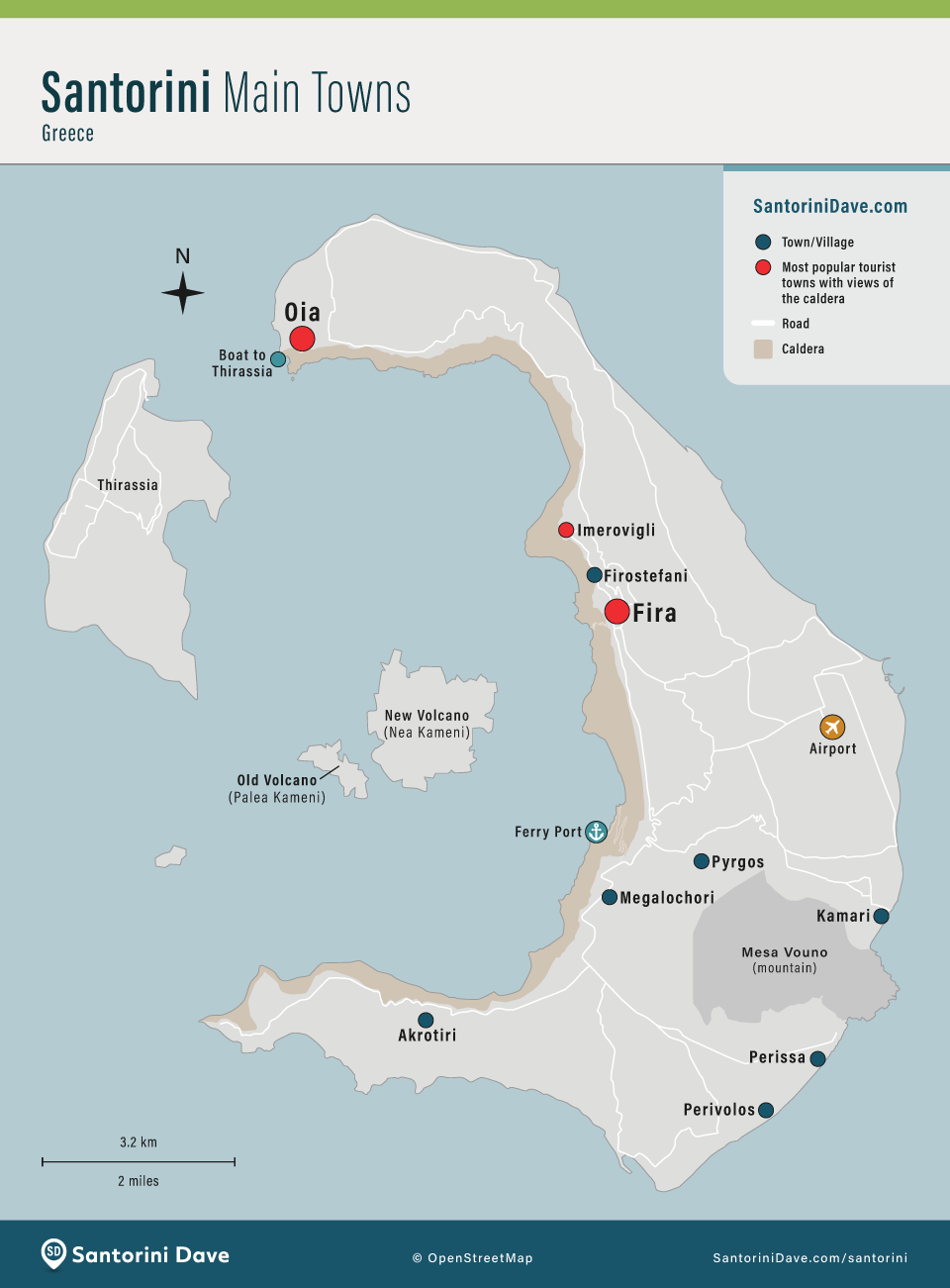
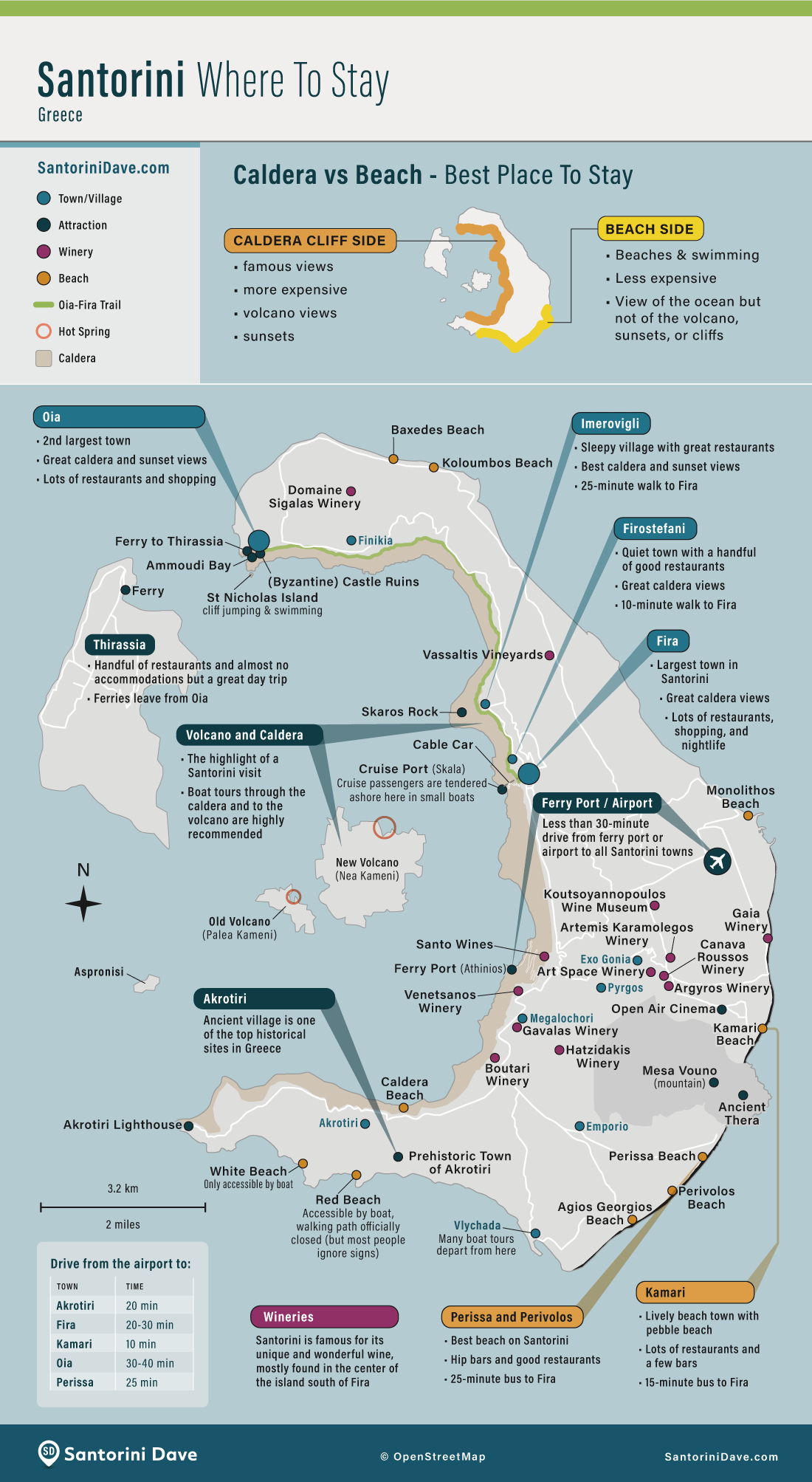
What’s the best town or village to stay in Santorini for first-timers?
There isn’t one single “best” village for everyone, as it really depends on what you’re looking for: iconic caldera views, buzzing nightlife, beach time, romance, budget considerations, or ease of getting around.
My Personal Recommendation for Most First-Timers:
For a first visit, especially during the busy summer months, Fira often strikes the best balance. You get the caldera views, the widest choice of restaurants and bars, the island’s best nightlife, excellent transport links via the central bus station for exploring, and accommodation options across various price points. While busy, its convenience is hard to beat for experiencing different facets of the island easily. If your budget allows and your priority is pure romance and the absolute best views in a quieter setting, then Imerovigli is incredible.The view of the volcano and Skaros Rock from the amazing Astra Suites Hotel in Imerovigli.
The Caldera Cliff Villages: Where the Views Are
These villages offer the quintessential Santorini experience. Expect stunning scenery, beautiful hotels (many with private plunge pools or cave rooms), but also high prices and plenty of stairs.Oia
• Vibe: Famously beautiful, romantic, luxurious, and incredibly picturesque. Oia is where you’ll find the iconic blue-domed churches and postcard-perfect sunsets. Lots of high-end hotels, boutiques, and galleries.
• Views: Absolutely stunning caldera views, especially famous for sunsets (though it gets very crowded for sunset viewing).
• Nightlife: More focused on romantic dinners and stylish bars rather than late-night clubs. Quiets down earlier than Fira.
• Beaches: No beach here. You’d need to take a bus or taxi to the east coast beaches (about 30-40 mins). Ammoudi Bay below Oia is great for seafood restaurants and swimming off the rocks.
• Best For: Honeymooners, couples seeking romance and luxury, photographers, those wanting the absolute classic Santorini look (and willing to pay for it).
• Cave Hotels: Abundant options, from traditional to ultra-luxurious.
• Mobility: Challenging. Lots of stairs and narrow, winding paths. Not ideal for guests with significant mobility issues. Parking can also be tricky.
• Practical Tip: Oia is at the northern tip, making it slightly less convenient as a base for exploring the whole island compared to Fira.Fira
• Vibe: The bustling capital and central hub of the island. Lots of energy, shops, restaurants, bars, and clubs. It’s the heart of the action.
• Views: Excellent caldera views, though perhaps slightly less panoramic than Imerovigli or parts of Oia. Still absolutely breathtaking.
• Nightlife: The island’s most vibrant nightlife is here, with numerous bars and clubs open late.
• Beaches: No beach in Fira itself. It’s the main bus hub, so getting to Kamari or Perissa beaches is easy (around 20-25 mins).
• Best For: First-timers who want convenience, variety (dining, shopping, nightlife), easy access to transport (main bus station), and a wider range of accommodation prices. Great for solo travelers too.
• Cave Hotels: Many cave hotels are available, offering great views.
• Mobility: Mixed. The main town center around the bus station and main square is relatively flat, but accessing many hotels and viewpoints along the caldera edge involves steep paths and stairs. Some hotels like The Majestic are on flatter ground near the entrance to town.
• Practical Tip: Because it’s the transport hub, Fira is arguably the most convenient base if you don’t rent a car and plan to explore via bus.Imerovigli
• Vibe: Known as the “Balcony of Santorini.” It’s quieter and more serene than Oia or Fira, focused on relaxation and romance. Fewer shops and bars, mostly high-end hotels and restaurants.
• Views: Arguably the best, most expansive, and highest caldera views on the island, looking out towards Oia, the volcano, and the sunset. Skaros Rock is right here for a scenic hike.
• Nightlife: Very quiet. Ideal for peaceful evenings enjoying the view from your hotel or a local restaurant.
• Beaches: No beach. You’ll need transport to reach the beaches.
• Best For: Couples, honeymooners seeking tranquility and spectacular views, luxury travelers wanting peace and quiet.
• Cave Hotels: Features many stunning luxury cave suites and villas.
• Mobility: Very challenging. Built steeply on the cliffside with many steps. Some modern hotels like Aeifos Boutique or SantAnna Luxury Suites have focused on accessibility, but the village itself is difficult.
• Practical Tip: While quiet, it’s only a beautiful 25-30 minute walk along the caldera path to Firostefani and onwards to Fira if you want more action.Firostefani
• Vibe: A charming village nestled between Fira and Imerovigli. It feels like a quieter extension of Fira, offering a good balance.
• Views: Fantastic caldera views, often incorporating the classic blue dome of the Three Bells of Fira church.
• Nightlife: Low-key. A few excellent restaurants and quiet bars, but you can easily walk to Fira (10-15 mins) for more options.
• Beaches: No beach. Easy access to Fira’s bus station for beach transport.
• Best For: Those who want caldera views and relative tranquility but still want easy walking access to Fira’s amenities and nightlife. A great compromise.
• Cave Hotels: Good selection available, often slightly less pricey than Oia or Imerovigli for similar views.
Mobility: Still involves steps and inclines, typical of the caldera edge, but perhaps slightly less daunting than parts of Imerovigli or Oia.The Beach Resorts: Sun, Sand (Volcanic), and Swimming
Located on the flatter, eastern side of the island, these villages offer a different vibe. No direct caldera views, but great beach access and generally lower prices.Kamari & Perissa
• Vibe: Lively beach towns with long stretches of black volcanic sand/pebbles (Kamari is more pebbly, Perissa more sandy). Lots of sunbeds, umbrellas, water sports, restaurants, cafes, and bars lining the beach promenades. Family-friendly and generally more affordable than the caldera villages. Perivolos beach extends south from Perissa and offers a similar vibe, sometimes with more upscale beach clubs.
• Views: No caldera view. Views are out to the Aegean Sea.
• Nightlife: Plenty of beach bars and restaurants that stay open into the evening, offering a relaxed but active nightlife scene.
• Beaches: Right on the beach! This is their main draw.
• Best For: Beach lovers, families, budget-conscious travelers, those seeking a more traditional beach holiday vibe, visitors with mobility issues.
• Cave Hotels: Not found here. Accommodation is mostly standard hotels and apartments.
• Mobility: Much better. These towns are relatively flat, especially along the beach roads, making them the most accessible options on the island. Some hotels (like Costa Grand in Kamari) cater well to accessibility needs, and both Kamari and Perissa beaches have SeaTrac systems providing ramp access into the water for wheelchair users.
Practical Tip: You’ll need to take a bus (approx. 20-25 mins to Fira) or car to visit the caldera towns and see the famous views.
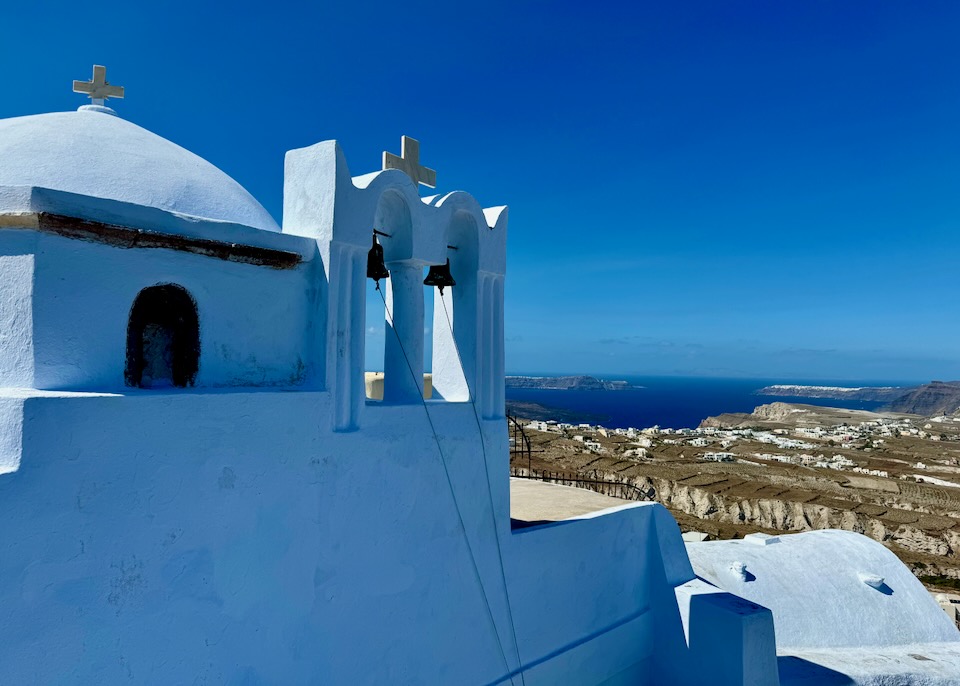
The fantastic inland village of Pyrgos.
Inland Villages: Traditional Charm & Quieter Spots
Pyrgos
• Vibe: A beautiful, traditional inland village built amphitheatrically on a hill crowned by a Venetian castle. Offers a more authentic, less touristy feel with winding alleys and charming squares.
• Views: Panoramic views over the entire island, including distant sea views, but not the direct, dramatic caldera cliff view.
• Nightlife: Very quiet, focused on a few excellent restaurants and traditional cafes.
• Beaches: Inland, requires transport (bus or car) to reach beaches (15-20 mins).
• Best For: Travelers seeking an authentic Greek village experience, escaping the main tourist crowds, enjoying panoramic island views.
• Cave Hotels: Some boutique hotels are built in traditional style, sometimes incorporating cave elements.
• Mobility: Hilly with steps, especially up towards the castle. Not ideal for those with limited mobility.
• Practical Tip: Renting a car is highly recommended if staying here to easily explore the rest of the island.Megalochori
• Vibe: A stunningly preserved traditional village in the south-central part of the island, known for its historical mansions, white Cycladic churches with blue domes, distinctive bell towers you can walk under, and surrounding vineyards. It offers an authentic, tranquil atmosphere away from the caldera crowds.
• Views: Primarily village and vineyard views. It’s located near the caldera side, so some spots or specific hotels might offer partial or distant caldera/sea views, but it’s not perched directly on the main cliff edge like Fira or Oia.
• Nightlife: Very quiet and traditional. Evenings revolve around the charming village square with its excellent local tavernas and cafes. Perfect for a relaxed dinner and quiet drinks.
• Beaches: Not a beach village. Requires transport (bus or car) to reach the southern beaches like Perissa, Perivolos, or Vlychada (approx. 10-15 mins drive).
• Best For: Visitors seeking authenticity, tranquility, a romantic traditional village setting, wine enthusiasts (close to several wineries like Venetsanos, Gavalas, Antoniou).
• Cave Hotels: Features beautiful boutique hotels and villas, many restored from historic buildings, sometimes incorporating cave-style architecture.
• Mobility: The central square and immediate surrounding paths are relatively flat and largely pedestrianized, making it more manageable than the steep caldera towns. However, exploring deeper into the village involves charming but potentially uneven alleyways.
• Practical Tip: While there is bus service, having a rental car provides much more flexibility for exploring the island and nearby beaches/wineries from Megalochori.Akrotiri
• Vibe: A quieter, more spread-out village on the southern part of the island, famous for the incredible Minoan archaeological site (“Santorini’s Pompeii”) and close to the Red Beach.
• Views: Some hotels offer unique caldera views looking north (a different perspective than Fira/Oia), while others have sea views (looking south and not into the caldera).
• Nightlife: Very quiet, a few tavernas scattered around.
• Beaches: Close to Red Beach, White Beach, and Vlychada Beach.
• Best For: History enthusiasts, those wanting a quiet base near the southern beaches and sights, visitors looking for unique viewpoints.
• Cave Hotels: Some unique properties exist, but it’s not the main feature.
• Mobility: The village itself is spread out, and accessing beaches often involves walks or climbs. Need to check individual hotel accessibility.
• Practical Tip: Best explored with a rental car due to its location.Summary & Recommendation for First-Timers:
• For the iconic views & romance (budget permitting): Oia or Imerovigli.
• For convenience, nightlife & budget variety with views: Fira.
• For a balance of views, quiet & Fira access: Firostefani.
• For beach focus & budget: Kamari or Perissa.
• For accessibility: Kamari or Perissa are significantly better than the caldera villages. But always verify specific hotel features.
• For authentic village life: Pyrgos.
What are the absolute must-do activities and attractions in Santorini?
Santorini’s magic is concentrated into a surprisingly small island, but the very best experiences are scattered from one end of the caldera to the other. If you give yourself five full days you can comfortably tick off everything below; with less time, pick the highlights that match your pace and interests.
1. Hike the Caldera Path from Fira to Oia: This is, hands down, my favorite thing to do in Santorini. The views are amazing. You’ll walk along the edge of the caldera, passing through the charming villages of Firostefani and Imerovigli along the way.
• The Hike: It’s about 10km (6 miles) and takes roughly 3 to 5 hours, depending on your pace and how often you stop for photos (which will be often). The path is a mix of paved walkways and dirt trails.
• Practical Tips: Start early in the morning (especially in summer) to beat the heat and the crowds. Wear comfortable walking shoes, bring plenty of water, sunscreen, and a hat – there’s very little shade. The hike can be done in either direction without much difference.2. Take a Caldera Boat Tour: Seeing Santorini from the water gives you a completely different perspective of the sheer cliffs and volcanic landscape. It’s an essential Santorini experience.
• Tour Options: Most tours include sailing past the Red and White Beaches, through the caldera and up to Oia; a stop to swim in the volcanic Hot Springs (wear dark swimwear as the sulfur can stain); and a bbq meal with drinks. Many also include a hike on the Nea Kameni volcano islet (wear sturdy shoes).
• Booking: Book tours in advance, particularly for popular sunset cruises or semi-private options during peak season. You can find tours departing from Ammoudi Bay (below Oia) or Vlychada (southern coast).3. Explore the Akrotiri Archaeological Site: Often called the “Minoan Pompeii,” this incredibly well-preserved Bronze Age city was buried by volcanic ash over 3,600 years ago. Walking through the covered excavation site is fascinating.
• What to See: You’ll see multi-story buildings, streets, pottery, and learn about this sophisticated ancient civilization. Impressive frescoes discovered here are housed in the Museum of Prehistoric Thera in Fira.
• Visitor Info: The site is covered, offering welcome shade. Allow 1-2 hours. Consider hiring a guide at the entrance or booking a guided tour beforehand for a much richer experience – signage is helpful but limited. Check current opening hours (€12 entry, or a €15 combined ticket for Akrotiri, Ancient Thera, and the Prehistoric Museum is great value). There’s parking nearby, and buses run from Fira.4. Hit the Unique Volcanic Beaches: Santorini’s beaches are different – forget endless white sand. Here, it’s about dramatic volcanic landscapes.
• Must-Visits: Perissa & Perivolos: Long stretches of black sand, well-organized with sunbeds, umbrellas, beach bars, tavernas, and water sports. Perivolos tends to be a bit more upbeat/party-oriented further along. Kamari: Similar to Perissa, another popular black sand beach with a lively promenade. Red Beach: Famous for its stunning high red cliffs and reddish sand/pebbles. Access requires a short, somewhat rocky walk down from the parking area, or arrive by boat (often less crowded).
• Tip: Water shoes can be helpful on the pebbly beaches. (Pebbles can be uncomfortable and black sand gets very hot.)5. Go Santorini Wine Tasting: Santorini’s volcanic soil and unique grape varieties (especially the crisp white Assyrtiko) produce distinctive, world-class wines. Visiting a winery is a fantastic way to spend an afternoon.
• The Experience: Many wineries offer tours explaining their unique vine cultivation (the low-to-the-ground kouloura baskets) and tastings, often paired with local cheeses and snacks. Many boast incredible caldera or vineyard views.
• Options: You can visit wineries independently (Estate Argyros, Venetsanos, Santo Wines, Domaine Sigalas are popular choices) or join a guided wine tour, which often includes transport and visits to multiple wineries. Sunset wine tours are also available.6. Wander Through Picturesque Oia Village: Don’t just visit Oia for the sunset. Spend time exploring its charming, winding pathways, iconic blue-domed churches, art galleries, stylish boutiques, and cave houses built into the cliff.
• Best Time: It’s most magical (and less crowded) early in the morning or later in the evening after the sunset crowds disperse.
• Tip: Get lost in the smaller alleys away from the main marble path to discover quieter corners and beautiful photo spots.7. Explore Fira: As the island’s capital, Fira is the bustling hub. It offers stunning caldera views, plenty of shops, restaurants, bars, and museums.
• Highlights: Walk along the caldera edge, visit the Museum of Prehistoric Thera, take the cable car (or walk the steps/ride a donkey – though walking is recommended over riding) down to the Old Port.
• Vibe: It’s busier and has more nightlife than Oia. It’s also the central point for buses going all over the island.8. Discover the Inland Village of Pyrgos: For a taste of traditional Santorini away from the main caldera crowds, head inland to Pyrgos.
• Charm: Wander through its maze-like streets up to the ruins of the Venetian castle (Kasteli) at the top for panoramic views of the entire island. It feels more authentic and peaceful.
• Tip: There are some lovely cafes and tavernas here to relax in.9. Swim and Dine at Ammoudi Bay: Tucked below Oia, this tiny, colorful fishing port is incredibly charming.
• Seafood: It’s famous for its waterfront tavernas serving incredibly fresh fish (pick your own). Perfect for lunch or dinner.
• Swimming: Walk past the restaurants to the left, around the bend, to find a popular swimming spot off the rocks with views back towards the caldera cliffs. It’s known for cliff jumping.
• Access: You can walk down the ~300 steps from Oia or drive/taxi down the winding road.10. Visit the Museum of Prehistoric Thera (Fira): This museum is essential for understanding Akrotiri. It houses many of the stunning frescoes (like the famous “Fishermen” and “Boxers”), intricate pottery, and other artifacts unearthed at the archaeological site.
• Why Visit: It puts the ruins of Akrotiri into context and showcases the artistry of the Minoan civilization. It’s well-organized and air-conditioned, making it a great escape from the midday sun.
Practical: Located in Fira. Use the €15 combo ticket if you’re also visiting Akrotiri and Ancient Thera.
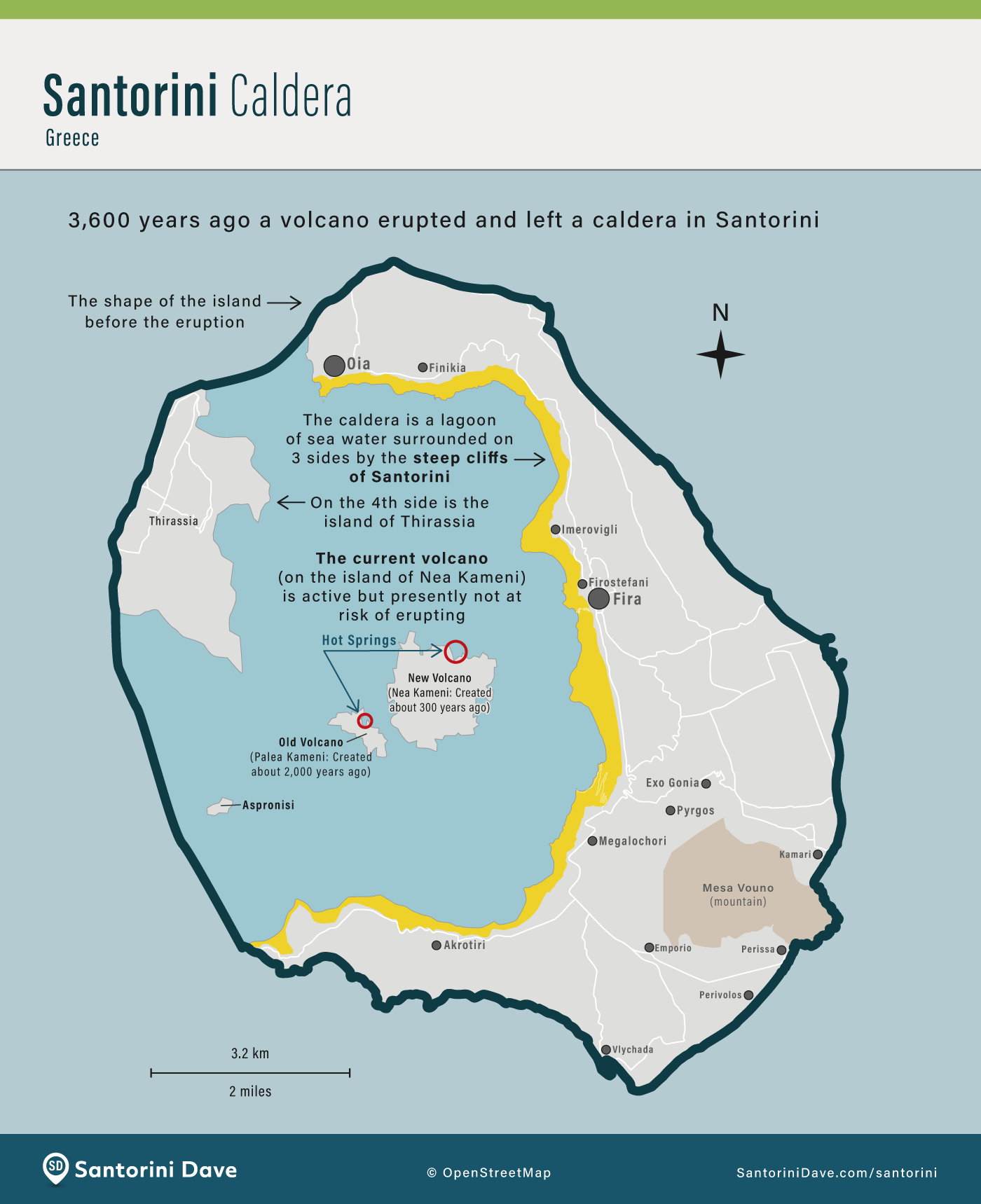
Where are the 5 best spots to watch the famous Santorini sunset?
1. The Castle of Oia (Agios Nikolaos Castle): This is the classic, postcard-perfect spot. The ruins of the Venetian castle at the northwestern tip of the island offer panoramic views as the sun dips below the horizon, illuminating the village’s white buildings and blue domes.
• The Reality: It gets extremely crowded. People start claiming spots hours before sunset. If you want a prime position on the castle wall, be prepared to arrive very early (think 2-3 hours ahead in peak season), bring water and snacks, and hold your ground.
• Tip: Alternatively, find a spot along the pathways leading away from the castle, or consider booking a table at a cliffside restaurant in Oia well in advance for a more comfortable (though pricier) view.2. Imerovigli & Skaros Rock: Known as the “Balcony to the Aegean,” Imerovigli sits at the highest point of the caldera rim, offering stunning, unobstructed sunset views. It’s generally less frantic than Oia.
• Best Spot: The path leading out to Skaros Rock (the prominent headland in front of Imerovigli) is fantastic. You don’t need to climb the rock itself; find a spot along the trail or near the Chapel of Theoskepasti on the sea-facing side for breathtaking views as the sun sets directly ahead.
• Vibe: It feels more spacious and serene than Oia, though still popular. Hotels in Imerovigli often boast incredible private sunset terraces if you’re staying nearby. Remember to bring a flashlight if you hike out to Skaros Rock, as the path isn’t lit for the walk back after dark.3. Pyrgos Village (Kasteli Ruins): For a different perspective and a more authentic, traditional village feel, head inland to Pyrgos. This charming village is Santorini’s highest settlement.
• The View: Climb up through the winding alleys to the ruins of the Venetian castle (Kasteli) at the top. From here, you get incredible panoramic views across the entire island – vineyards, villages, and the caldera in the distance – all bathed in the golden light of sunset.
• Why Go: It’s much quieter and less crowded than the caldera-edge spots, offering a peaceful and arguably more unique sunset experience. Franco’s Cafe near the castle is a popular spot for drinks with a view.4. Akrotiri Lighthouse: Located on the southwestern tip of the island, the lighthouse offers a rugged, dramatic setting and a sense of being away from it all.
• Experience: Watch the sun sink into the Aegean Sea with views across the southern part of the caldera. The lighthouse itself makes a great silhouette.
• Practicalities: You’ll need a car or ATV to get here easily, as buses don’t go right to the lighthouse. The road can be narrow, and parking is limited right at the end, so arrive early. It’s much less crowded than Oia or Fira, attracting those looking for tranquility. Bring your own water and snacks, as there are no facilities right there.5. From a Sunset Cruise: This is my personal recommendation for a truly special experience. Seeing the caldera cliffs and villages glow from the water as the sun sets is magical.
• The Trip: Many companies offer sunset catamaran or boat tours. Most sail past the Red and White Beaches, stop for a swim at the Hot Springs, and then position themselves for prime sunset viewing, often below Oia. Most tours include drinks and a delicious BBQ meal onboard.
• Booking: These tours are incredibly popular, especially the small-group catamaran options. Book well in advance, particularly during high season, to secure your spot. Hotel pickup/drop-off is usually included. It’s a fantastic way to combine sightseeing with a relaxing, crowd-free sunset view.
What currency is used in Santorini?
Greece is part of the European Union, so the currency used in Santorini is the Euro (€). Most shops and restaurants on Santorini accept credit cards, but it is a good idea to have some cash on hand for small purchases like bottled water and snacks. ATMs are easy to find in all of Santorini’s main towns.
Top Tip: When using your credit card in shops and restaurants or taking cash from an ATM, you’ll often get a prompt asking if you want the transaction in Euros (EUR), US Dollars (USD), or your home currency. Always choose Euros. Selecting USD (or GBP, CAD, AUD) lets the machine apply its own, often unfavorable, exchange rate which can include hidden fees; choosing the local currency (Euros) ensures you get the much better Visa/Mastercard rate processed by your bank.

Most restaurants in Santorini, like Marinera in Fira, accept credit cards.
Is Santorini expensive?
Santorini is known for 5-star luxury hotels, great restaurants, and high-end shopping but it’s easy to visit Santorini on a modest budget. There are no all-inclusive resorts on Santorini so the key to saving money is to choose hotels and restaurants not directly on the caldera. Enjoying the incredible views is free and cheap hotels in Santorini are plentiful, good value, and good quality.
Watch a movie overlooking the caldera at Volkan Cinema in Fira. But for the best movie experience in Santorini head to the Kamari Open Air Cinema.
What towns and hotels have the best caldera views?
The towns of Fira, Firostefani, Imerovigli, Oia, and Akrotiri are perched on the Santorini cliff and offer incredible views of the caldera and volcano. Not all hotels in these towns have caldera views but many do and the ones that don’t are a short walk (sometimes just steps) from the caldera’s edge, so staying at a caldera hotel isn’t necessary to enjoy the views. Each town offers a unique perspective and there isn’t any one town with the absolute best views. Imerovigli generally has the best sunset views but even this is open to debate and each of the caldera villages has a reasonable claim to having the island’s best views.

The Honeymoon Suite at Athina Luxury Suites in Fira.
Photos from this past summer …
September 1, 2024
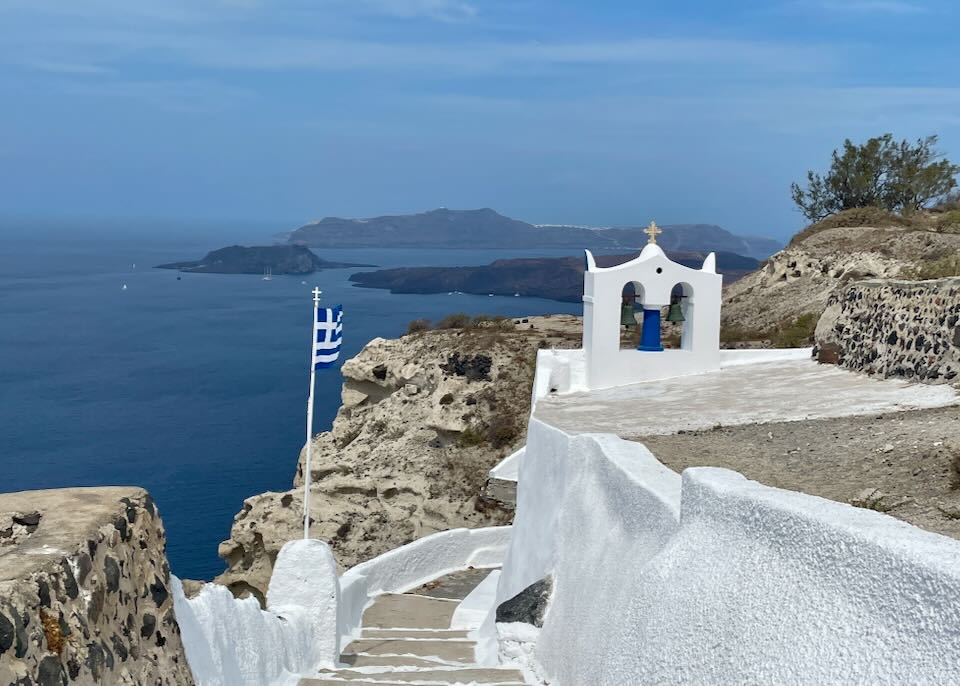
Church of the Holy Cross on the caldera’s edge. As you approach the path down to the Baths of Plaka, you’ll pass between the Church of Saint Marina and two windmills. From this spot, you can also see the Church of the Virgin Mary (Panagia) and the thermal baths nestled at the base of the caldera’s cliff.
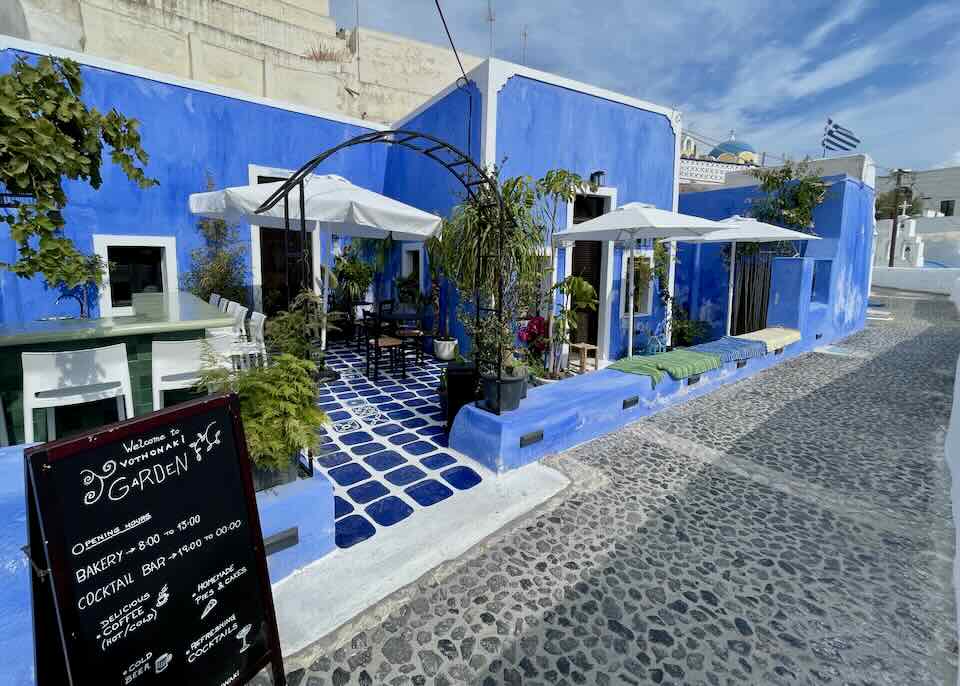
Vothonaki Garden in the village of Vothonas.

Coffee and delicious chicken and spinach pies at Vothonaki.
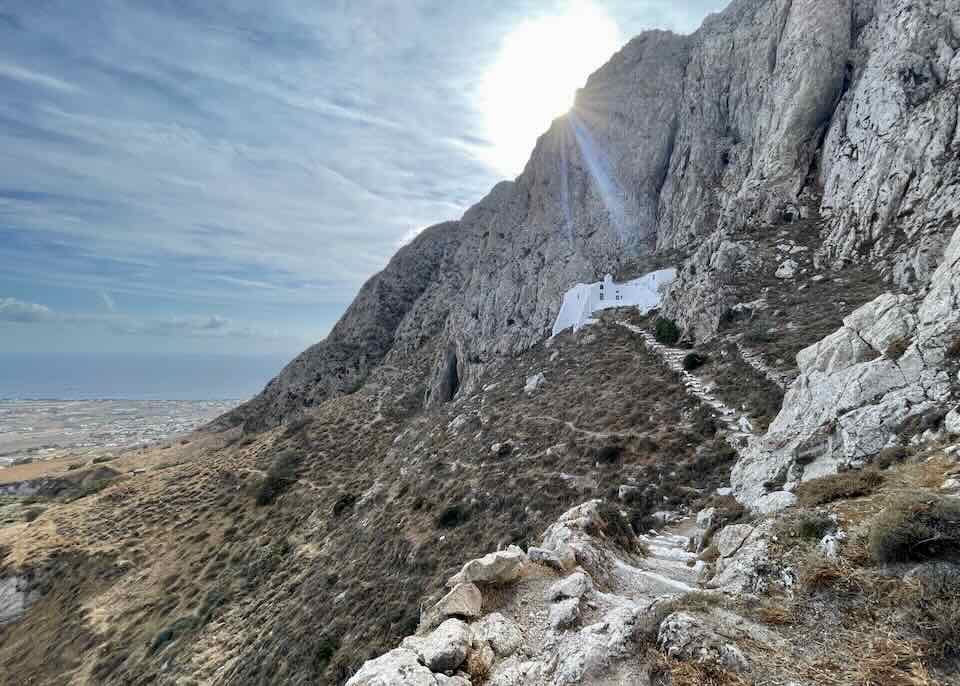
Hike to Agios Georgios To Katefio, with a small portion of the airport runway visible to the left.

Looking north from Agios Georgios To Katefio.
August 31, 2024
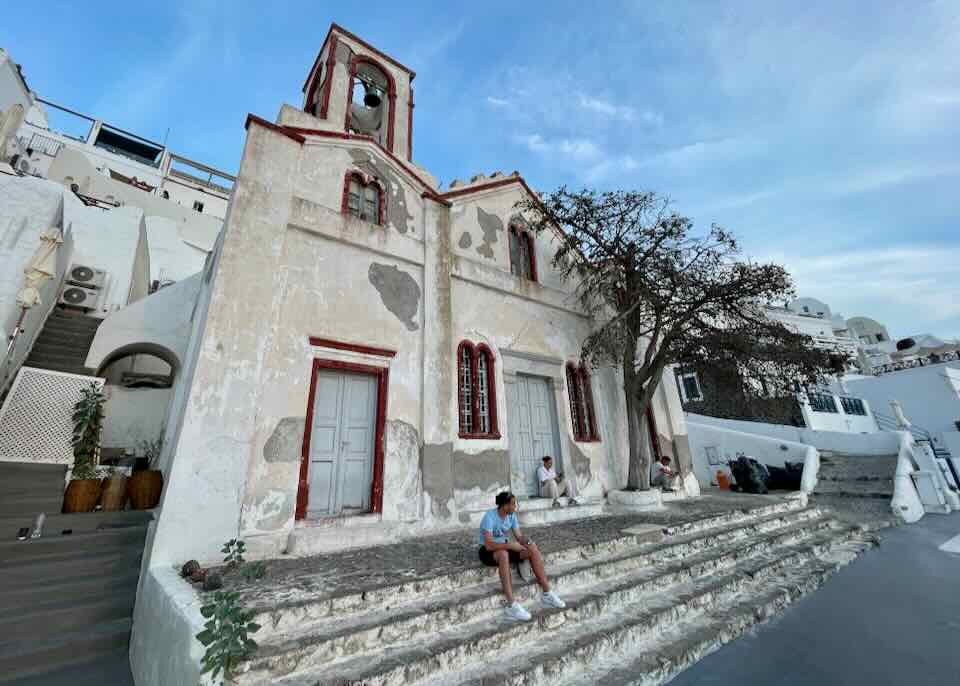
Church of Saint John the Theologian in Fira. One of the oldest buildings in Santorini.

Produce for sale in Fira.

Sunset views in Fira from Niki restaurant.

Kampia beach on the south coast. A hidden gem.
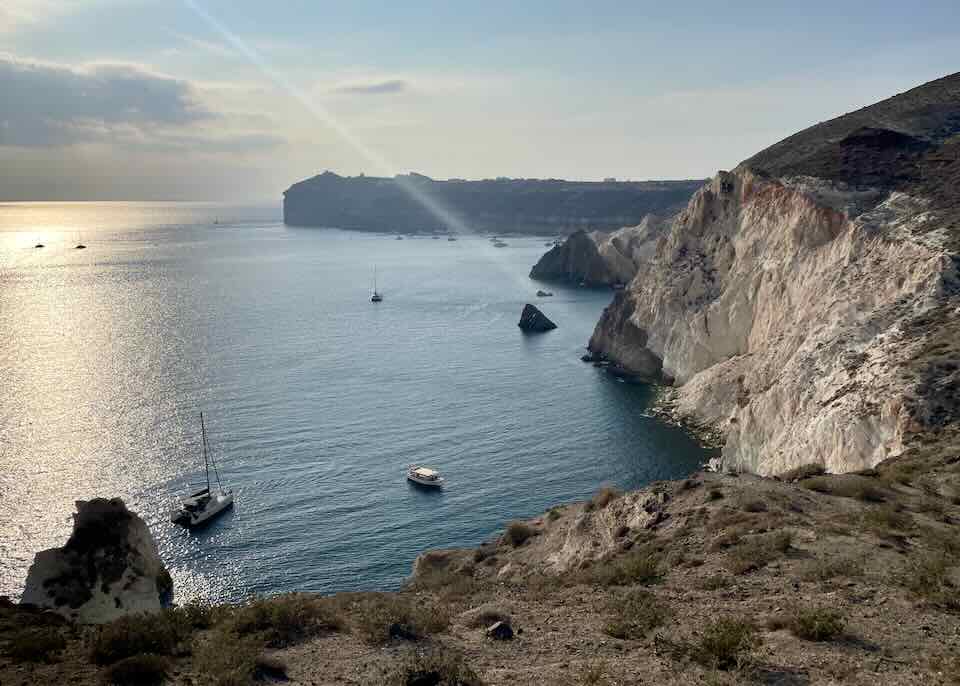
White Beach, just to the west.
August 30, 2024
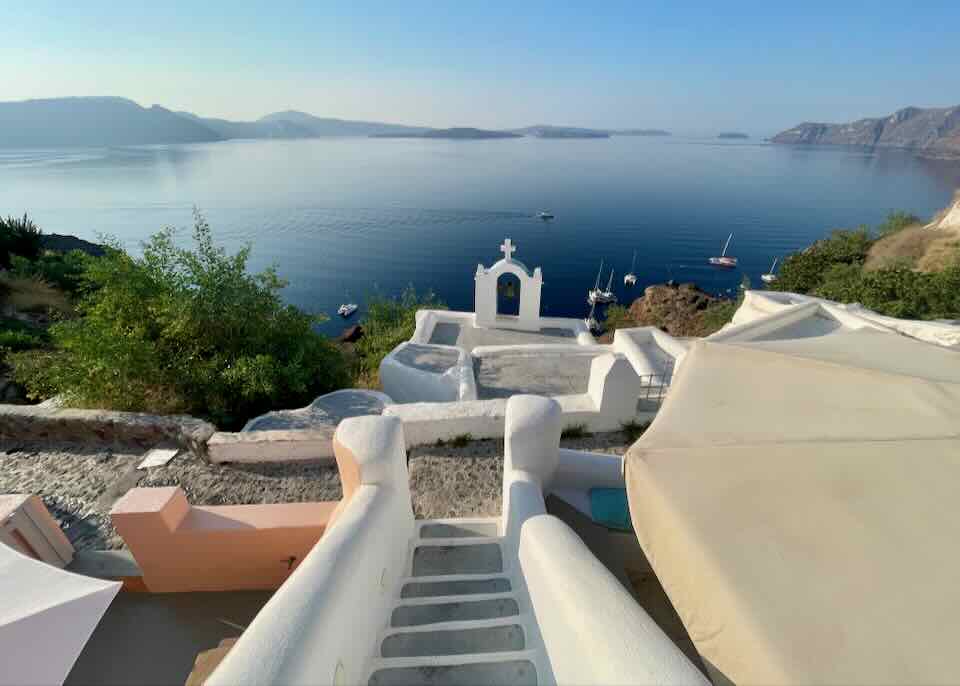
Saint Eleftherios Church in Oia.

A donkey on a farm near Oia.

A farmer harvesting edible prickly pear cactus fruit.

Kyra Panagia Holy Chapel in the countryside east of Oia.

The caldera walking path as it passes in front of Rocabella hotel north of Imerovigli.
August 29, 2024
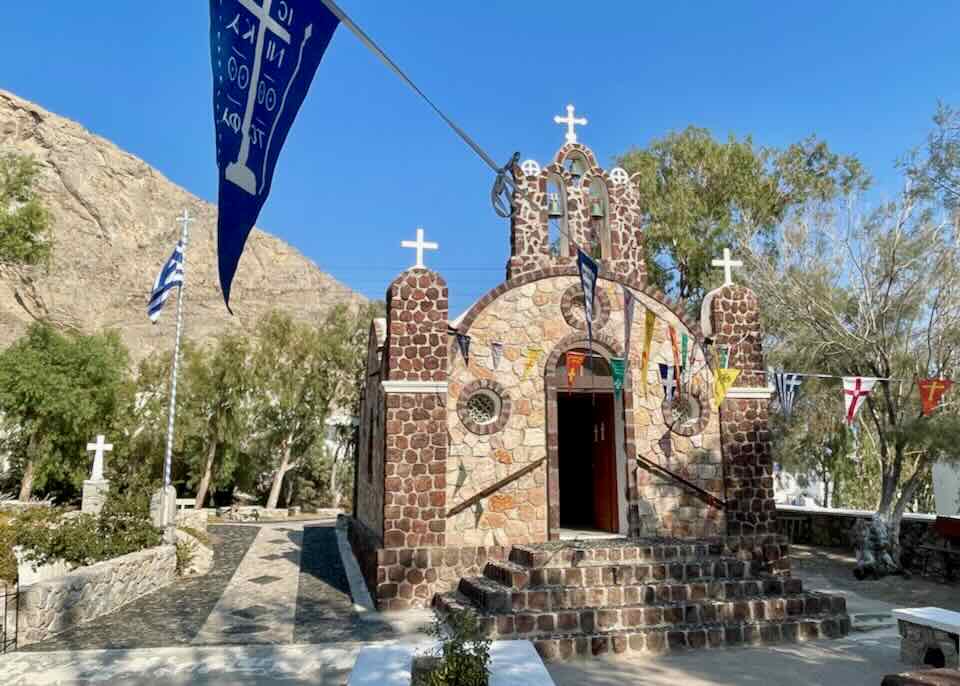
Saint Ioannis Church in Perissa.
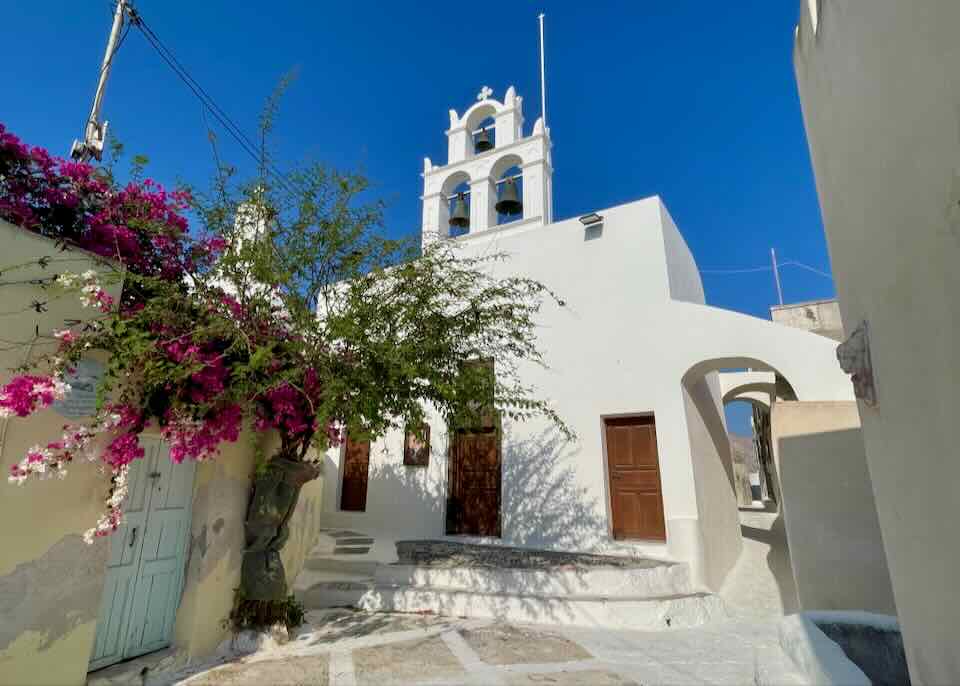
Saint Charalambos Church in Plakota, outside Emporio Castle.
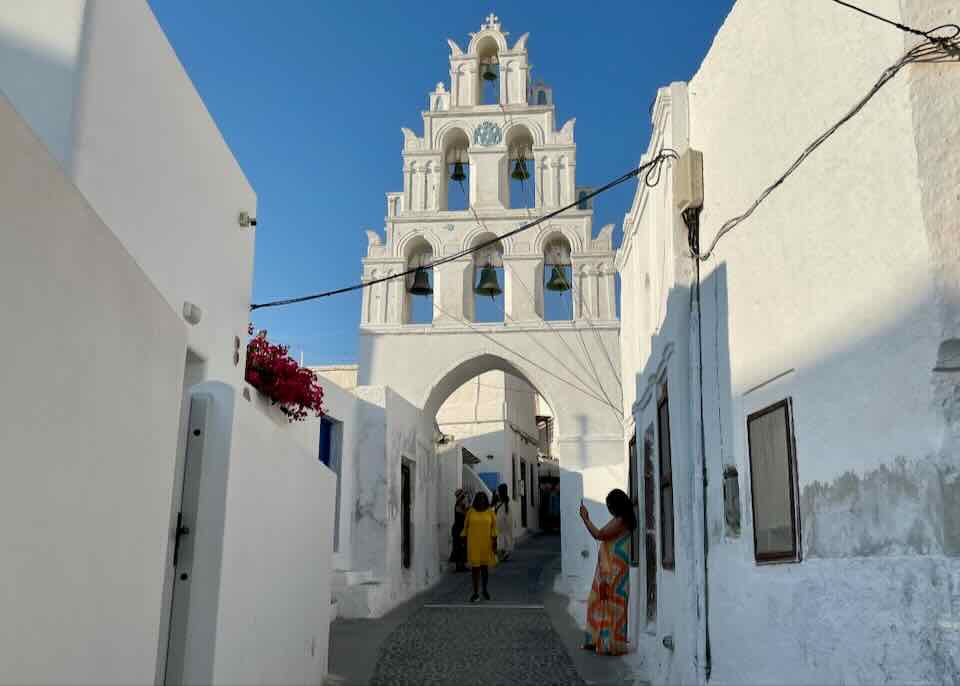
The three-tiered bell tower of the Church of Agioi Anargyroi in Megalochori.

Traditional underground caves in Megalochori. Free to visit.
August 28, 2024

A couple gets their photograph taken just below the Athenian House, one of my very favorite restaurants in Santorini.

The pool at Altana Heritage Suites in Imerovigli. (Claimed to be the highest pool on the caldera.)

The private plunge pools at Sophia Luxury Suites in Imerovigli.
August 27, 2024
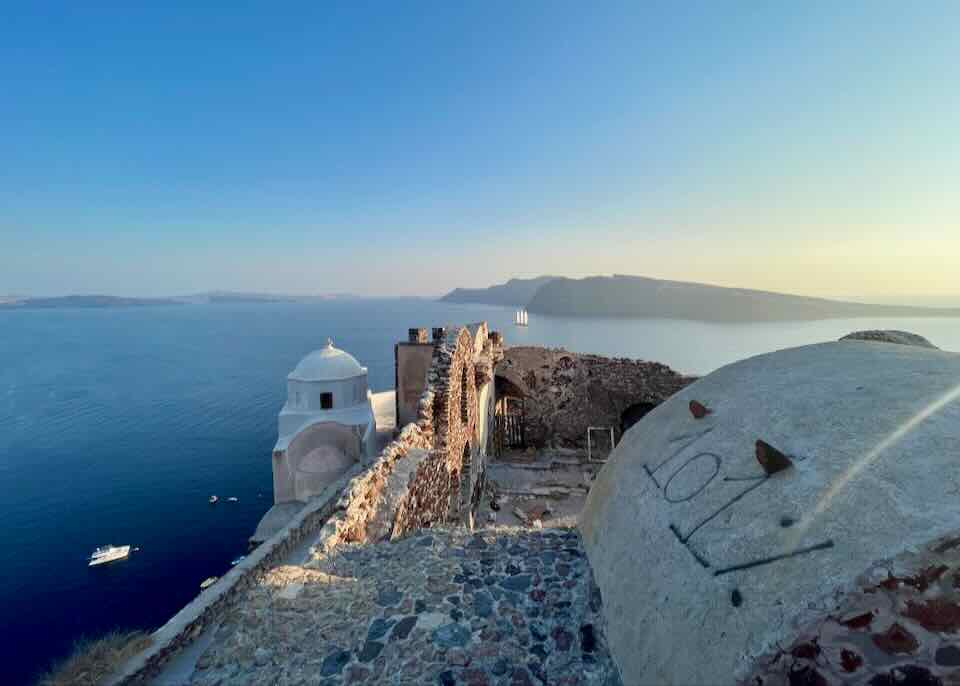
Oia Castle.
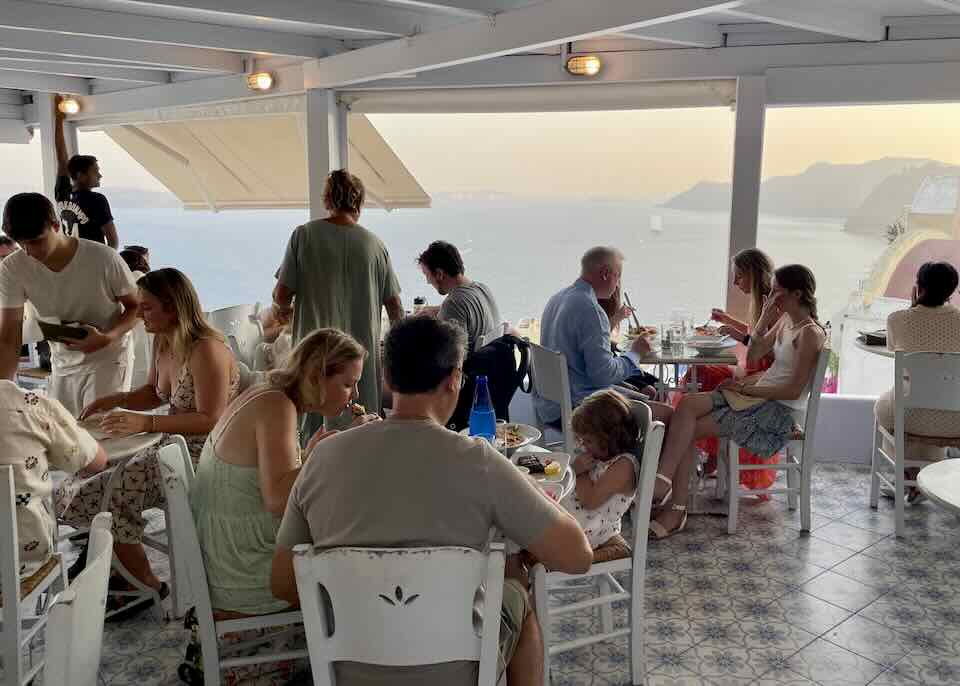
View of caldera from Lotza restaurant in Oia.

Music in Oia as tourists gather for the sunset.

The entrance to the Santorini Maritime Museum in Oia.

Roka, no caldera views but one of my favorite restaurants in Oia.
August 26, 2024
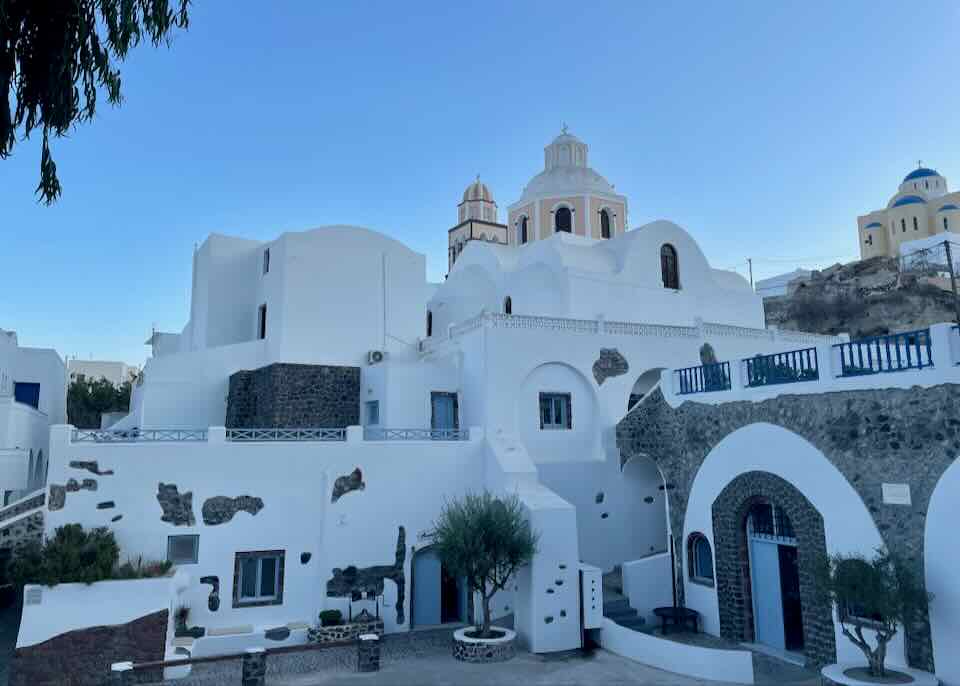
Church of Virgin Mary Lagadiou in Fira.
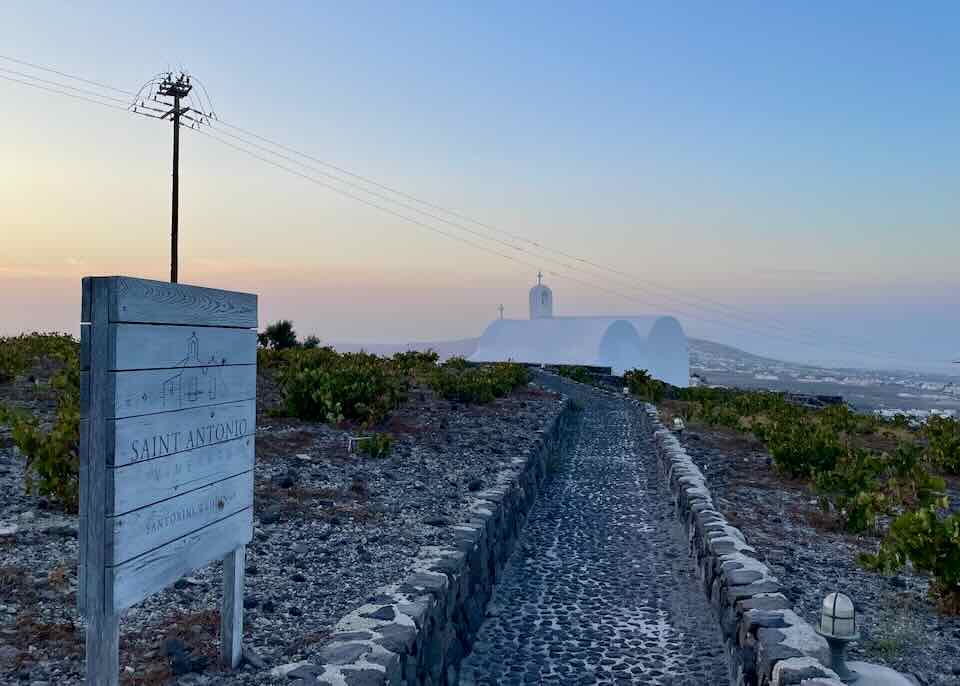
Entrance to the Saint Antonio wedding venue near Pyrgos.

The views and setting are idyllic for a wedding or reception but though it’s surrounded by vineyards the location itself is not an actual vineyard.
August 25, 2024
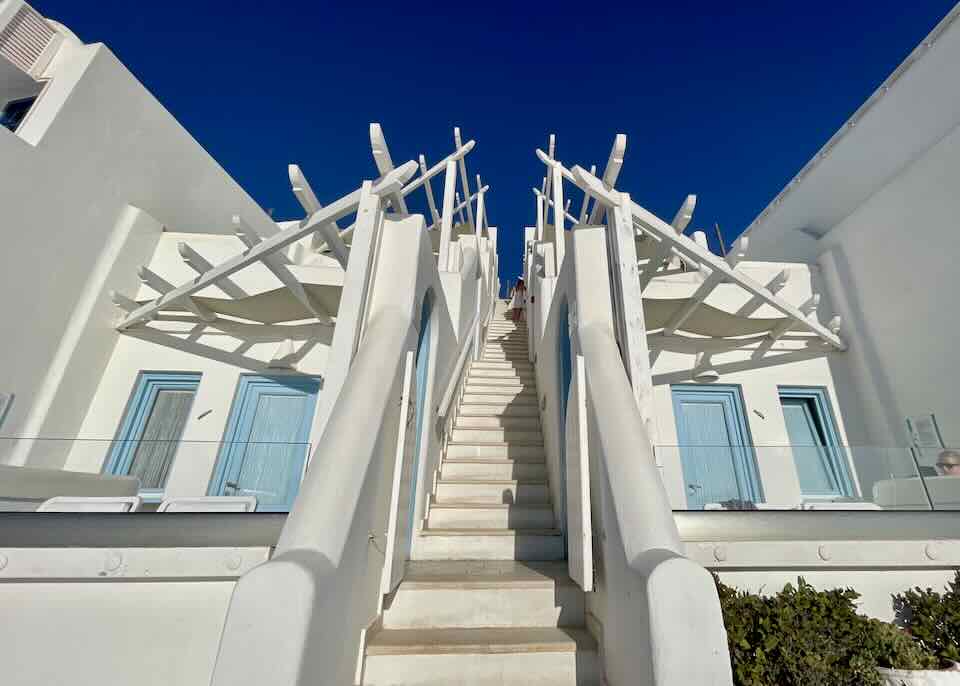
The stairs at Above Blue hotel in Imerovigli.
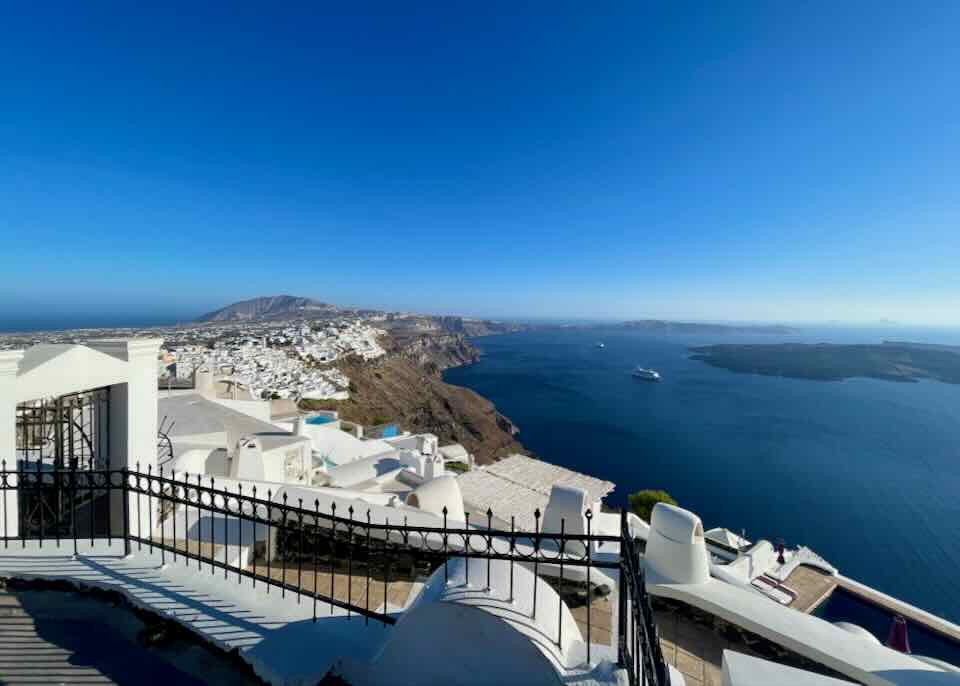
Looking south into the caldera from Vasilicos hotel in Imerovigli.
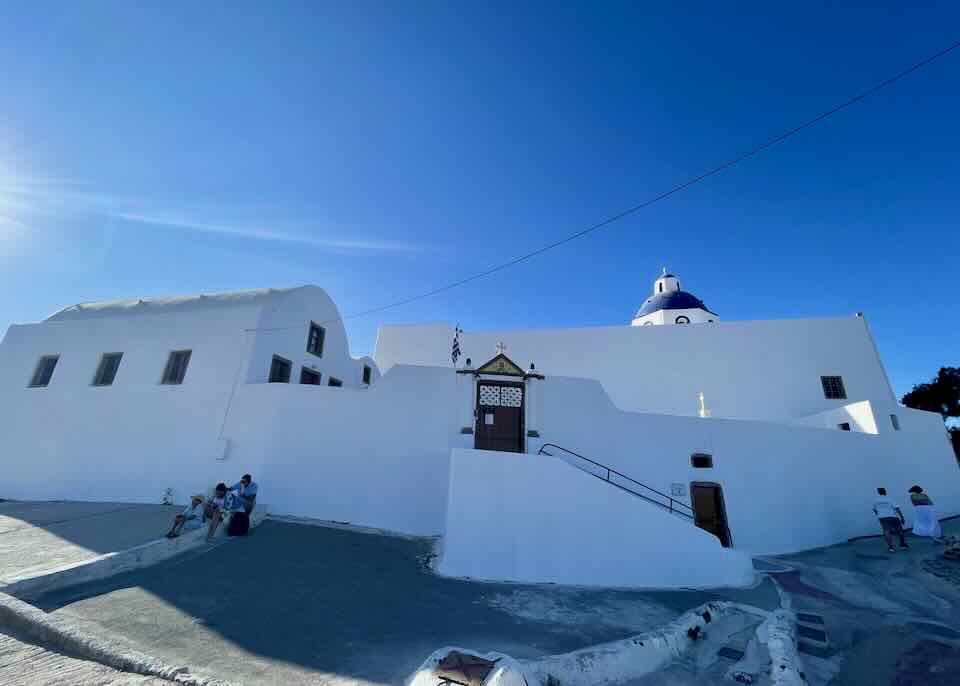
Saint Nikolaos Holy Convent on the caldera hike between Imerovigli and Firostefani. The women’s monastery of Agios Nikolaos was established in 1651 and has been in its current location since 1820.

Le Moustache Caldera Pool Lounge & Restaurant in Imerovigli.
August 24, 2024
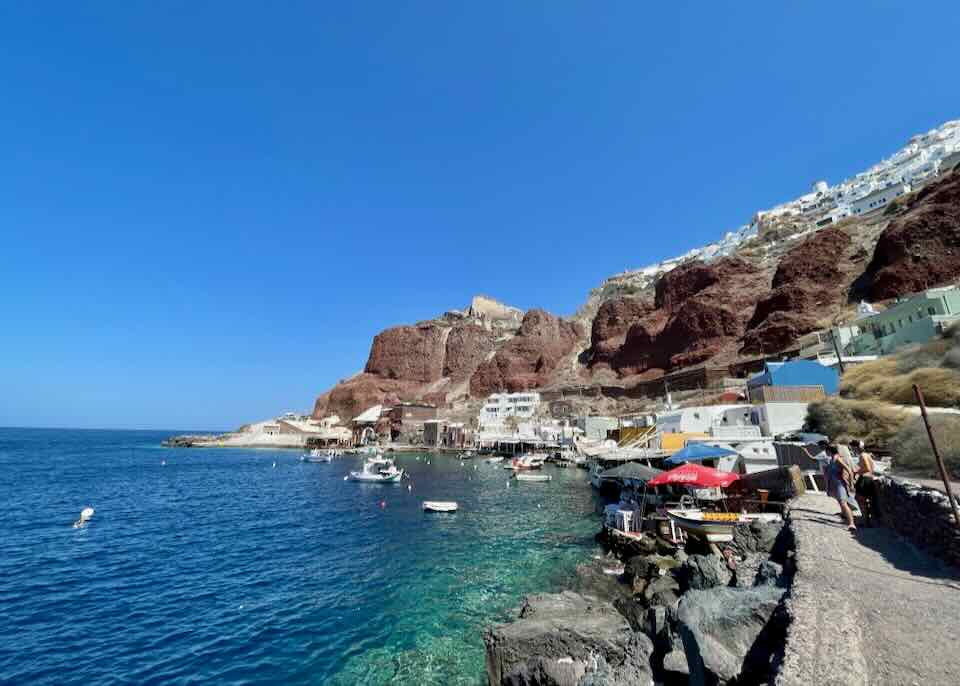
Ammoudi Bay below Oia.
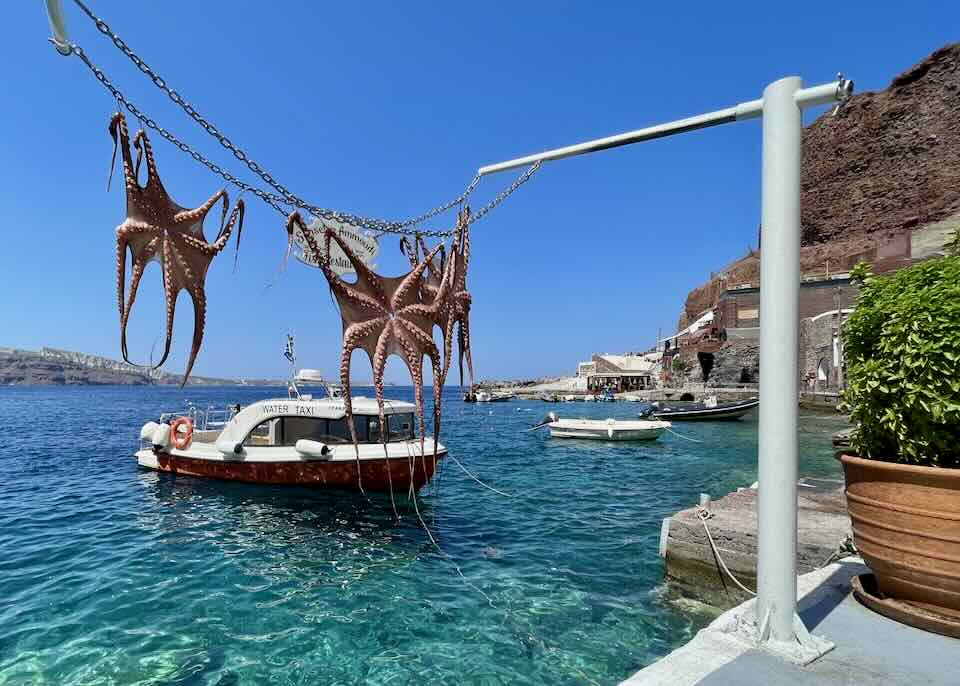
Octopus drying at an Ammoudi Bay restaurant.
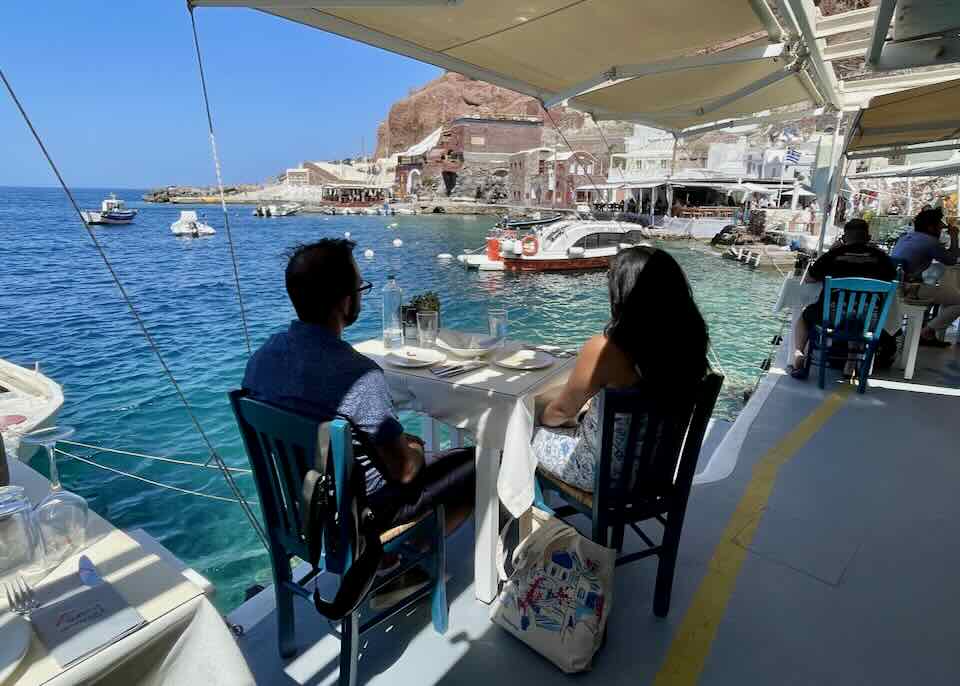
Diners at Sunset Ammoudi taverna.
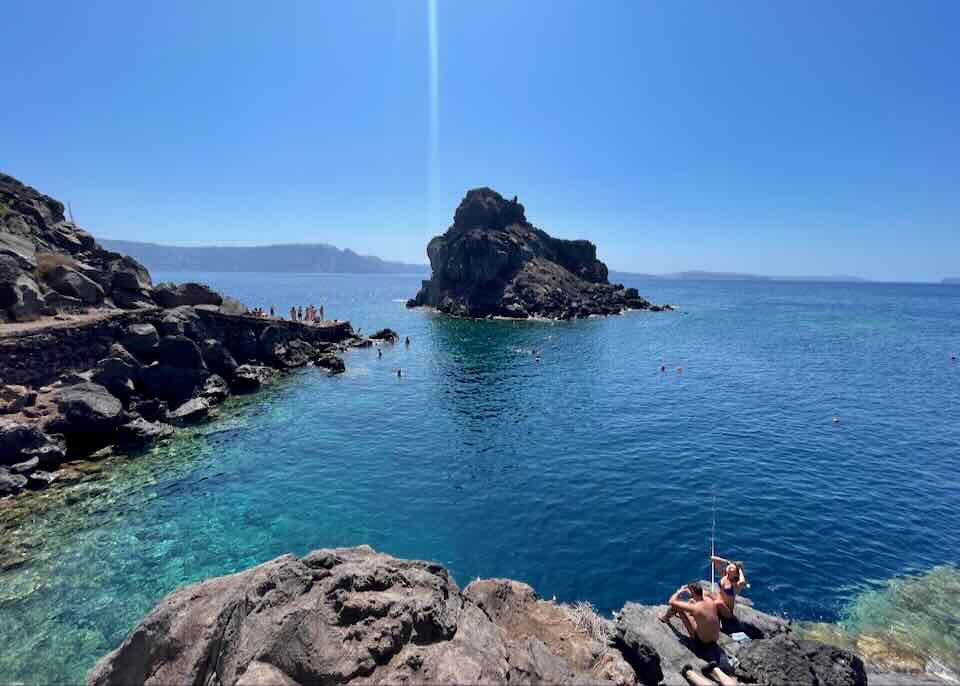
From Ammoudi Bay there’s a path that leads to Nisis Agios Nikolaos (a small island you can swim to).
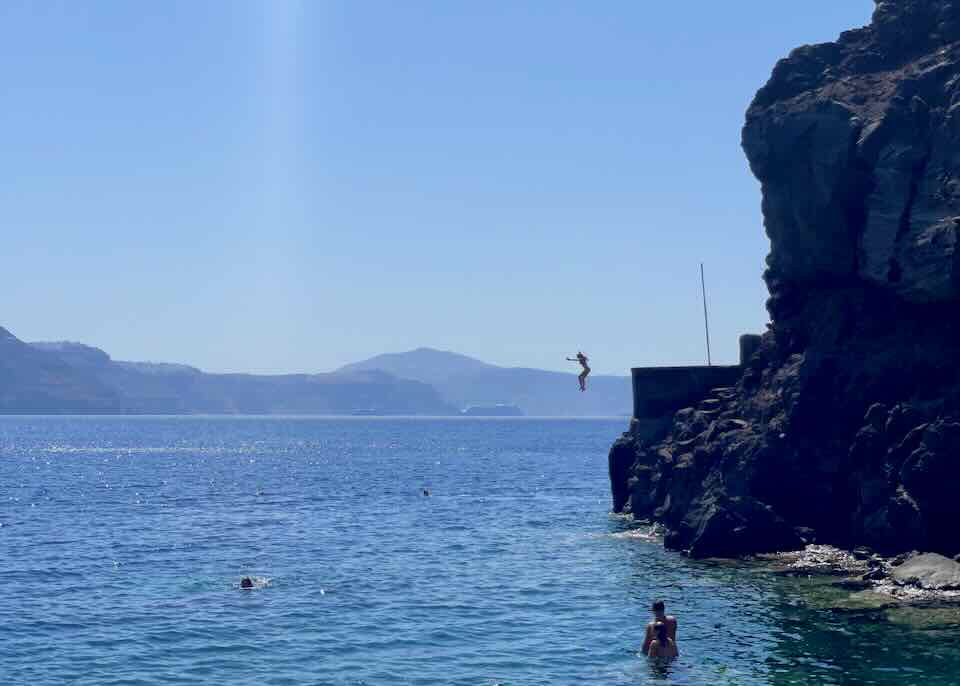
There’s a small chapel (Saint Nicholas Church) on the island and a platform to jump from.
August 23, 2024

Choma Kai Nero Pottery Studio in Megalochori.
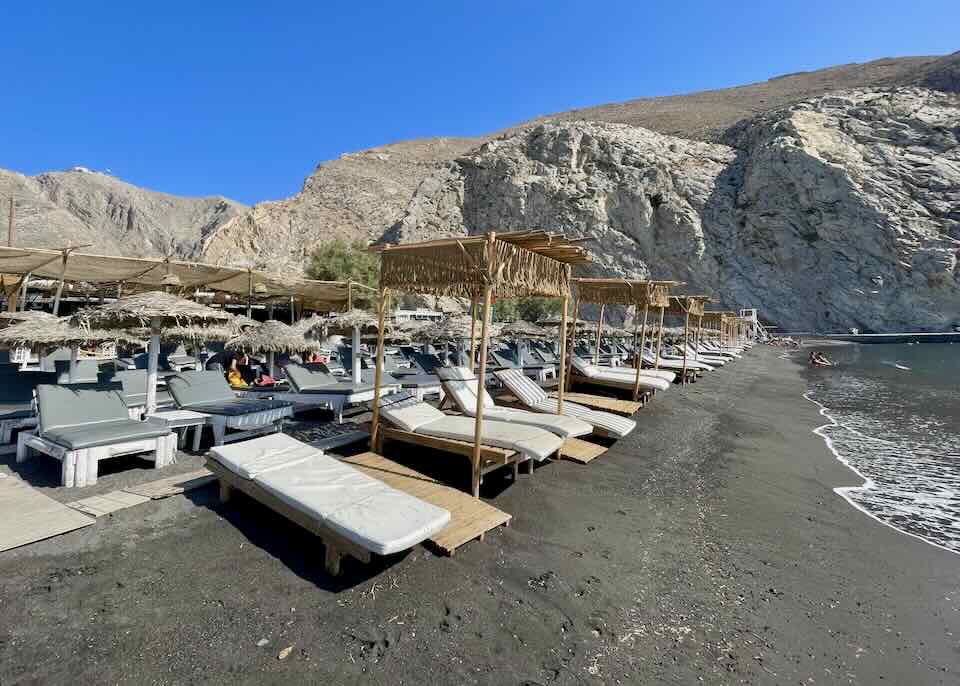
Demilmar Restaurant Beach Bar in Perissa.
August 22, 2024

Steps down the caldera in Firostefani.

Lilium Hotel on the caldera, 2.5 km south of Fira.

Entrance to Gavalas Winery in Megalochori. One of my favorites in Santorini.

Storage cellar for wine.
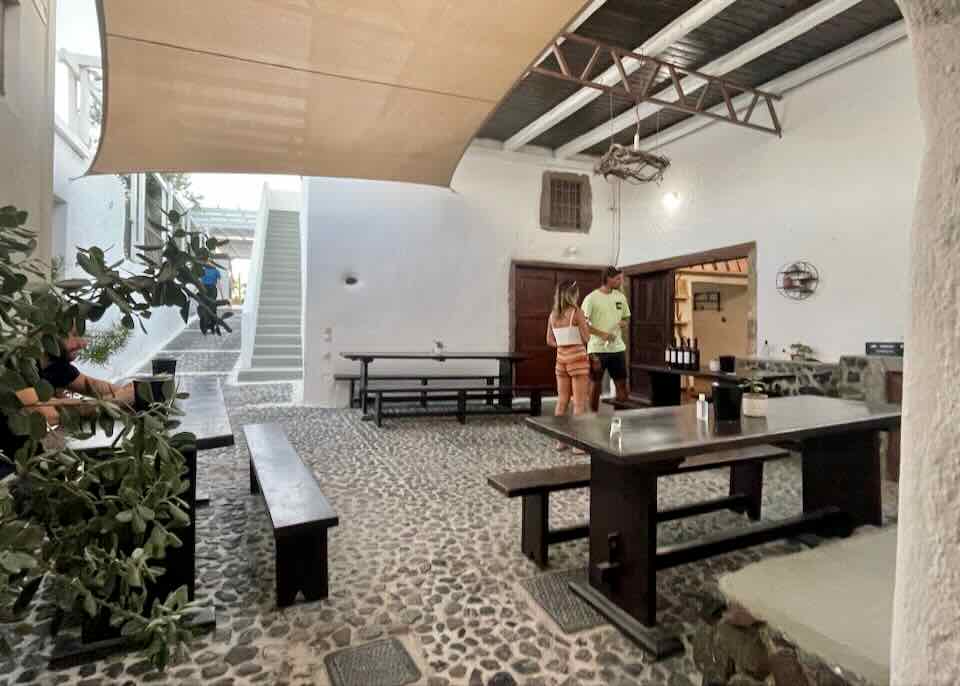
Gavalas tasting room.
August 21, 2024
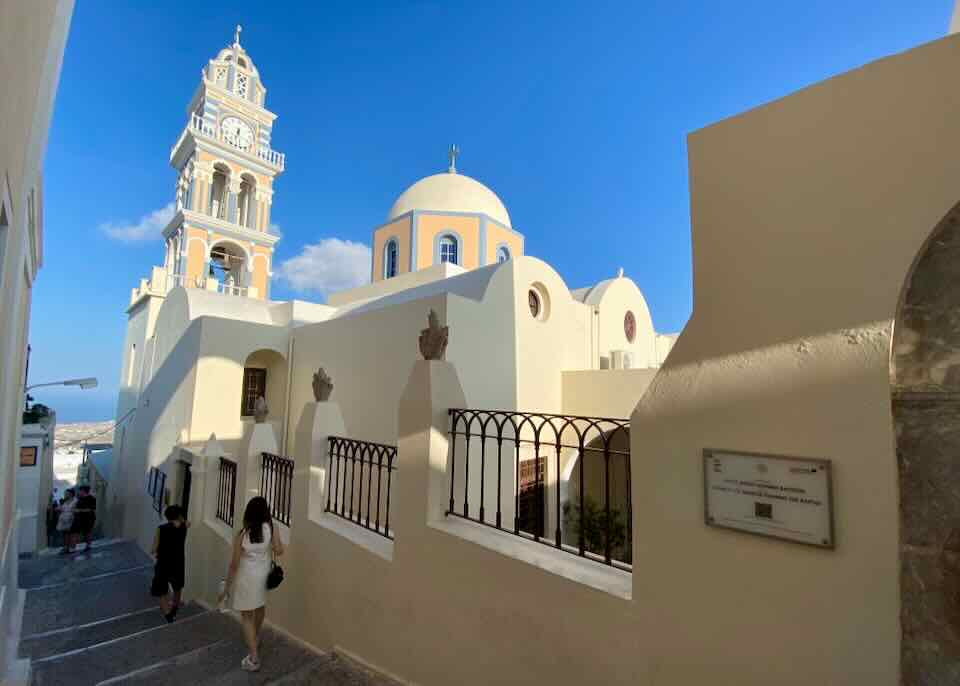
Catholic Church of Ioannis the Baptist in Fira.

The interior.
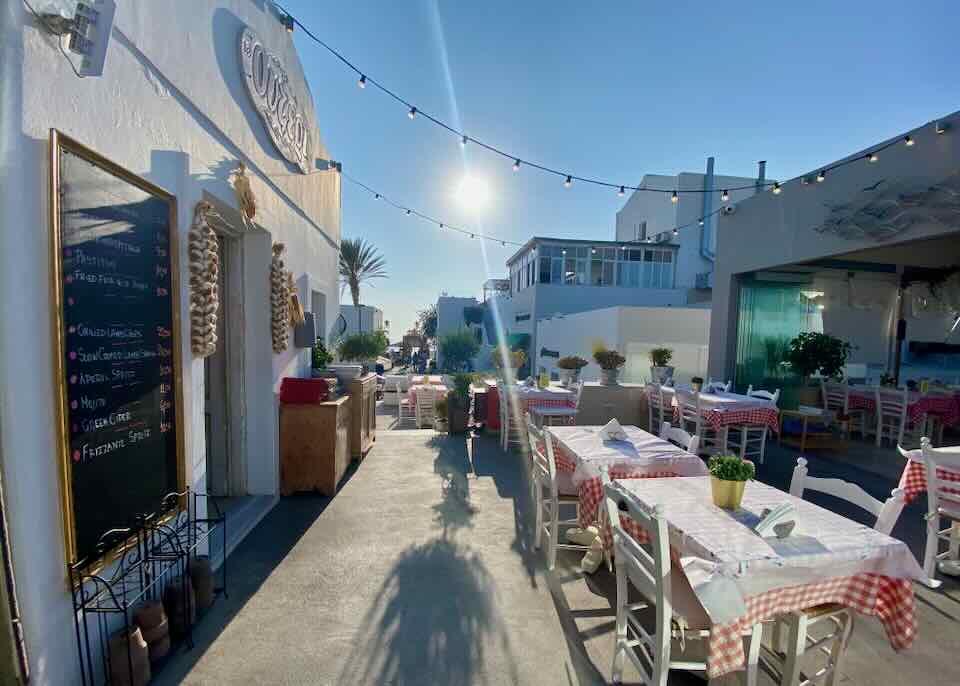
Ouzeri, one of my favorite restaurants in Fira.
August 20, 2024
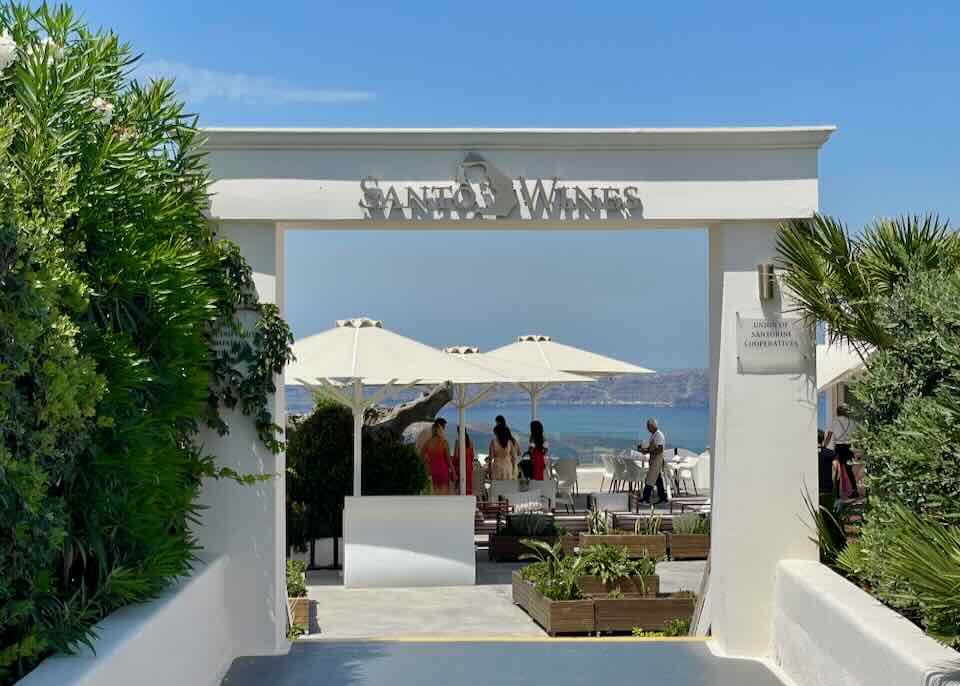
Fantastic caldera views from Santo Wines.
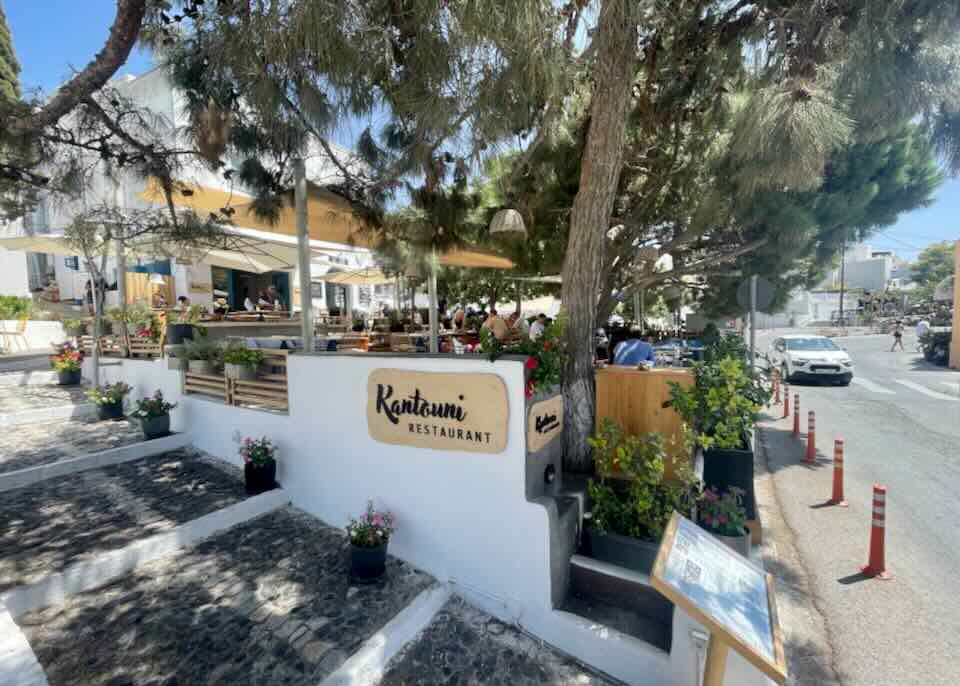
To Kantouni traditional restaurant in Pyrgos.

Variety of fresh, oven grilled mushrooms with fresh tomato, gruyere cheese & crouton; and Stuffed homemade vine leaves with yoghurt (Dolmadakia).

Kontosouvli pork with tzatziki pita bread and rustic potatoes.

Gyros rooster with carob-flour pita bread, french fries, tomato, onions, yoghurt sauce and spicy green curry mayonnaise.
August 19, 2024
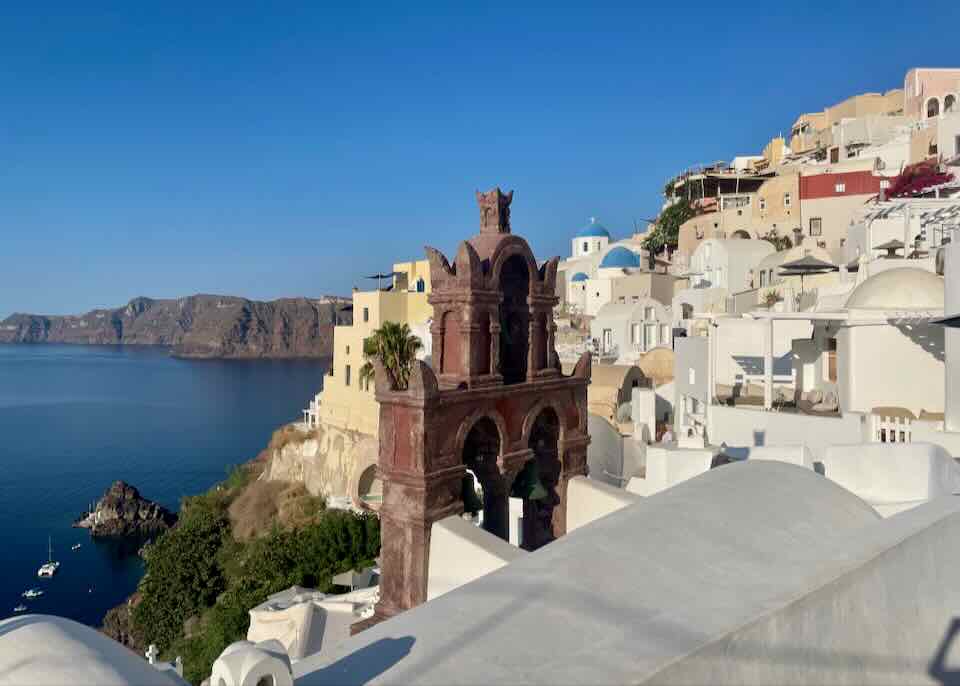
Oia in the early morning.
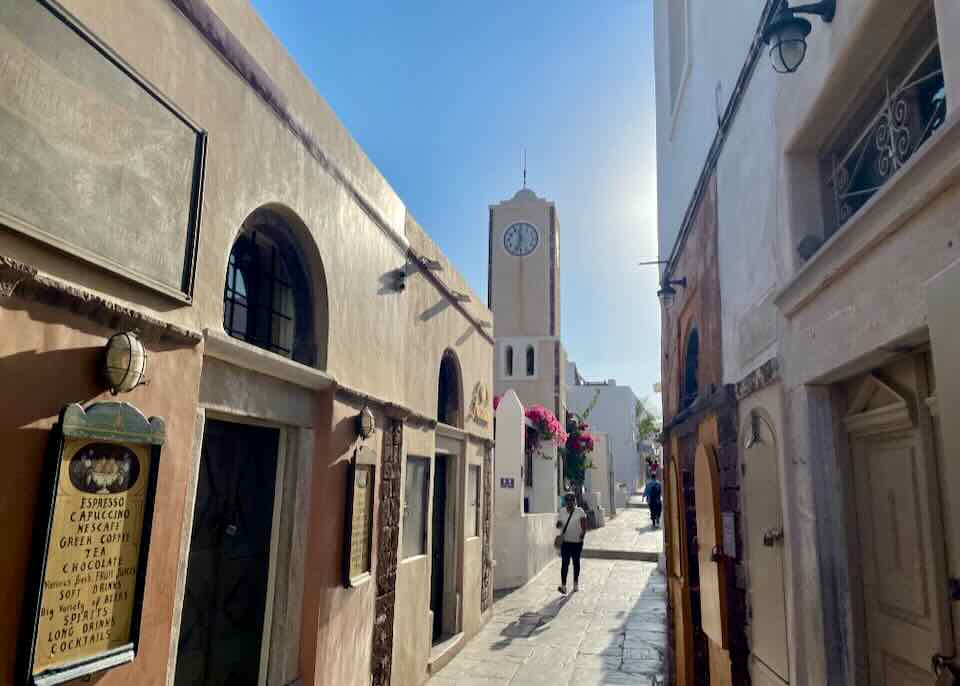
Streets are still quiet.

One of One Villas in Oia.

Sophia Oia View (3 suites all with caldera view).
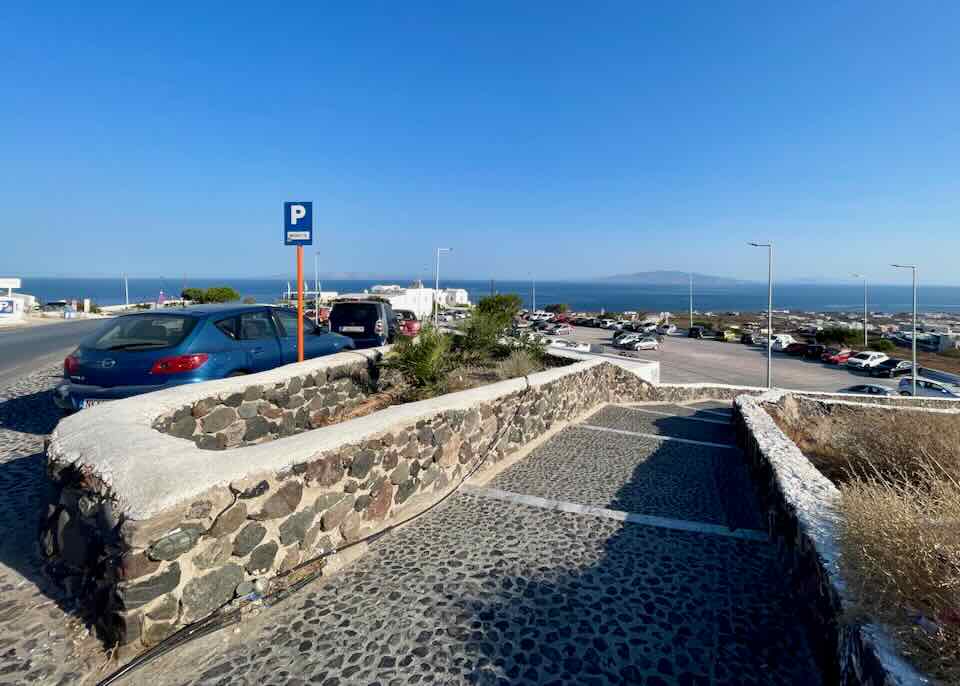
Free parking lot in Oia. Located here. Usually plenty of open spots until about noon.
August 18, 2024

Theros Wave Bar on Santorini’s southern coast.

Entrance to Theros.
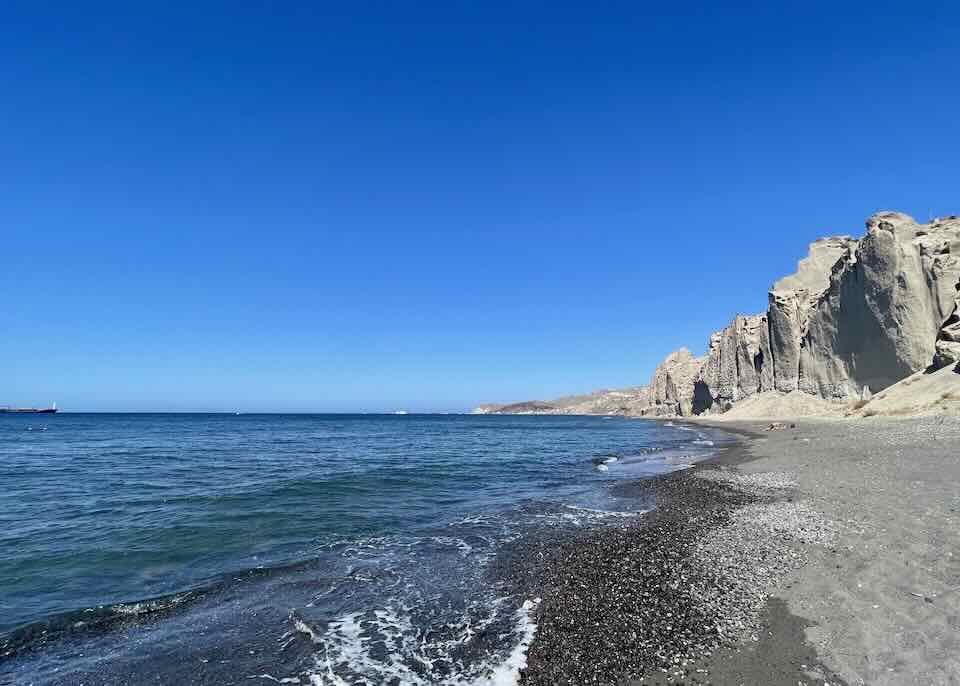
Looking west from Theros.
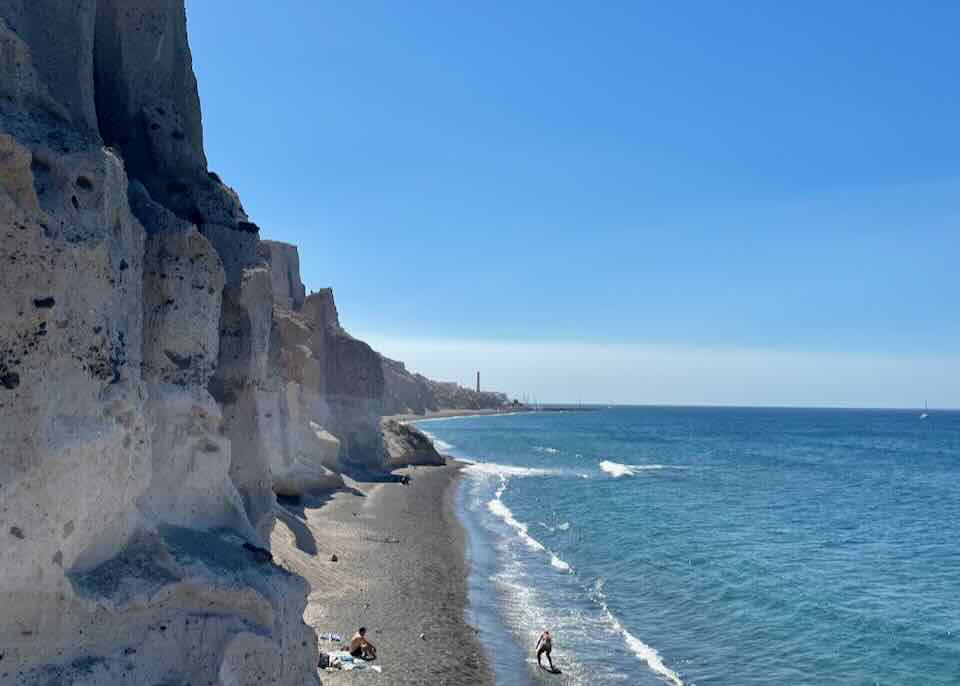
Looking east from Theros (towards Vlychada beach and marina).
August 17, 2024
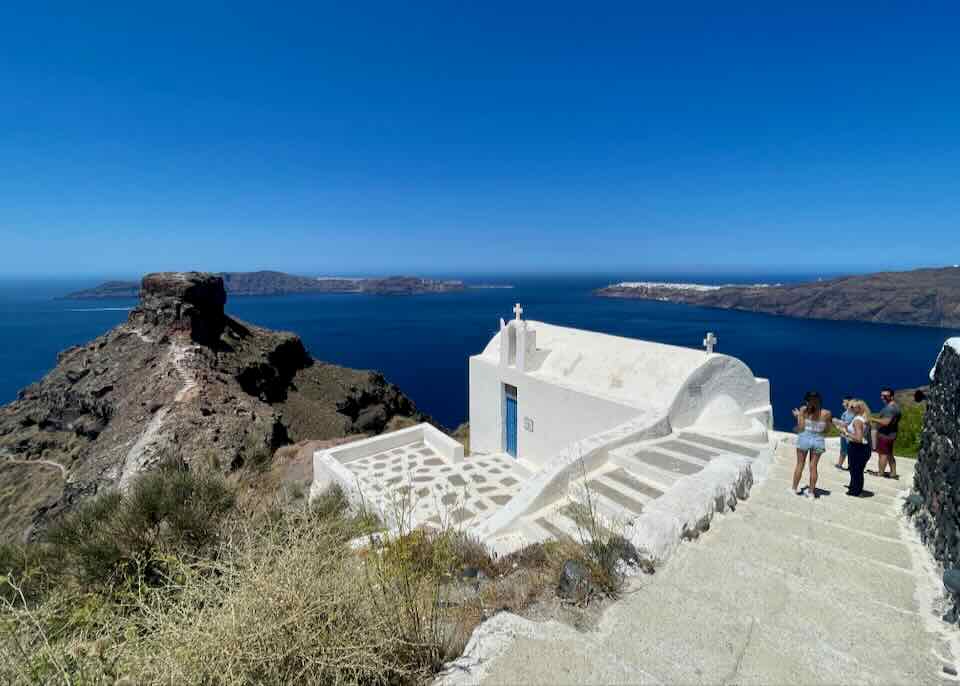
Saint John the Beheaded (Katiforis) Holy Orthodox Chapel in Imerovigli.
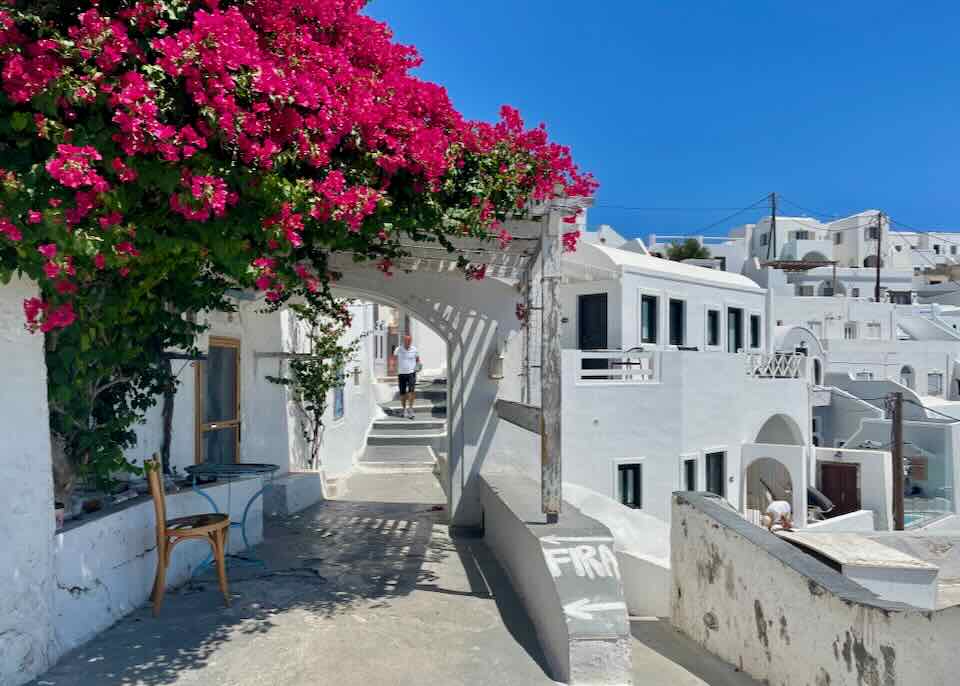
The walking path from Imerovigli to Fira.

Grace Hotel in Imerovigli.

New sweet food truck – Jerry’s: Tasty treats in Fira.
August 16, 2024
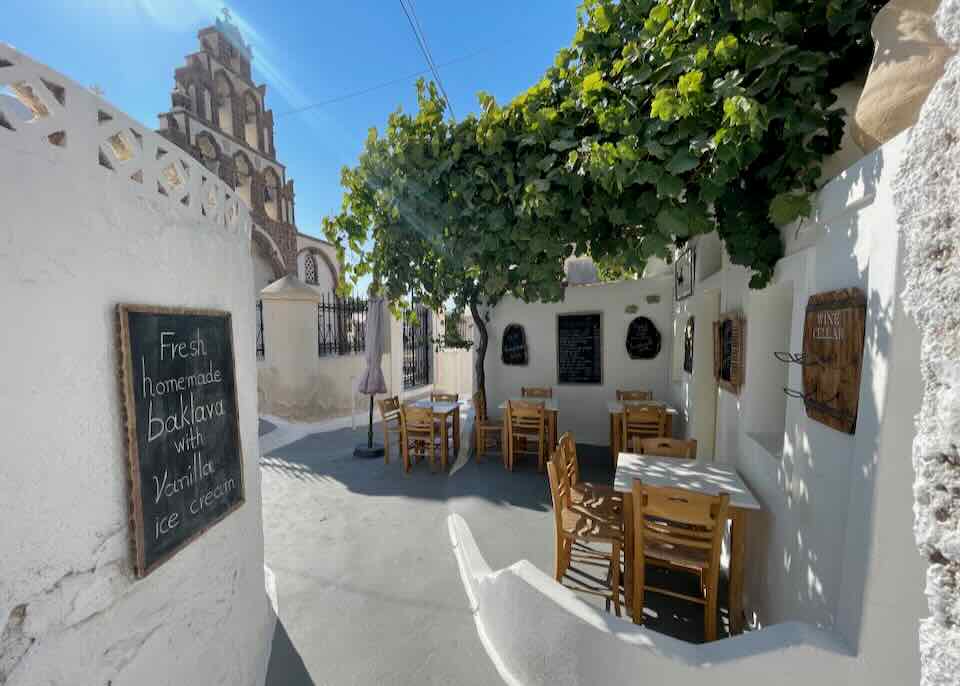
To Kafenedaki tou Emporiou: A cozy café offering a taste of local life.
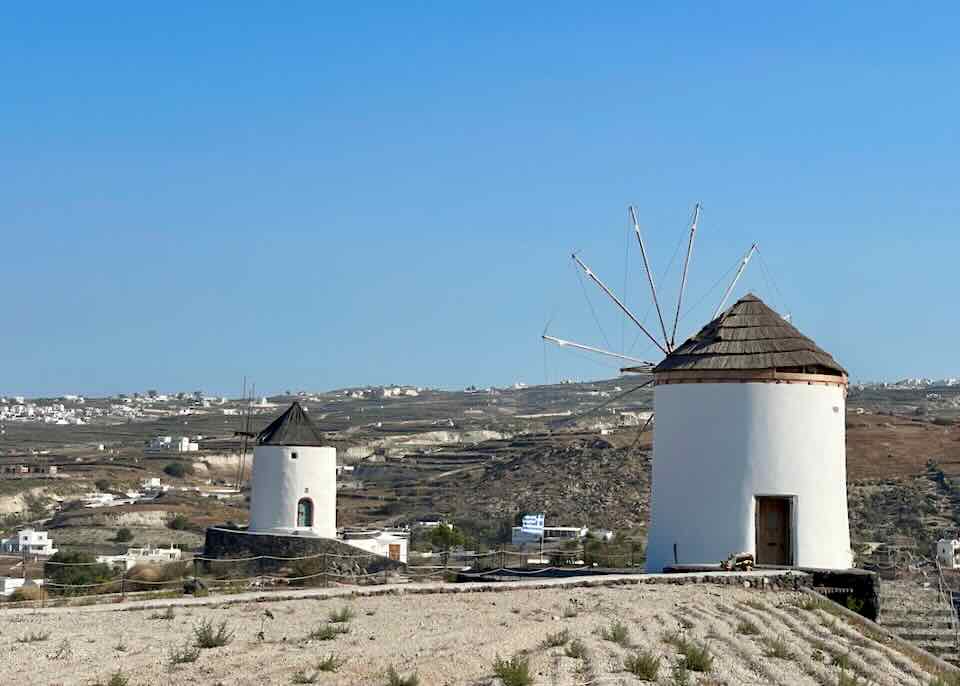
Windmills near Emporio.
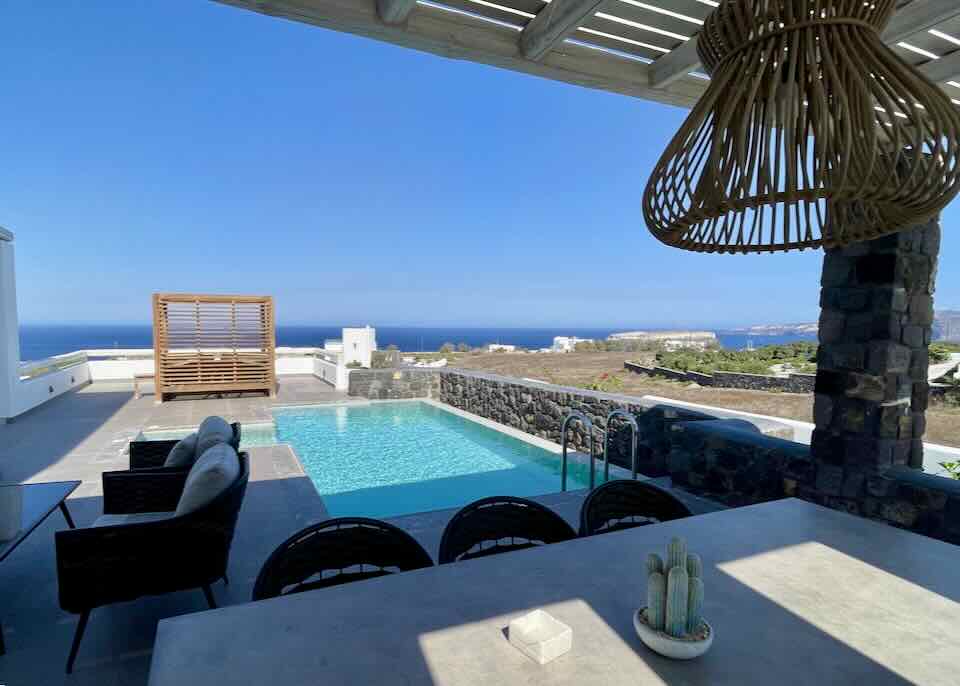
La Ponta hotel in Akrotiri.
August 15, 2024
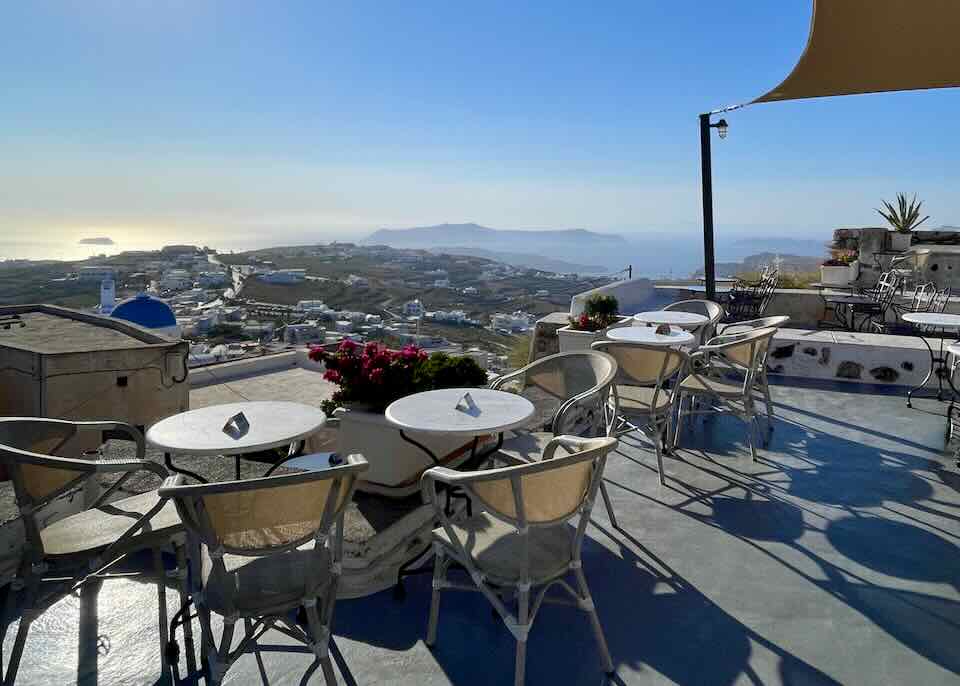
Rooftop view from Franco’s Cafè in Pyrgos.

Saint Ierotheos Church in Pyrgos.

The narrow paths and passageways of Pyrgos.
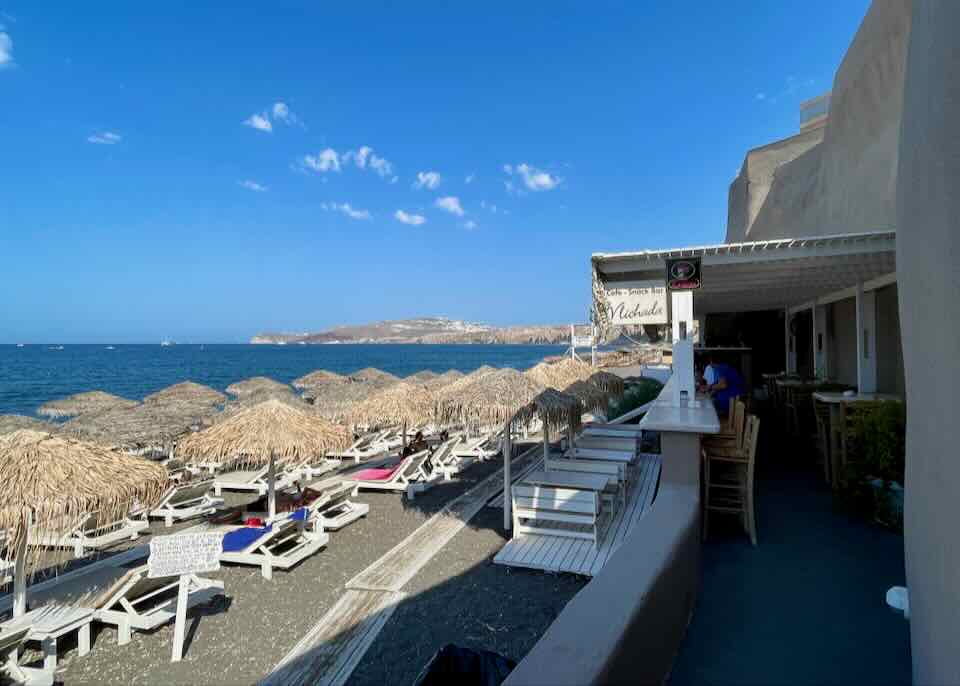
Vlychada Cafe & Snack Bar on Vlychada Beach.
August 14, 2024
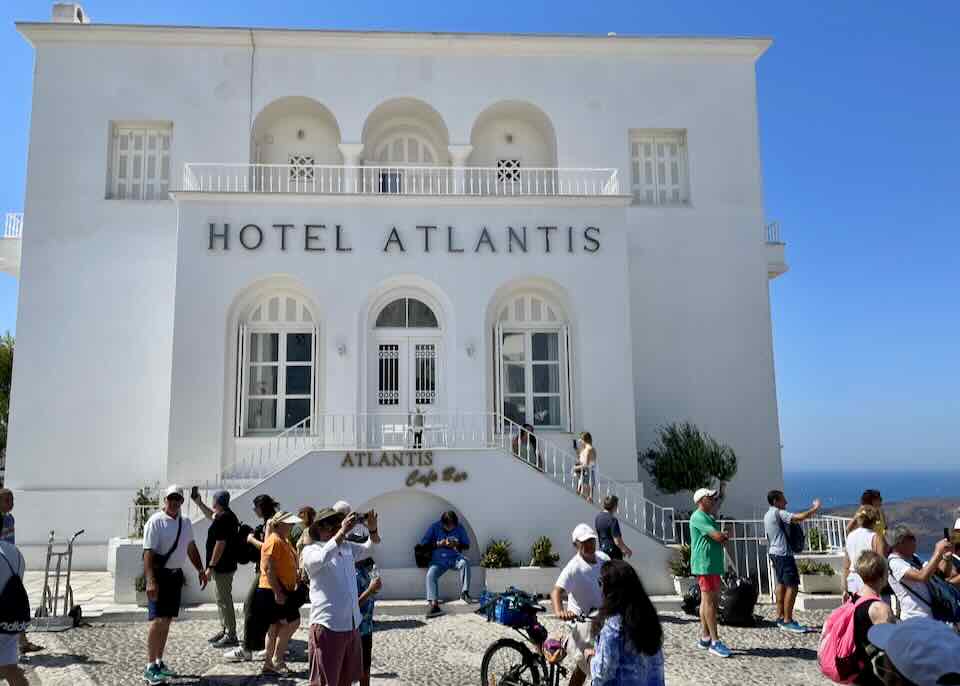
Iconic Hotel Atlantis in Fira. Opened in 1954, I don’t consider it a luxury hotel. But reasonable prices and a great location make it a charming (if dated) option.
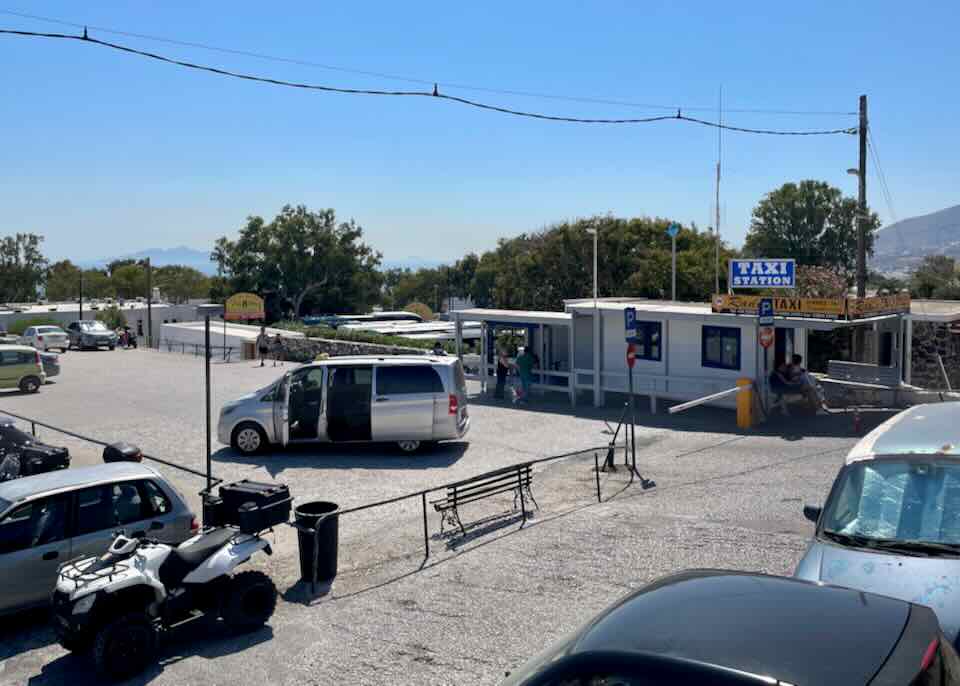
The taxi station in Fira (directly beside the bus station). Occasionally, there’s a taxi waiting here but probably not. If you’re desperate for a taxi come here and talk to the dispatcher.
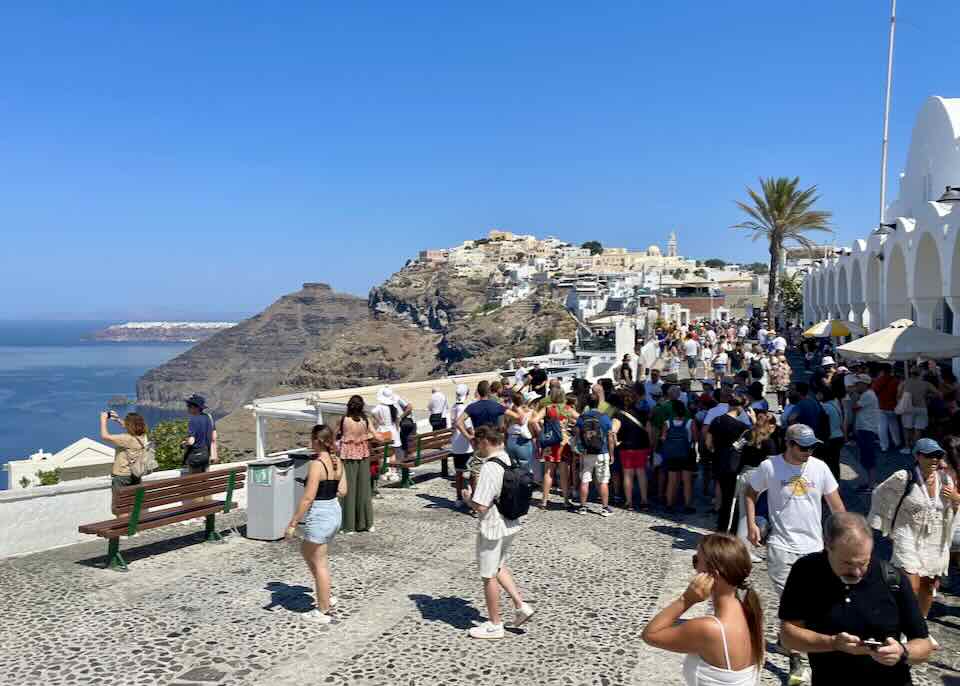
Mid-day in mid-August will find the central square of Fira absolutely packed with tourists.
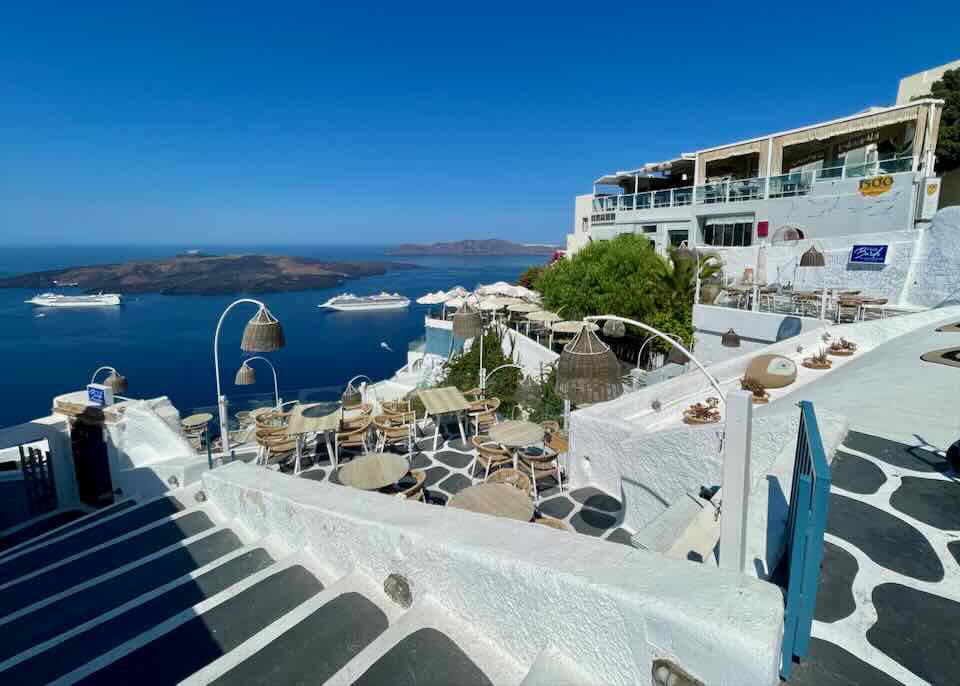
But quiet spots, like the restaurants Barolo & 1500 BC, a three-minute walk south of the main square, are surprisingly easy to find.
August 13, 2024

Saint Taxiarchis Church in Megalochori. (Looking west into the caldera.)
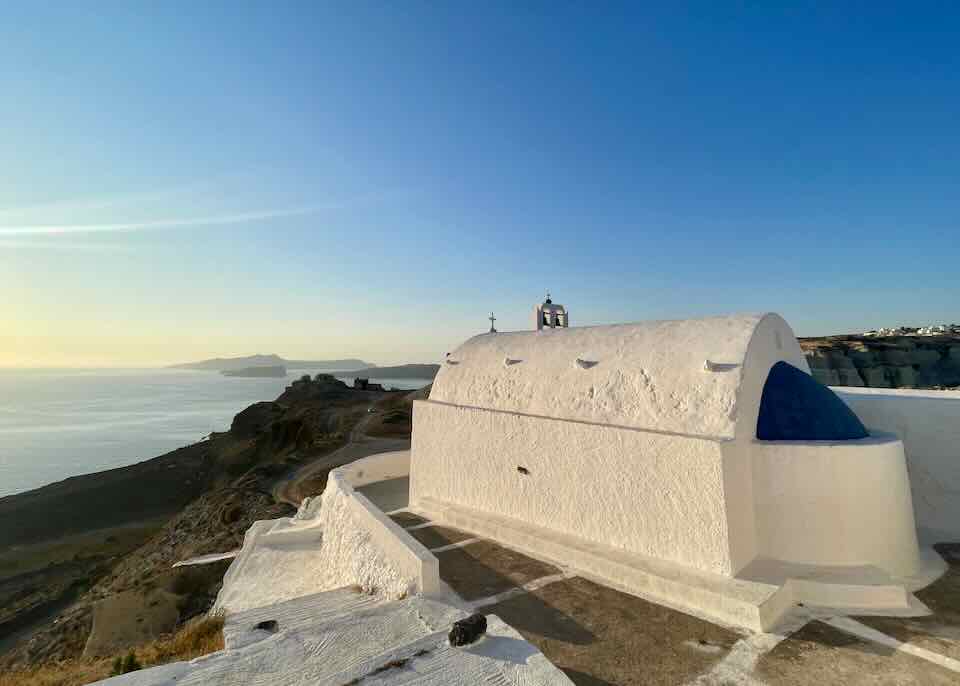
It’s a traditional Cycladic church. (Looking north into the caldera.)
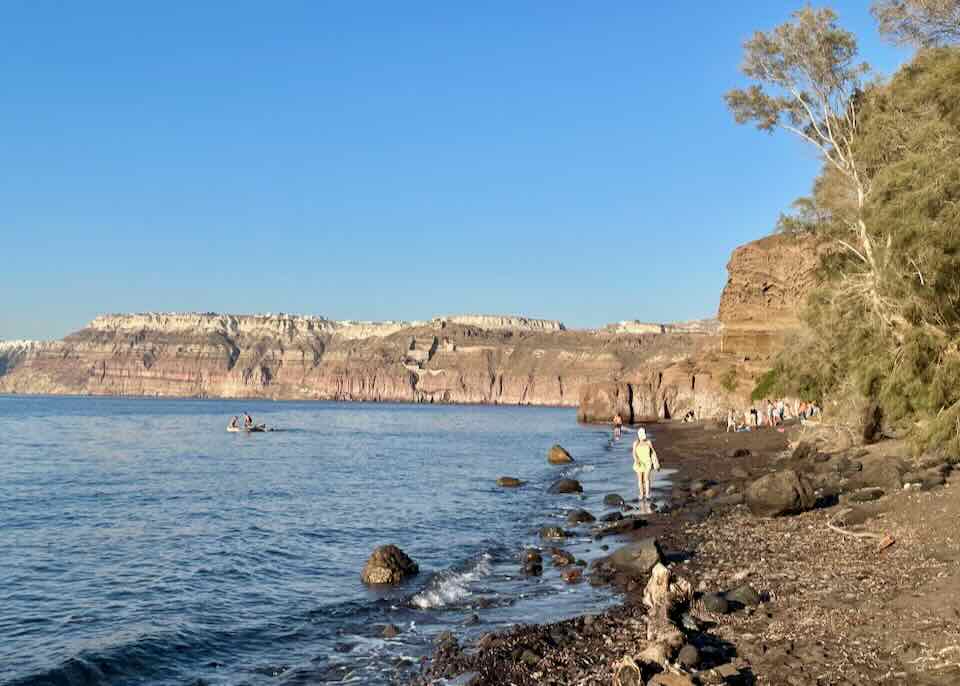
Caldera Beach (Apothiki Beach).
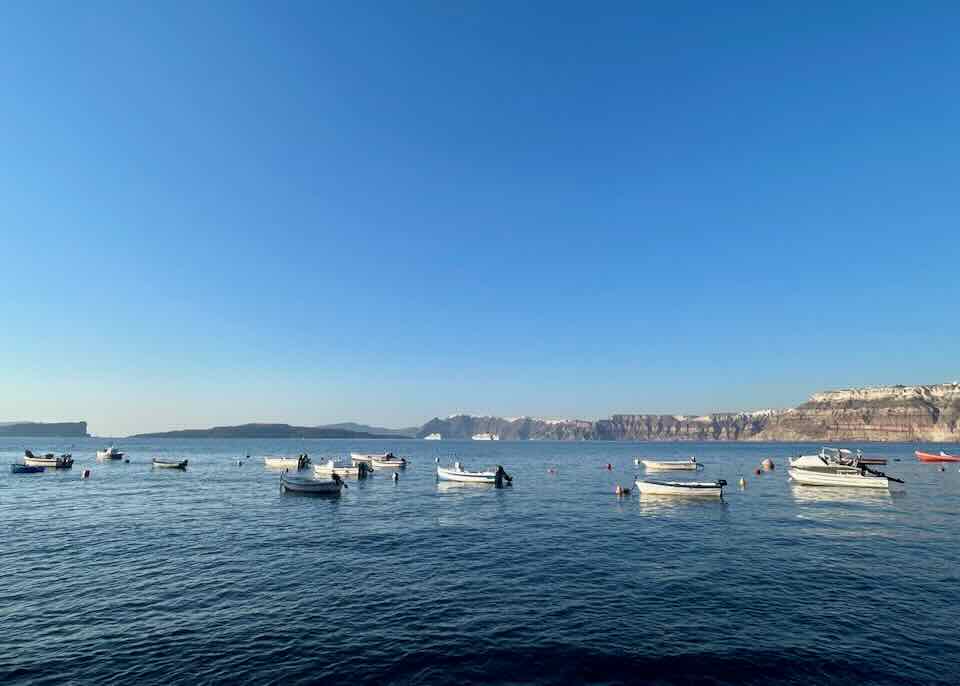
Looking out into the caldera from Caldera Beach.
August 12, 2024
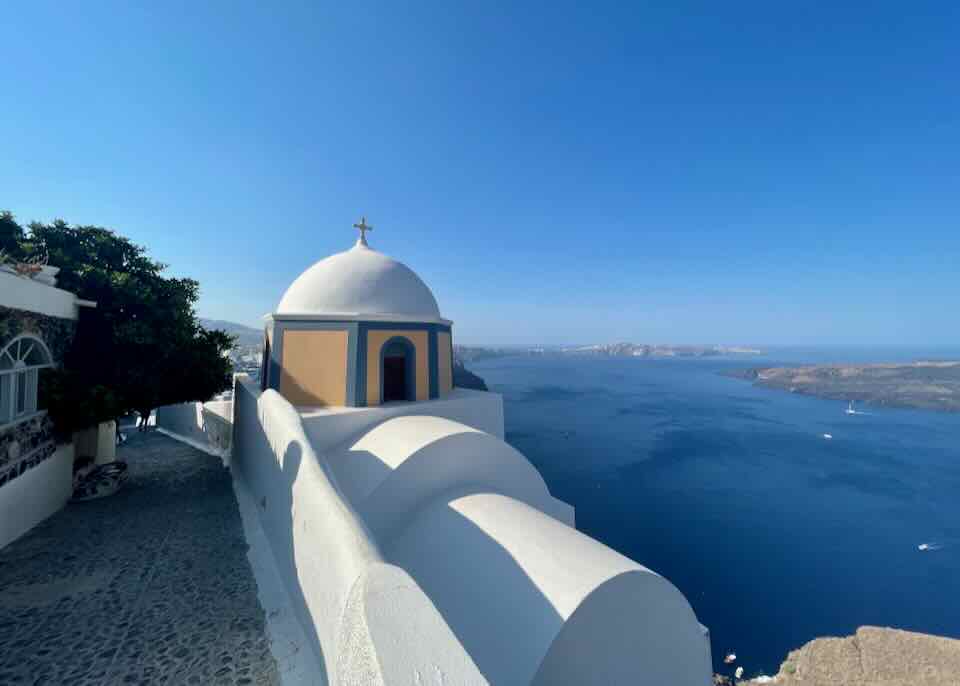
Church of Agios Stylianos in Fira.

Early morning there is no line for the cable car down to the Old Port.
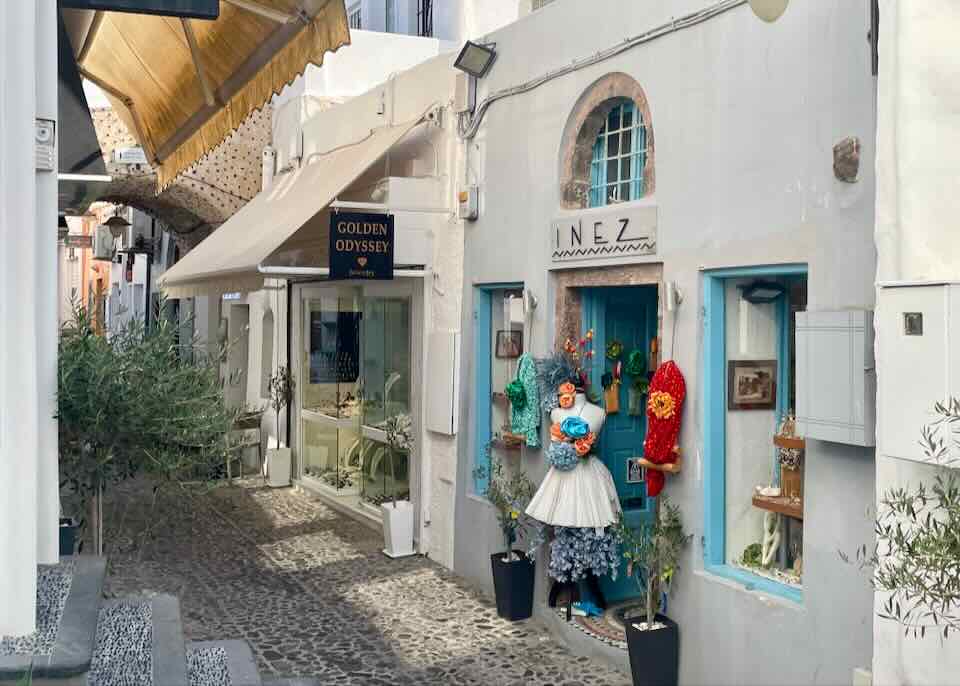
Inez Jewelry in Fira.

Located in the heart of Fira, this boutique jewelry shop has been a gem for 26 years, offering unique pieces crafted by Greek-Australian owner Inez and other local artists.
August 11, 2024

One of our favorite hotels on the island, Perivolas in Oia.
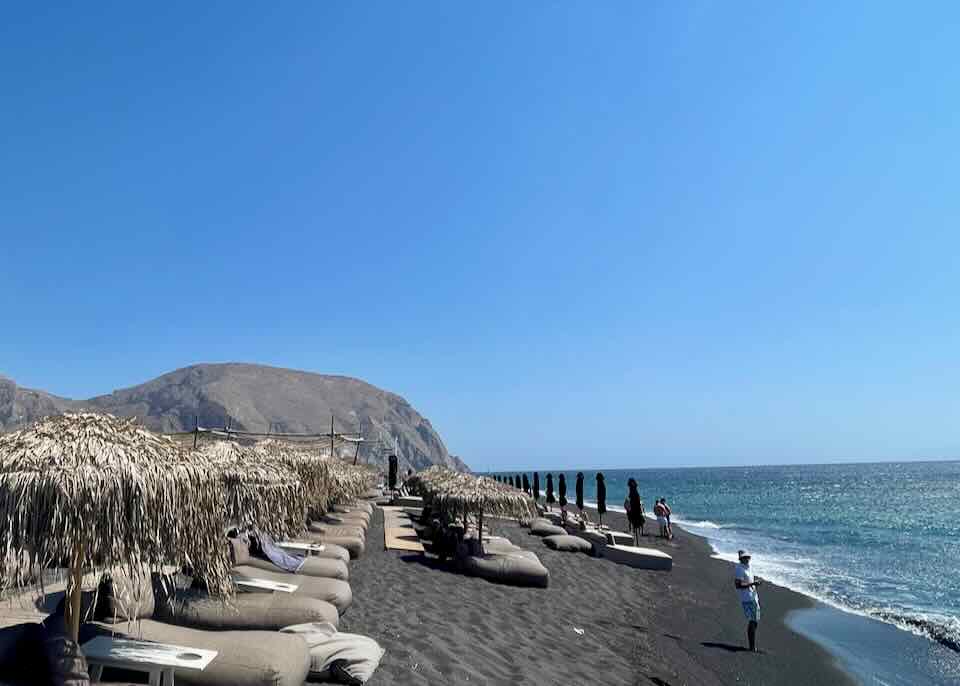
Wet Stories Bar in Perissa.
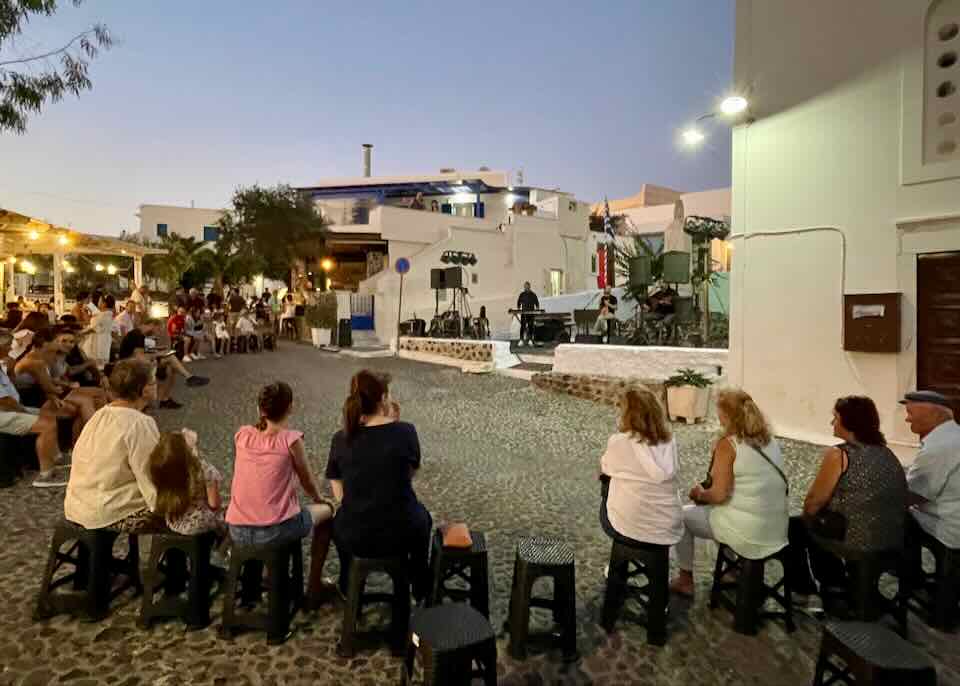
Live Greek Music in Megalochori Square.
August 10, 2024
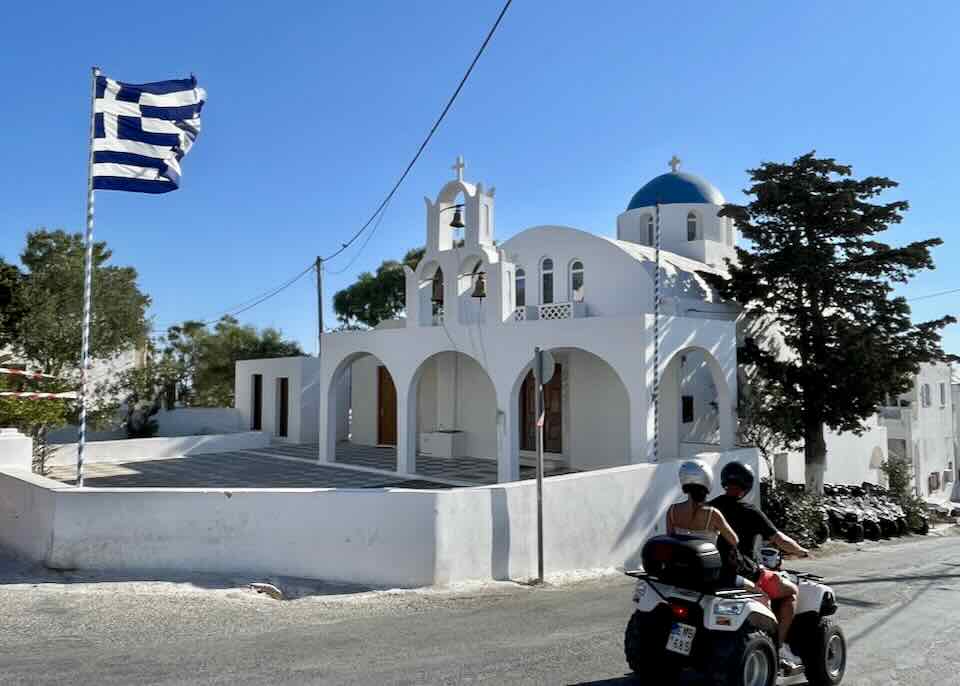
Saint John Chrysostom church in Imerovigli.
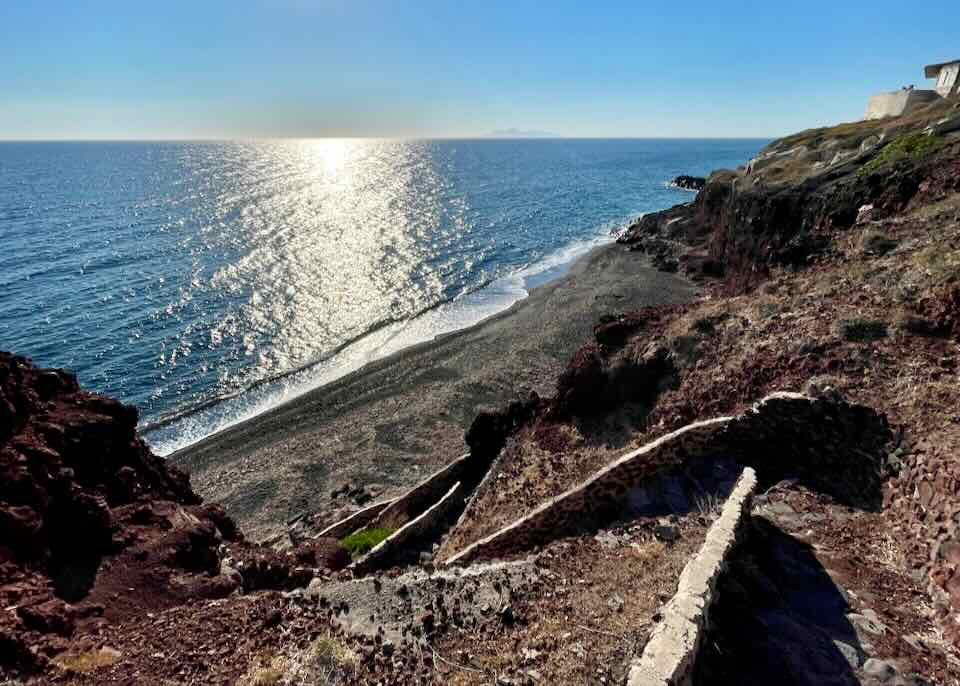
The winding path down to Pori Beach. A small, quiet gem of a beach with red sands on Santorini’s east coast. The Greek Island of Anafi visible in the distance.

Caldera views and private pools at Cavo Tagoo in Imerovigli.
August 9, 2024

Views of the caldera from Iriana Cafe in Fira.

Greek treats at Svoronos Bakery in Fira.

Kayak, a brand new ice cream shop in Fira.
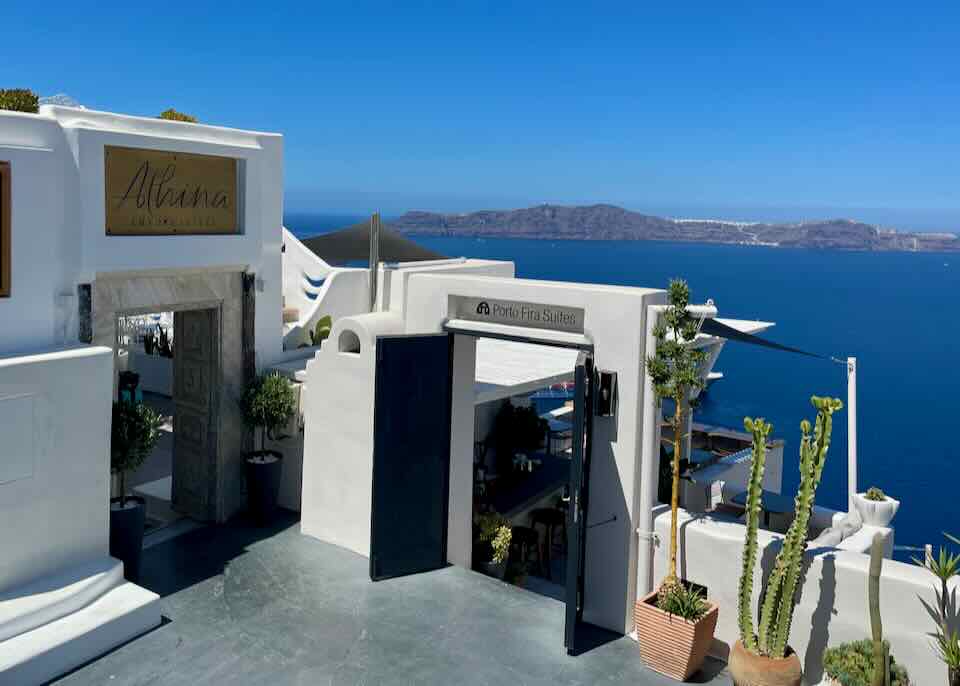
The neighboring entrances to two of my favorite hotels in Fira: Athina Luxury Suites and Porto Fira Suites.
August 8, 2024
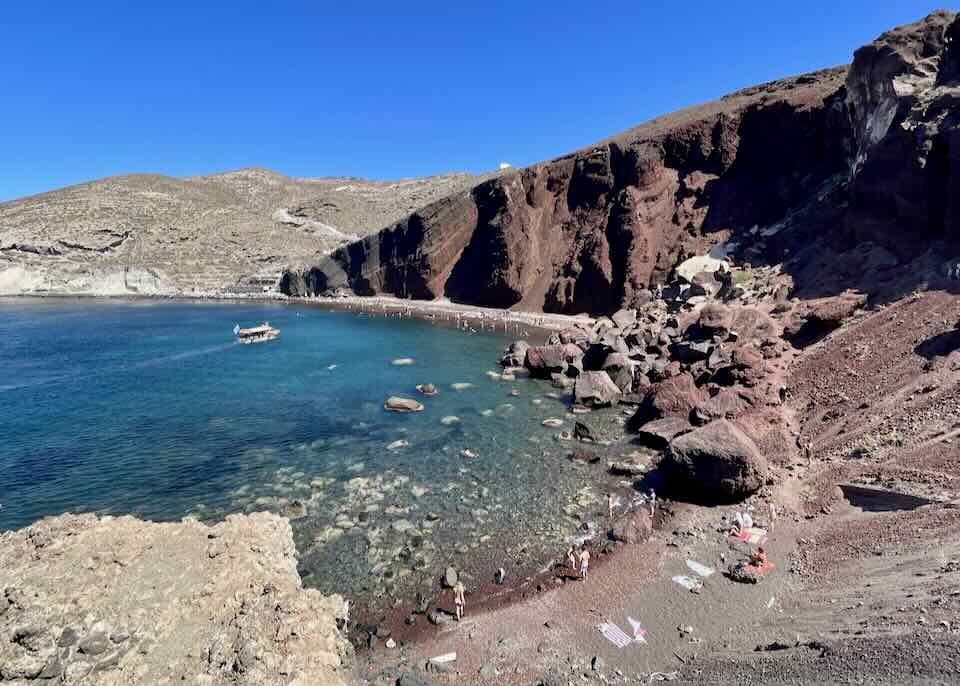
Red Beach and the water taxi from Akrotiri (stops at Red beach, White Beach, and Messa Pigadia).
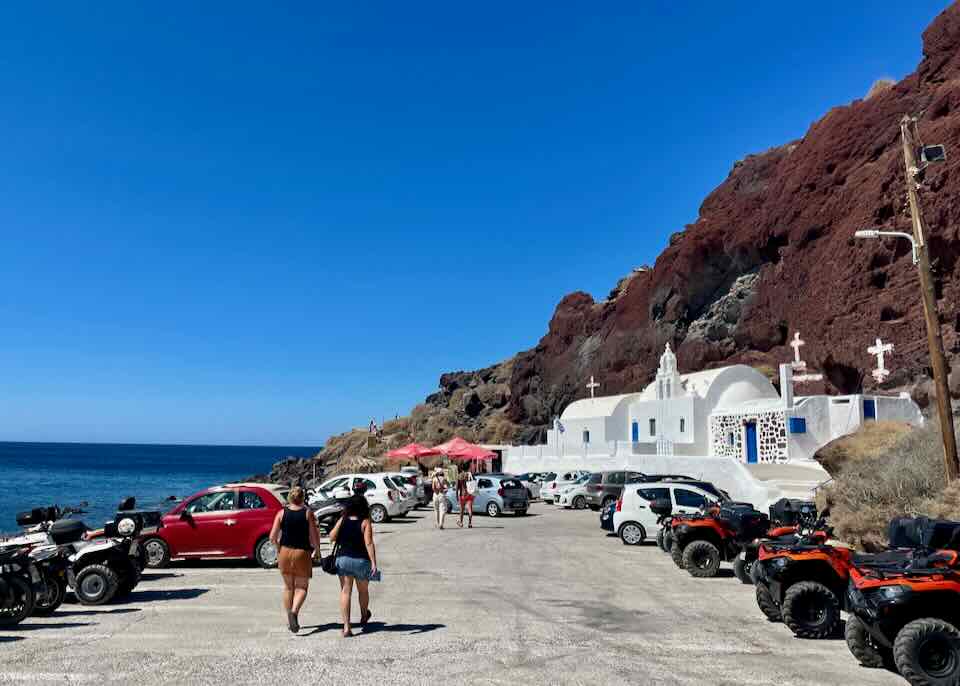
Church of Agios Nikolas and the parking lot for Red Beach.
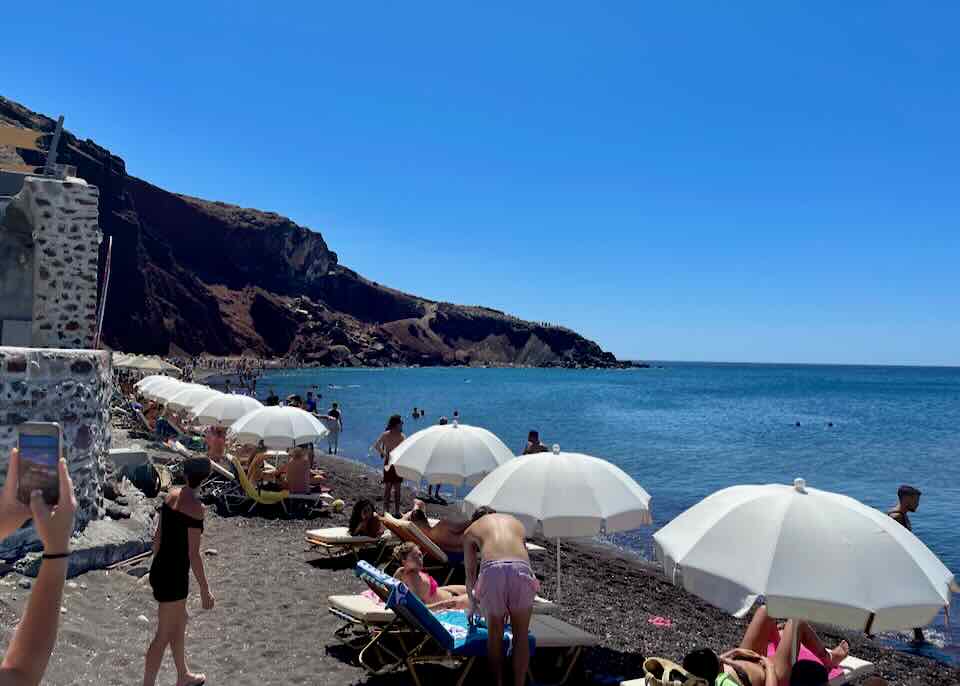
Kaminia Beach (looking towards Red Beach).
August 7, 2024
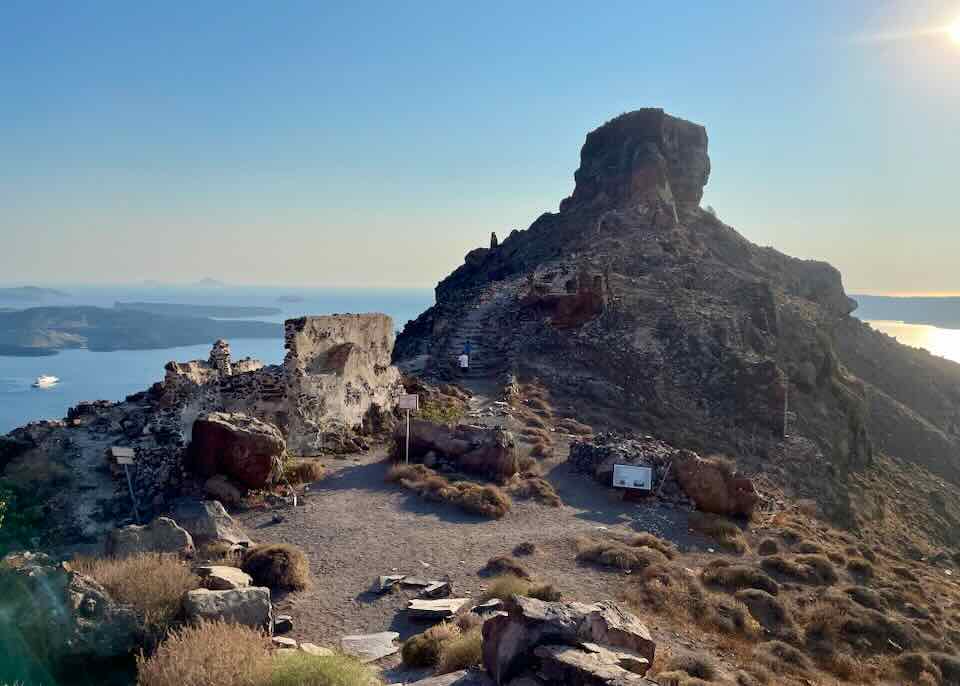
Skaros Rock juts out into the caldera from Imerovigli.
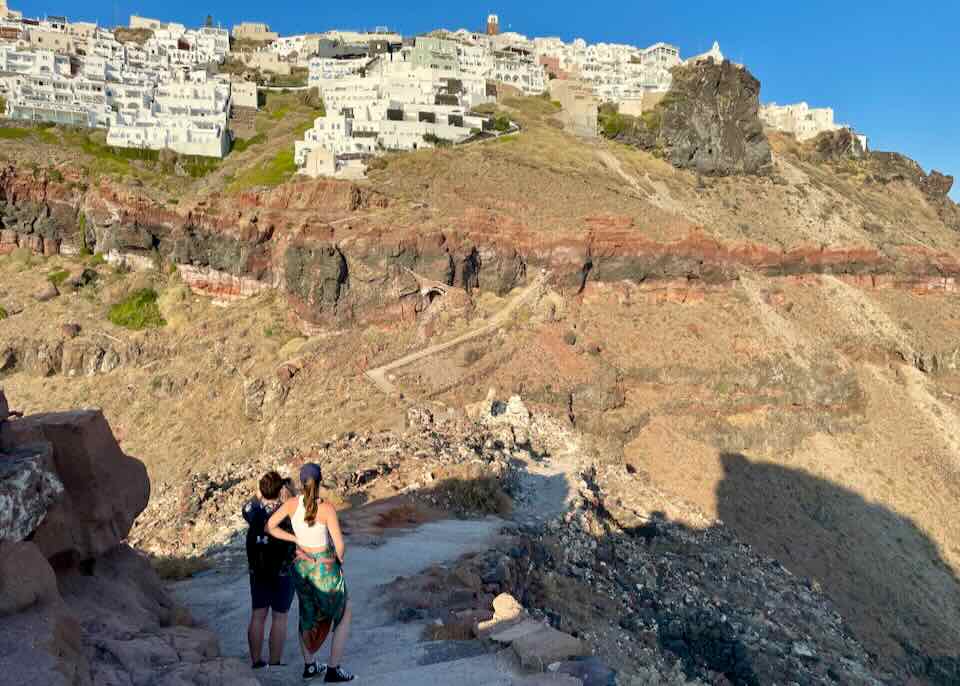
Looking back towards Imerovigli from Skaros Rock.

Church Mother of Lord Theoskepasti is hidden down the cliff on the caldera-side of Skaros Rock (you can’t see it from Imerovigli).

There are spectacular views if you walk down to the church.
August 6, 2024
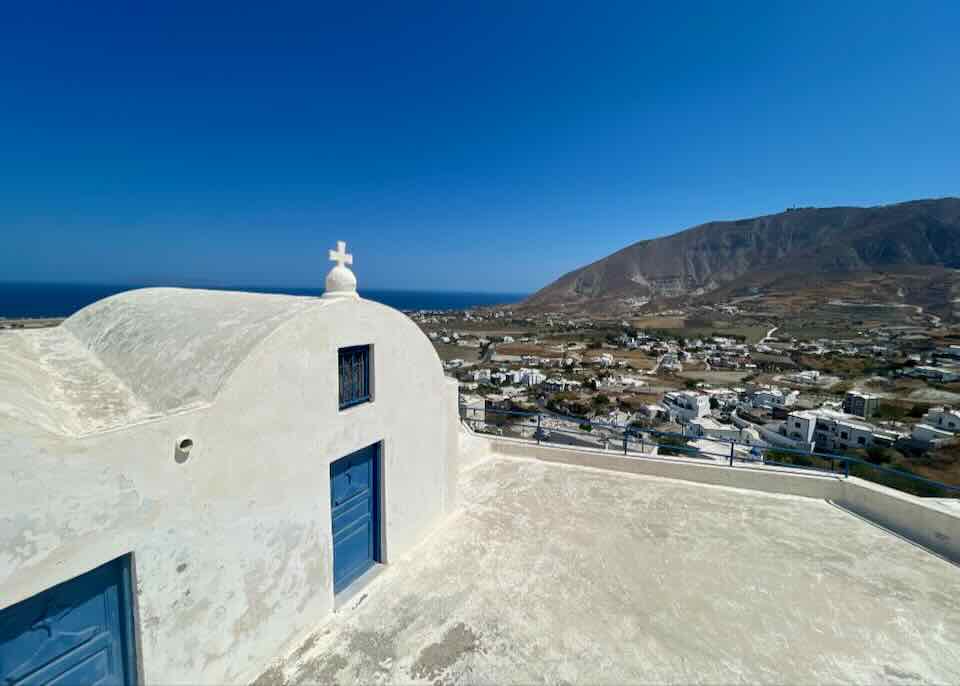
Agios Panteleimon (Άγιος Παντελεήμων): A little church in the settlement of Exo Gonia. Kamari is in the distance.
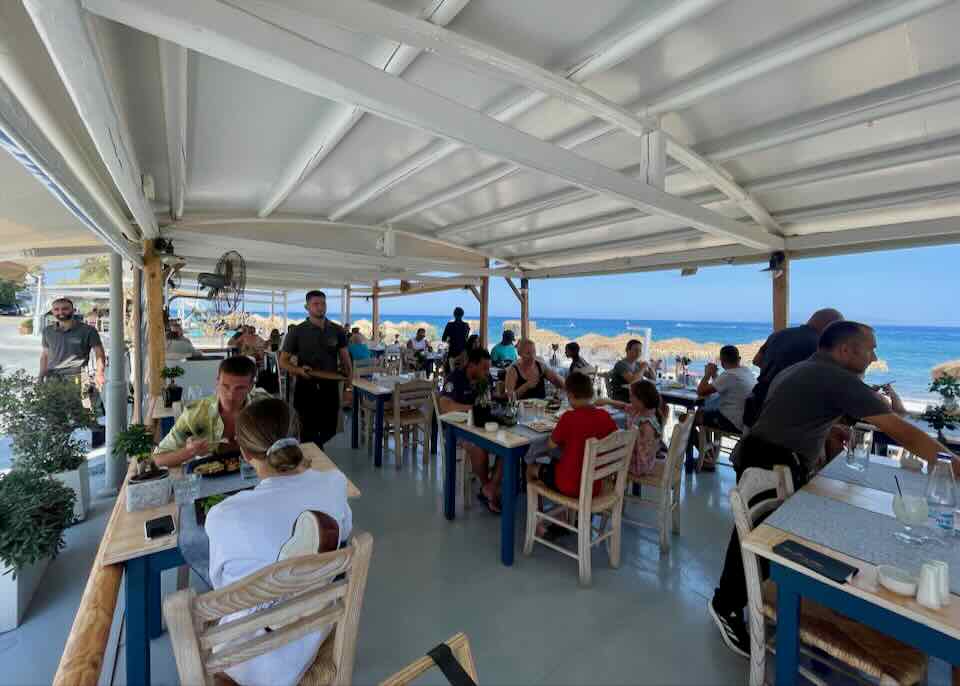
Almira restaurant in Kamari.

Greek rabbit stew (kouneli stifado) with rice and sweet potato puree at Almira restaurant. (Fresh swordfish is on the plate in the background.)
August 5, 2024
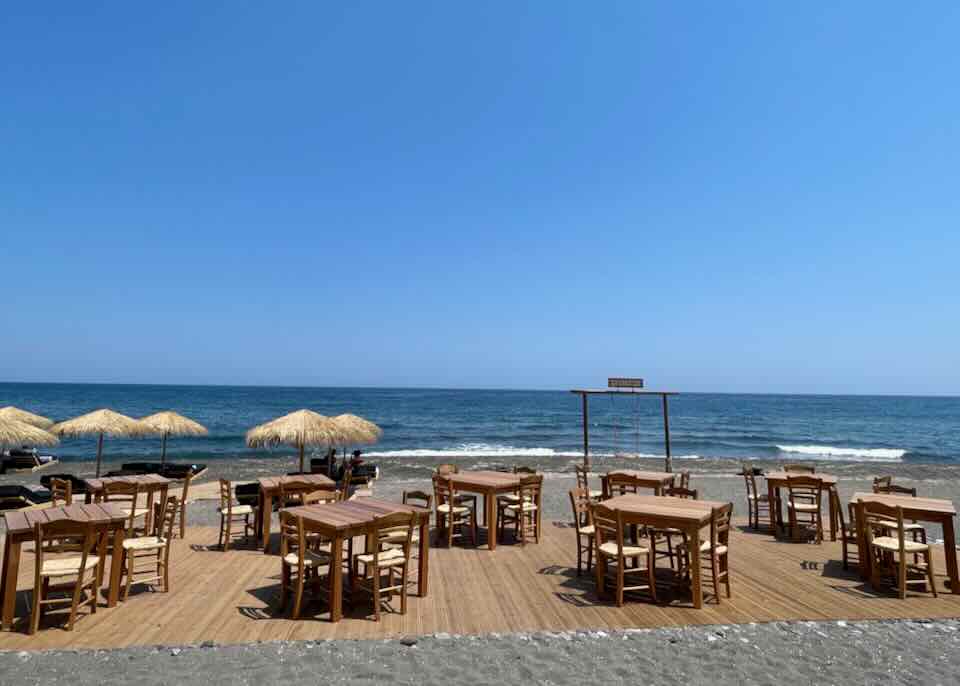
Drunkfish restaurant in Monolithos.
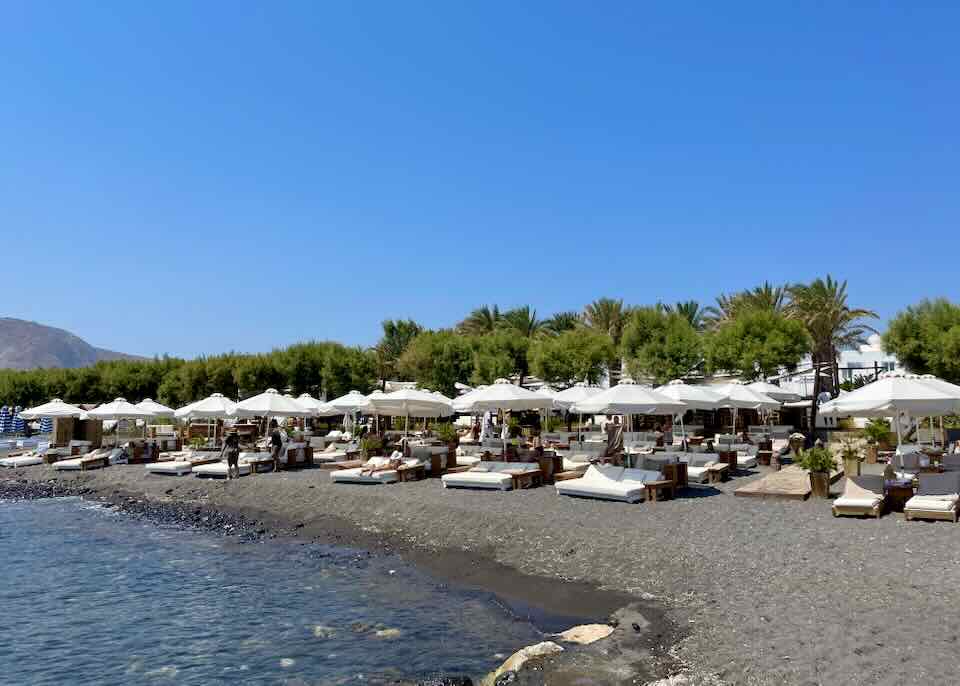
Nikki Beach Resort & Spa in Monolithos.
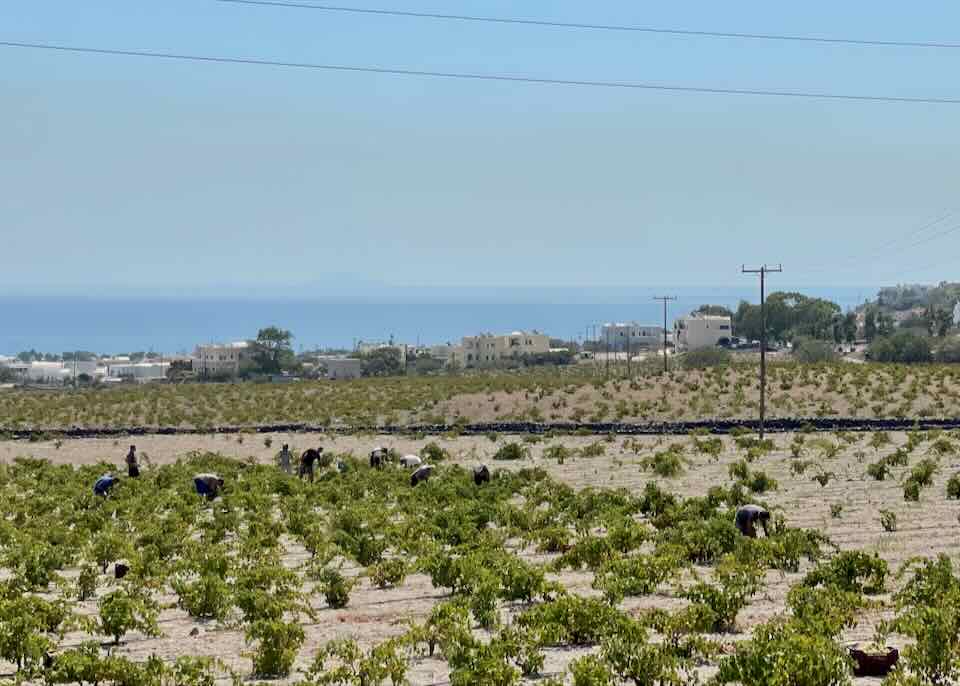
Picking grapes at Estate Argyros.
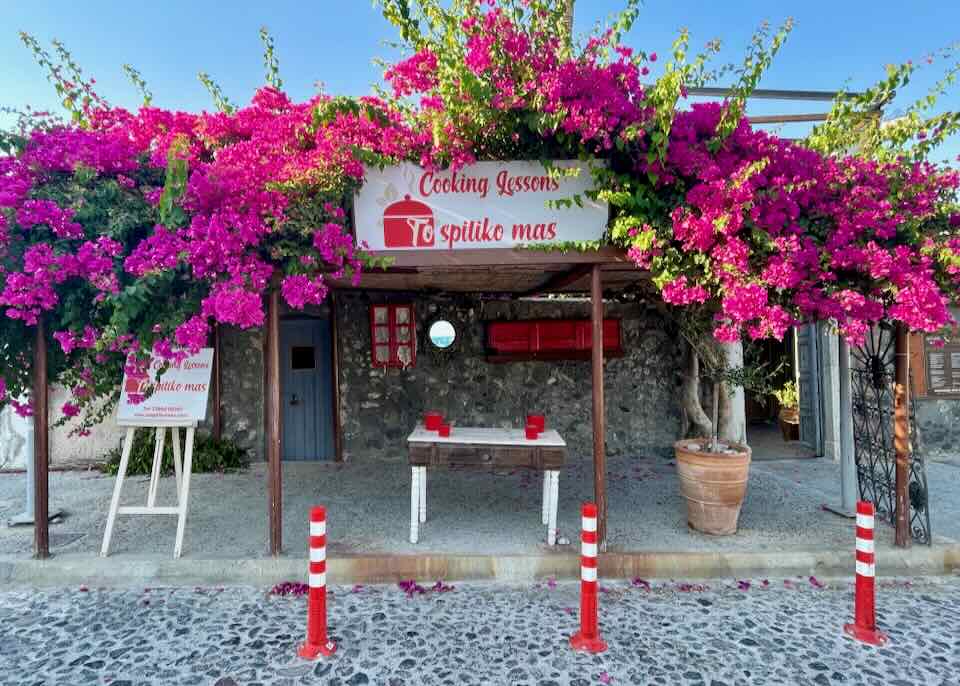
To Spitiko Mas cooking lessons in Megalochori.
August 4, 2024

Sunset crowds in Oia.

Spectacular sunset views from Kastro Oia restaurant.

Iatis Handcrafted Jewels in Oia.

Xristo has been creating handcrafted jewelry for 16+ years.

The fog rolling in around Venetsanos Winery.
August 3, 2024
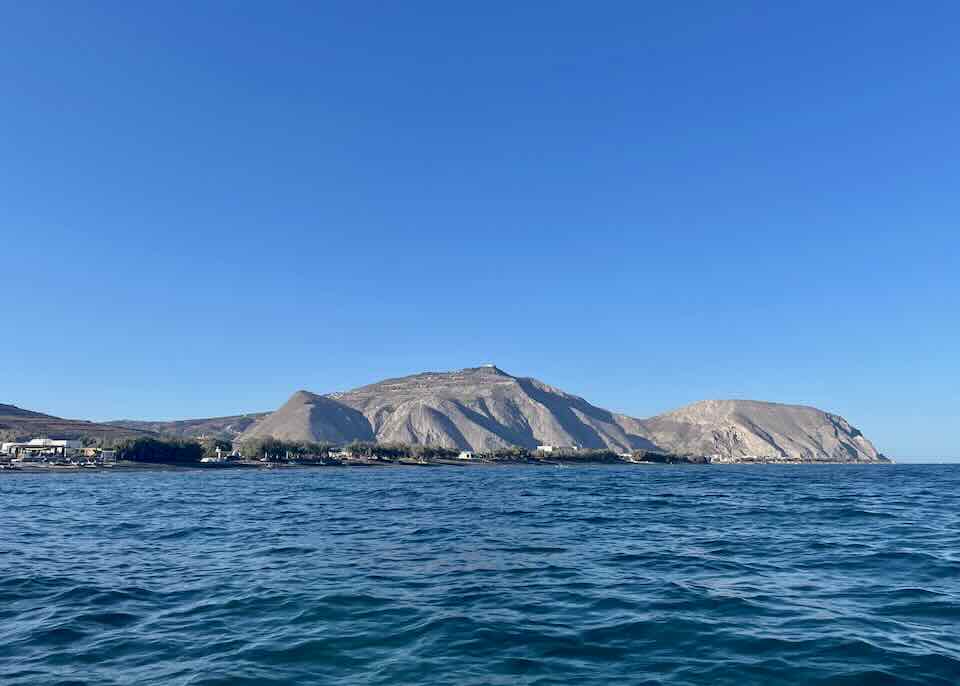
View from the sea towards Perivolos and Perissa beaches.
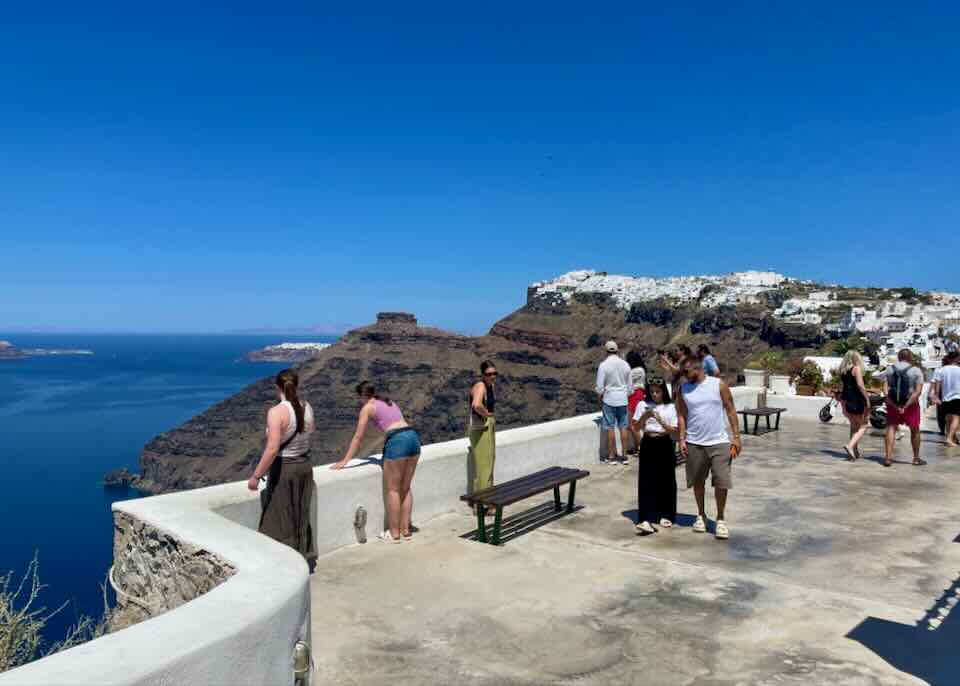
Tourists enjoying the view from the Firostefani square. (A 12 minute walk from Fira and much less busy.)

The private pool at Stilvi Suite in Firostefani.

The recently refurbished Chic Hotel in Firostefani.

Entrance to Agali Houses in Firostefani. (4-star, reasonable prices for the location, great for families. Not many hotels on the caldera allow young kids, Agali is one of the few.)
August 2, 2024

Chapel of Agios Artemios in Oia.

The Saint Hotel in Oia.
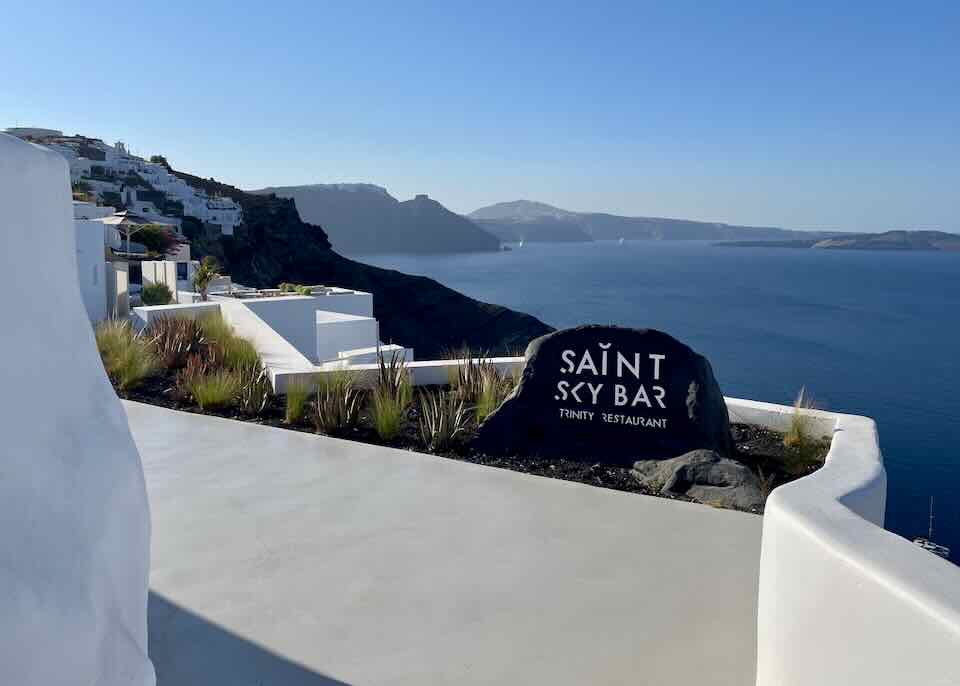
View of the caldera and Skaros Rock from Trinity, the hotel’s restaurant.
August 1, 2024
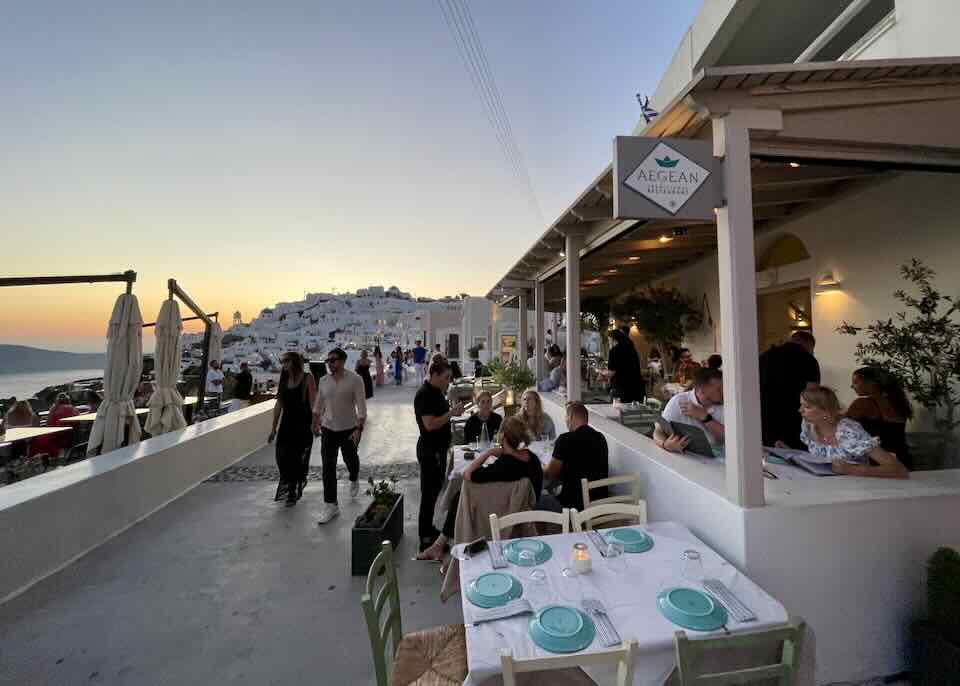
The pedestrian path through Imerovigli.

Fine dining (and incredible views) at La Maison restaurant in Imerovigli.

The entrance to La Maison.
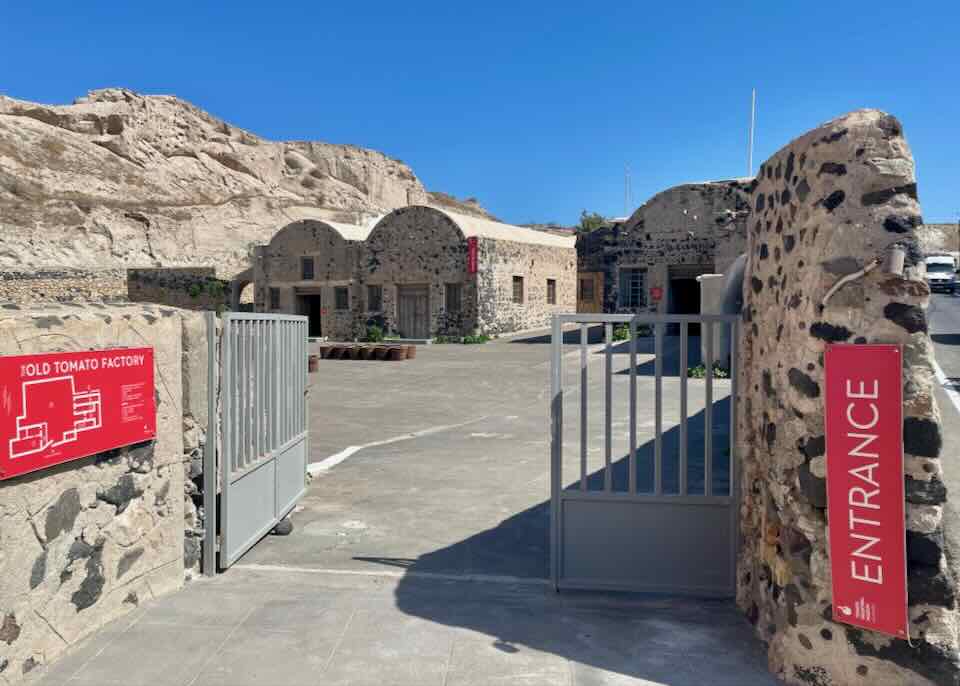
The Tomato Industrial Museum in Vlychada. An excellent introduction to Santorini tomatoes.
July 31, 2024

A charming little church (couldn’t find the name) in the back lanes of Oia.

The Windmill Suite (yes, you sleep inside the windmill) at Charisma hotel in Oia. Great unobstructed sunset views and a private plunge pool.
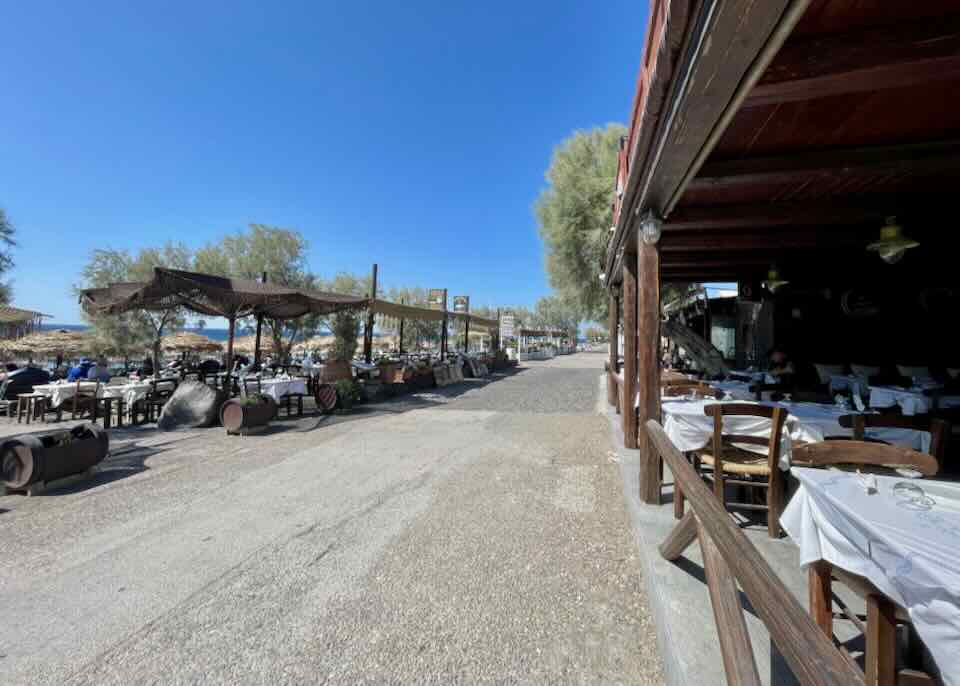
The main road in Perissa and Perivolos runs between shops, hotels, and restaurants (west side of the street) and the beach (east side of the street).
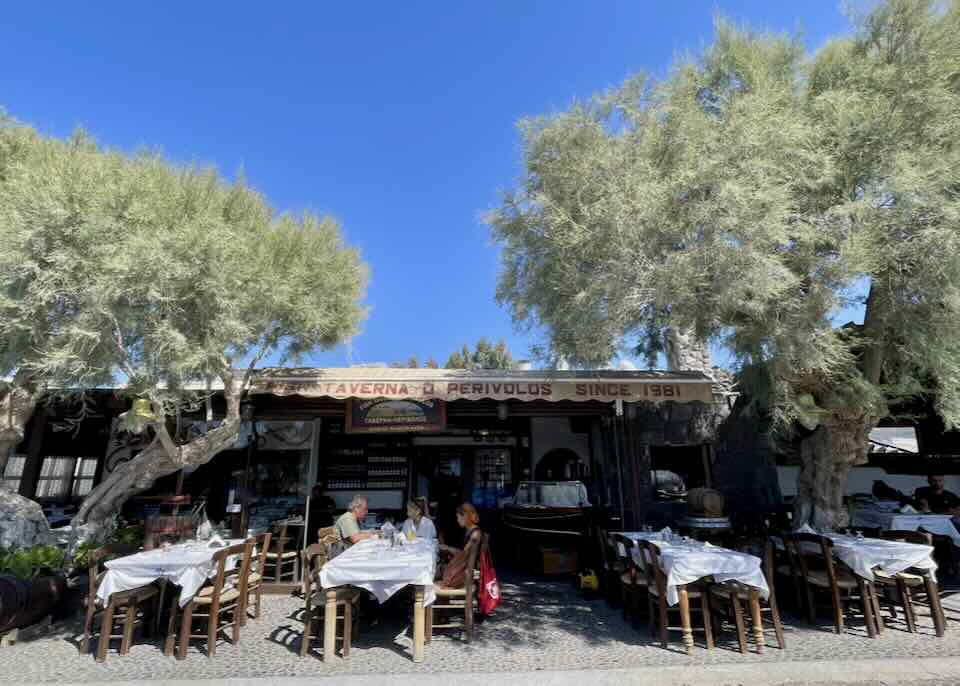
Perivolos Fish Tavern. Serving authentic Greek dishes and fresh seafood for over 40 years.
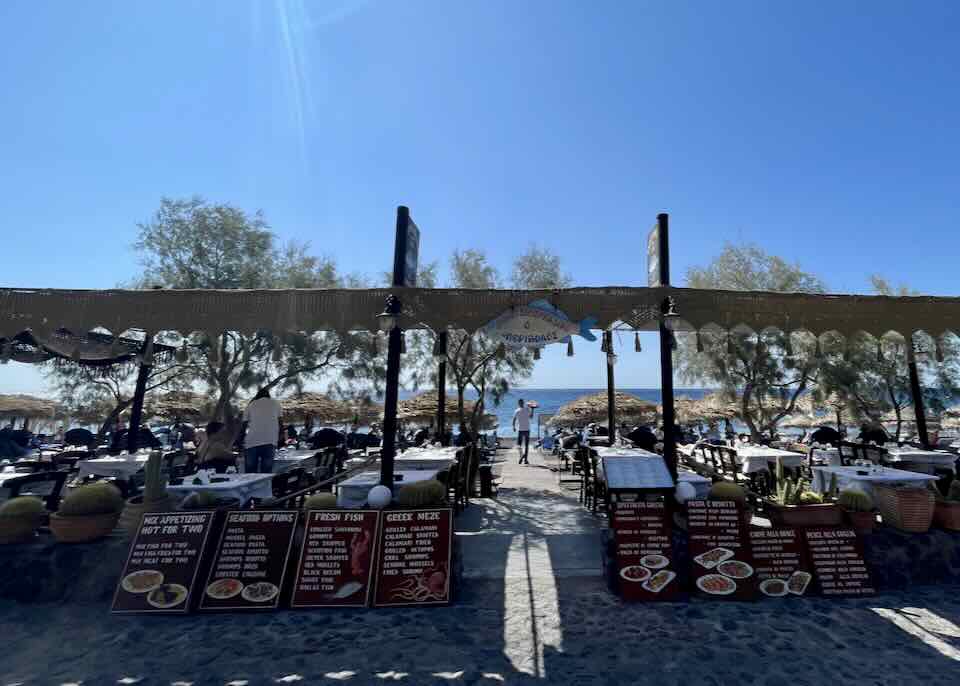
The beach seating at Perivolos Fish Tavern.
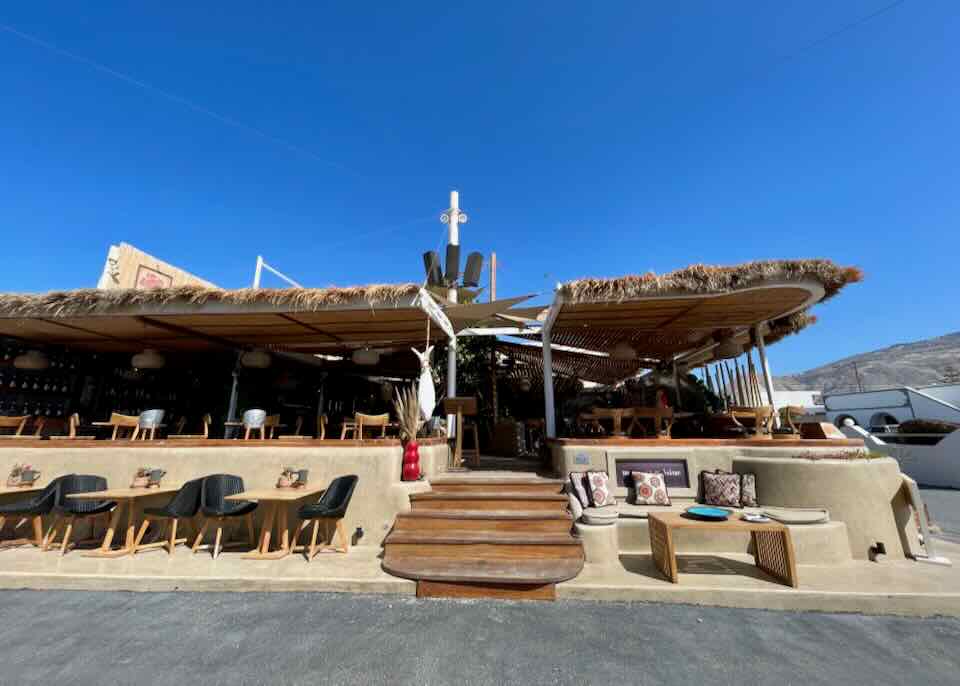
Another one of my favorites, Seaside restaurant in Perivolos. (Expensive.)
July 30, 2024

Under renovation: Saints Anárgyri Holy Orthodox Church in Megalochori.
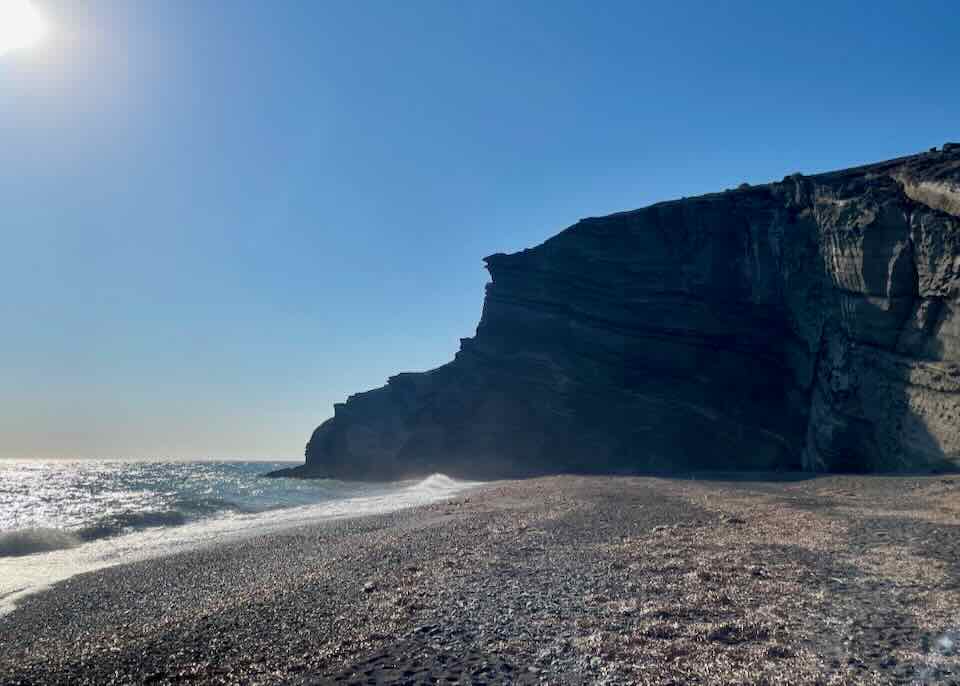
Located on the island’s northeastern coast, Koloumbos Beach is famous for its distinctive black volcanic sand and rugged cliffs, offering a secluded, natural experience accessible only by footpath.

Santorini Secret Suites & Spa in Oia.
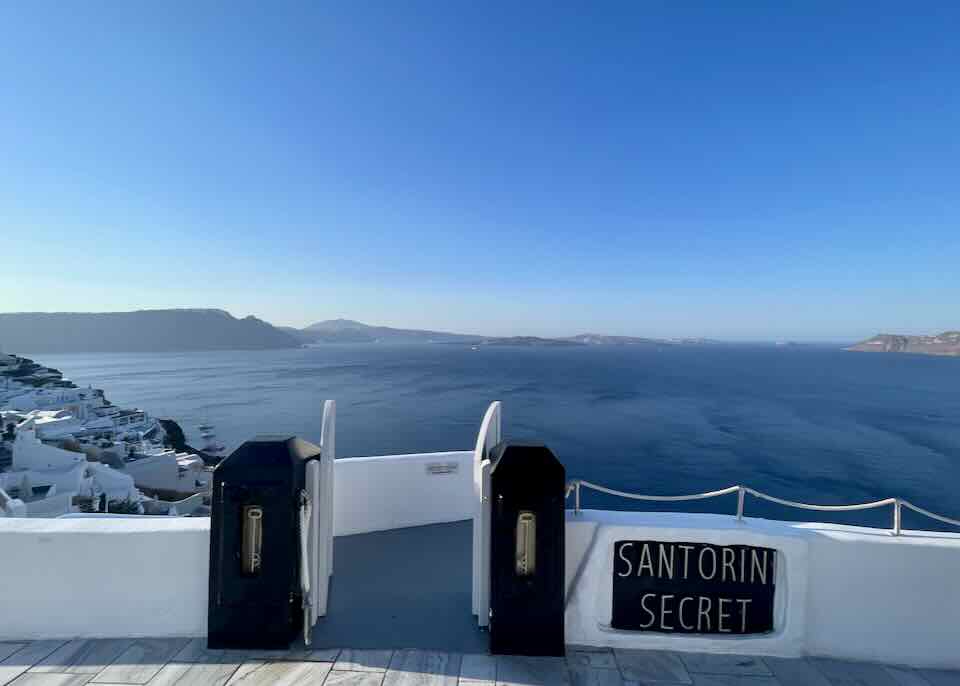
The main entrance to the hotel along the pedestrian path through Oia.
July 29, 2024

Breakfast with a caldera view at Honeymoon Petra Villas in Imerovigli.
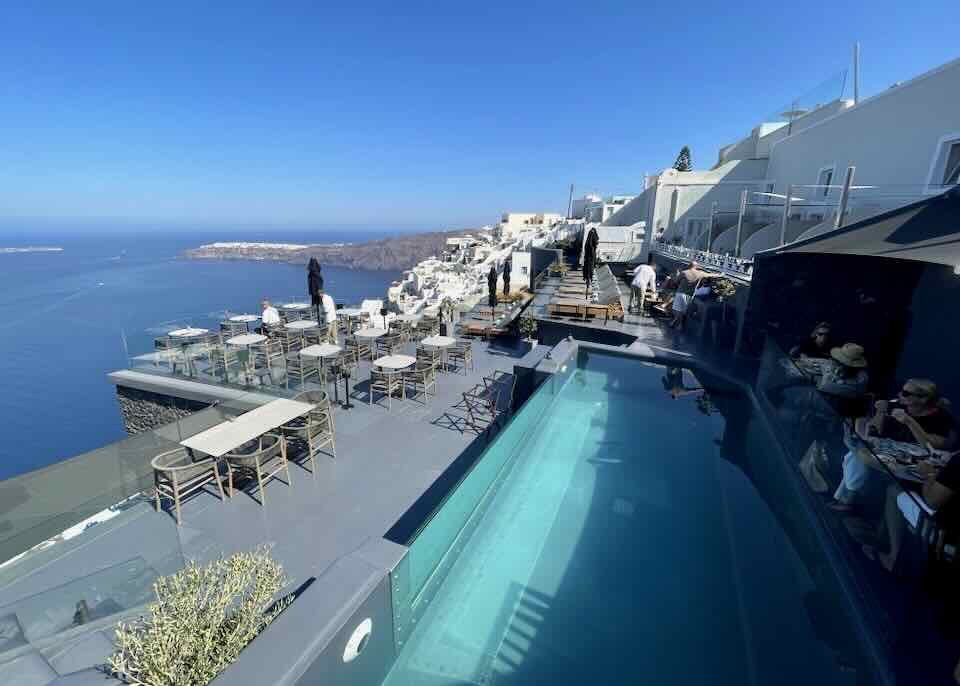
Kivotos hotel in Imerovigli. Oia in the distance.
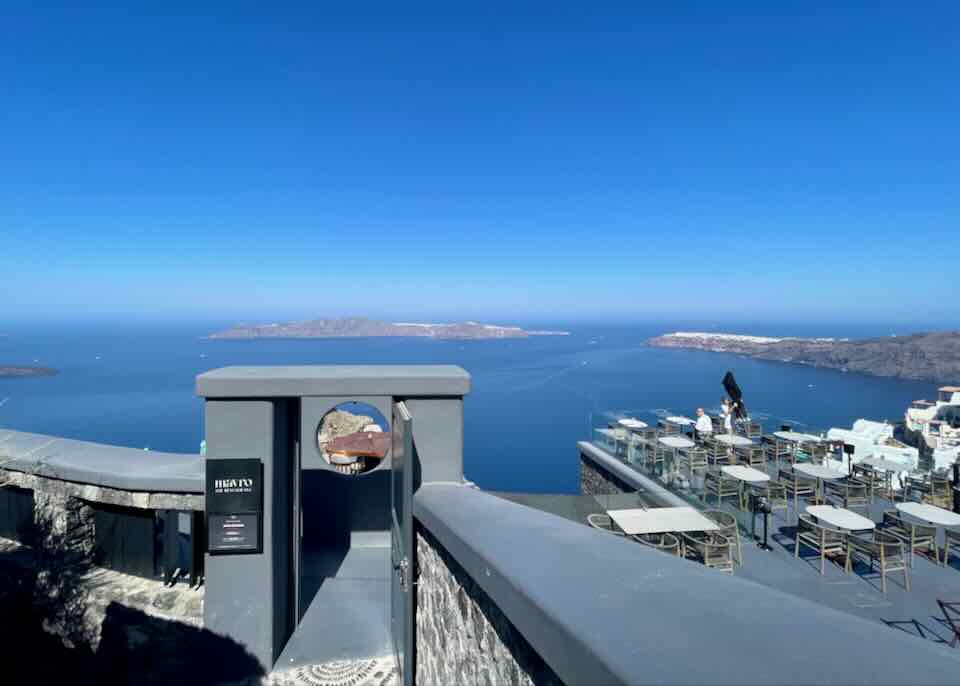
Acclaimed Mavro restaurant (part of Kivotos hotel) in Imerovigli.

Graffiti Coffee Shop in Karterados. Popular with locals.
July 28, 2024

Church of the Holy Cross in Perissa.

Sunday Mass inside.

Boat House restaurant in Kamari: Live music, Greek Night with dancing and plate smashing.

Long lines for Mama Mia at the Open Air Cinema in Kamari. Arrive at least an hour before showtime. (Maybe even earlier.)
July 27, 2024
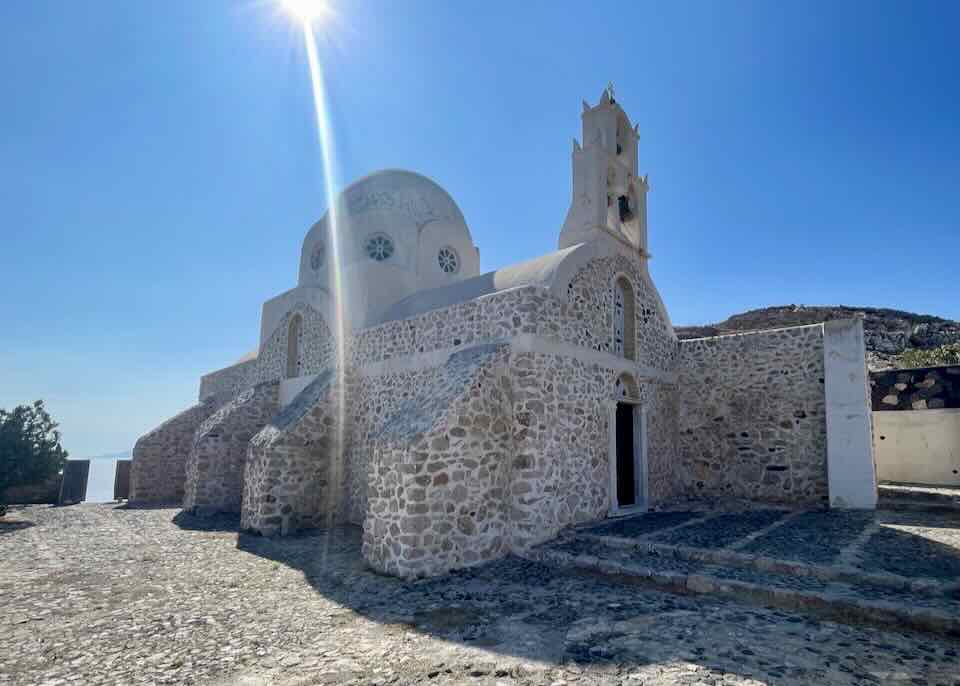
The Church of the Holy Apostles (of Martinou) is located one km uphill from Pyrgos.
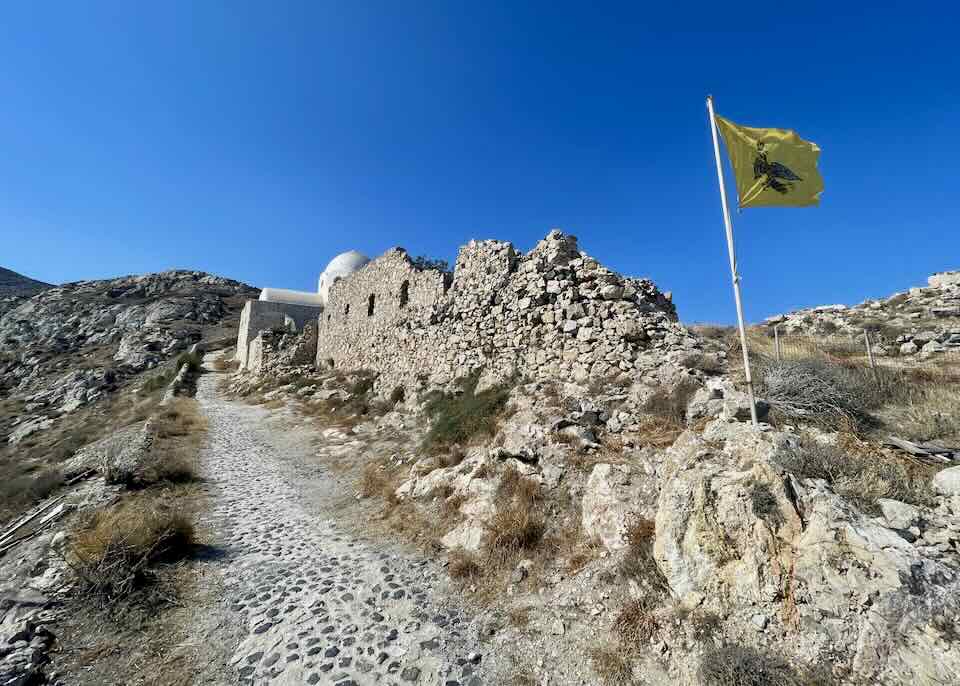
The path up to the church.
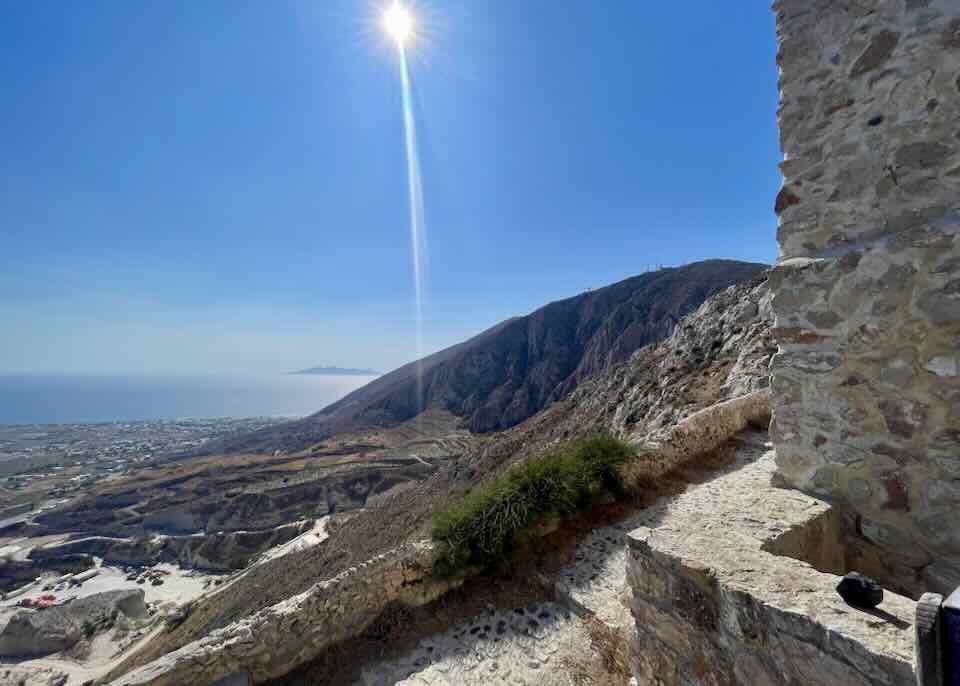
View from church looking down on Kamari.

Privillage Cave Villa in Pyrgos, looking north towards Fira, Imerovigli, and Oia.
July 26, 2024
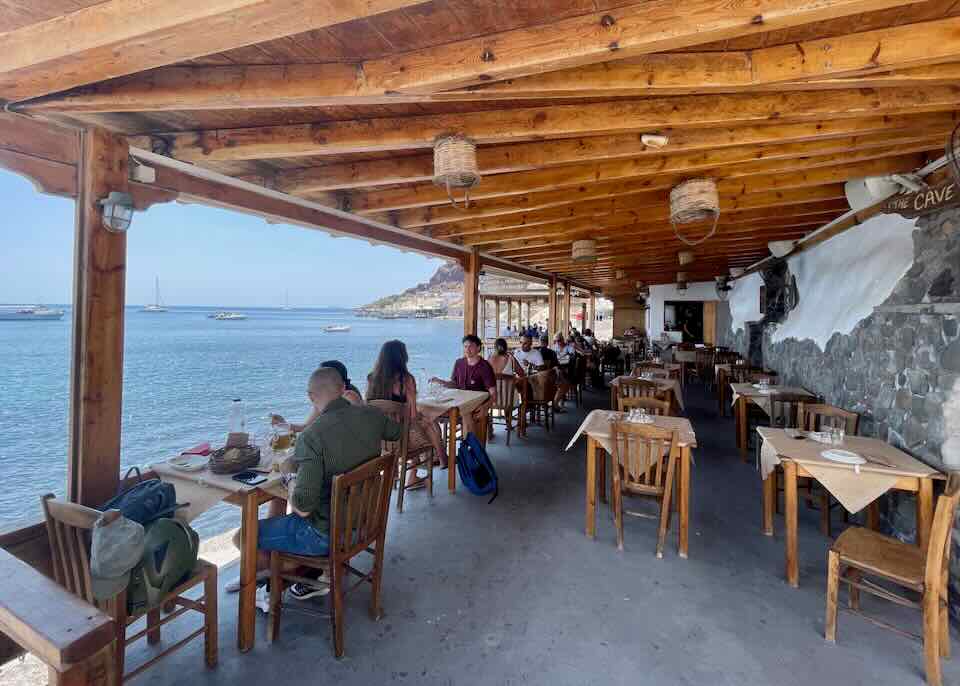
The Cave of Nikolas: A traditional Greek restaurant with a view of the sea. One of our favorites.

Inside the “cave” built by Uncle Nikolas.
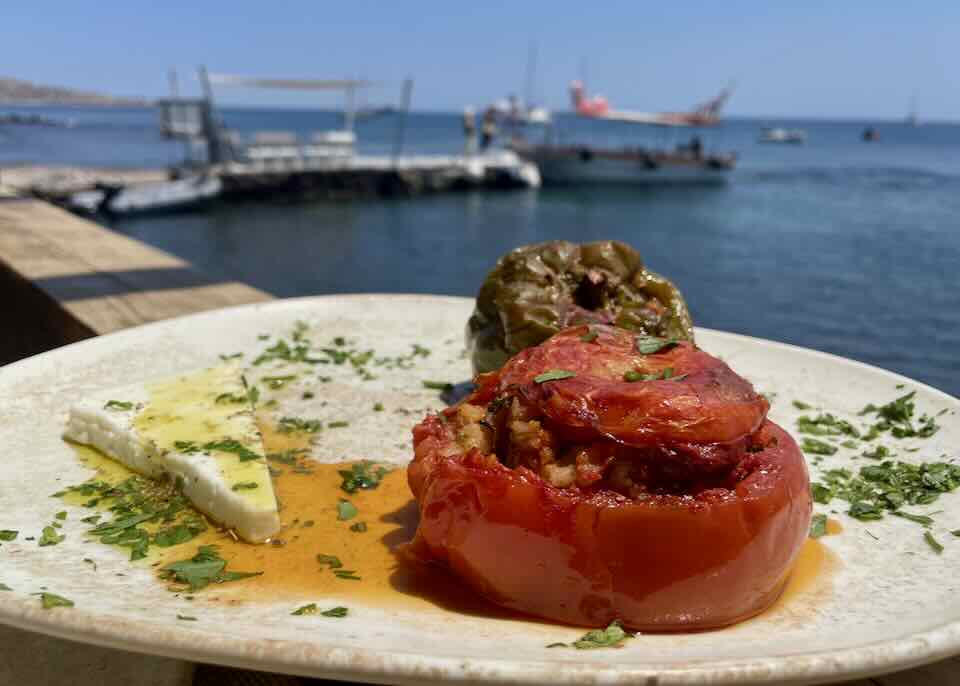
Yemista – one of my favorite Greek dishes. (Stuffed tomatoes and peppers.) The water taxi between beaches is visible in the background.
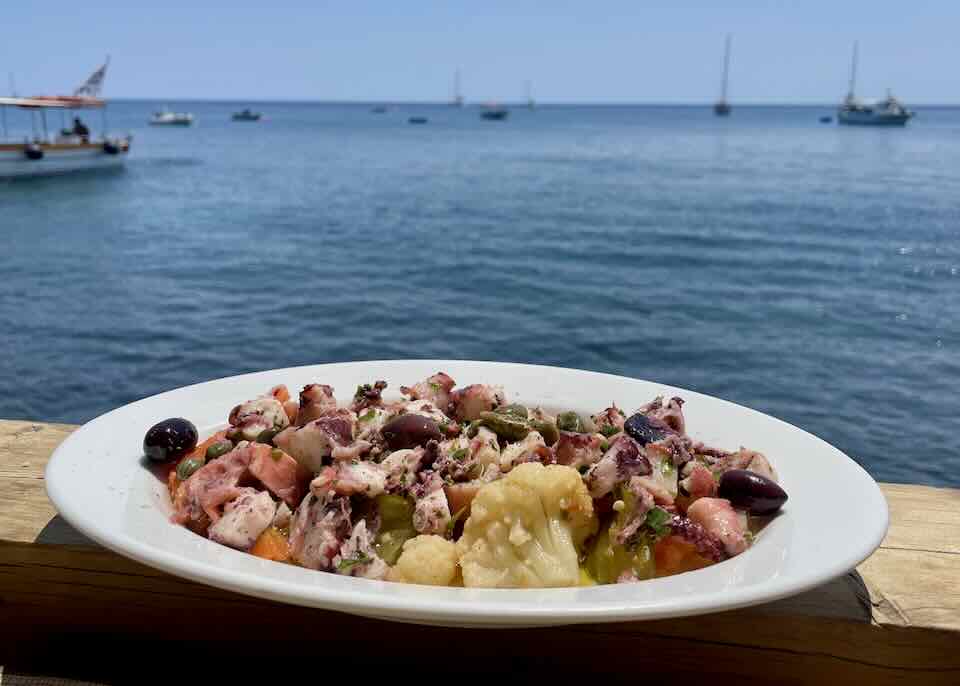
Octopus in vinegar sauce served with pickled vegetables.
July 25, 2024
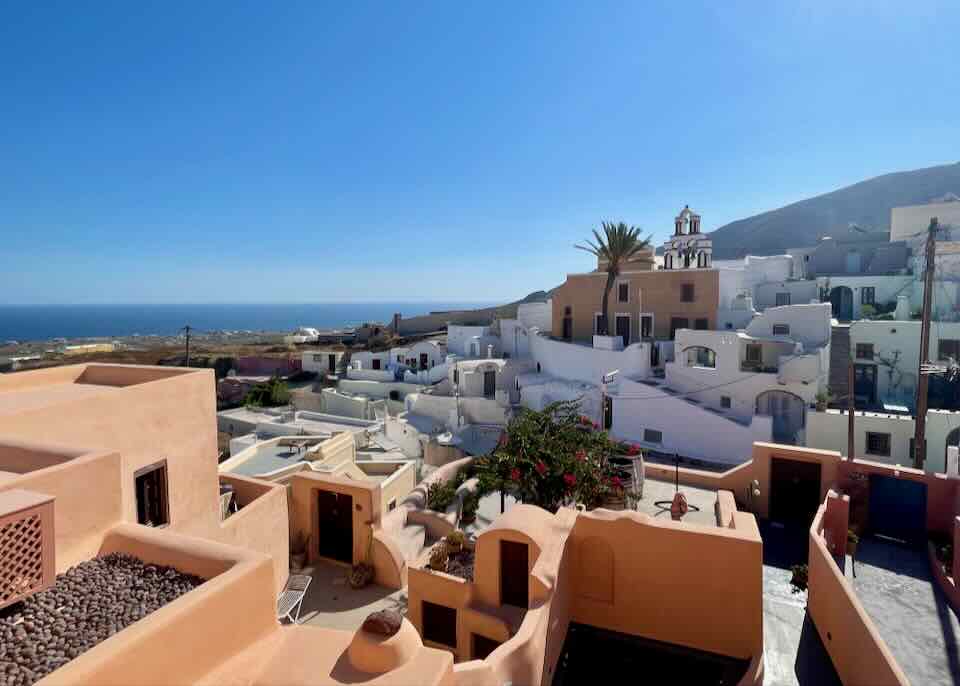
Finikia is small village outside of Oia. It’s not on the caldera. Hotels here are good value compared to Oia. It’s a 10-15 minute walk from Finikia into Oia.
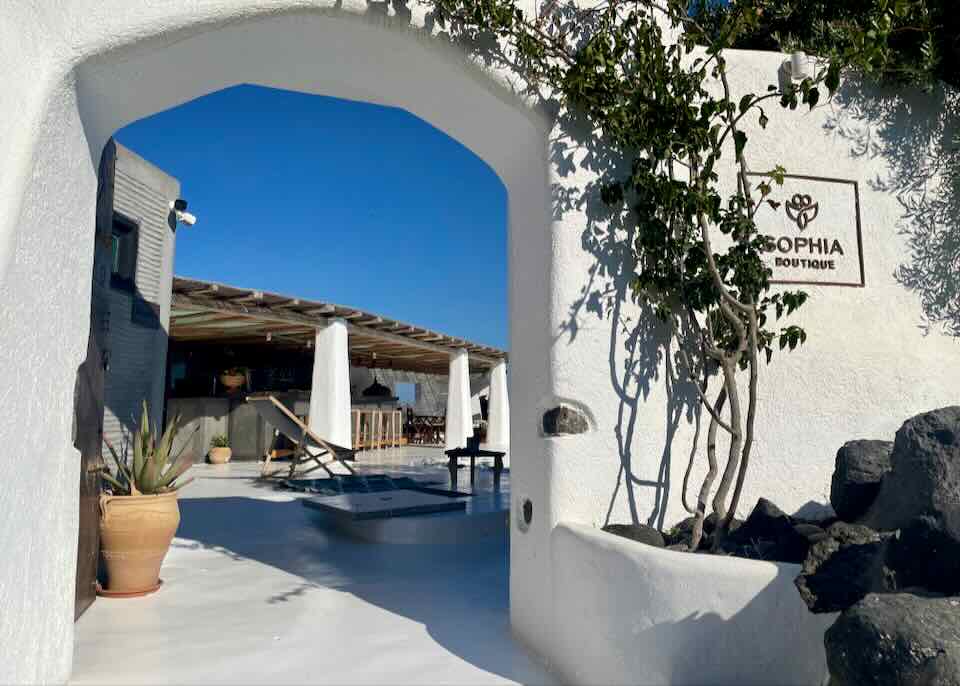
Sophia Boutique Hotel in Finikia.
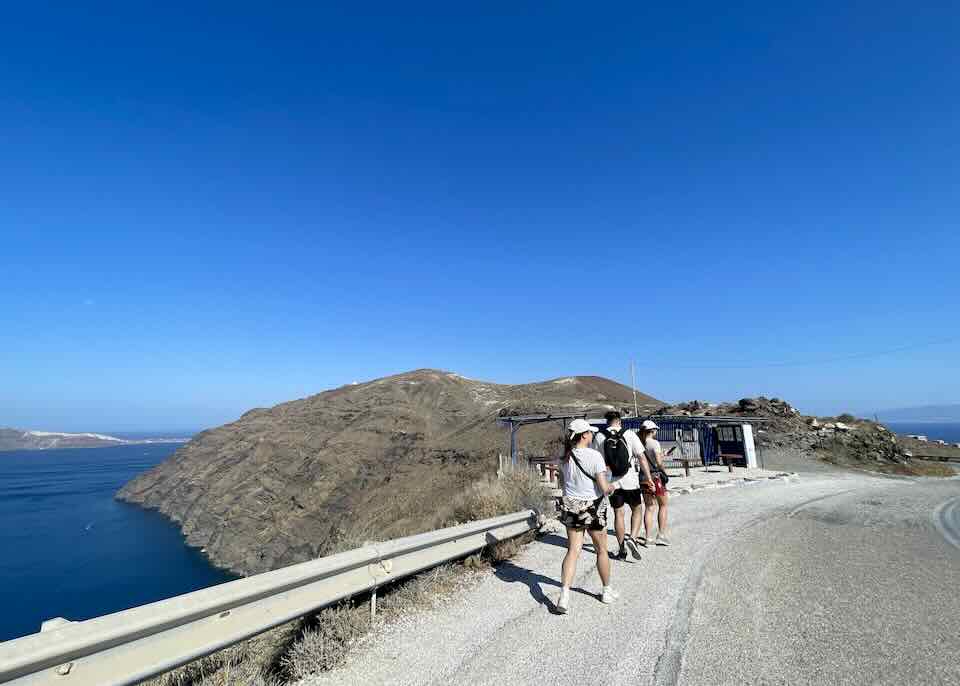
Hikers doing the Oia-Fira hike. There is a stretch of the hike (between Imerovigli and Oia) where there is no path and you’ll need to walk on the road.
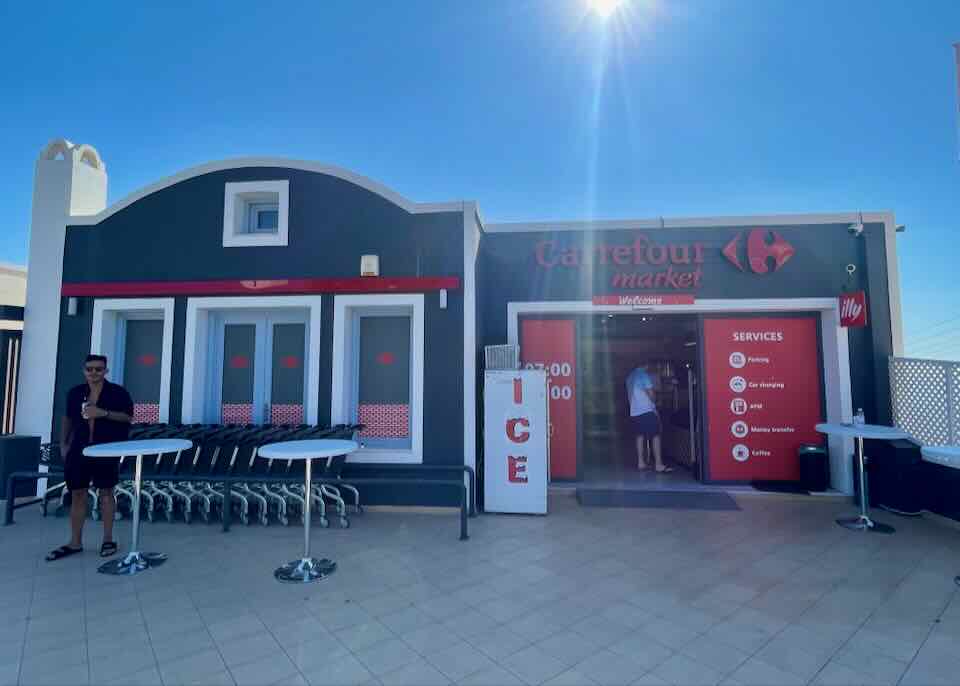
Carrefour supermarket in Imerovigli. A good place to shop for essentials if you’re staying in the northern half of the island.
July 24, 2024

Filming a singer in Imerovigli at sunset.
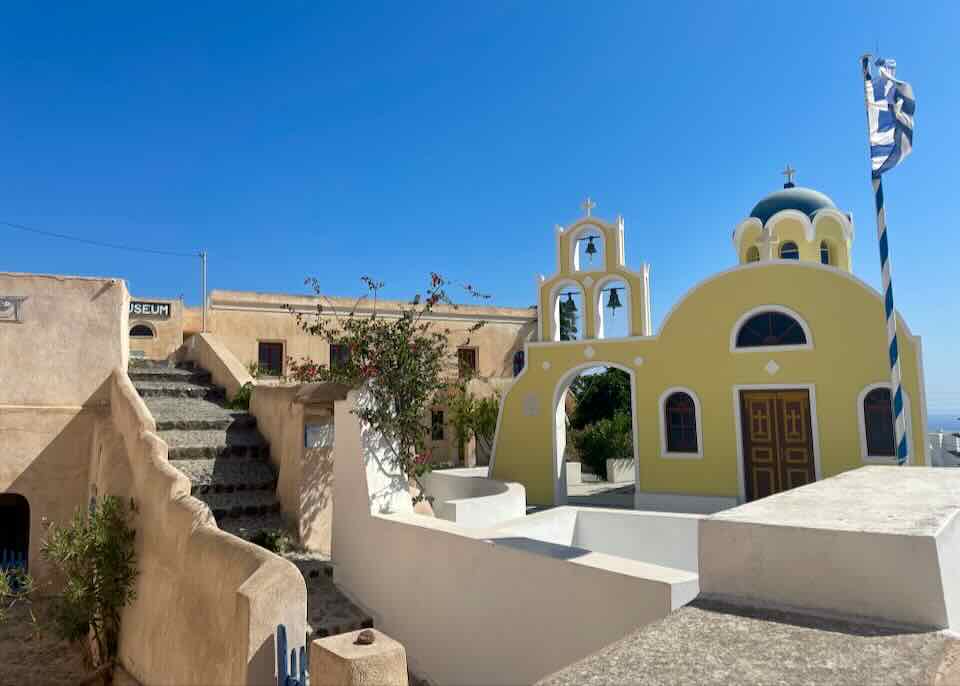
The Folklore Museum (temporarily closed) and Chapel of Agios Konstantinos in Fira.
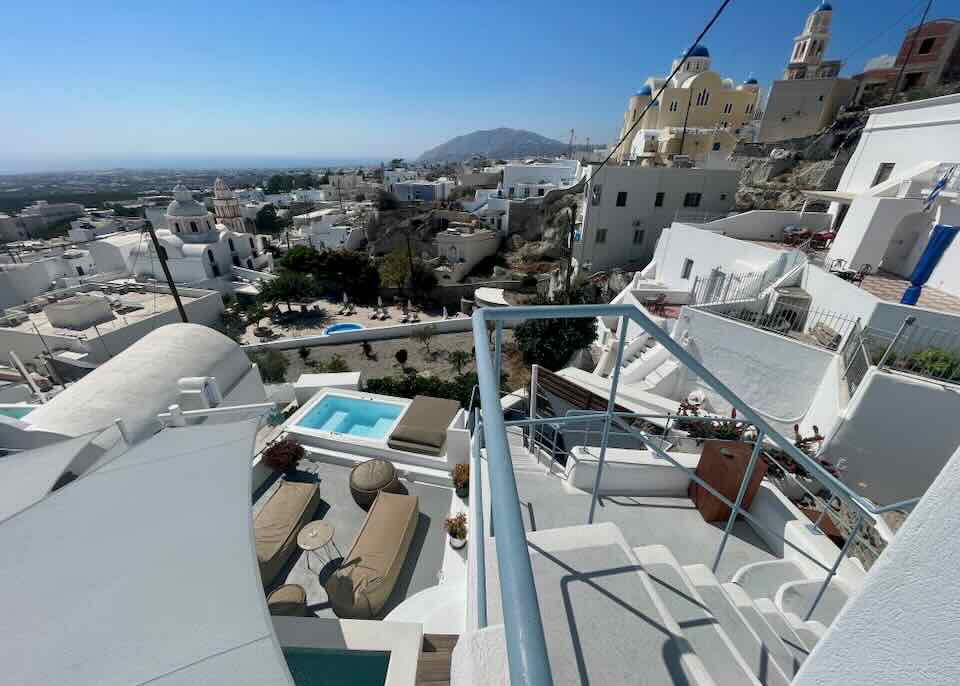
Petit Gem Airbnb in Fira.
July 23, 2024
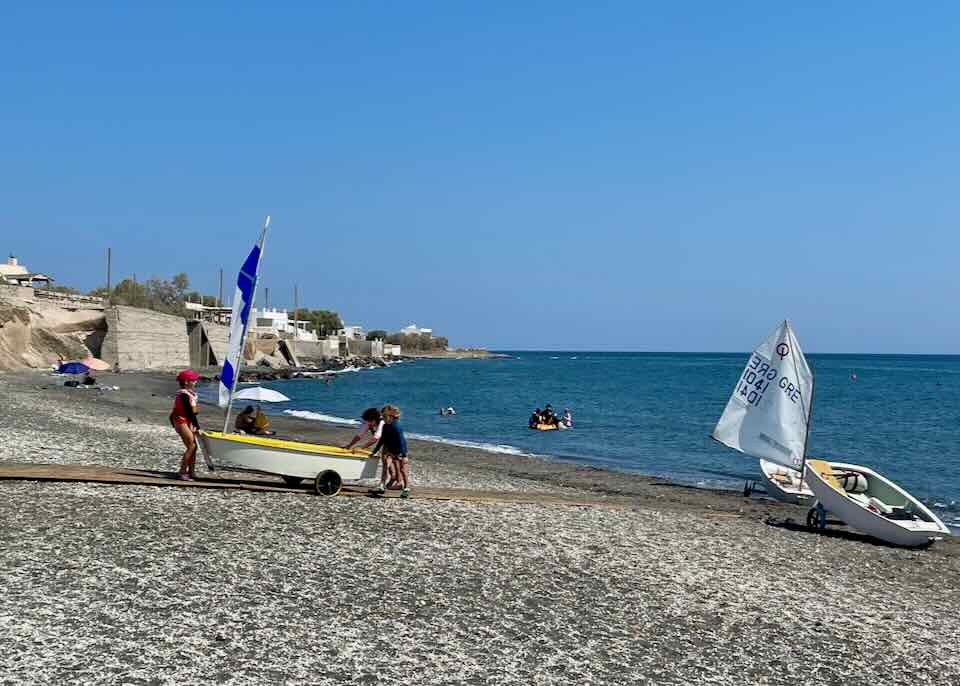
Kids learning the basics of sailing in Vlychada.
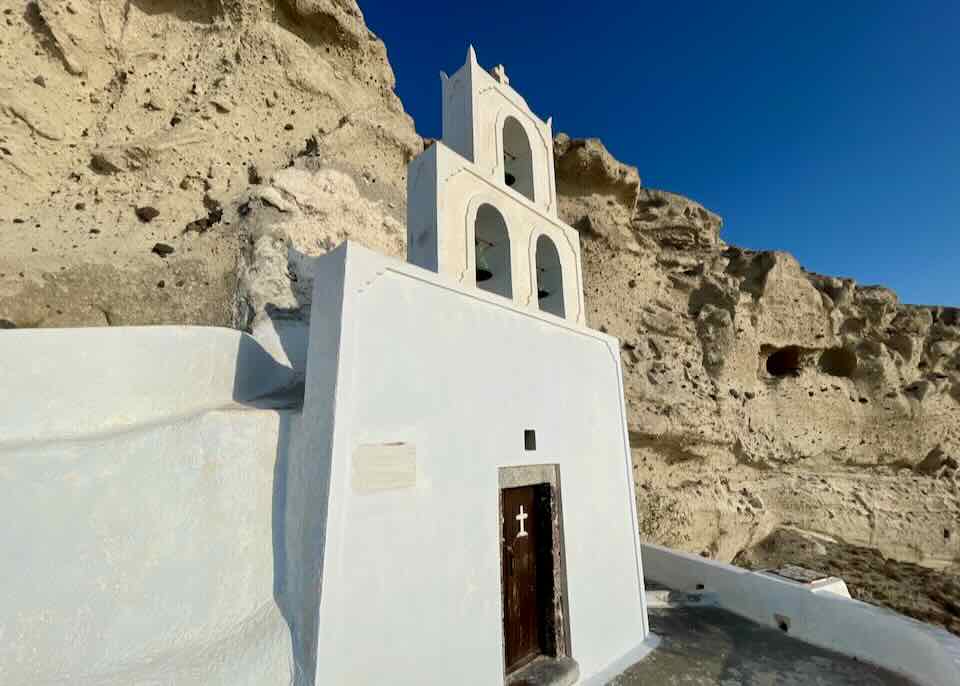
The Chapel of Saint Nicholas.

The Chapel of Saint Nicholas overlooking the caldera.
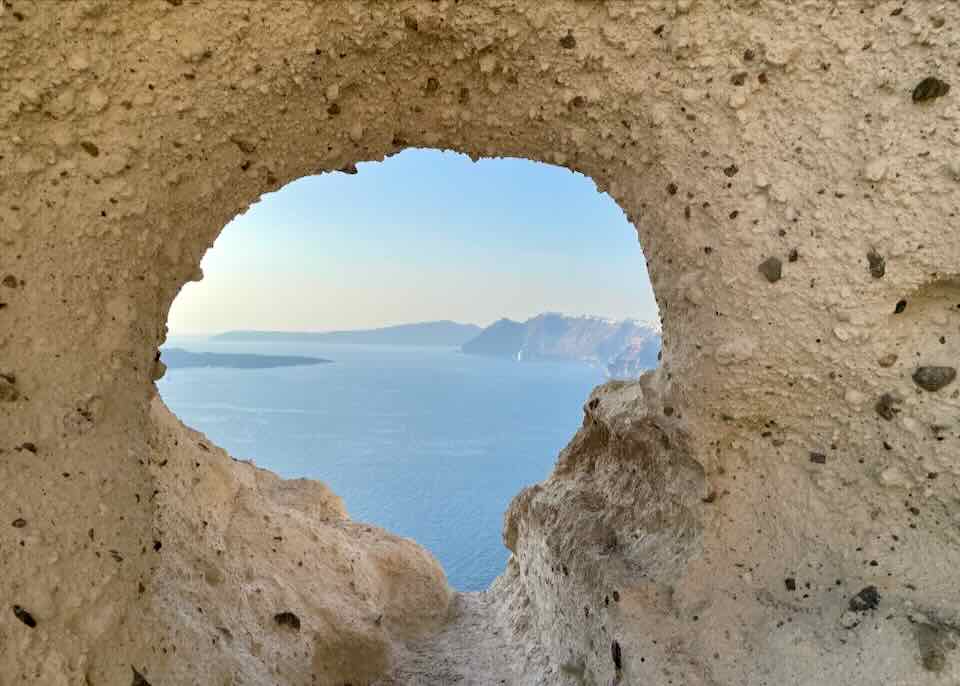
Recently, the “Heart of Santorini” lost its heart-shaped form.

But it’s still a popular photo spot.
July 22, 2024

Fog rolling in over the caldera.
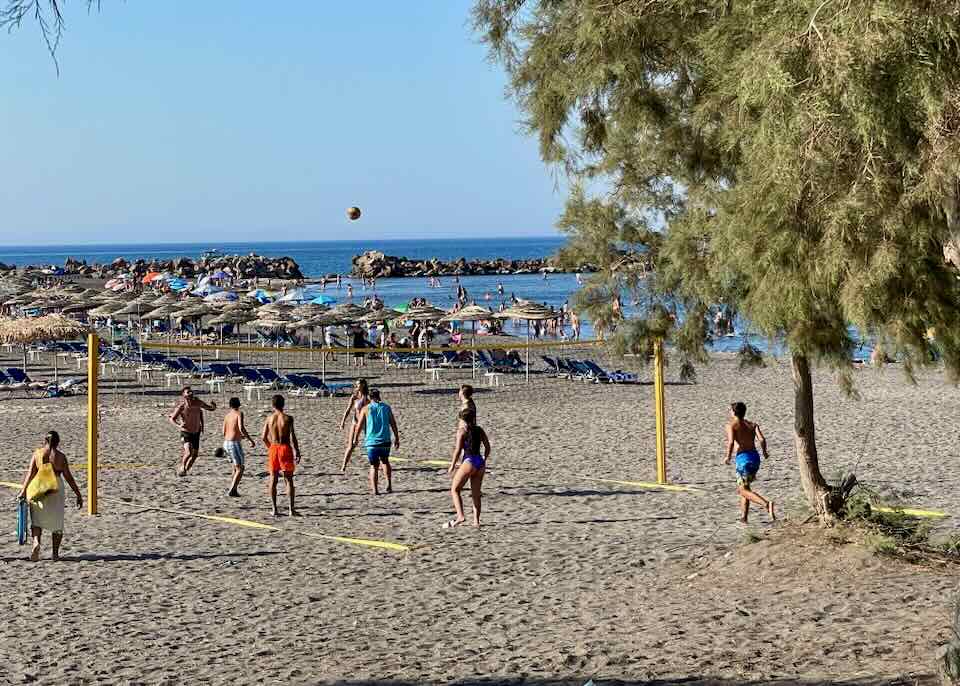
Volleyball on Monolithos Beach.
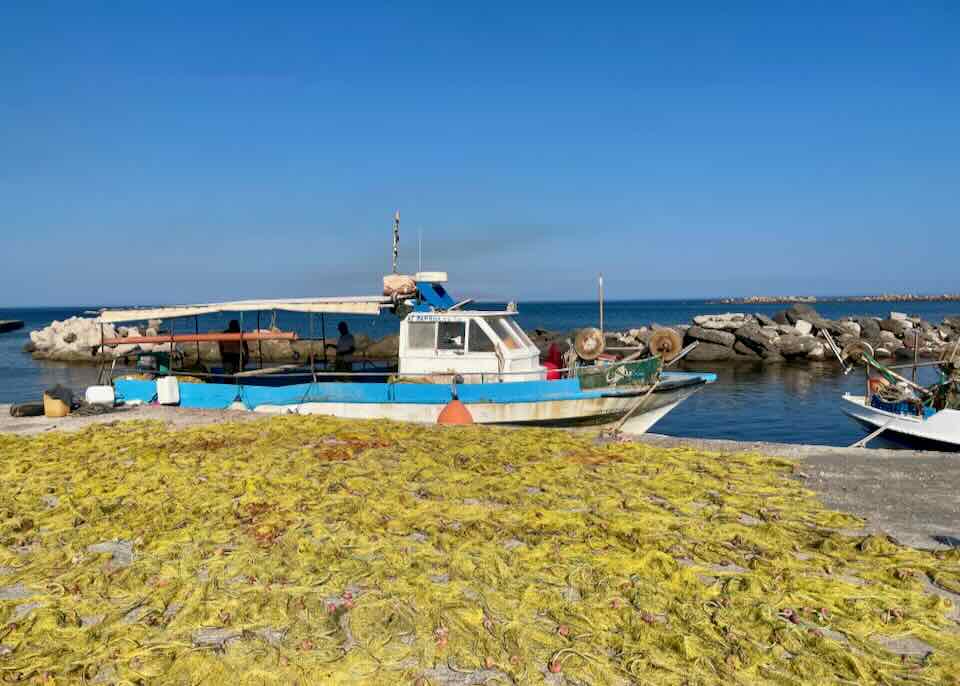
Fishermen drying their nets at the end of the day.
July 21, 2024

Fruit seller in Kamari.

One of the oldest traditional houses in Kamari.
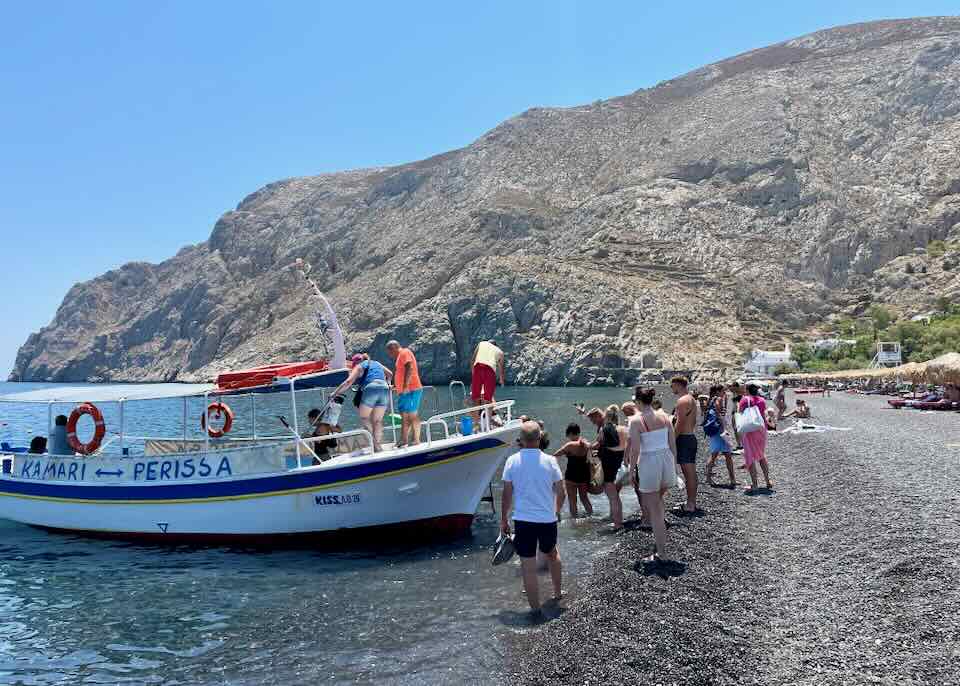
People boarding the water taxi from Kamari to Perissa. (There’s no avoiding getting a little wet.)

Kerkezu Beach in the southern part of caldera. (There are only a couple of beaches on the caldera, most of the Santorini beaches are on the other side of the island.)
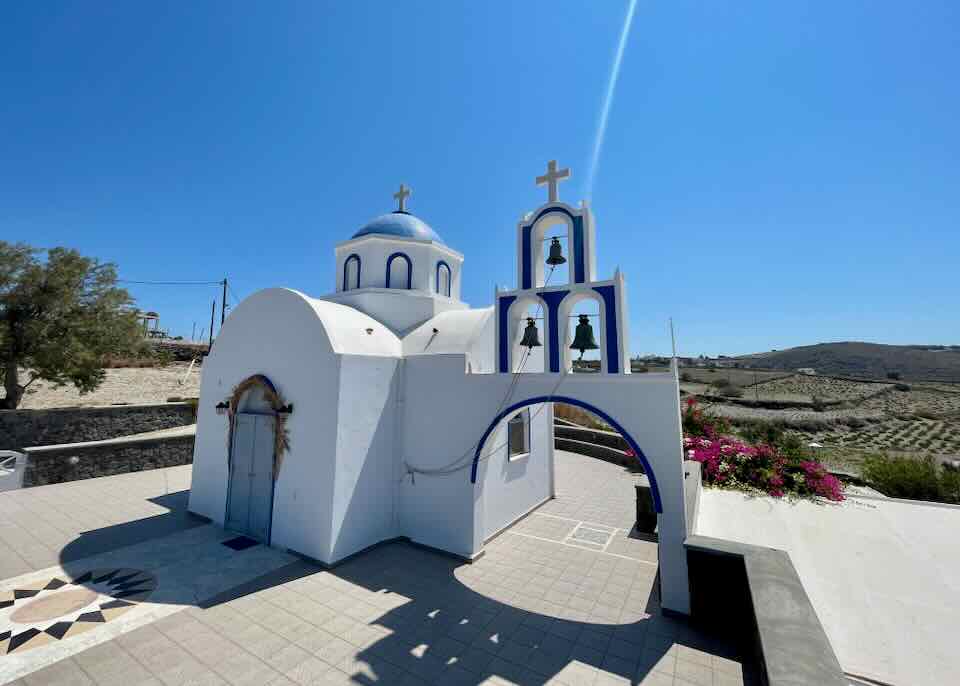
Saint Raphael Holy Orthodox Chapel on the way to the Akrotiri lighthouse.
July 20, 2024
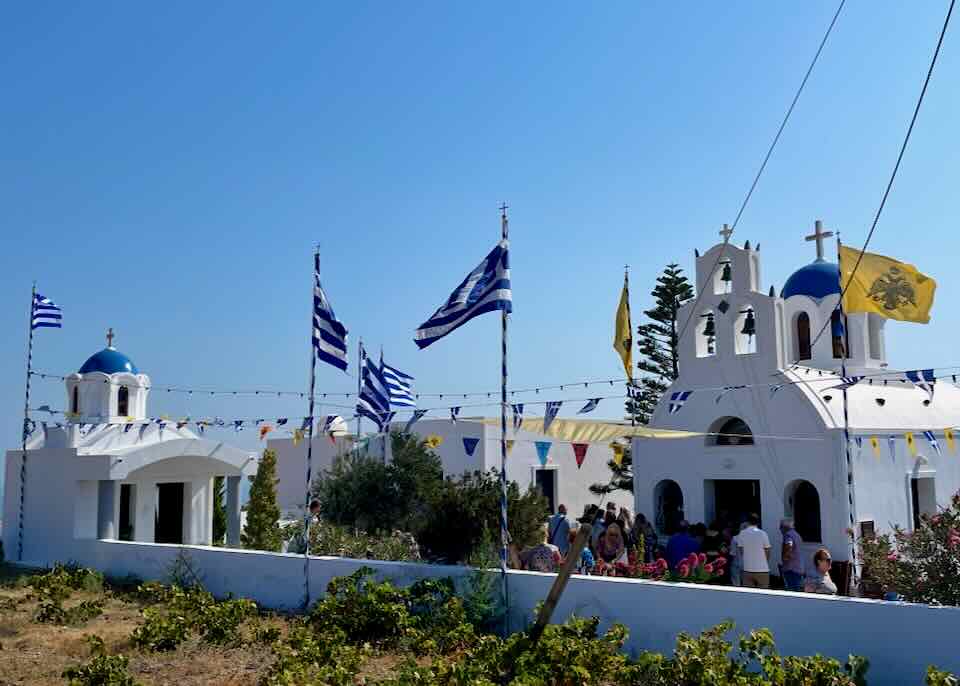
Today in Greece is the celebration of Prophet Ilias.
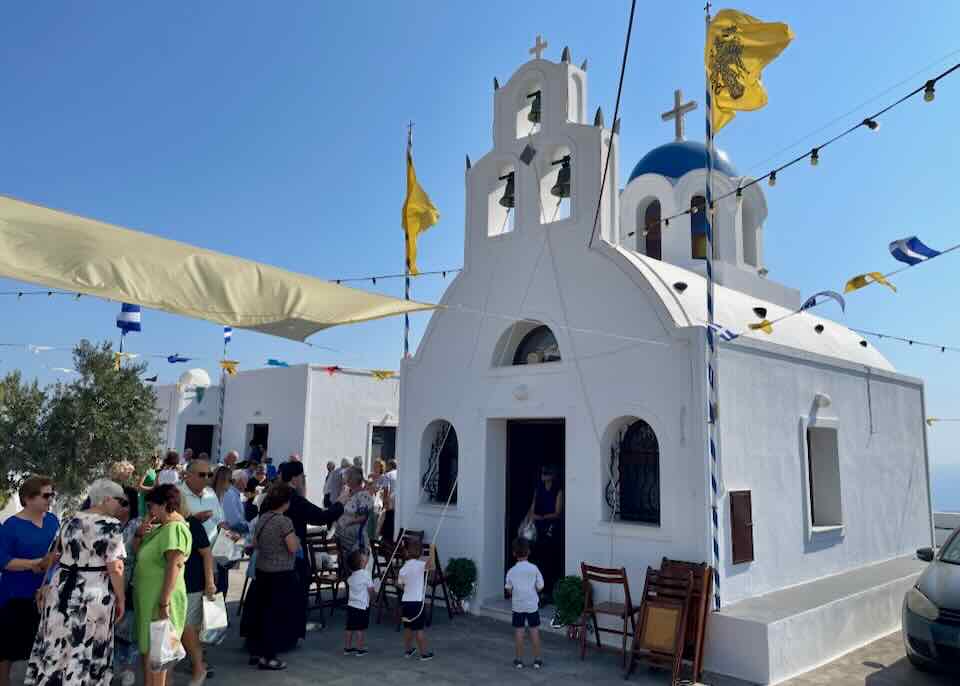
Families celebrating and children ringing bells at the church of Prophet Ilias in Fira.
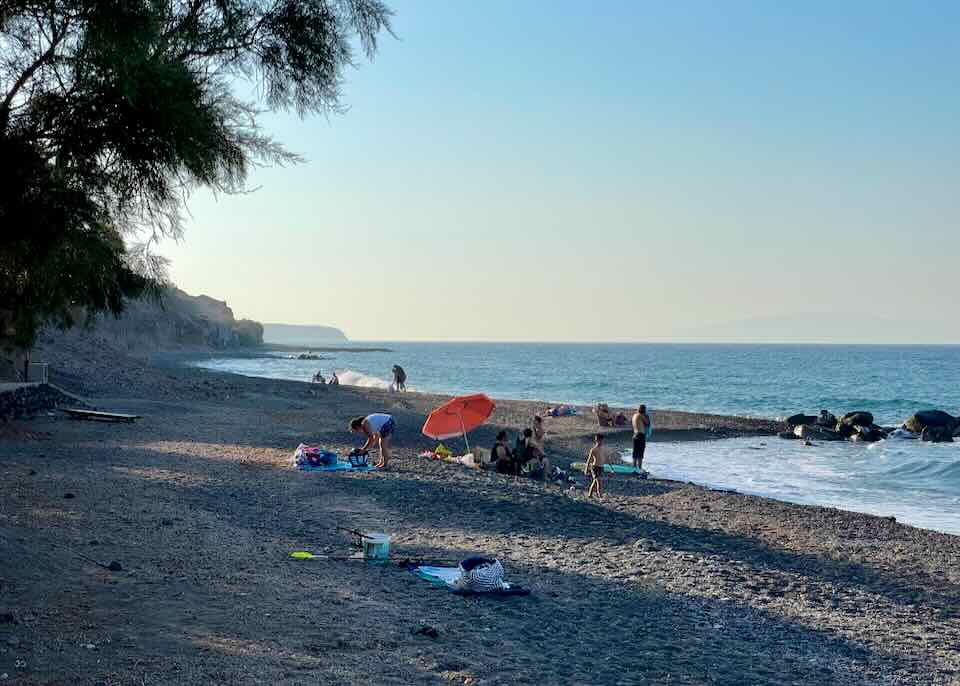
Vourvoulos beach before sunset.
July 19, 2024
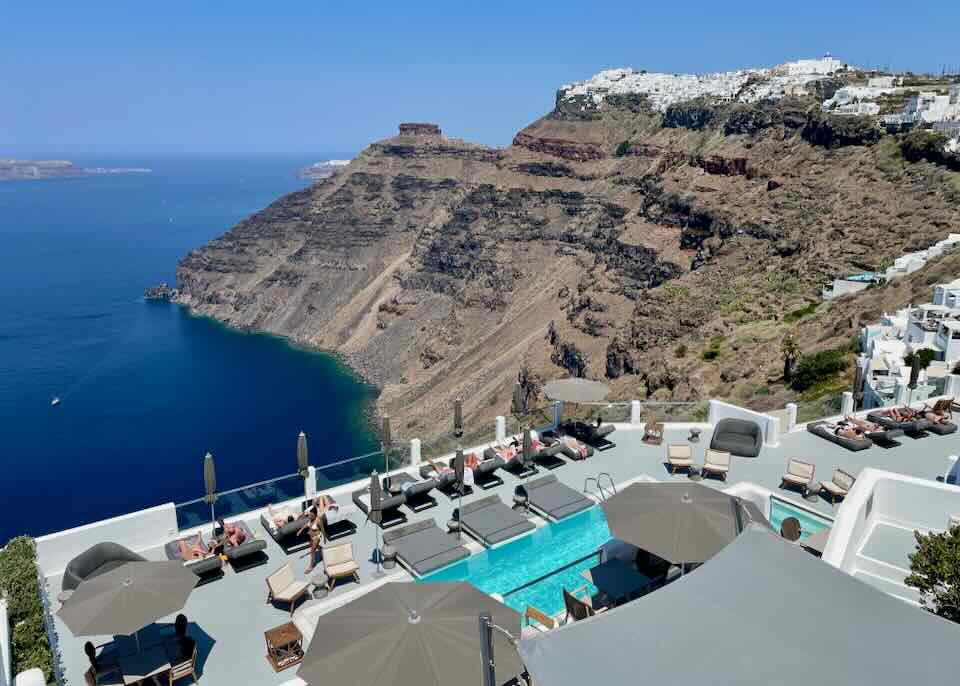
Belvedere Suites in Firostefani.
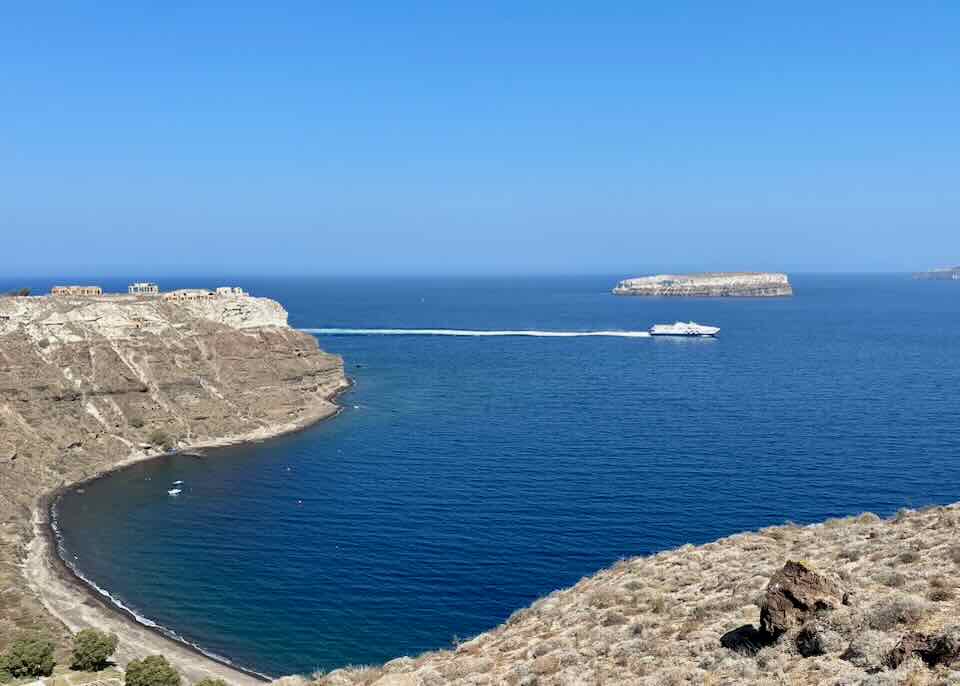
SeaJets high-speed ferry arriving in Santorini (from Crete).

Local fishermen selling today’s catch in Emporio.
July 18, 2024
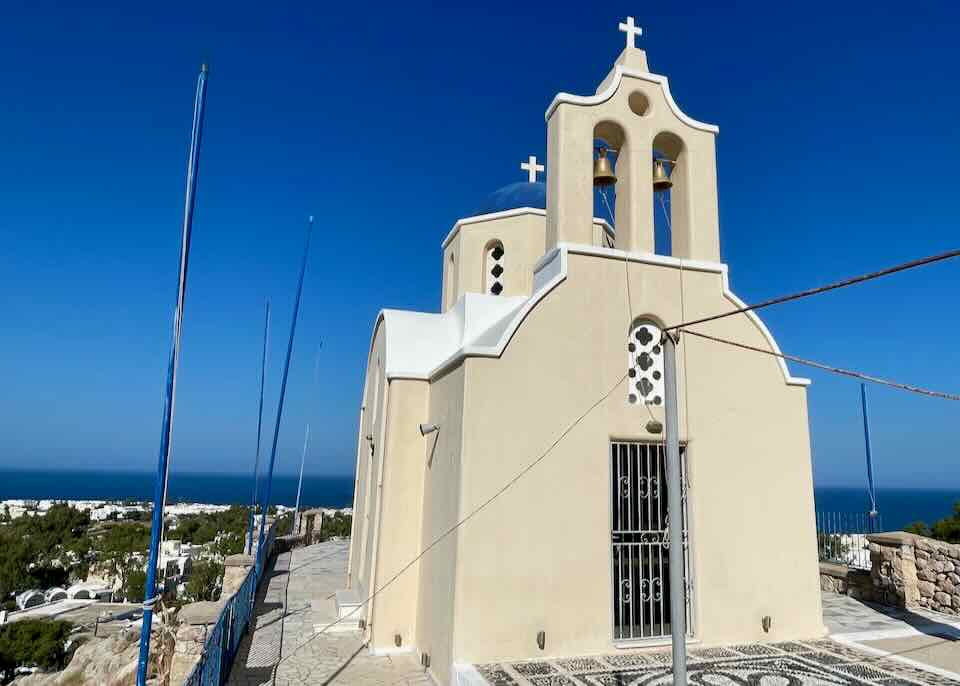
The church of Saint Pagratios in Kamari.
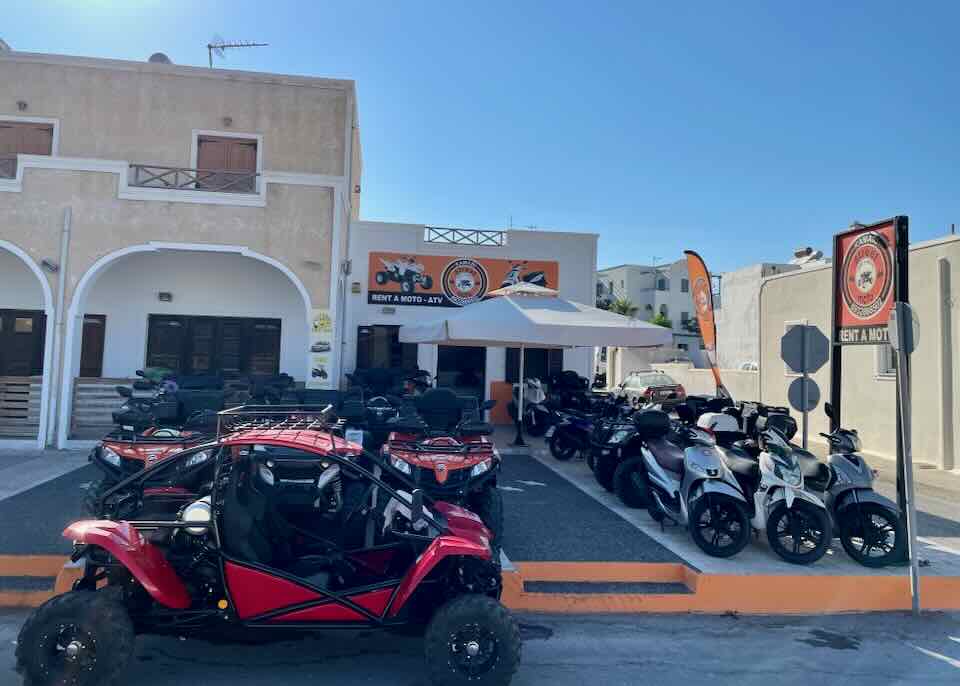
ATV and scooter rentals at Kamari Street Moto.

Infinity pool and sunset view at Aeifos Boutique Hotel in Imerovigli.
July 17, 2024
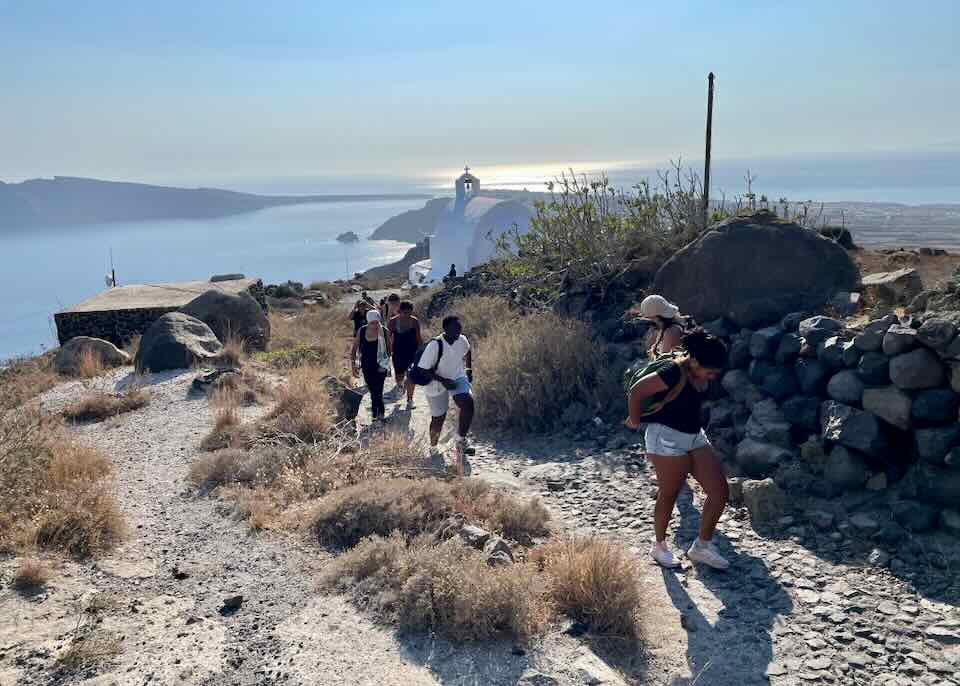
Visitors start the hike to Fira just outside of Oia.
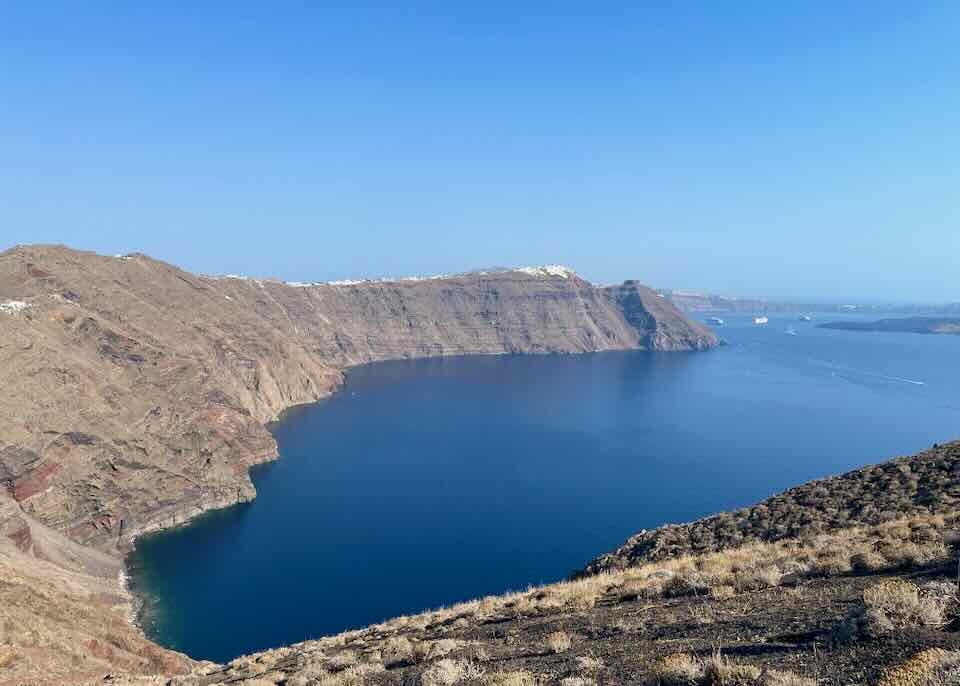
My favorite views on the caldera hike are on the stretch between Oia and Imerovigli.
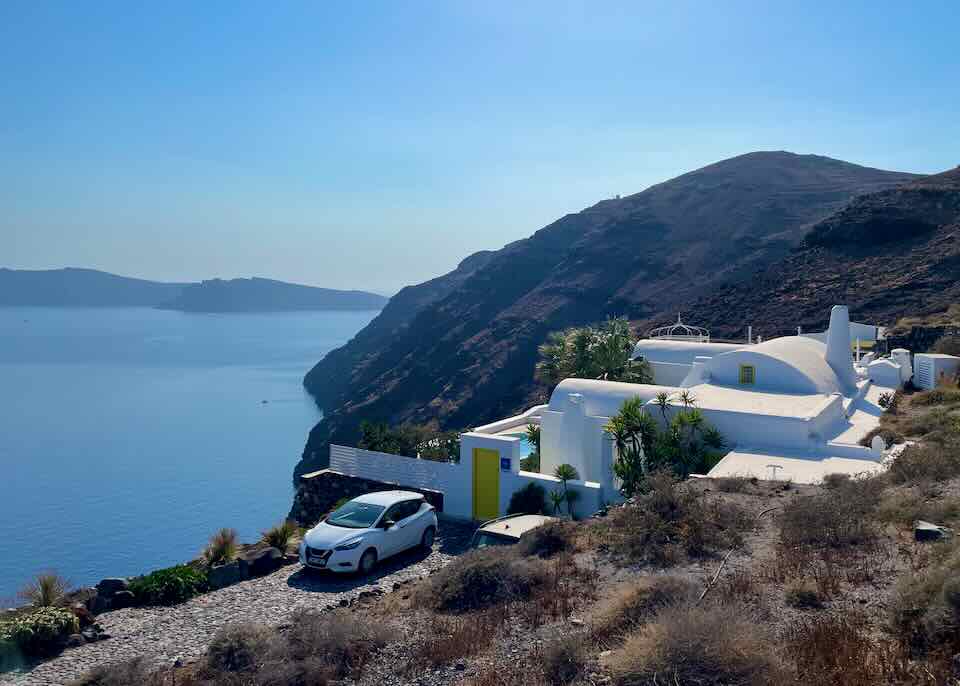
Ftelari Villa on the caldera’s edge. (You might recognize it from season 3 of “Jack Ryan”.)
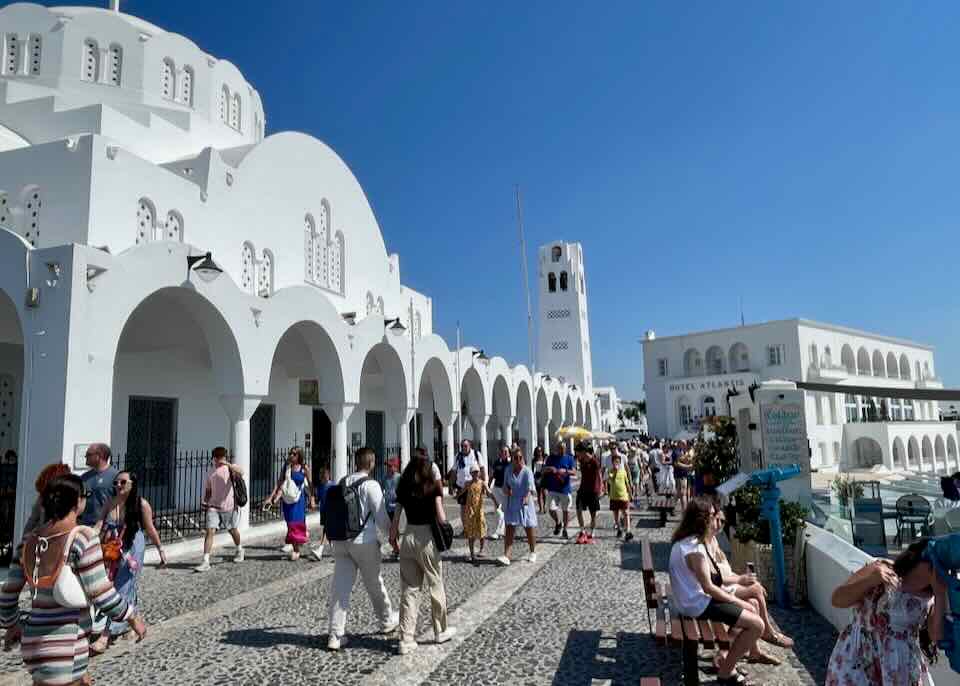
The end of the hike (or start, depending on which way you’re walking) is typically the main square of Fira.
July 16, 2024

Chapel of Panagia Katefiani built into the cliff. You can visit it on the hike from Perissa to Ancient Thera.
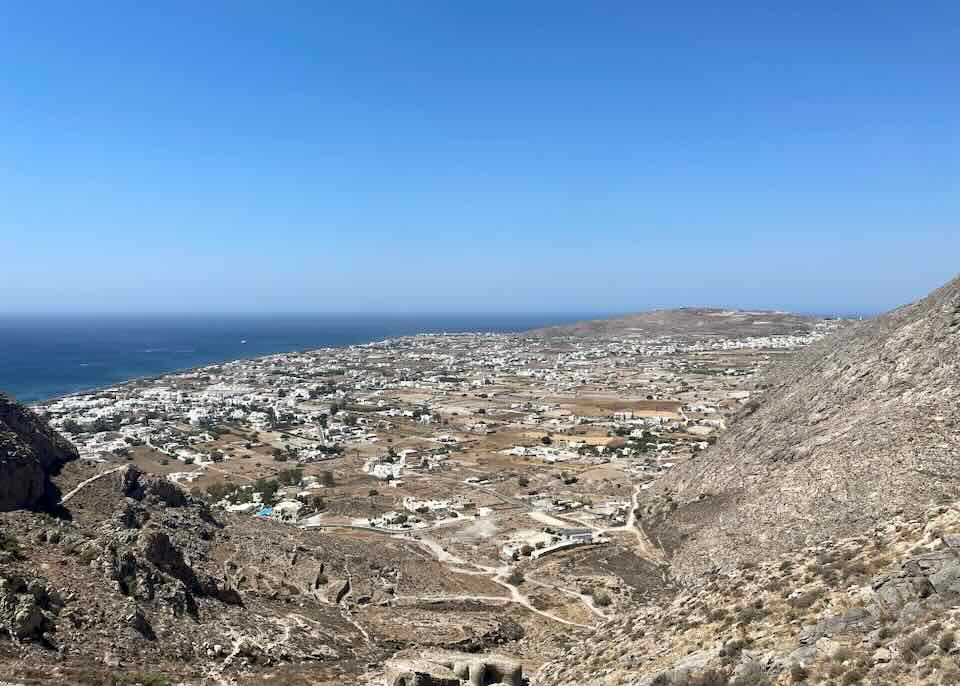
View of Perissa on the walk up Mesa Vouno.
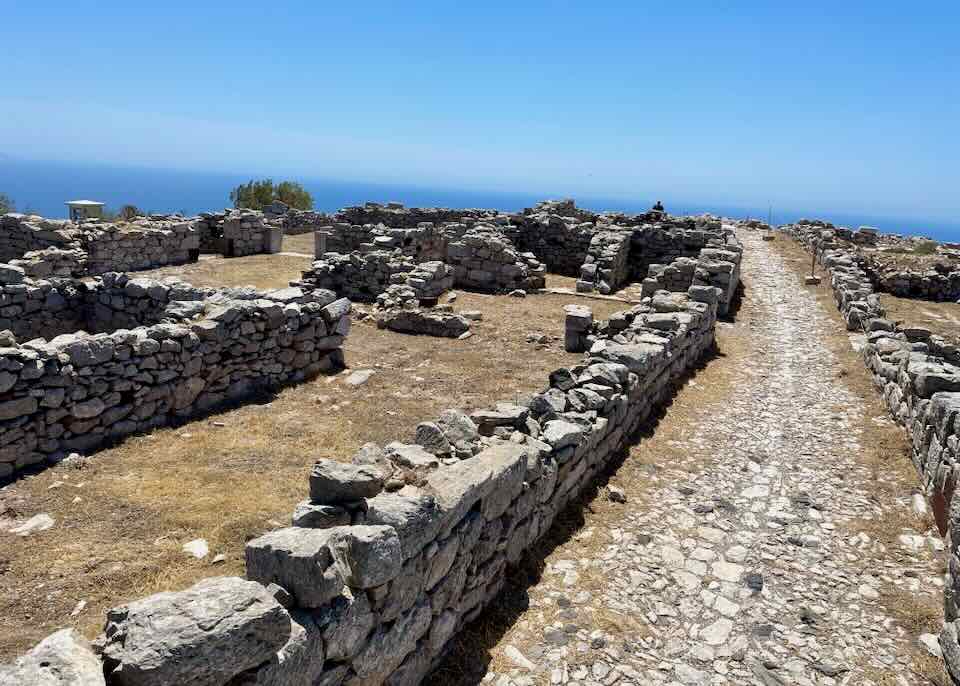
The ruins of Ancient Thera on top of Mesa Vouno.
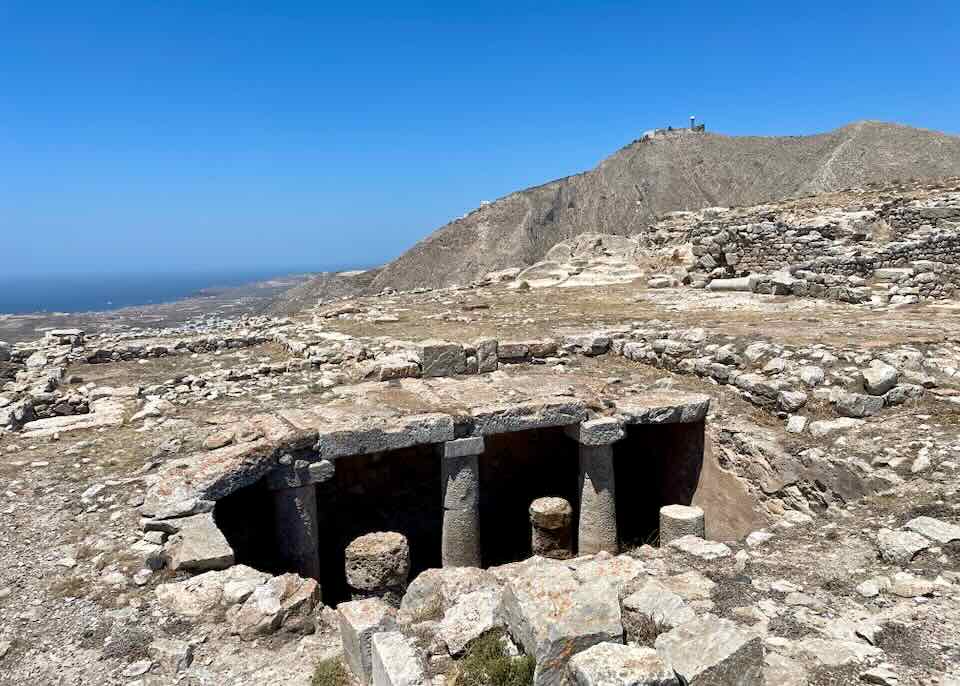
Lots to see here. (You can drive up to Ancient Thera from the Kamari side of Mesa Vouno if the hike is too much.)
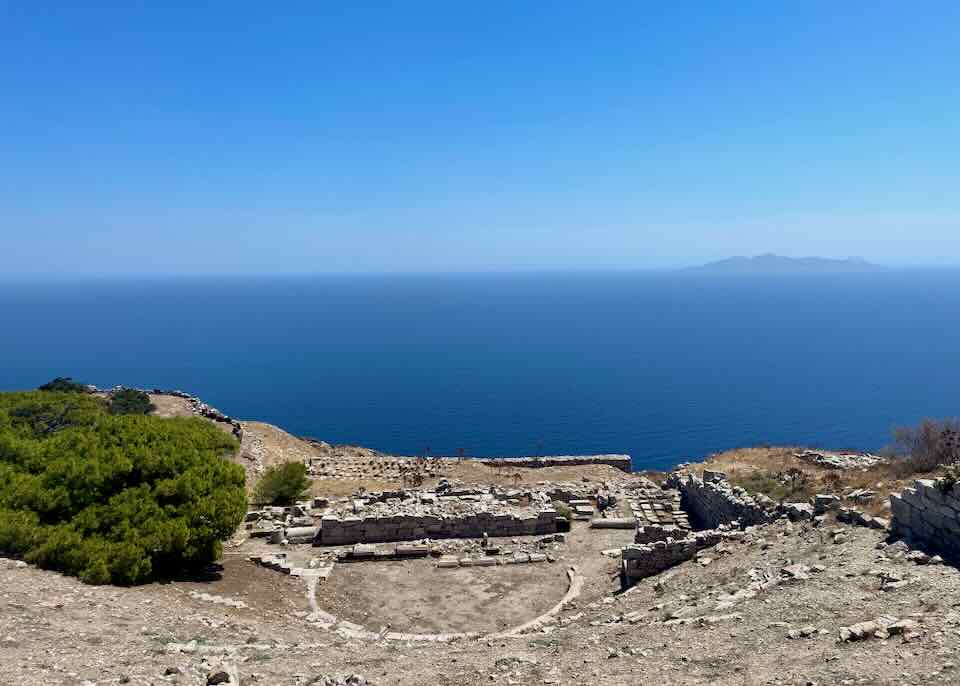
The theatre of Ancient Thera.
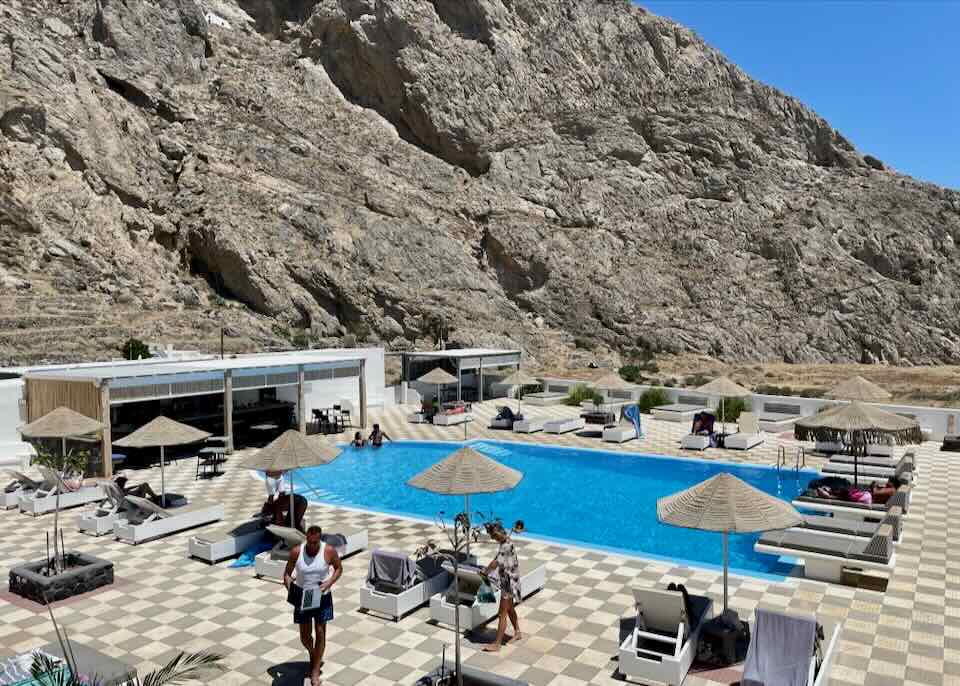
Marianna Hotel in Perissa. A family run hotel located near the start of the Ancient Thera hiking path. (Close to town and the beach too.)
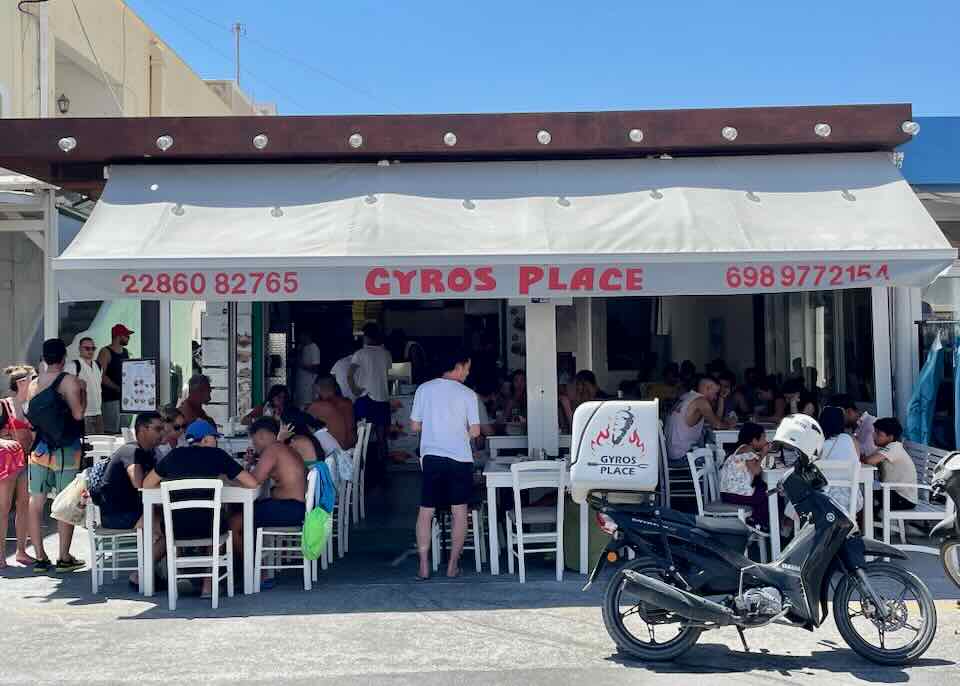
Gyros Place in the central square of Perissa.
July 15, 2024
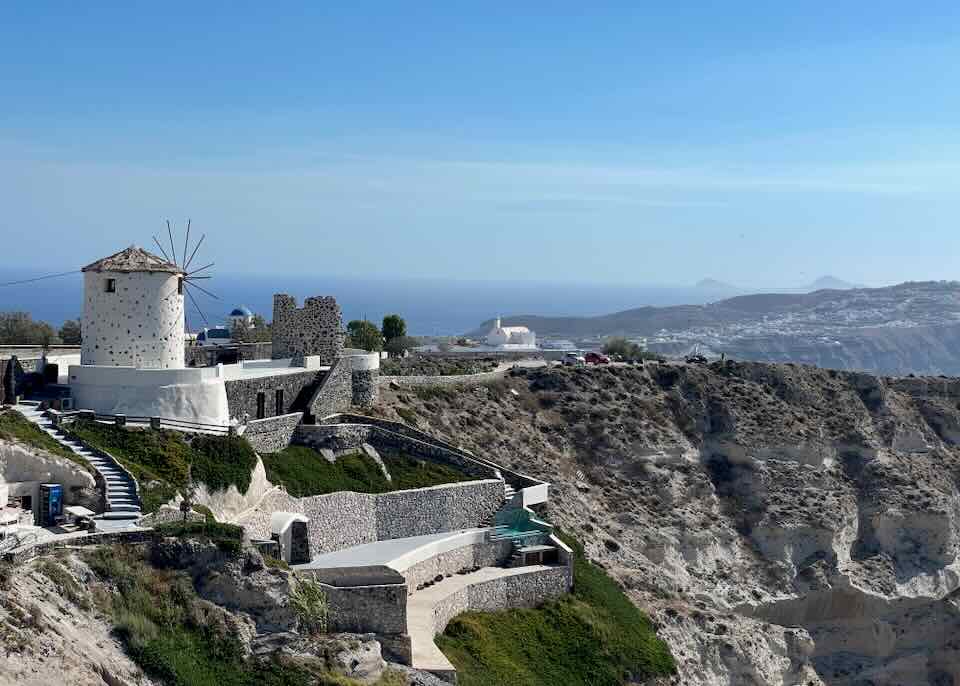
El Viento near Megalochori. A popular spot for weddings.
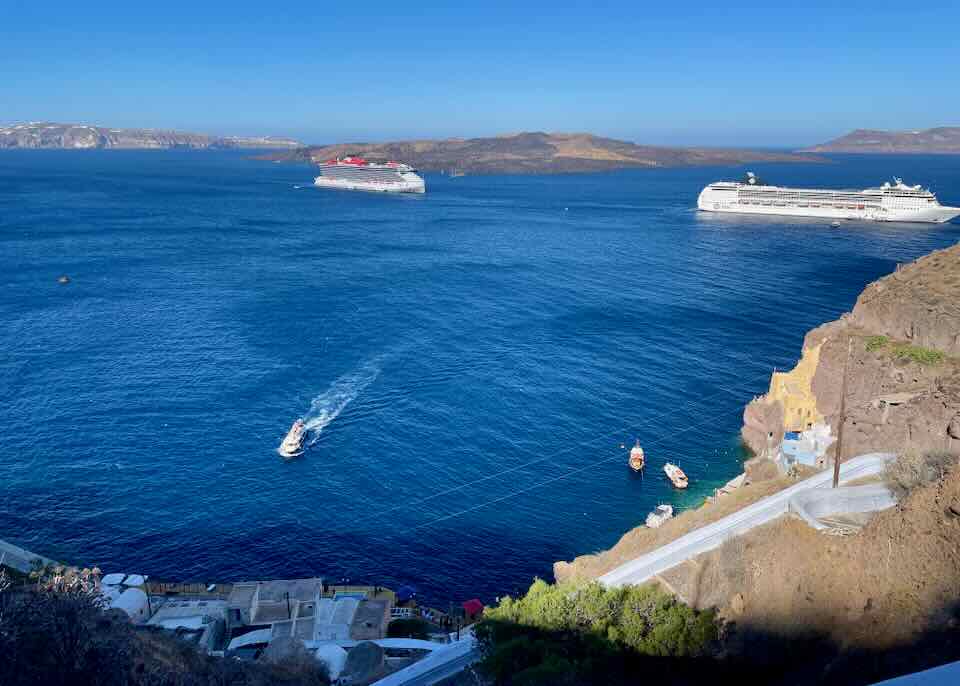
Walking the path down to the Fira Old Port (Skala). A tender boat is transfering cruise passengers from the ship to the Old Port.

The cable car from the Old Port up to Fira. There are no roads down to the Old Port so if you don’t take the cable car you have to walk or hire a donkey to get up to Fira.

There is also a boat transfer from the Old Port to Oia.

Donkey handlers at the Old Port.
July 14, 2024
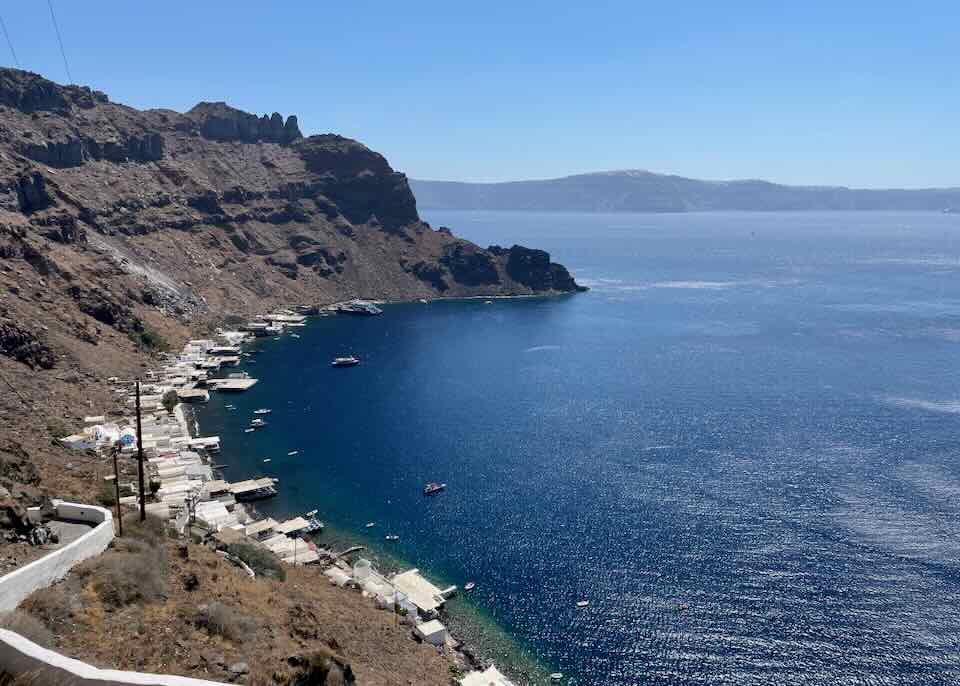
Looking down on Korfou Bay in Thirassia with Santorini visible in the distance. Thirassia is a short ferry ride from Santorini and forms the opposite side of the caldera.
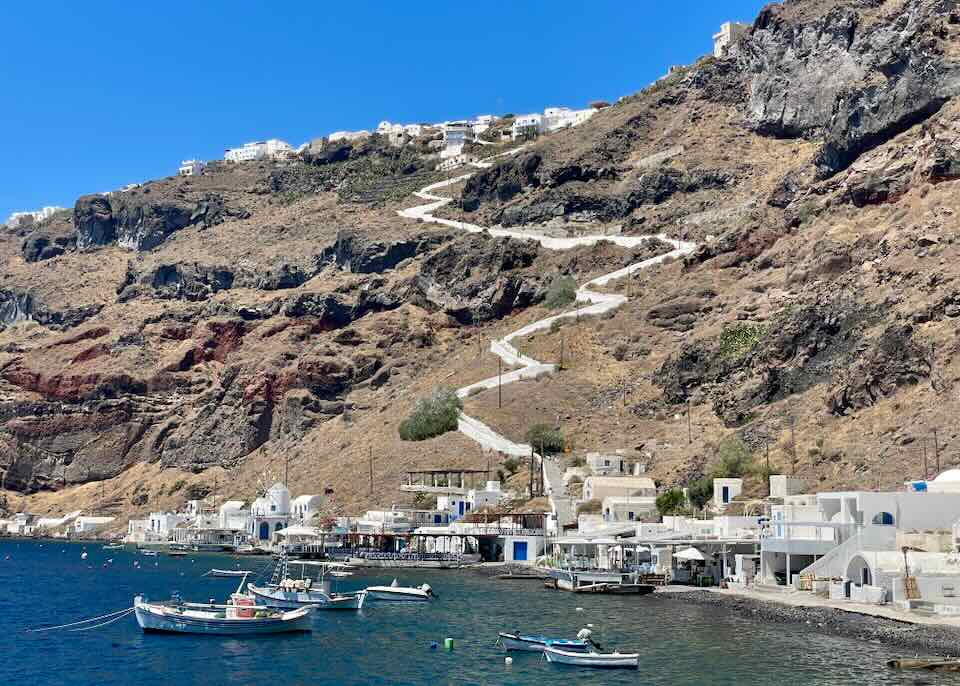
Looking up from Korfou Bay towards Manolas Village.
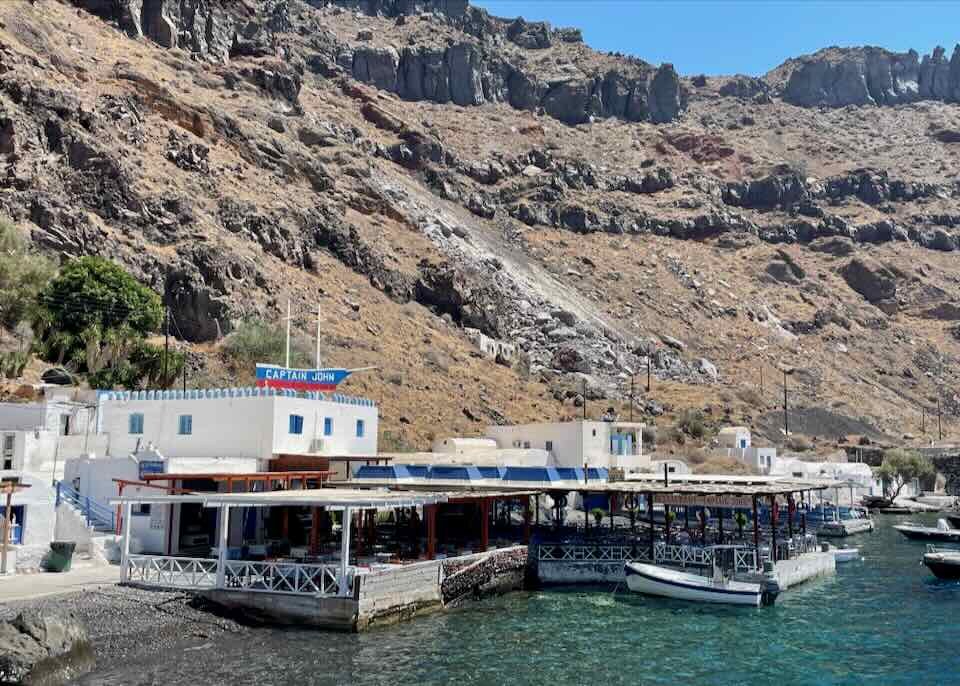
Captain John restaurant in Korfou Bay.
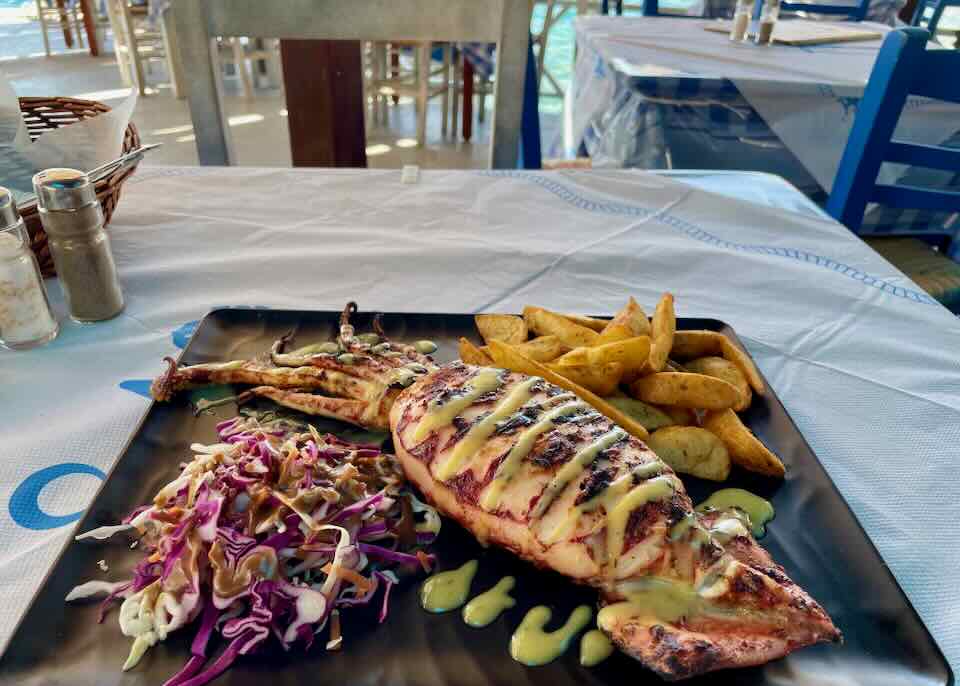
The grilled squid at Captain John was amazing.
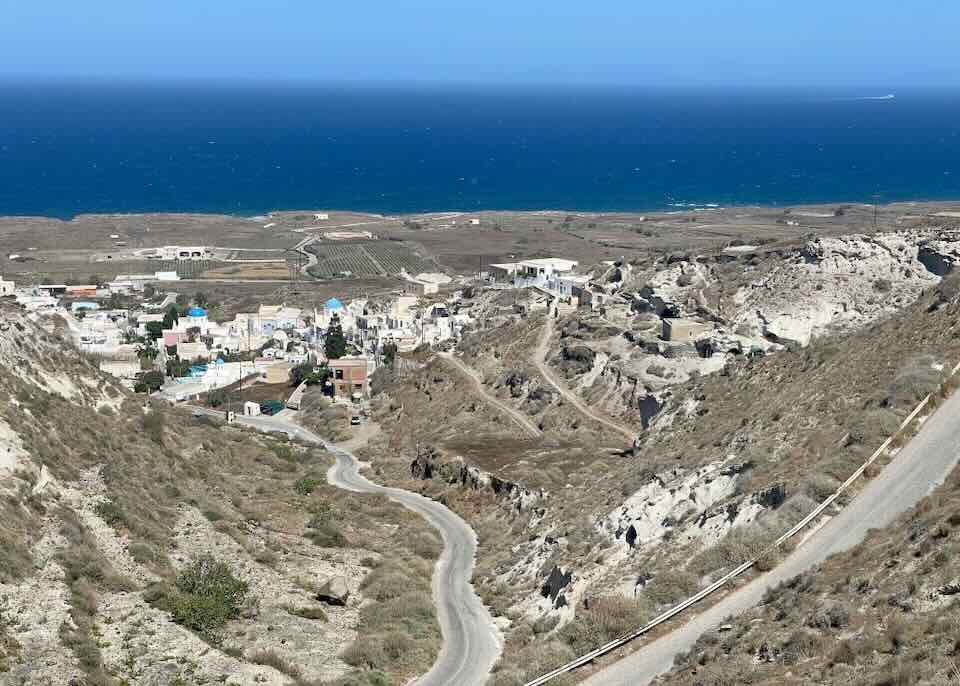
View from Manolas Bay towards the sea (looking west, not into the caldera like above).
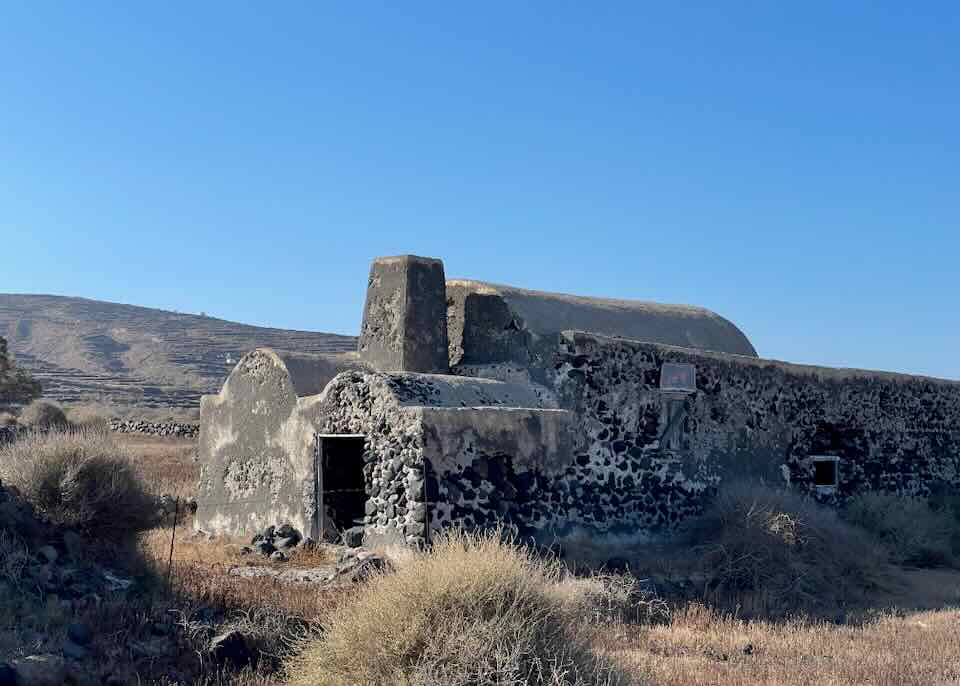
The undeveloped countryside in Thirassia makes it ideal for peaceful hikes.
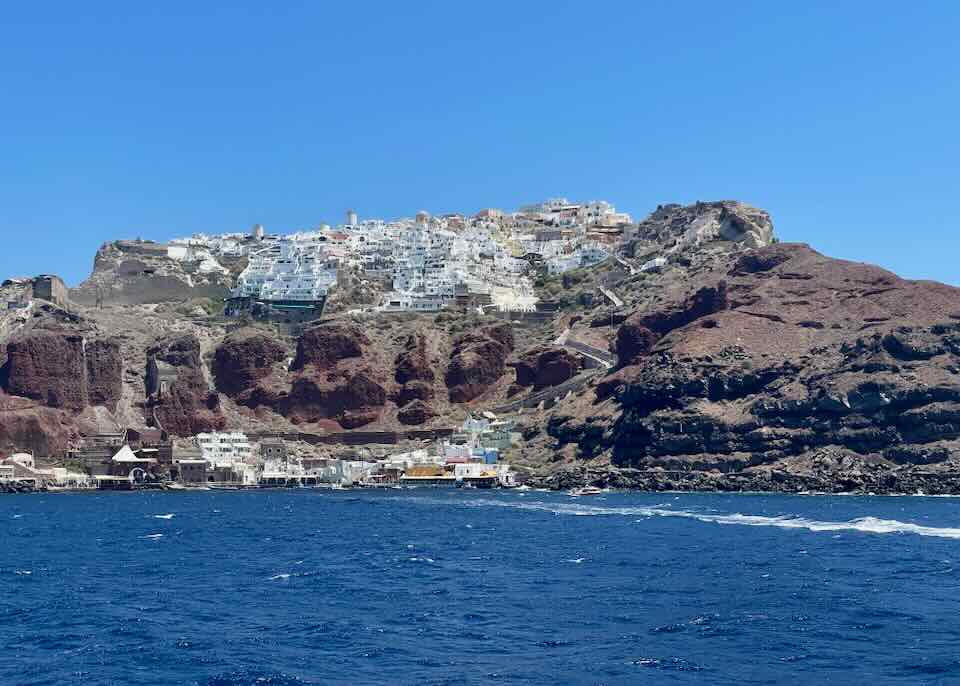
Heading back to Oia. Approaching Ammoudi Bay (from Thirassia) by ferry

Katharos beach near Oia. Thirassia visible behind the splashing wave.
July 13, 2024

A proposal at Amara Villa in Imerovigli. The patio and private location is all yours when you stay at the villa.

Traditional Greek breads at Erotokritos bakery in Karterados. (About a 15 minute walk from Fira. Open 24 hours.)
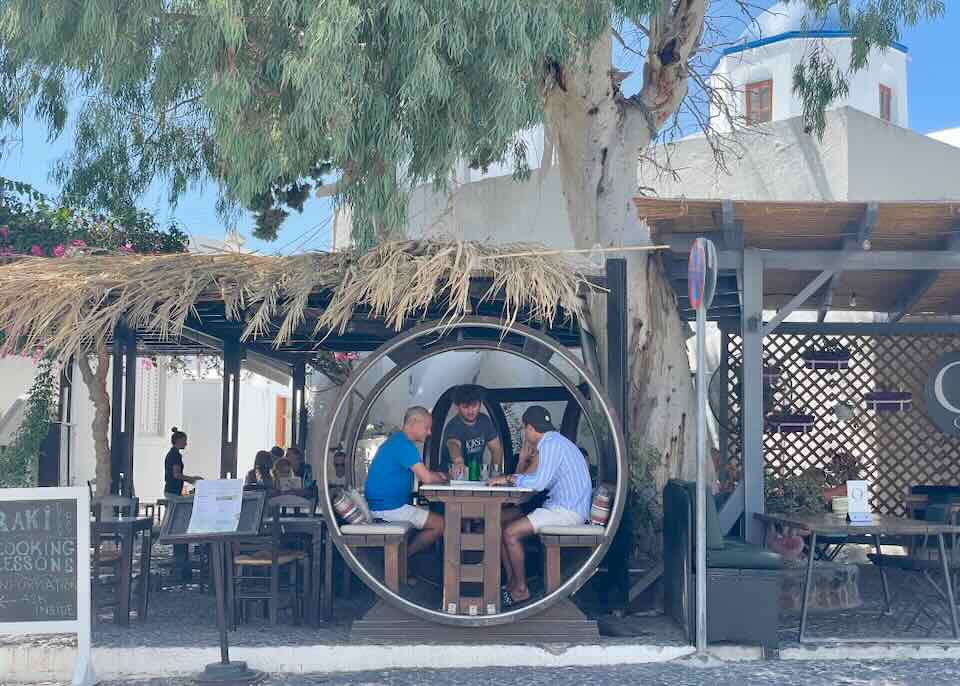
Raki restaurant in Megalochori. Great food and also offers Greek cooking lessons.
July 12, 2024
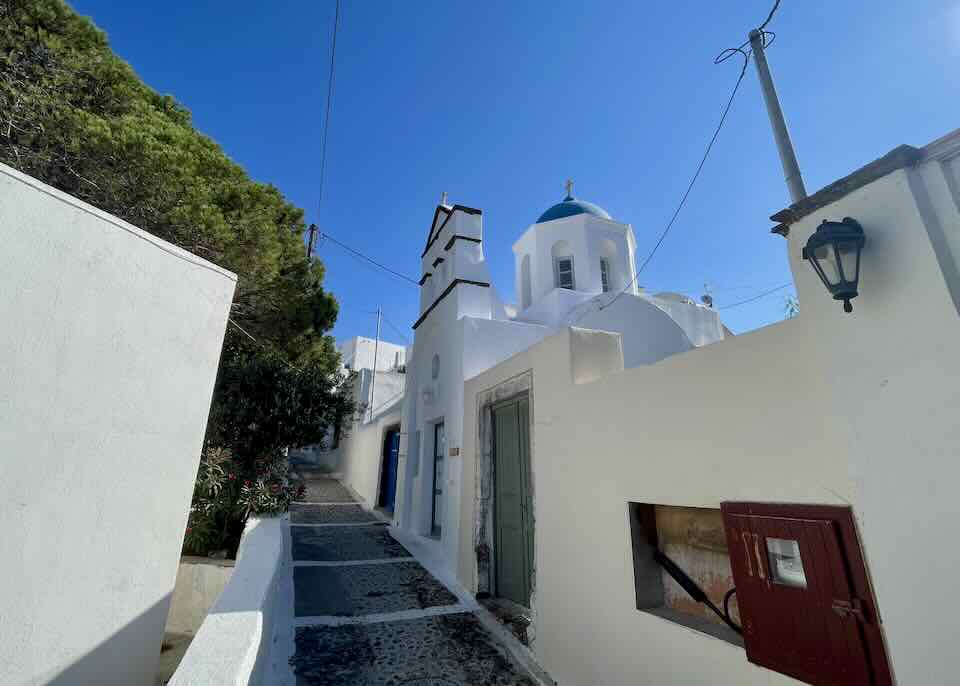
Saint Sampson church in Pyrgos.
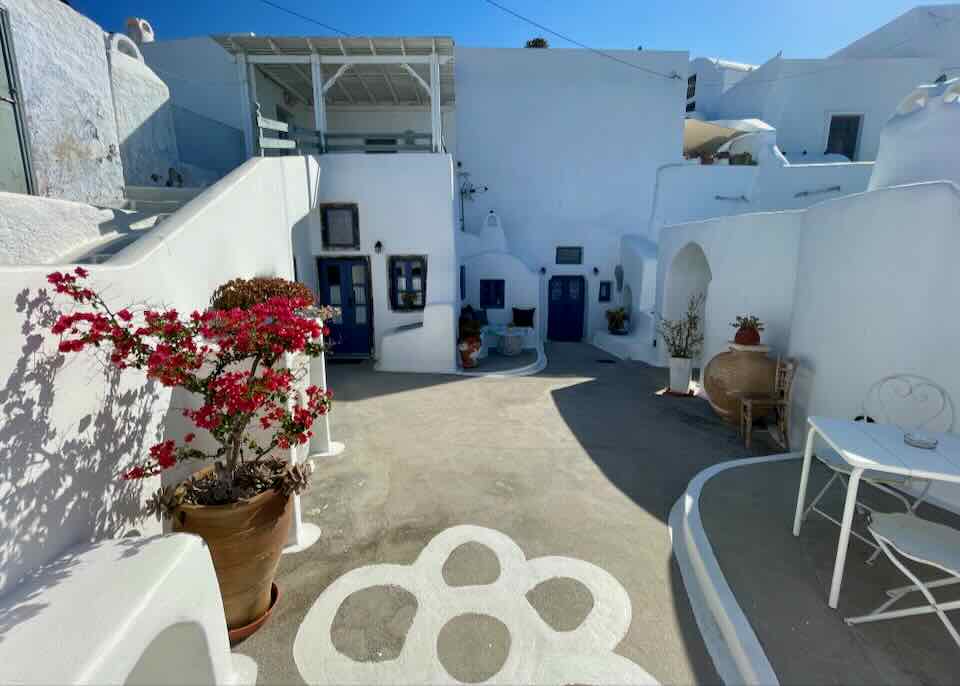
Olyra Traditional Cave Houses in the heart of Pyrgos village.
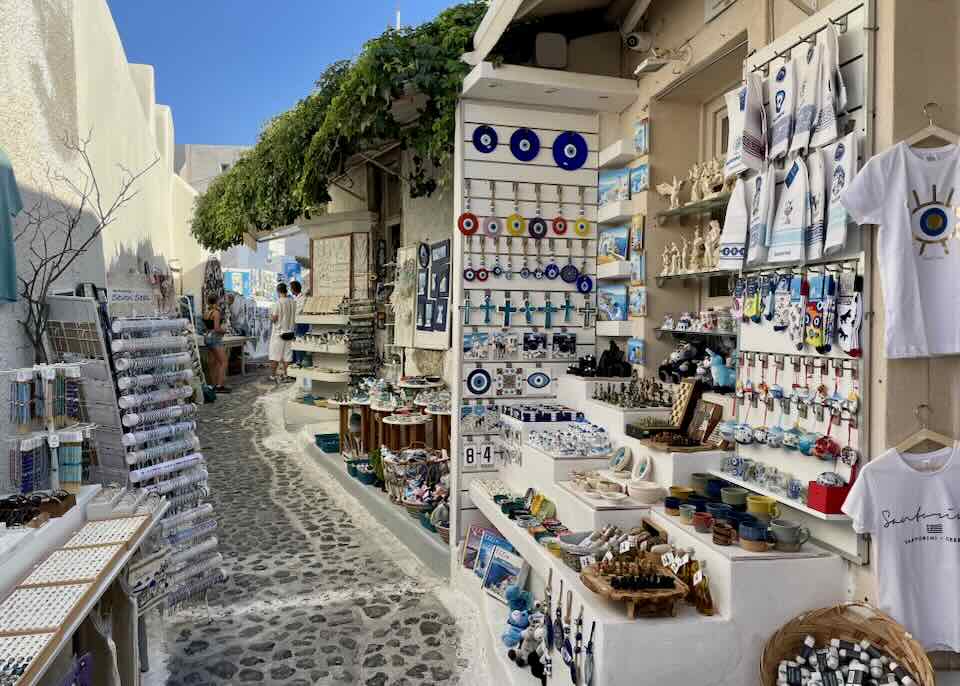
Souvenir shop on the lanes of Pyrgos.
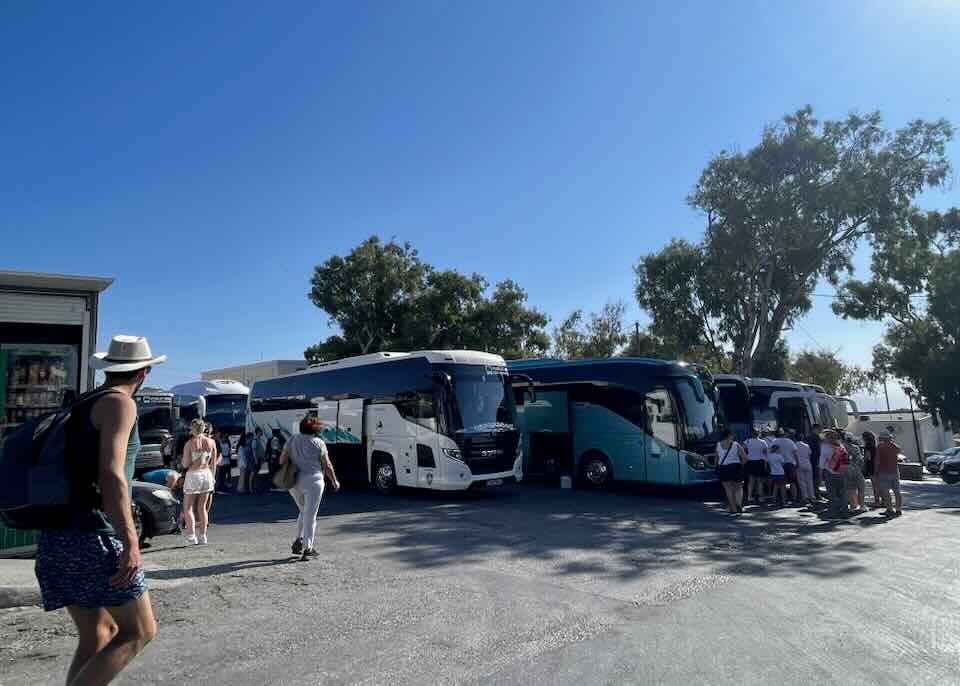
Fira bus station early in the morning.
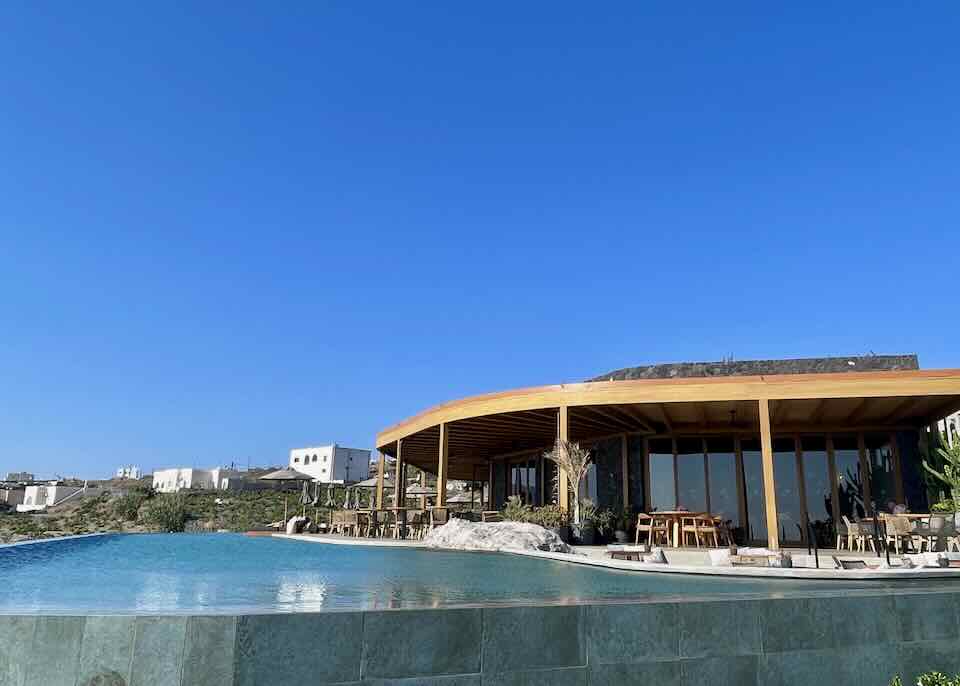
The huge pool at the Magma Resort. (Note: website photos try to make it look like the hotel has caldera views, but the hotel is not on the caldera, and views are to the east.)
July 11, 2024

Lycabettus restaurant at Andronis Luxury Suites in Oia.
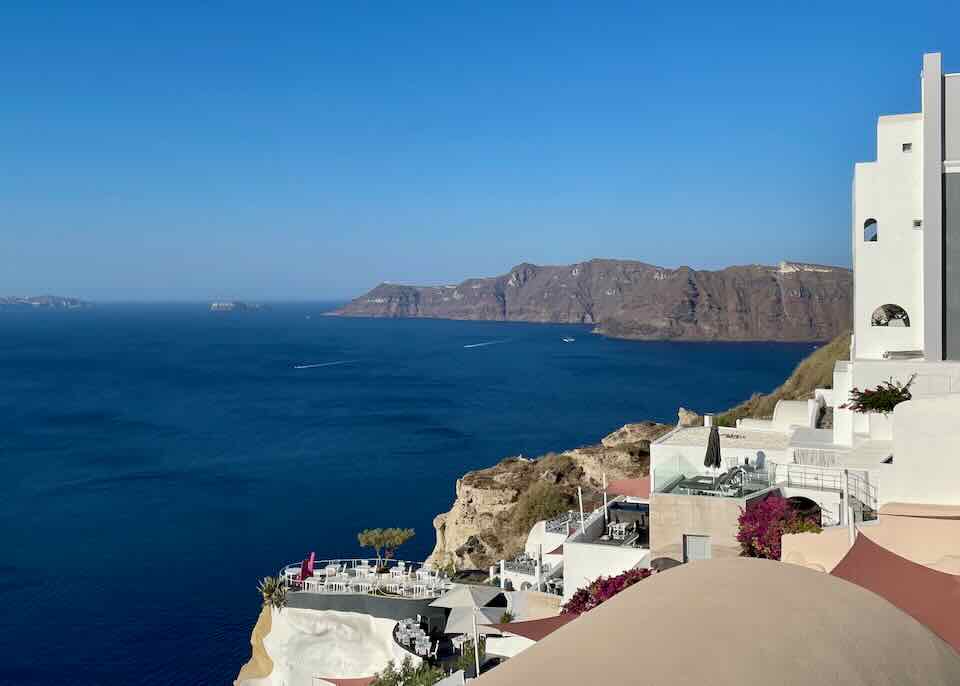
Lycabettus restaurant from a different angle. For reservations: reservations@lycabettusrestaurant.com
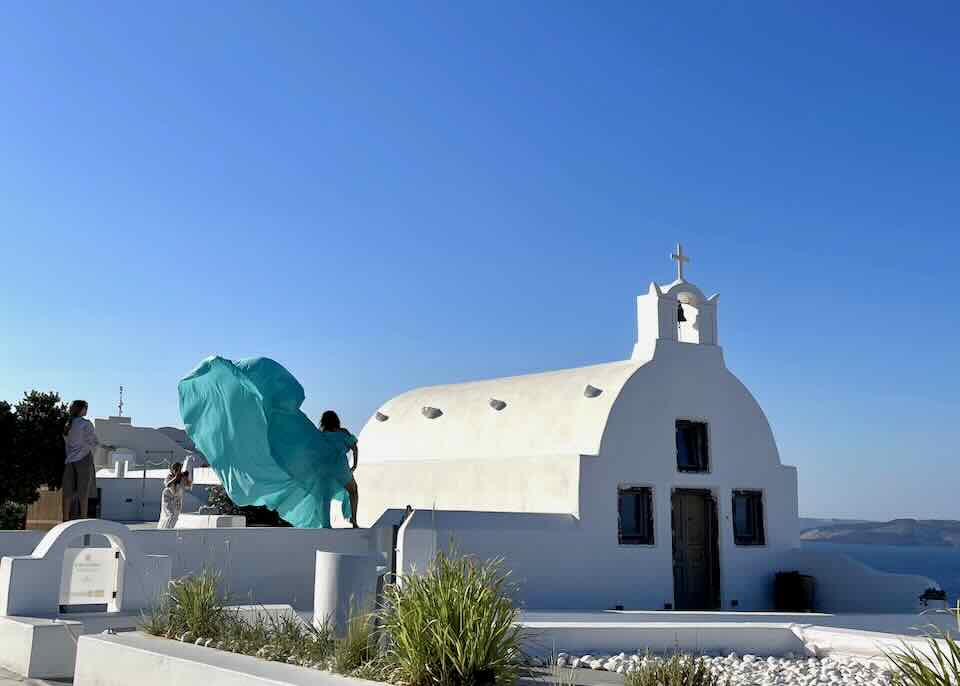
Flying dress photoshoot at the Church of the Assumption of the Virgin in Oia.

One of One – Aether suite in Oia. (Formerly Zoe Aegeas Traditional Houses.)
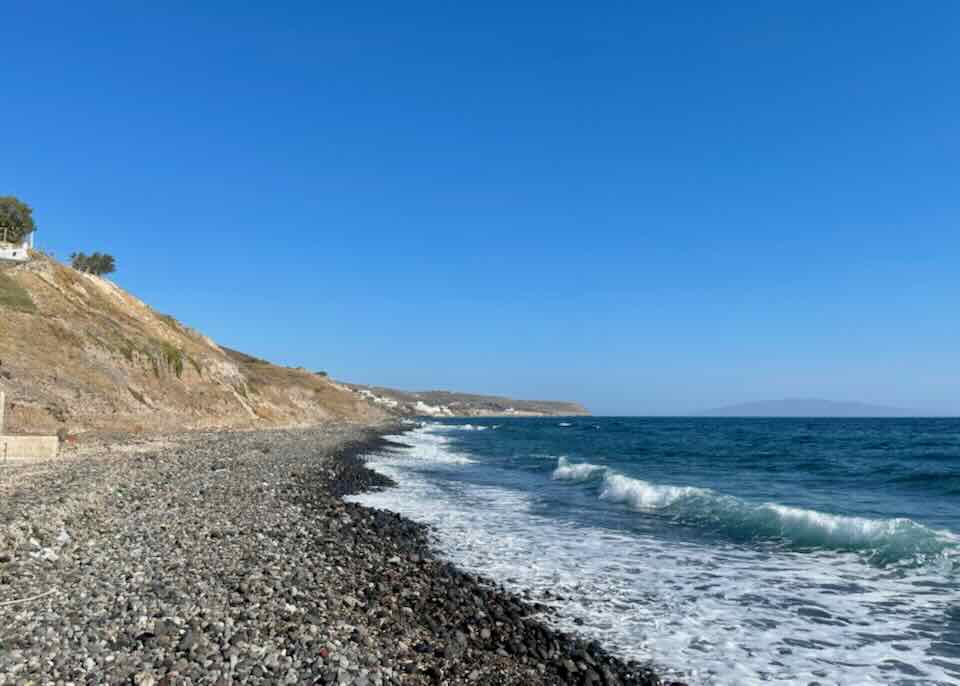
Beach south of Pori on the east side of Santorini. Looking north.
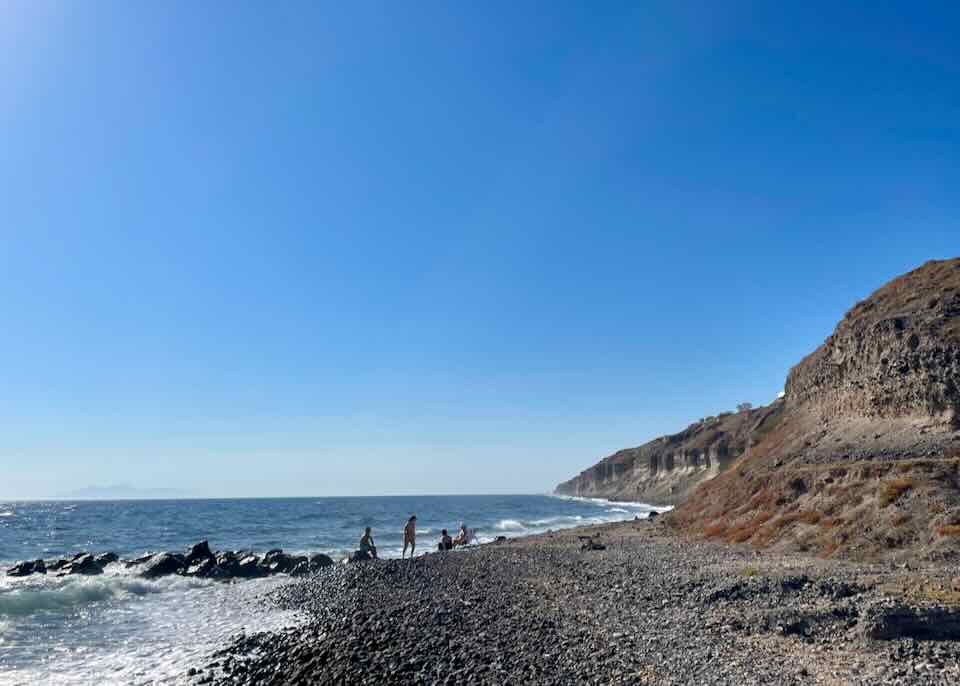
Looking south.
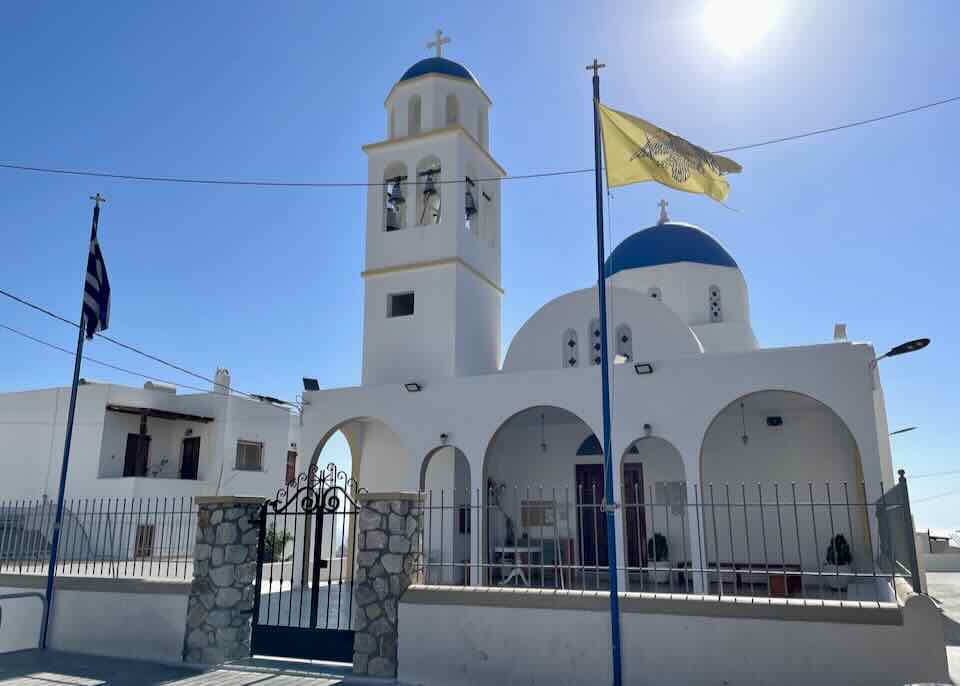
Saint Efstratios church in Vourvoulos.
July 10, 2024
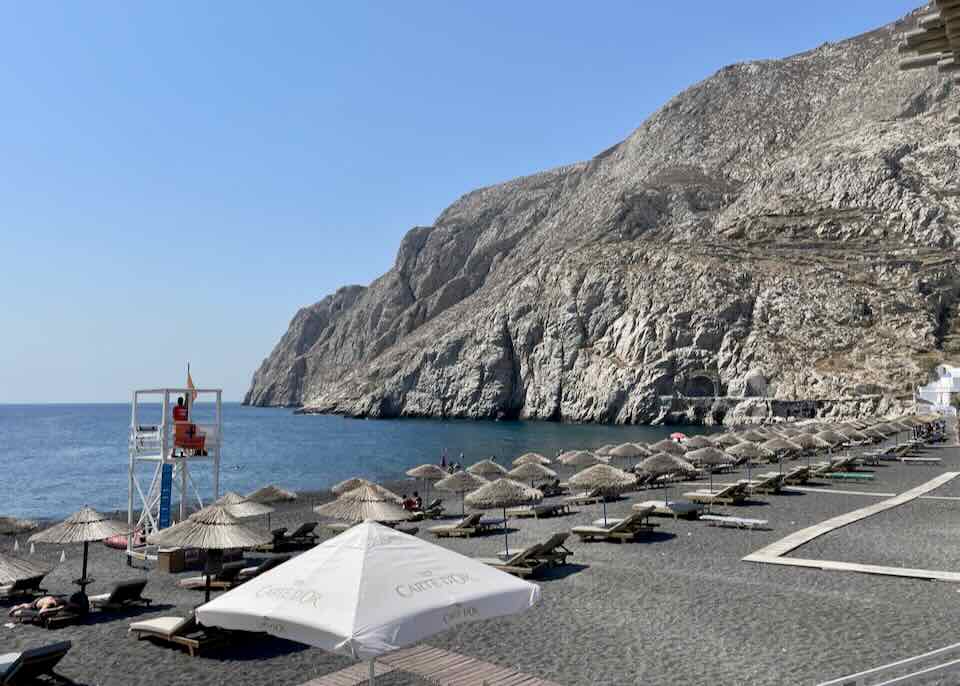
Lifeguard keeping watch at Kamari beach.

Trendy and eclectic La Boheme in Kamari. (Patios at the excellent value Santellini Hotel perched above.)

Inside La Boheme.
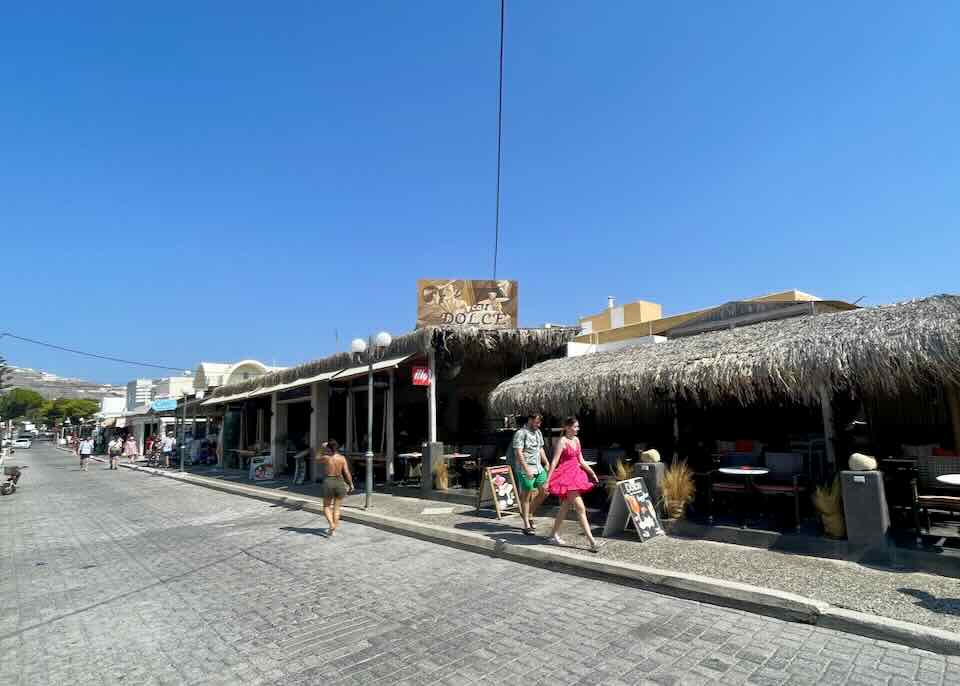
Cozy Cafe Dolce in Kamari.
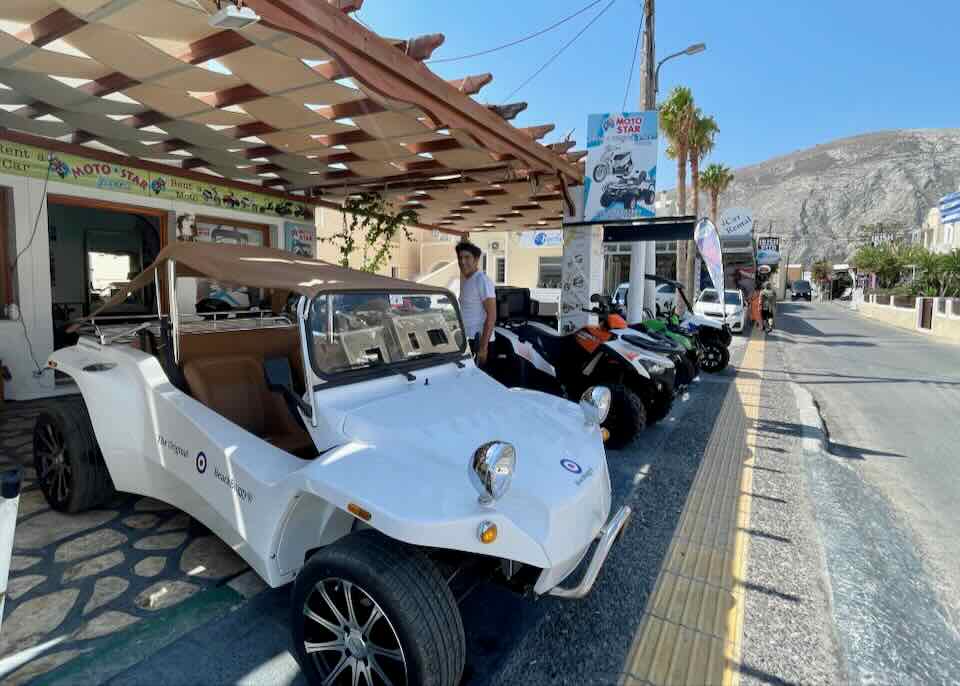
A huge selection of buggies and ATVs at Moto Star in Kamari.

View from Pyrgos towards Exo Gonia. A bit hazy today.
July 9, 2024
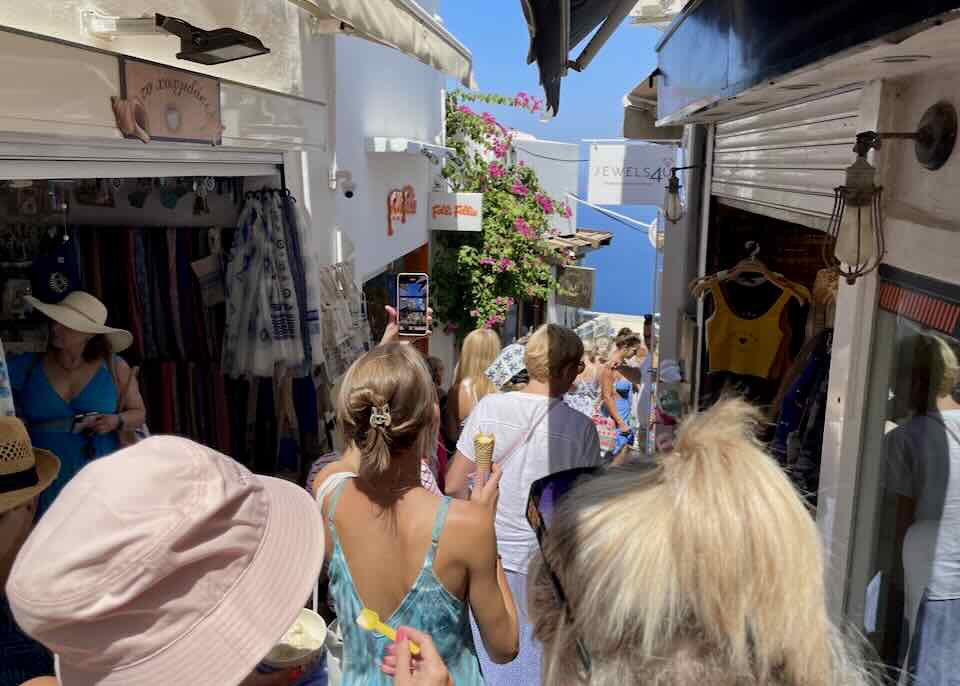
Photos and ice cream on the streets of Fira.

The path from the cruise port to Fira.
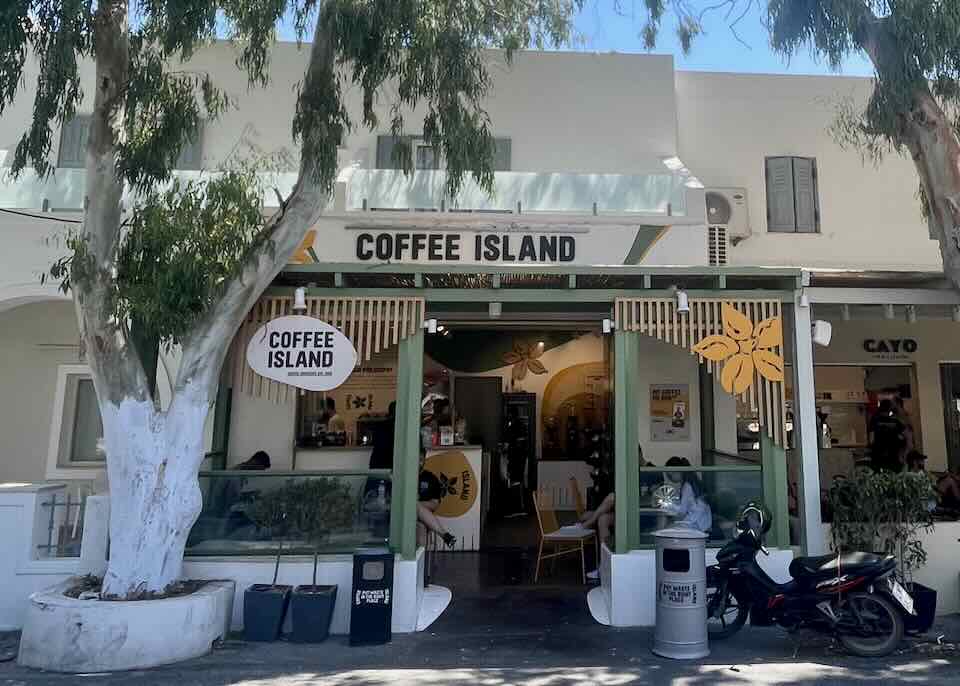
Coffee Island in Fira. Popular with locals early in the morning, tourists through the day.
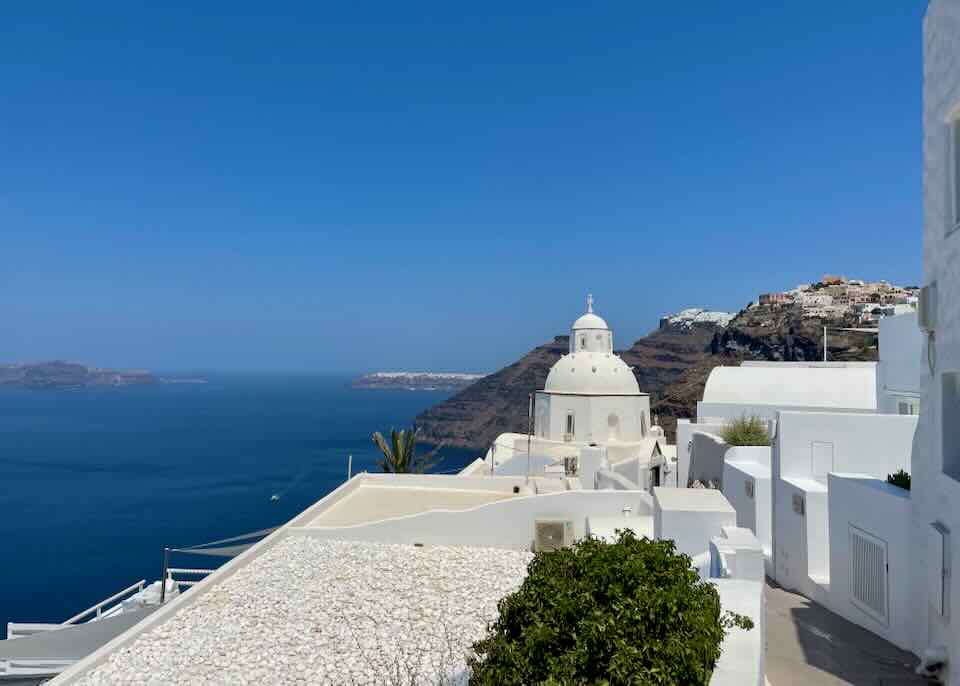
Saint Minas Church in Fira: This is the first summer it is open for everyone, 10 AM to 2 PM.

Getting some shade from Saint Minas.

Inside Saint Minas Church.
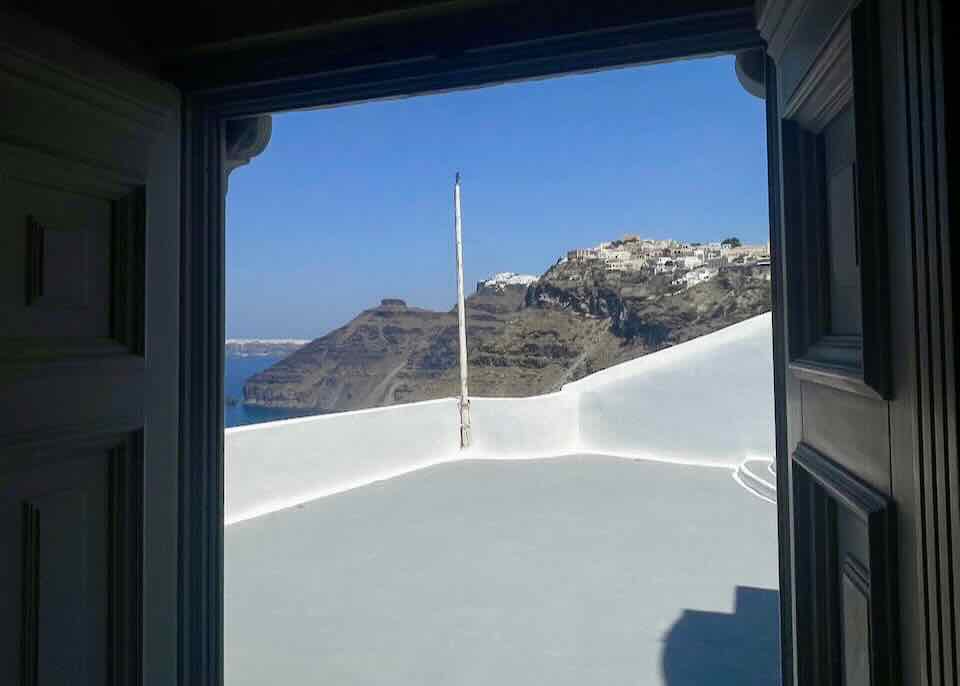
View from inside Saint Minas.
July 8, 2024
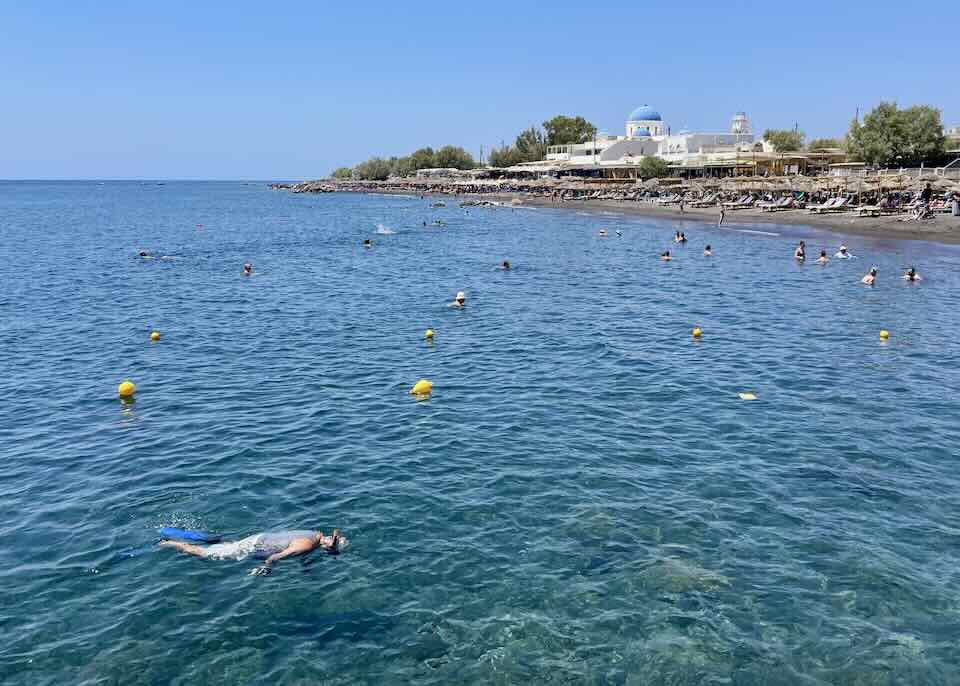
Snorkeling at Perissa beach
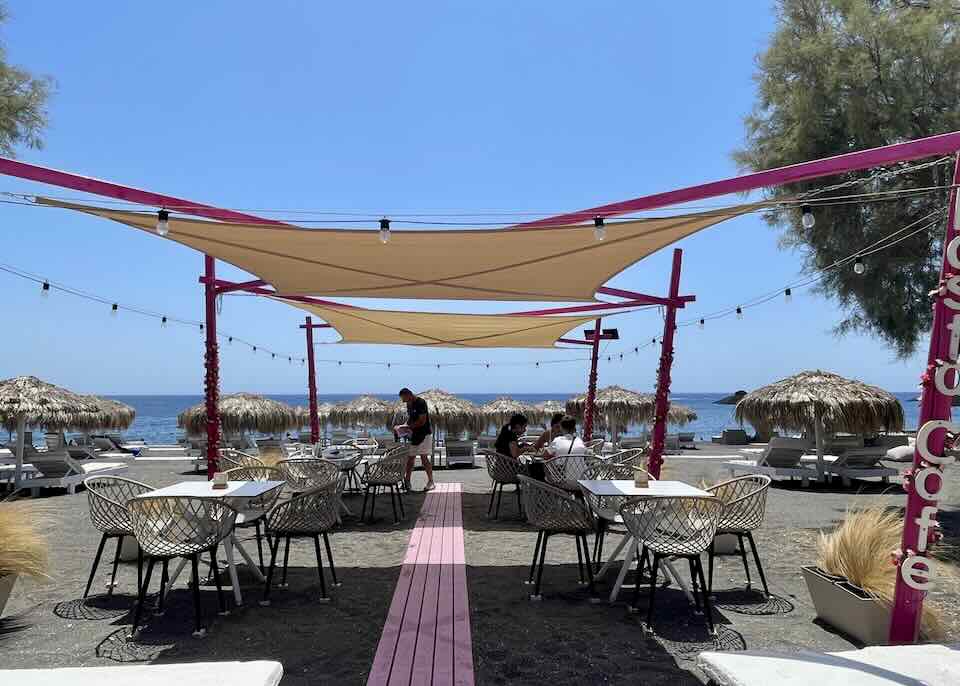
Chocolat creperie-cafe on Perissa beach
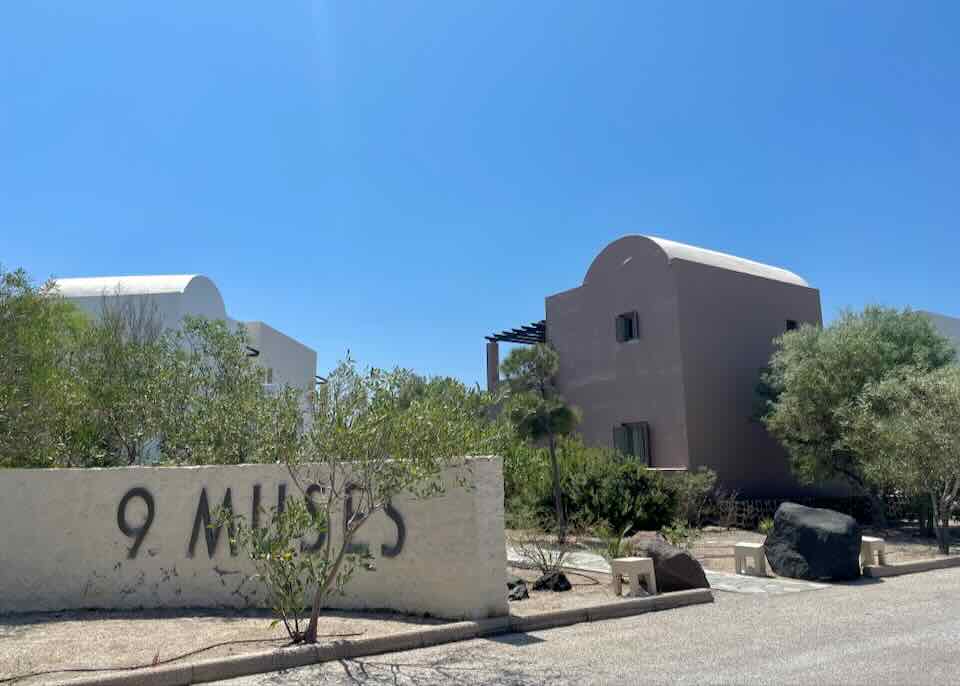
9 Muses hotel in Perivolos offering horseback riding, lawn tennis, and bike rental.
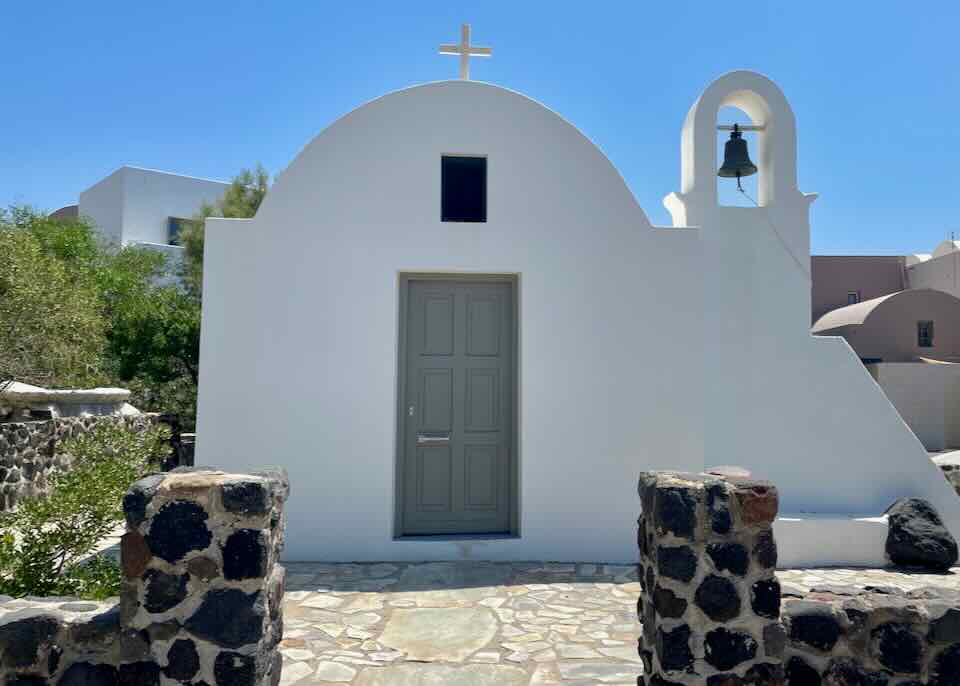
The private chapel at 9 Muses hotel. (Available for weddings.)

A vineyard near Megalochori. The grape harvest usually begins in late August or early September.

Megalochori village, late in the evening.
July 7, 2024
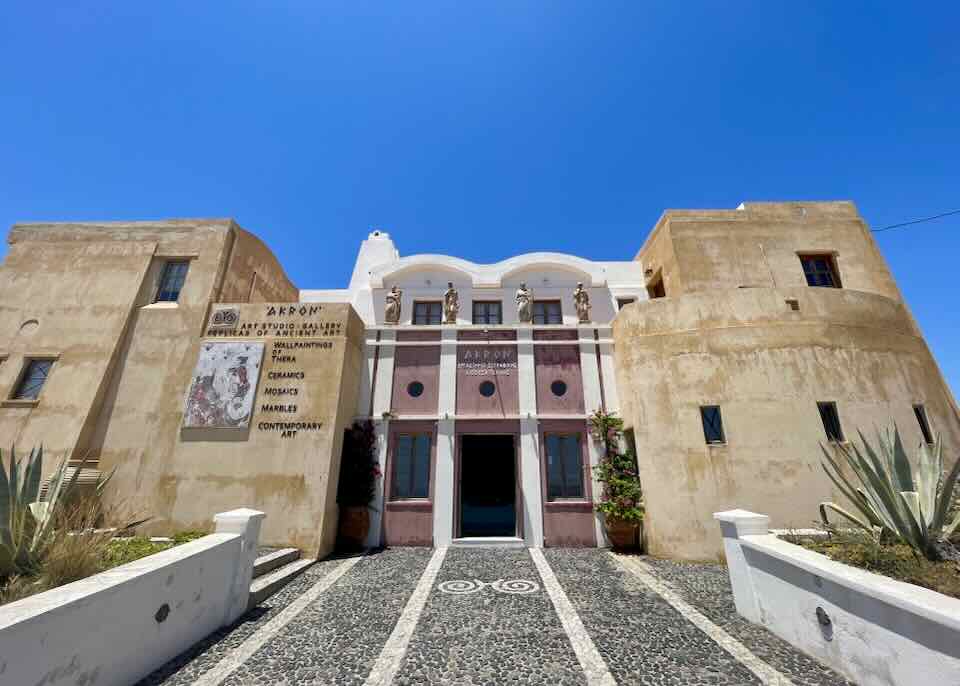
The Akron Art Centre in Megalochori.

The Akron is a gallery displaying reproduced wall paintings from Akrotiri and Minoan and Classical ceramics.
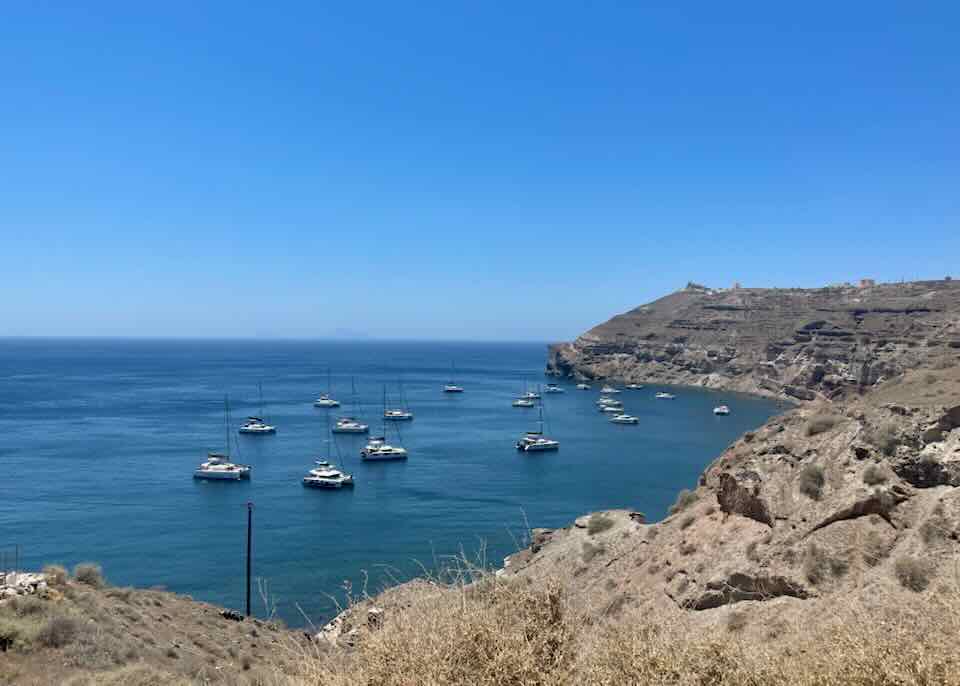
Boats at Mesa Pigadia Beach.
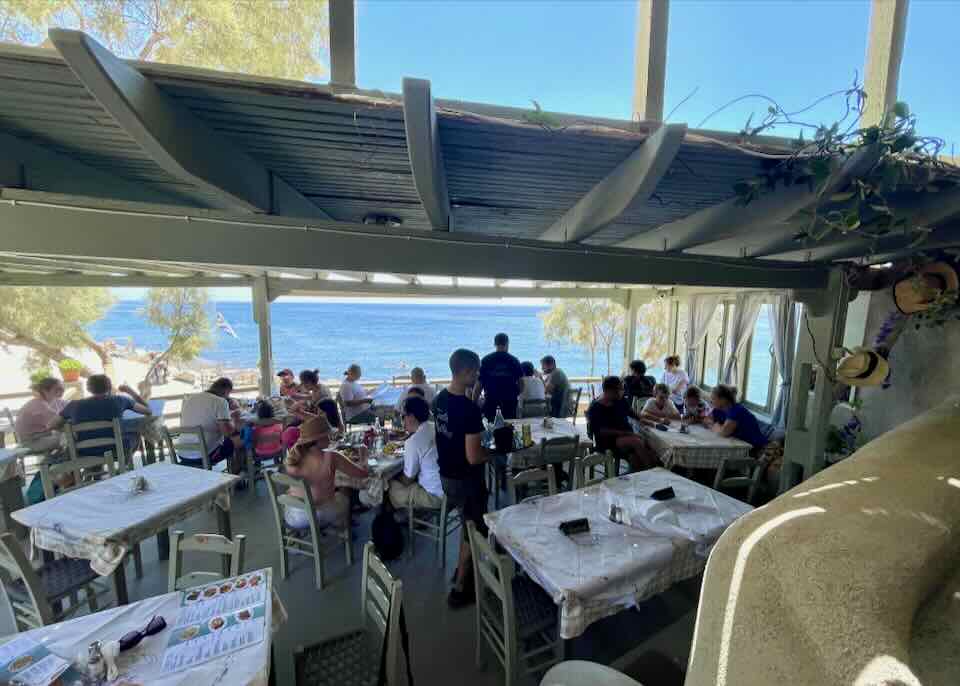
Mesa Pigadia Family Tavern (the food was excellent).

Tomatokeftedes, also known as fried tomato balls, are a popular appetizer originating from Santorini. They’re made from crushed or pureed tomatoes mixed with herbs, onions, and sometimes feta cheese, formed into balls or patties, and then fried in oil until crispy and golden brown. They are often served with a side of tzatziki or as part of a meze platter.
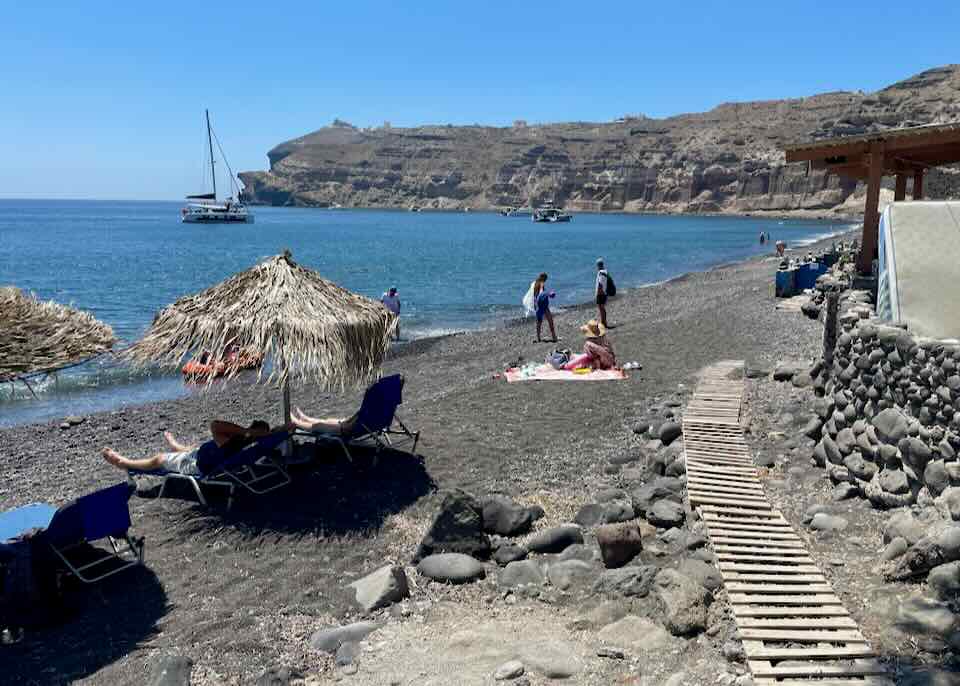
The beach is just below the restaurant.
July 6, 2024
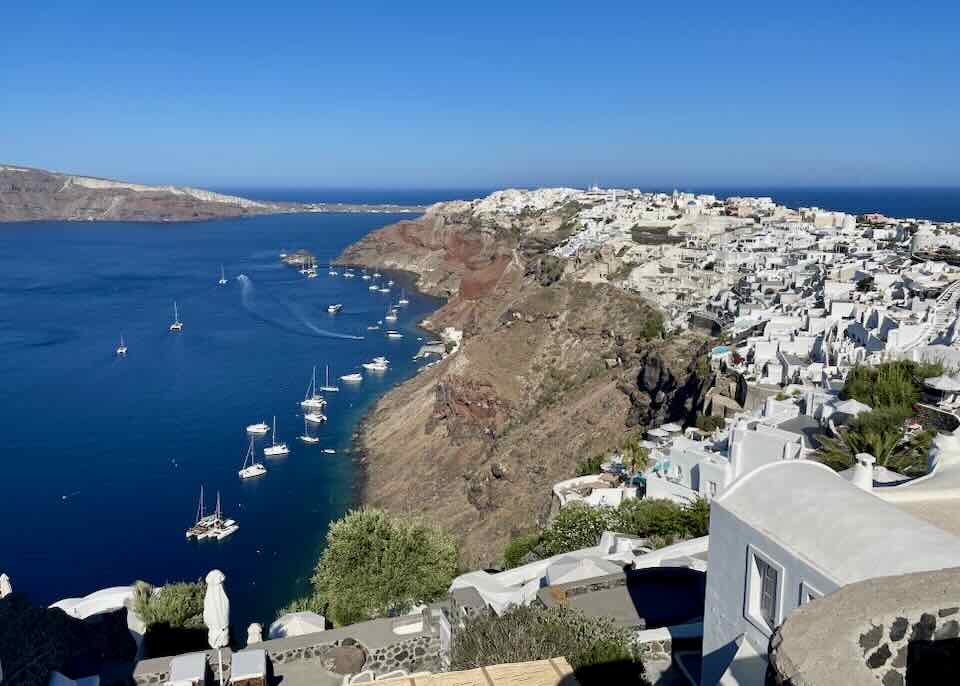
Early morning view of Oia.
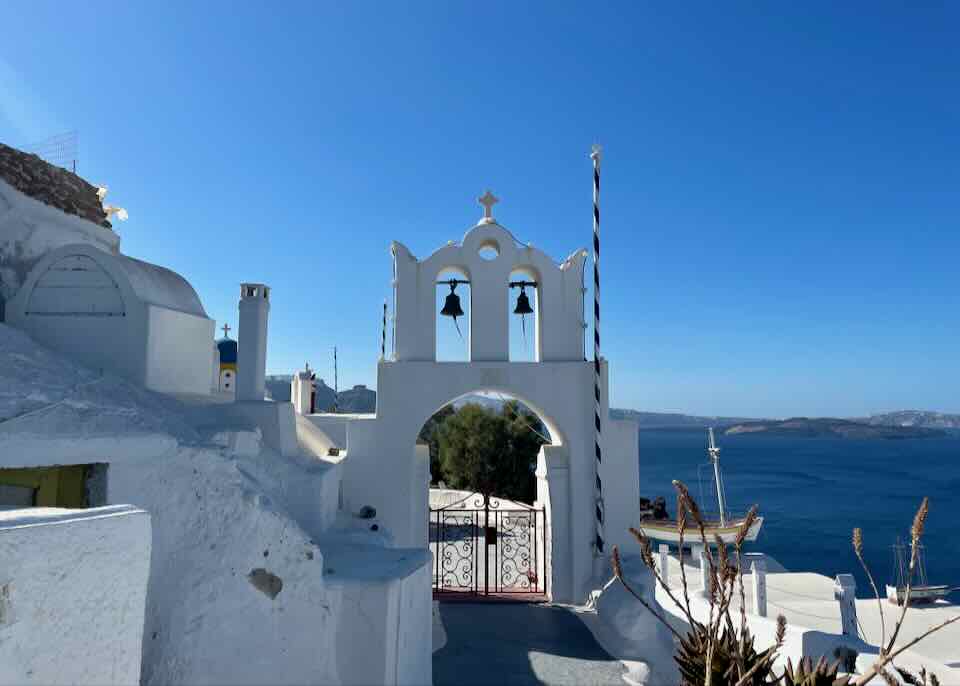
Saint Basil church on the caldera cliff. The entrance to Captain John Traditional Houses is just to the right, near the boat in the background.
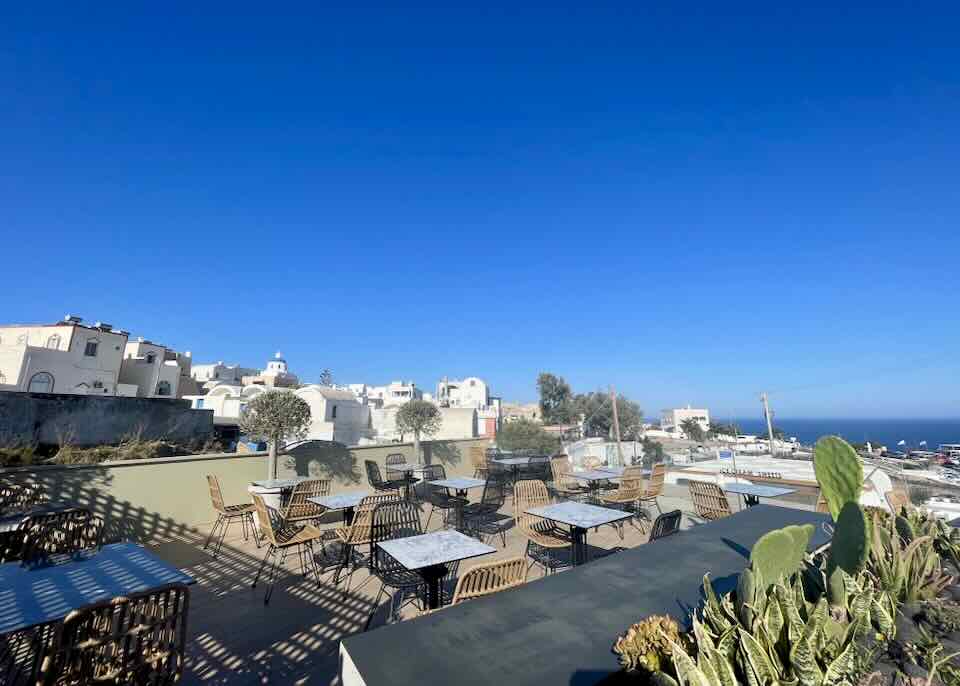
KooKoo restaurant. Close to Oia’s bus stop with a rooftop garden open for sunset views.

Markos, manager and part owner of Kookoo.

Rimida Villas in Oia.
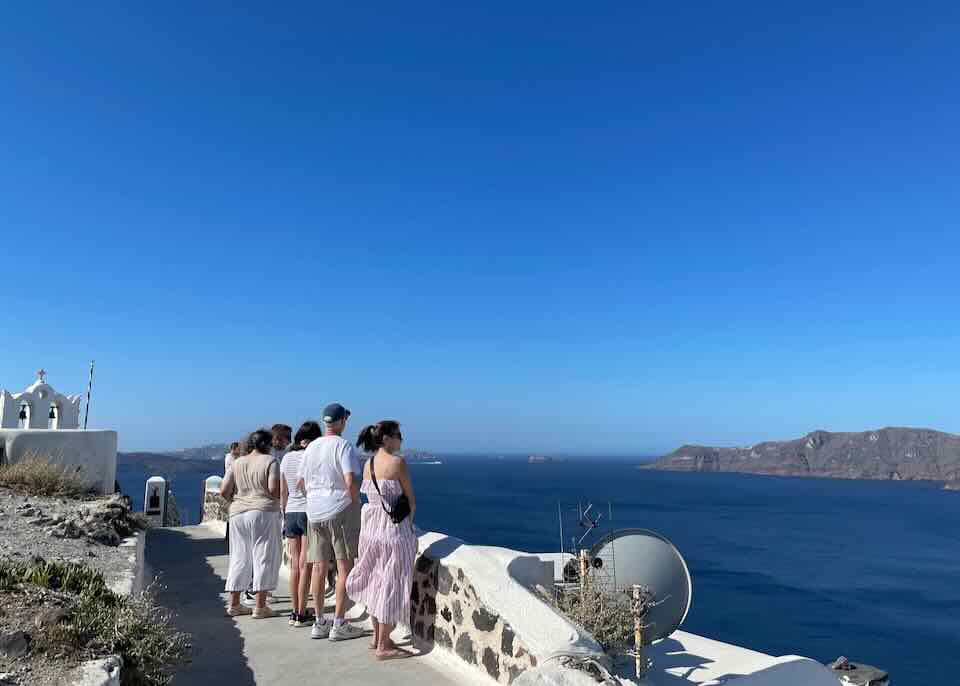
A guided tour group in Oia.
July 5, 2024

The road along Monolithos Beach.
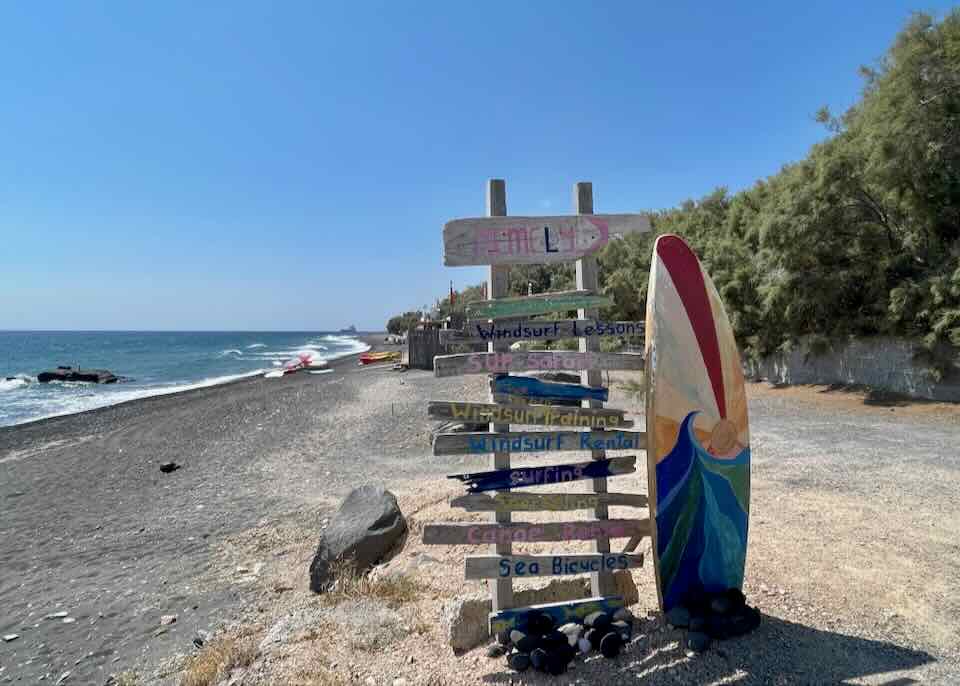
Nemely Windsurf and SUP Center on Avis Beach just north of Kamari.
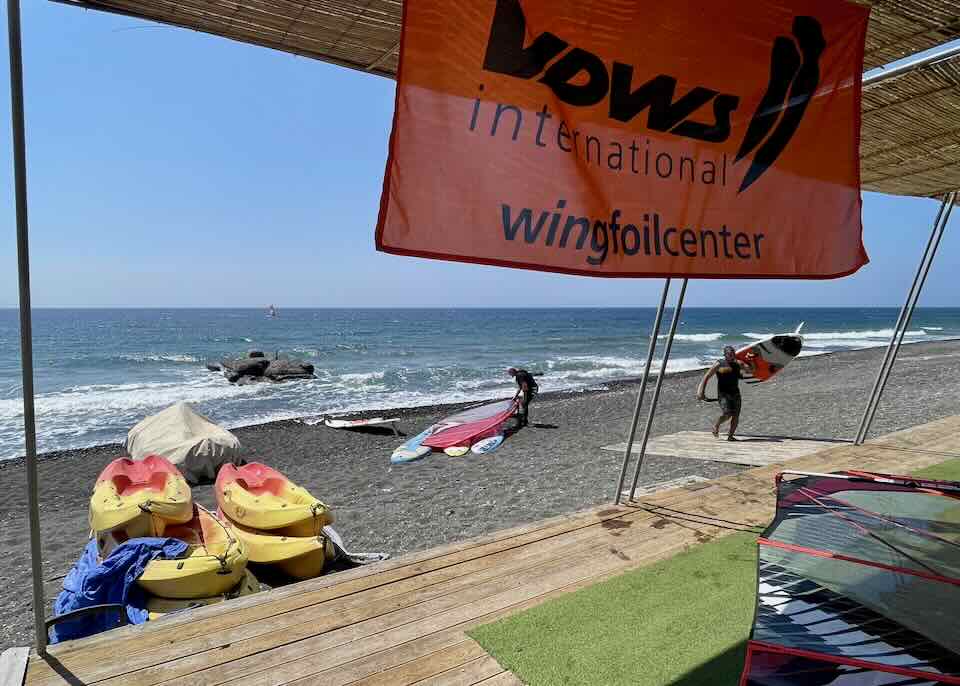
Nemely rents windsurfing and paddle boards, and offers lessons and caldera tours.

Omoo Coffee in Messaria.
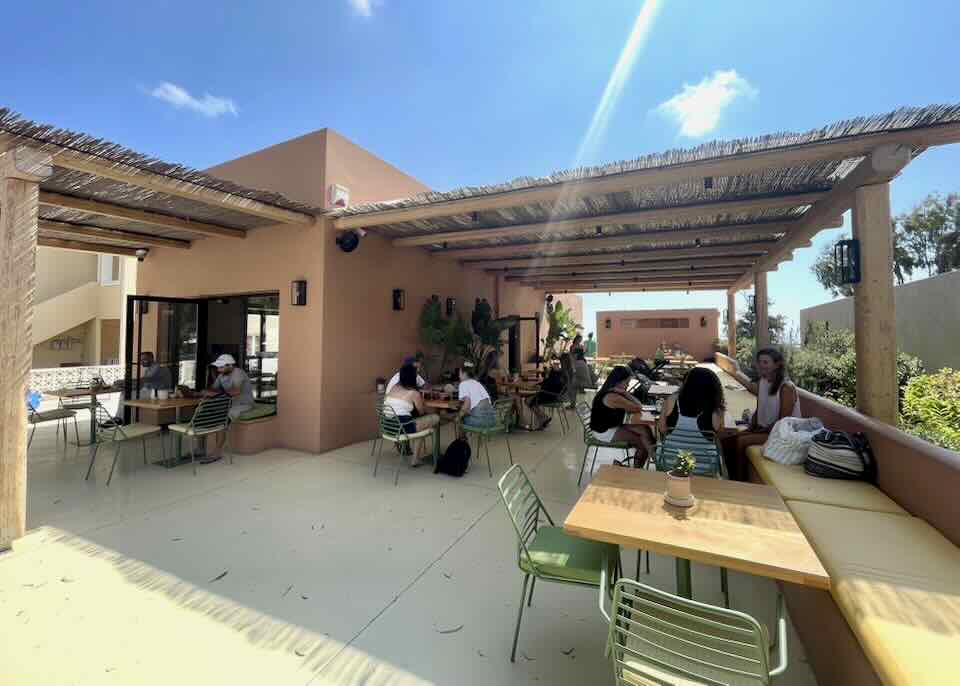
Omoo.
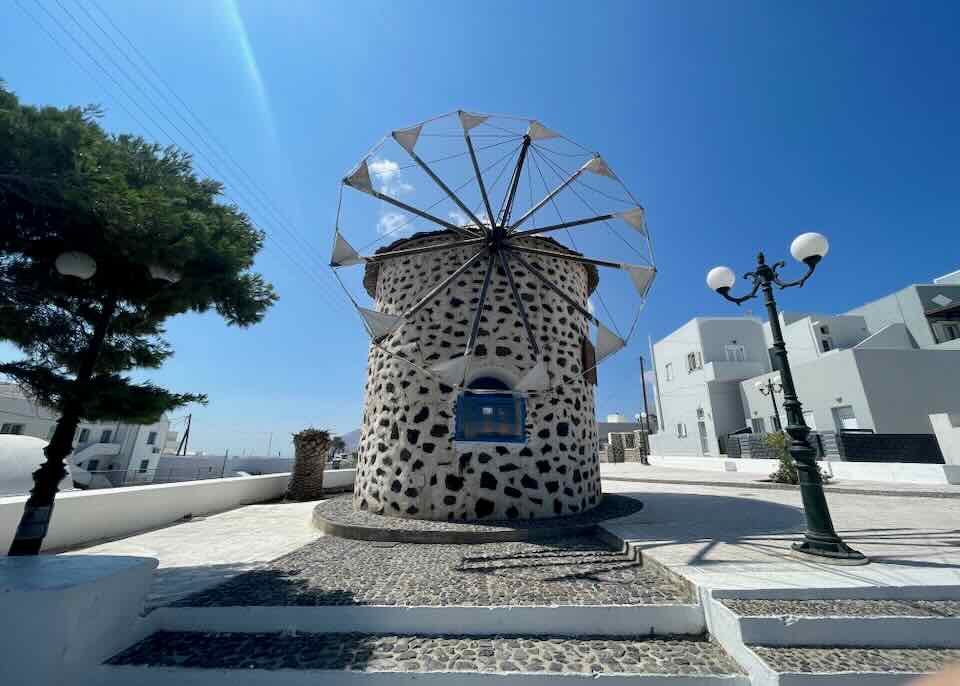
Windmill in Karterados village, which is close to Fira and has a good collection of affordable hotels.
July 4, 2024
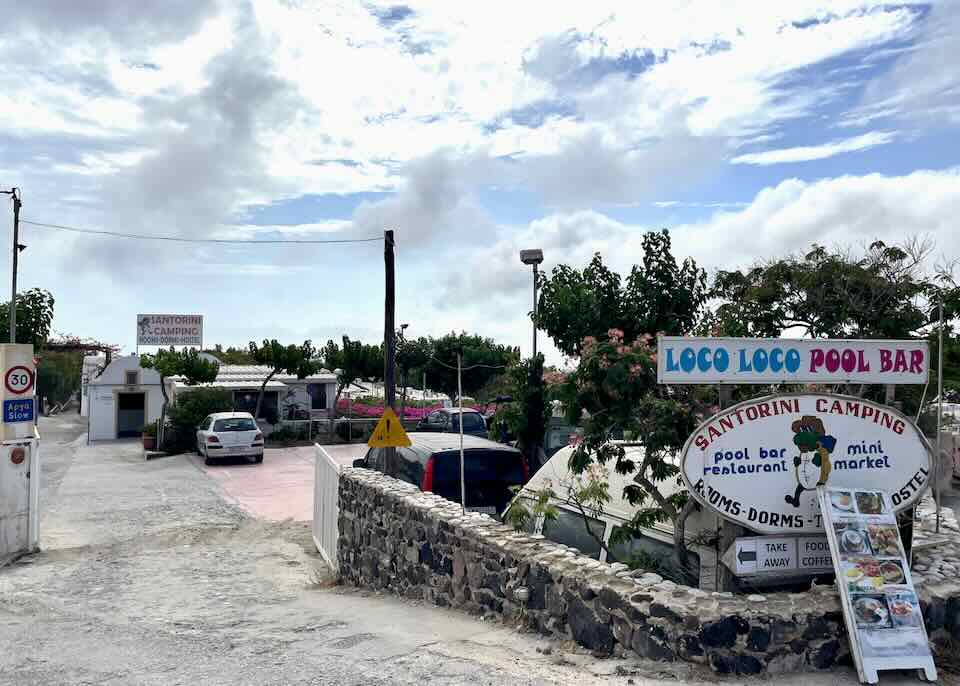
Santorini Camping. Located east of Fira, about a 10-minute walk to the main square.
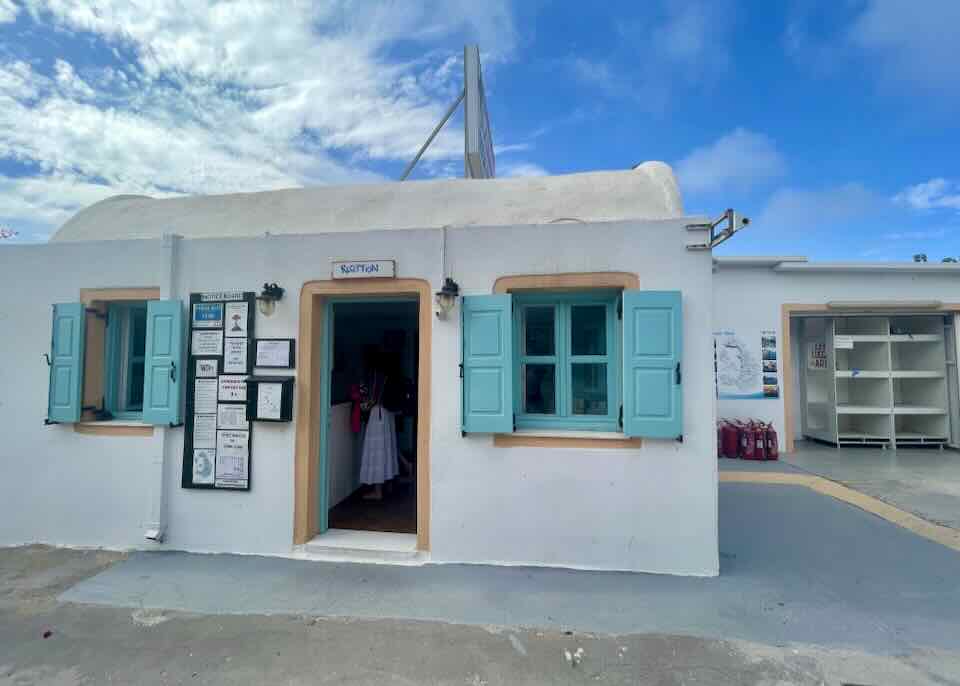
Reception at Santorini Camping.
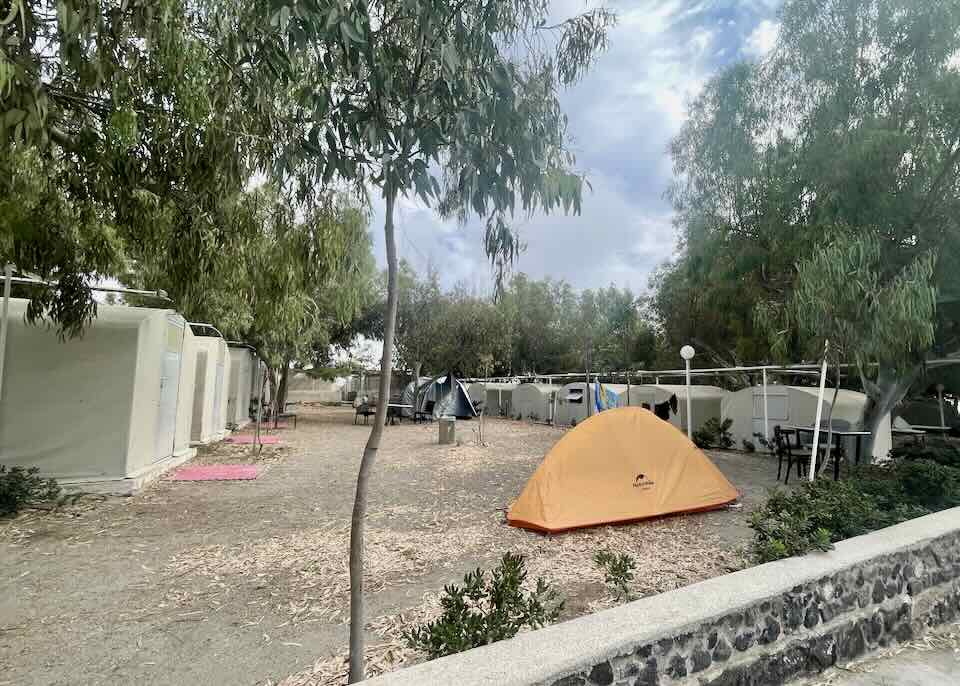
Tents at Santorini Camping. There are also doubles, triples, quadruples, and dorm rooms with bunk beds.
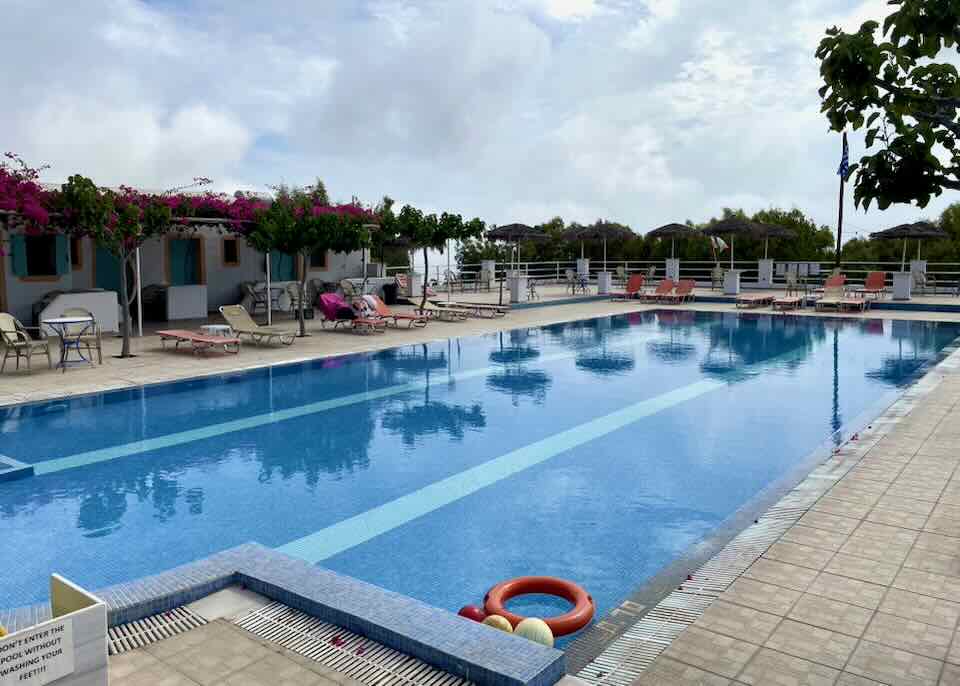
Pool at Santorini Camping. There’s also a cafe, bar, and mini-market.

Canava Distillery and Museum south of Fira.

Artemis, a guide at the Distillery Museum.
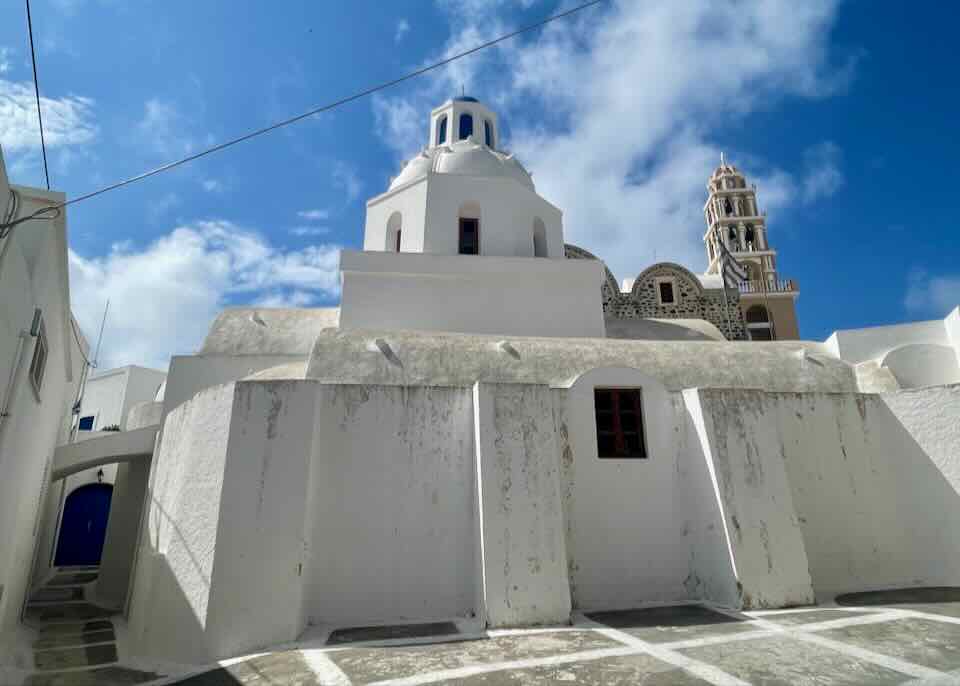
Άγιος Σπυρίδων (Saint Spiridon) in Messaria.
July 3, 2024

Fira.

Petite Palaces south of Fira.

Church of the Resurrection of the Lord in Imerovigli.
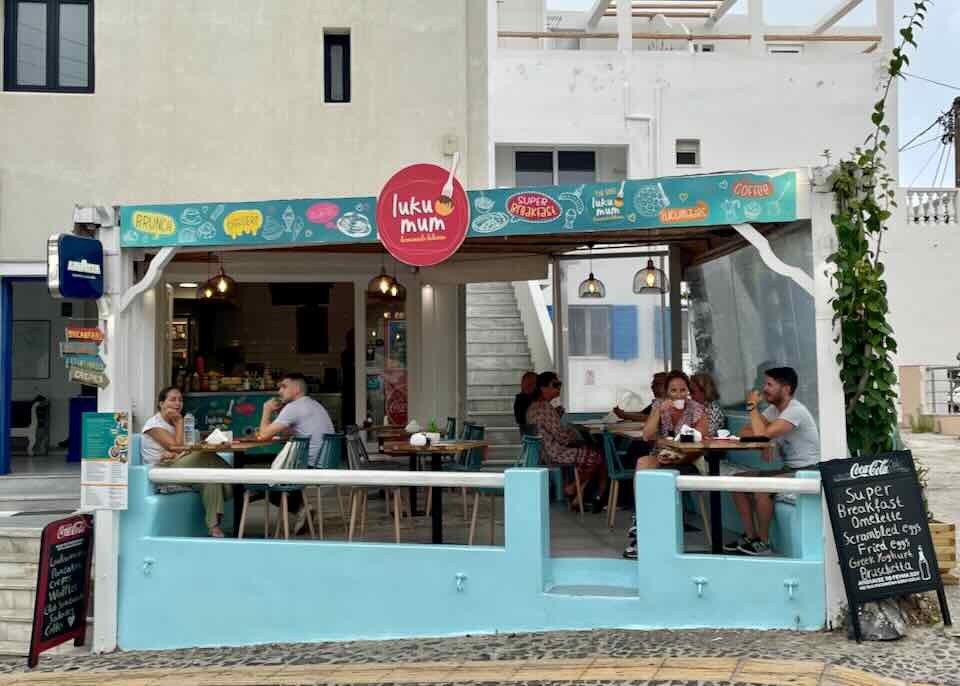
Breakfast at Luku Mum in Fira.

A great place to get loukoumades. (Be sure to try them if you haven’t already.)
July 2, 2024
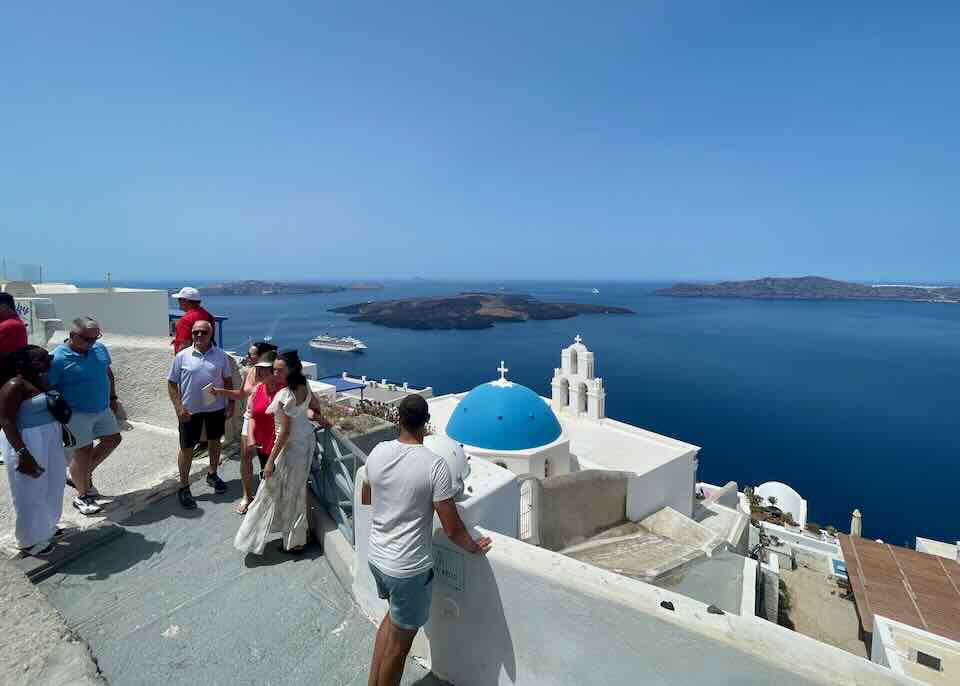
One of the most iconic scenes in Santorini is the Catholic Church of the Dormition, also known as the Three Bells of Fira.

My favorite gelato shop in Santorini – Zotos in Fira.
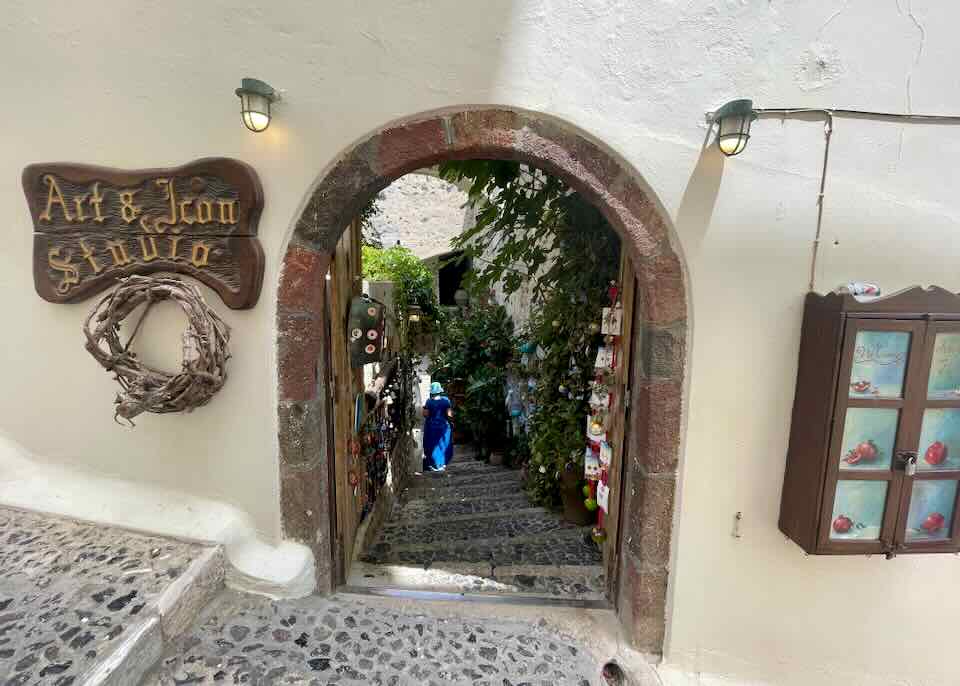
Art & Icon Studio in Fira selling handmade souvenirs and Byzantine icons.

The shop is hidden down a lane and some steps off the main path.
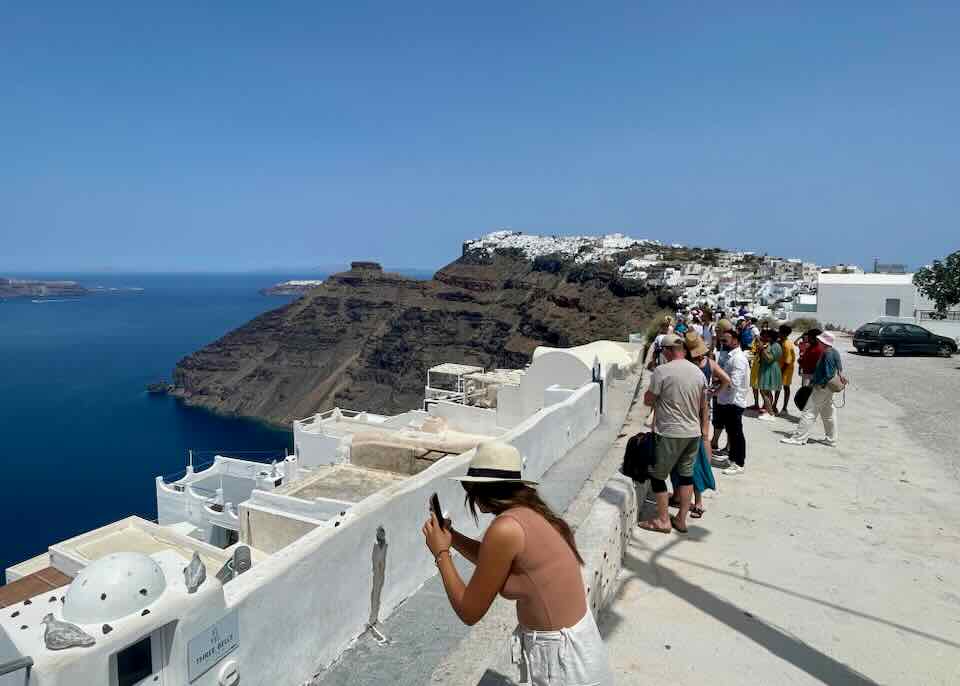
View of Skaros Rock on the Fira to Firostefani path.
July 1, 2024
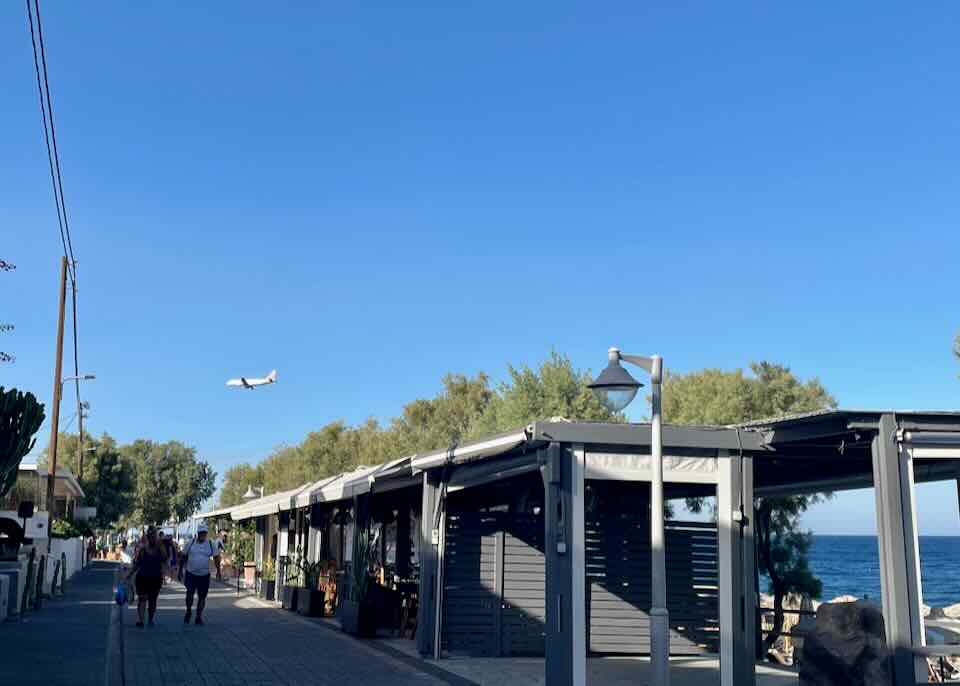
A plane flying over Kamari to land at the Santorini airport just a few miles away.

Erotokritos Bakery in Kamari.
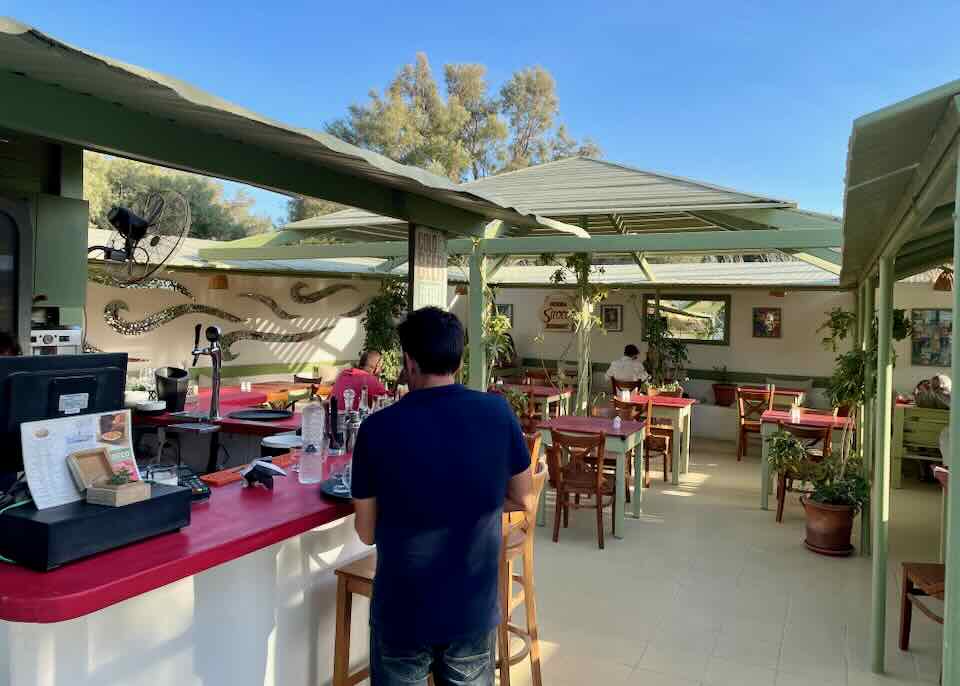
Sirocco Pizza in Perissa.

Wood fired pizza.

Delicious.

Costas, owner of Sirocco.
June 30, 2024
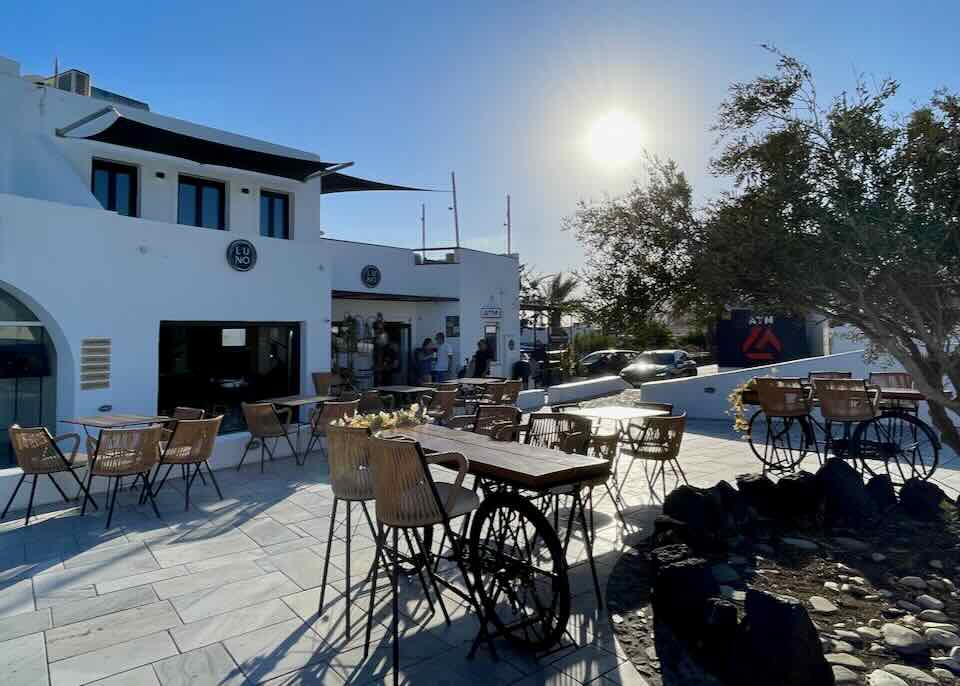
Early morning at Luno Cafe. My favorite coffee spot in Oia.
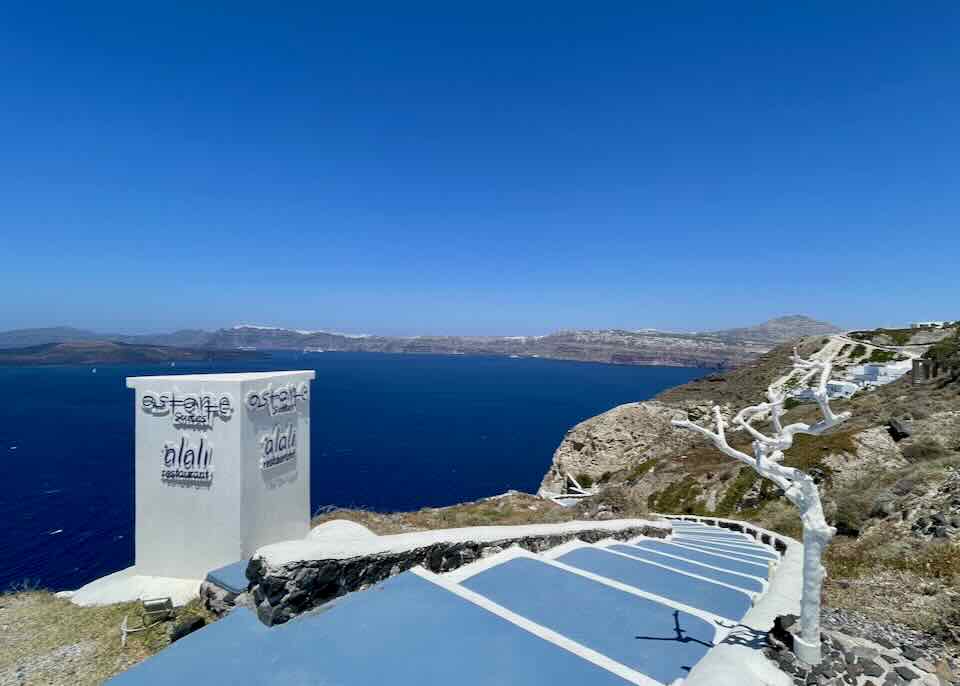
Astarte Suites near Akrotiri.
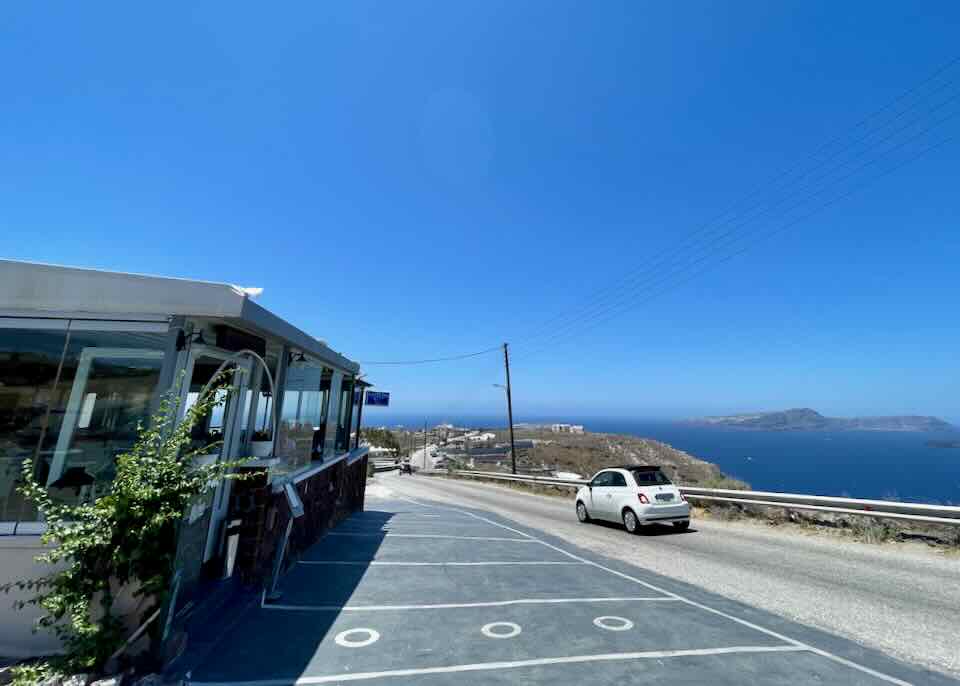
Lunch at Aeolos near Akrotiri.
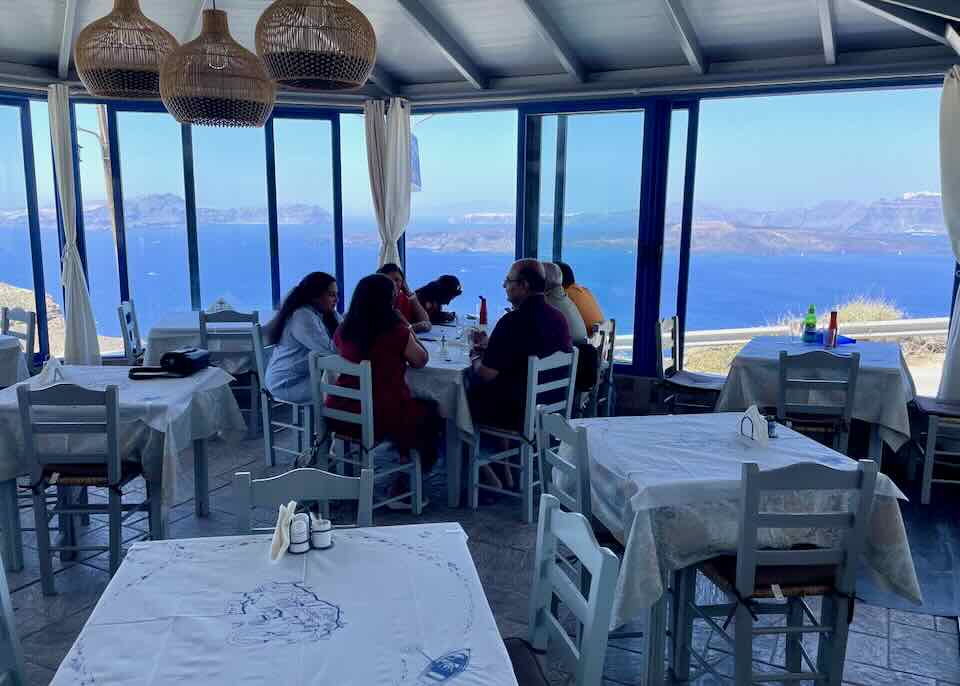
View of caldera from inside Aeolos.

Horiatiki (Greek salad) and saganaki (baked cheese).

Moussaka: A classic Greek dish made with layers of eggplant, potatoes, and ground meat, topped with bechamel sauce. So good!

Brizola (steak) with potatoes and souvlaki with potatoes.
June 29, 2024
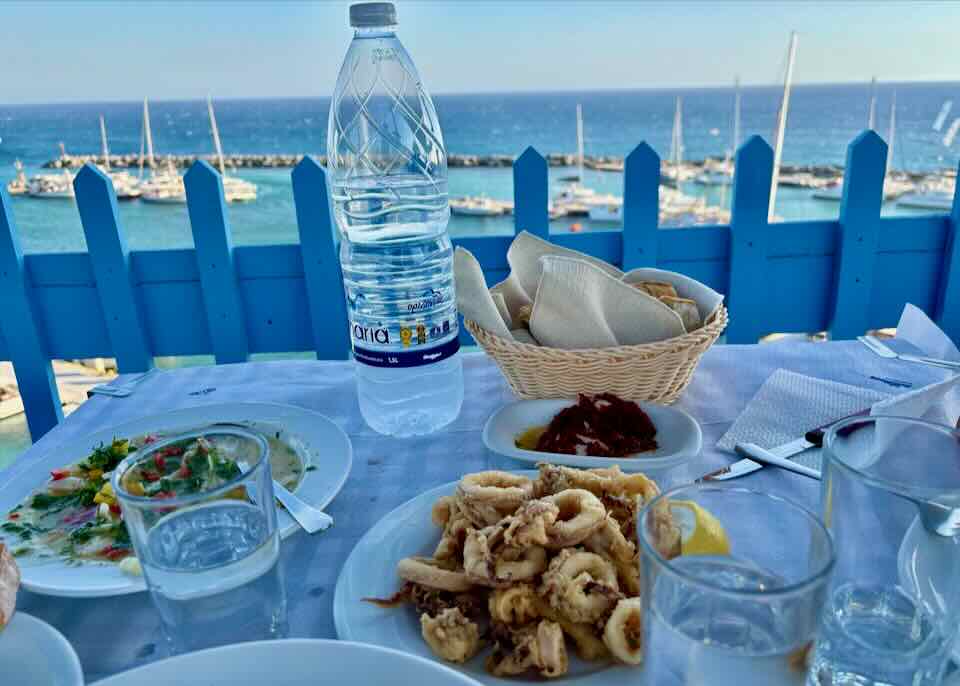
Fresh seafood with a view at To Psaraki in Vlychada.

Dish of the day: Swordfish souvlaki with potatoes.

Grilled manouri cheese with homemade pesto.
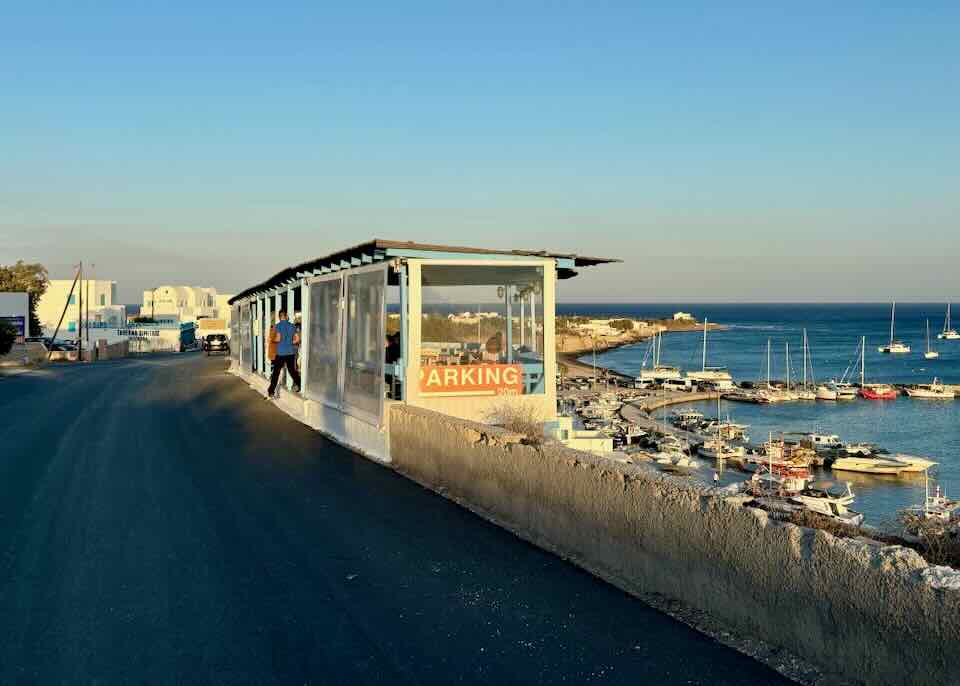
Overlooking the marina …
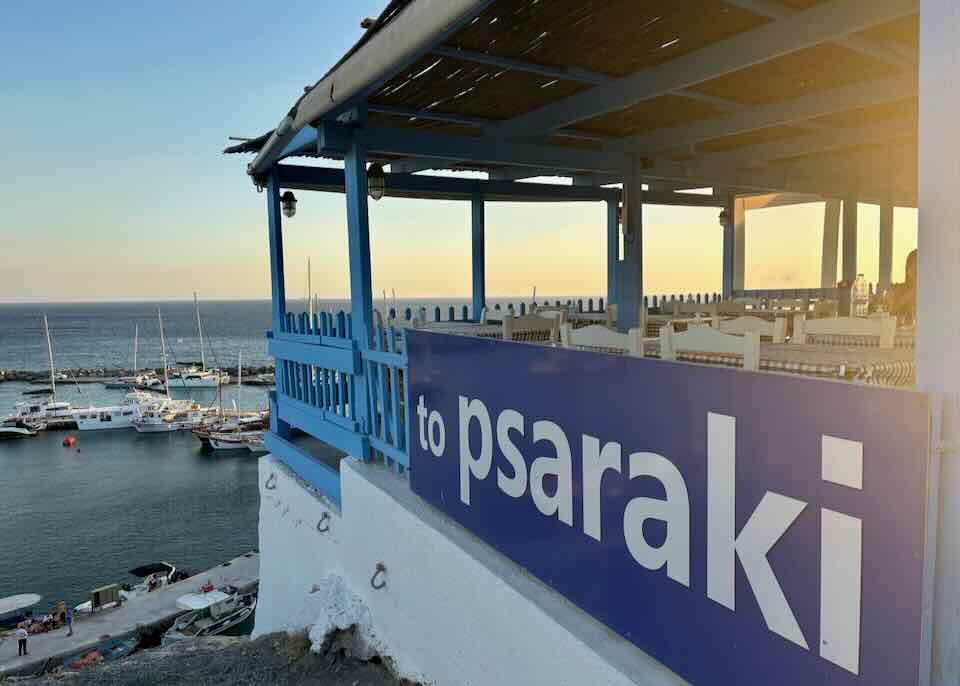
… in Vlychada.
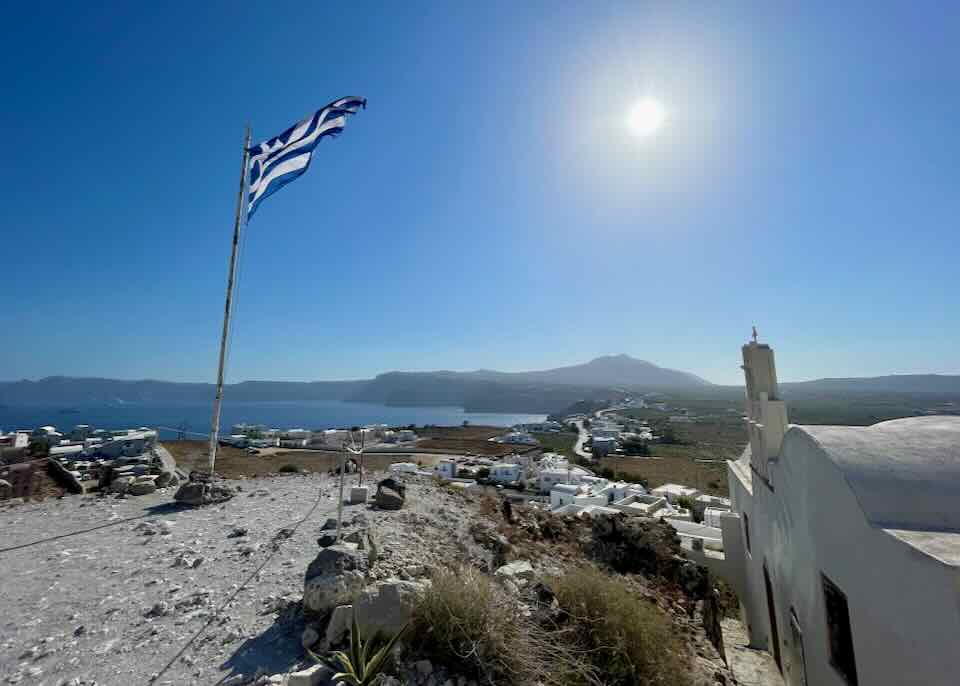
View of the island, looking north from the Venetian Castle in Akrotiri.
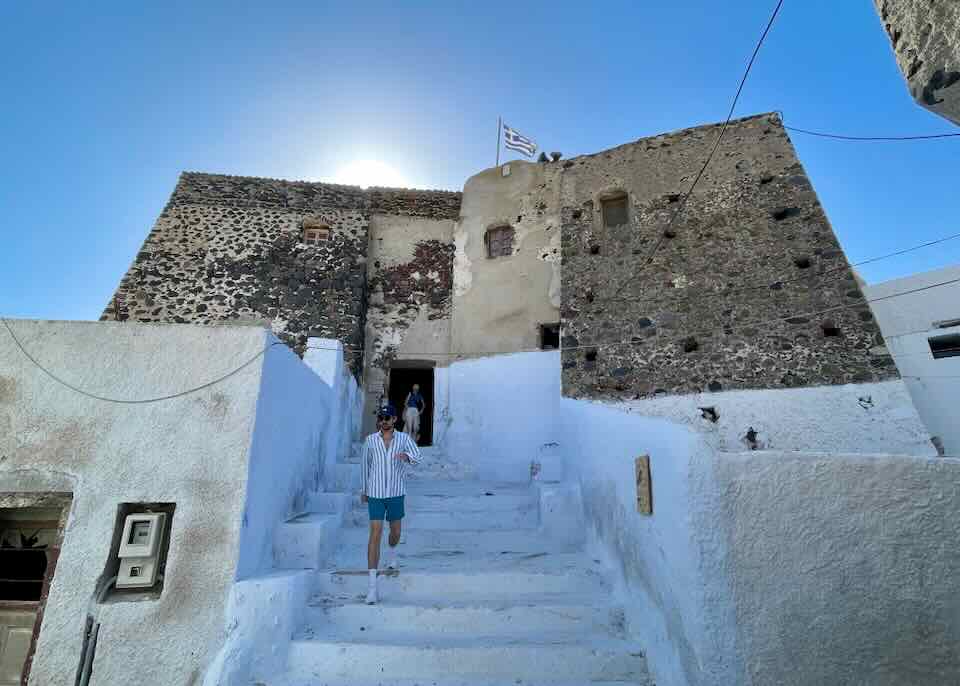
Venetian Castle.
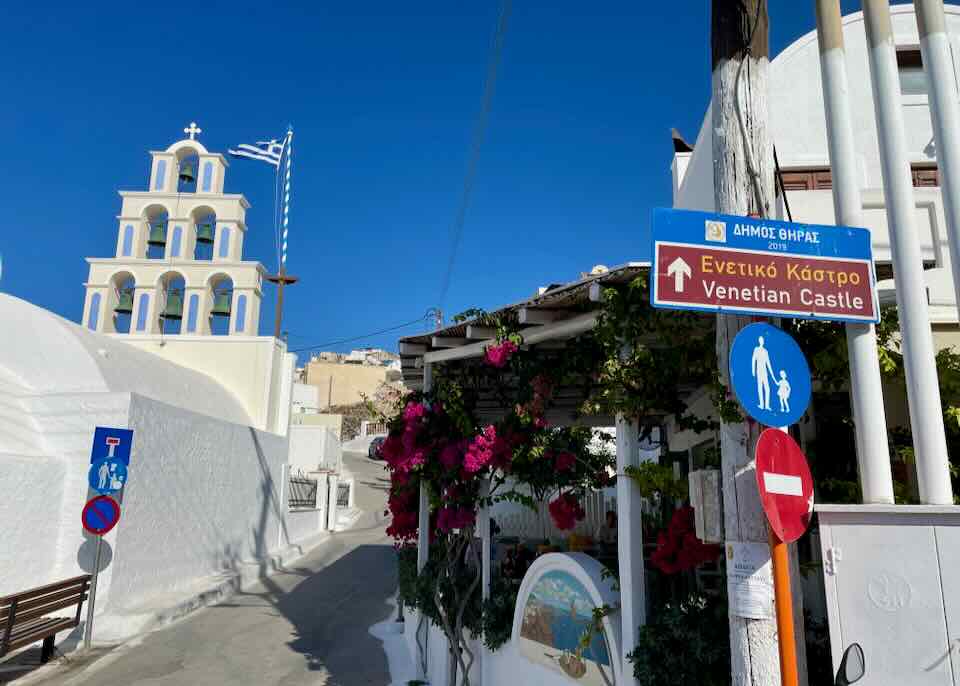
Path to the Venetian Castle.
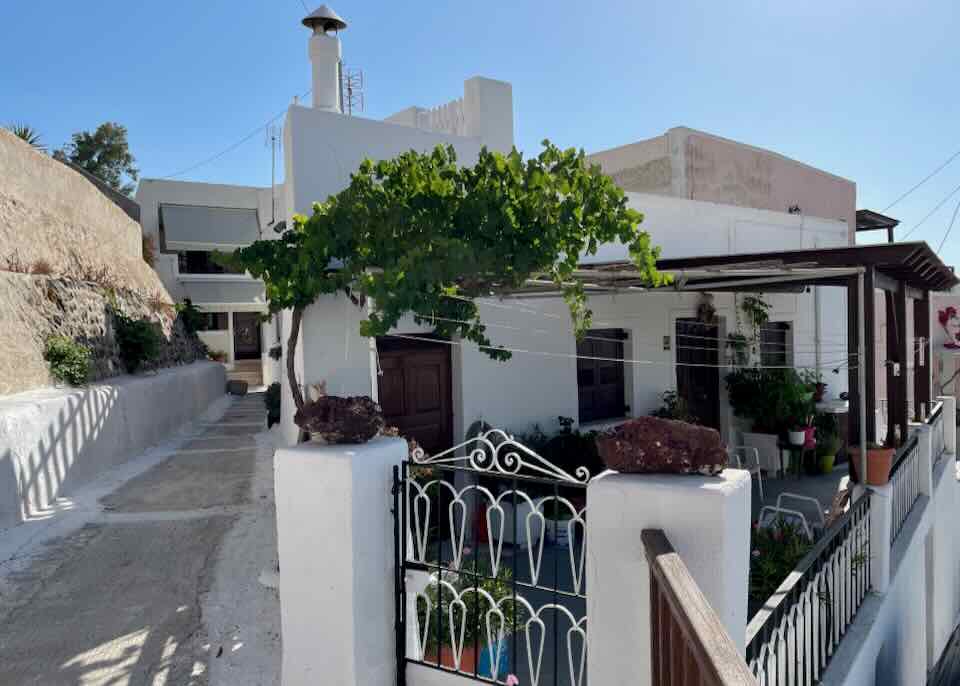
Classic local home in Akrotiri.
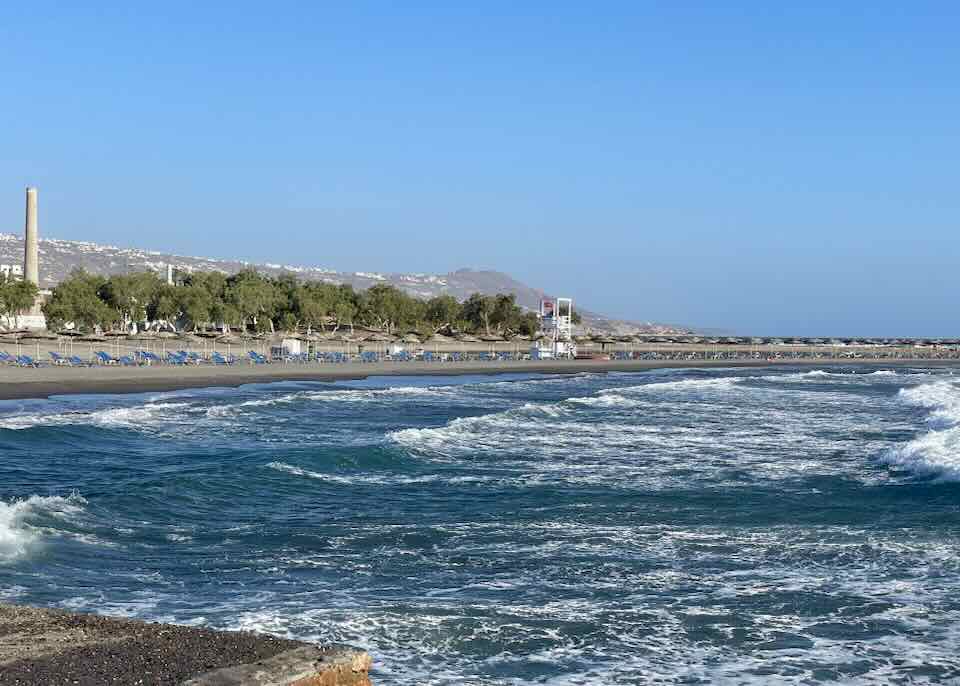
Monolithos Beach had high winds and rough waves today. It’s the most shallow beach and usually great for families with kids.
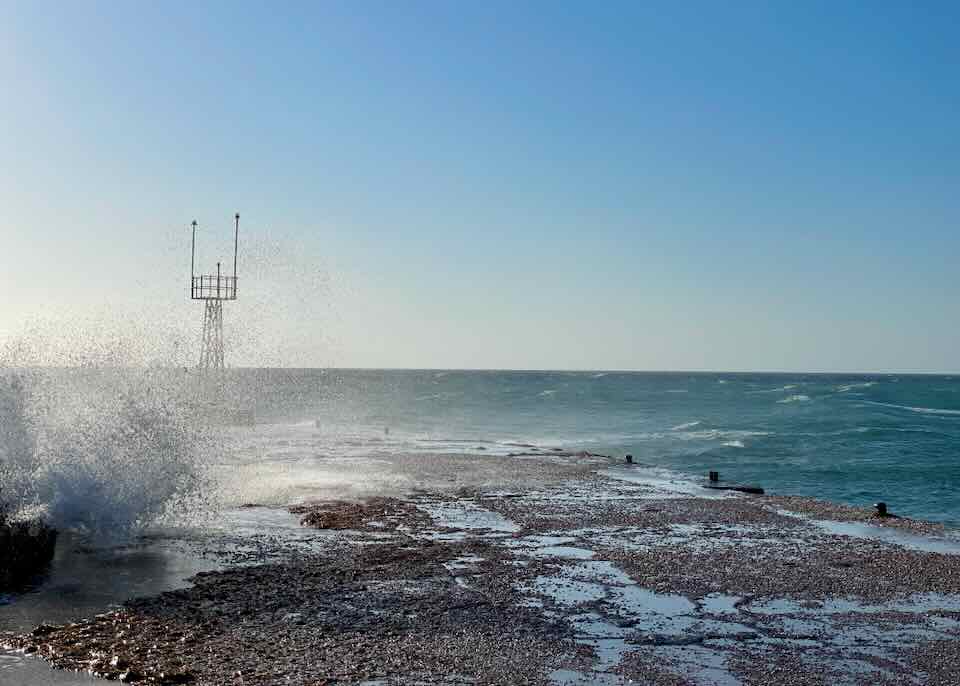
Waves hitting the shore in Monolithos. Some ferries were cancelled today due to rough seas.
June 28, 2024
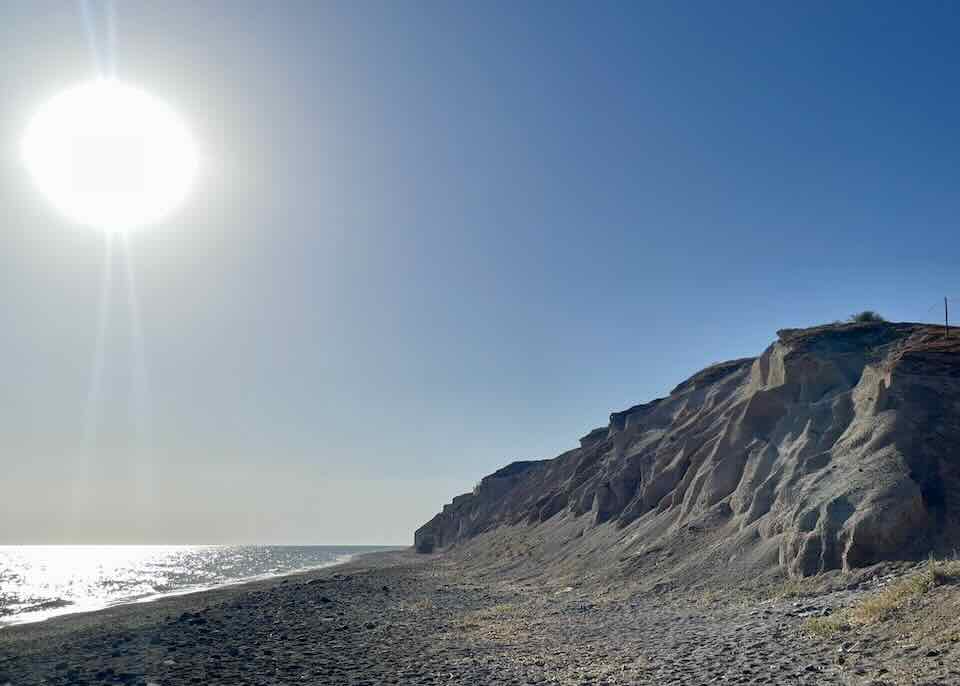
Baxedes beach near Oia.
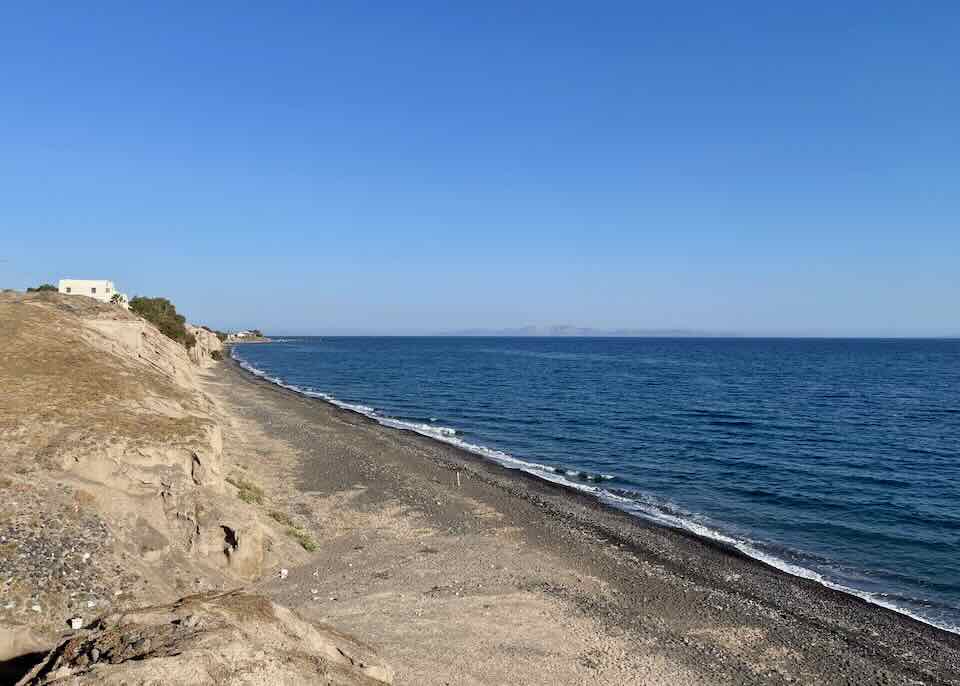
Baxedes beach.
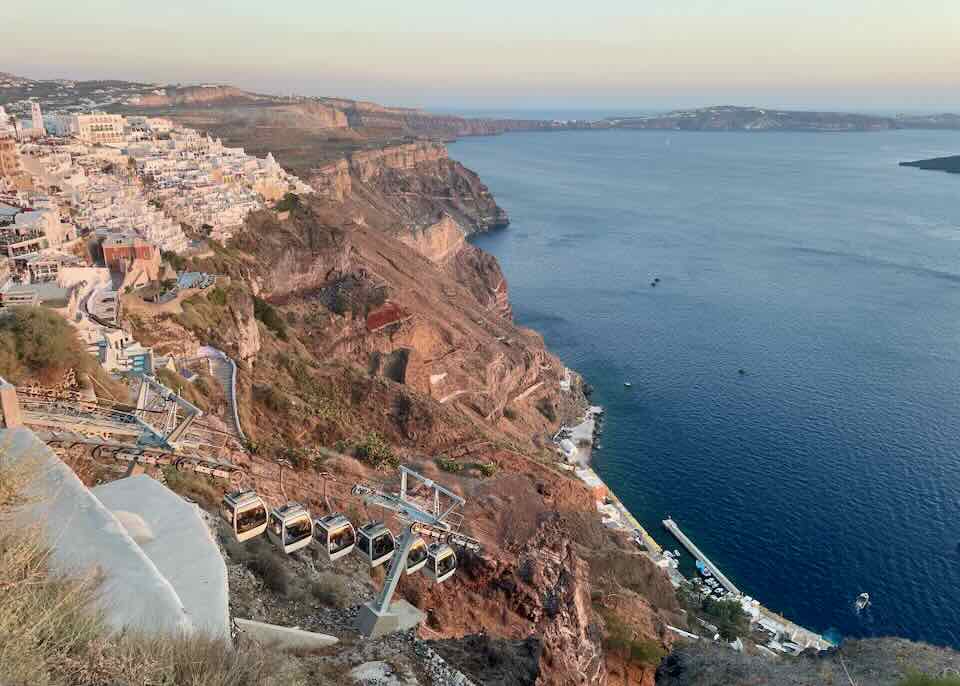
Cable car running from Fira to the Old Port (Skala Pier).
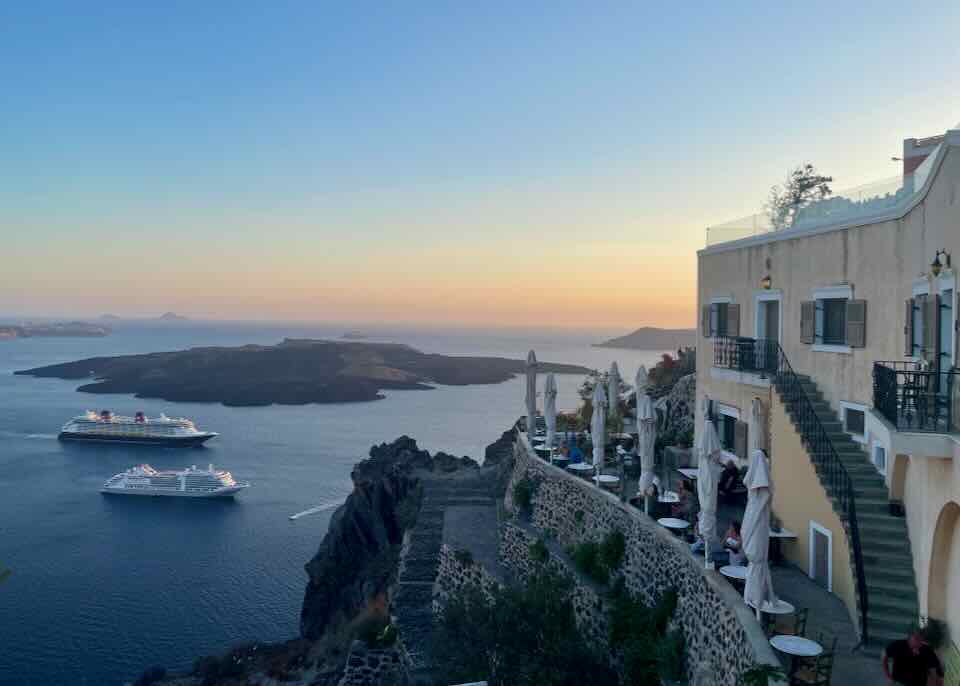
Irini’s Cafe overlooking Fira.

“Why Not?” gyro joint on the main path through Firostefani.
June 27, 2024

New Bar Volkan, located next to the Fira bus station. Offers sports viewing, starting when it gets dark.

Wedding shots in Imerovigli.
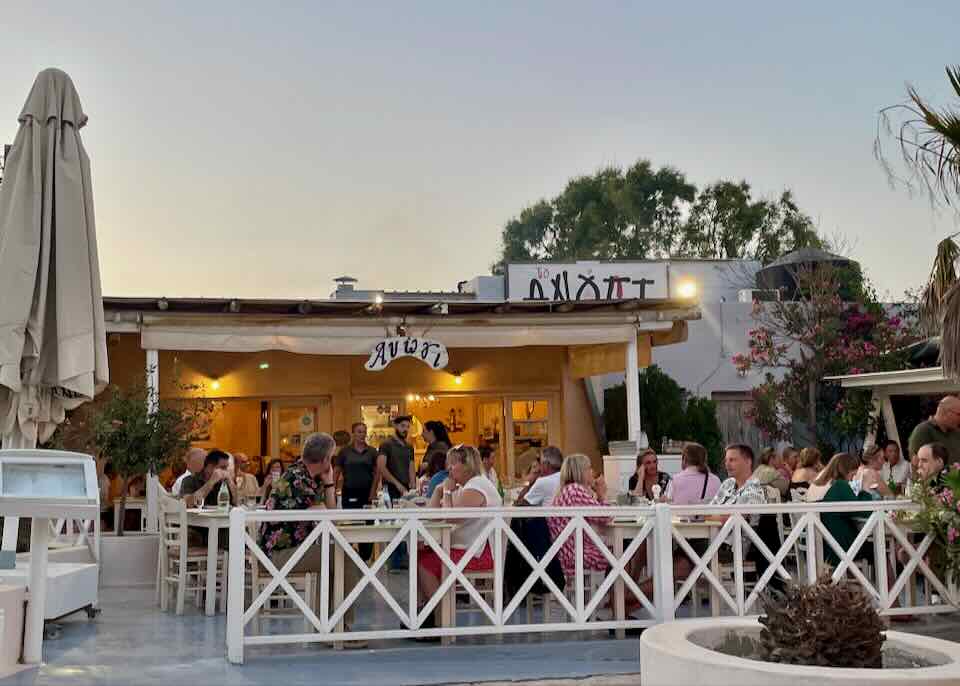
Anogi restaurant in Imerovigli. A personal favorite.
June 26, 2024
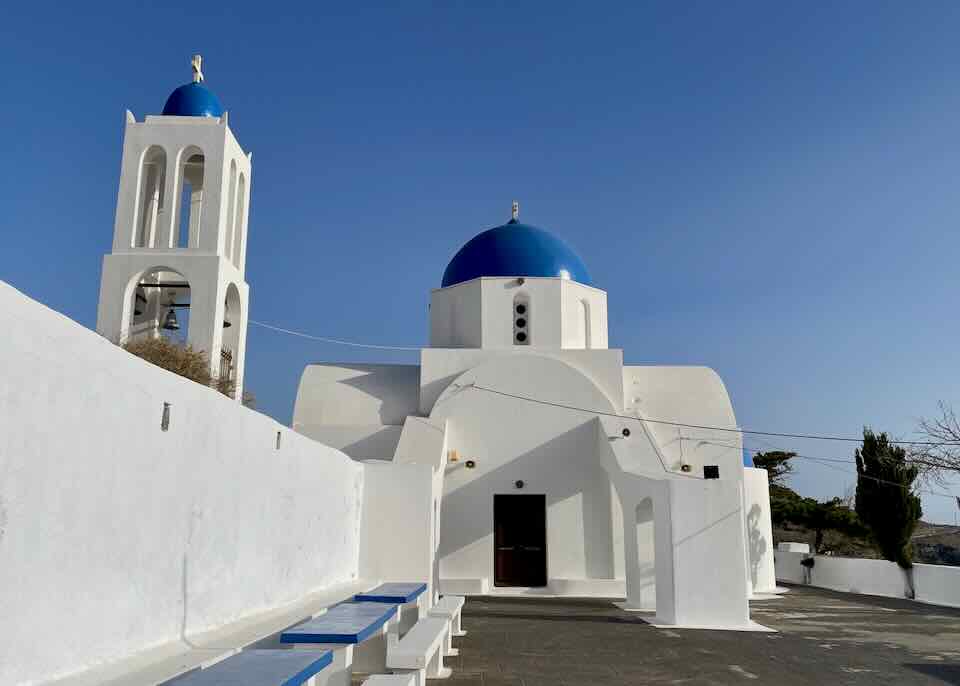
Saint George Ksexreotis Holy Orthodox Church near Vourvoulos. Built in 1750.
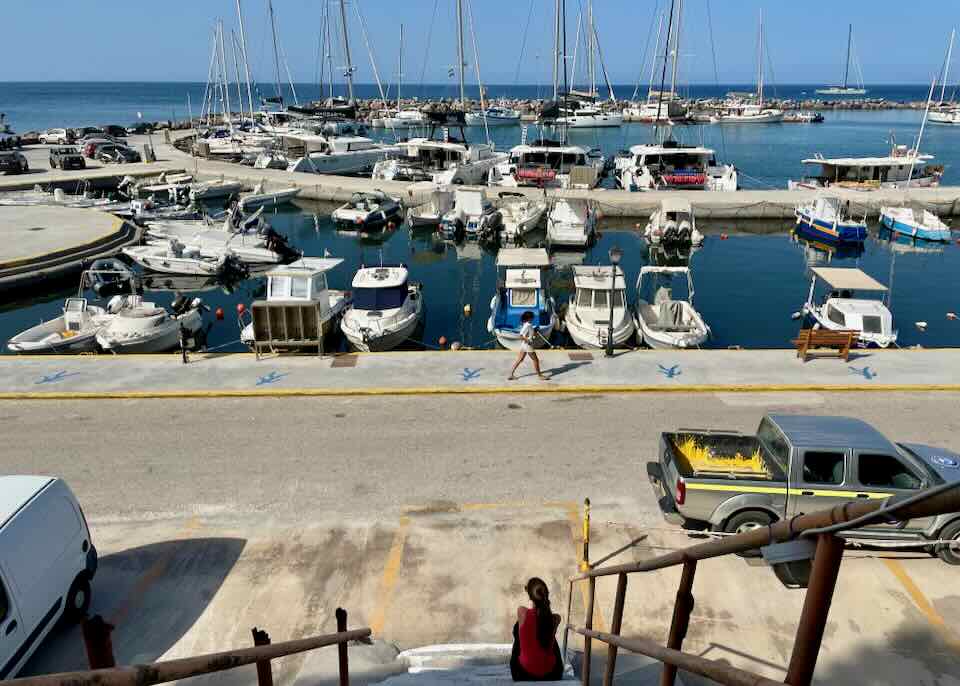
Vlychada marina.
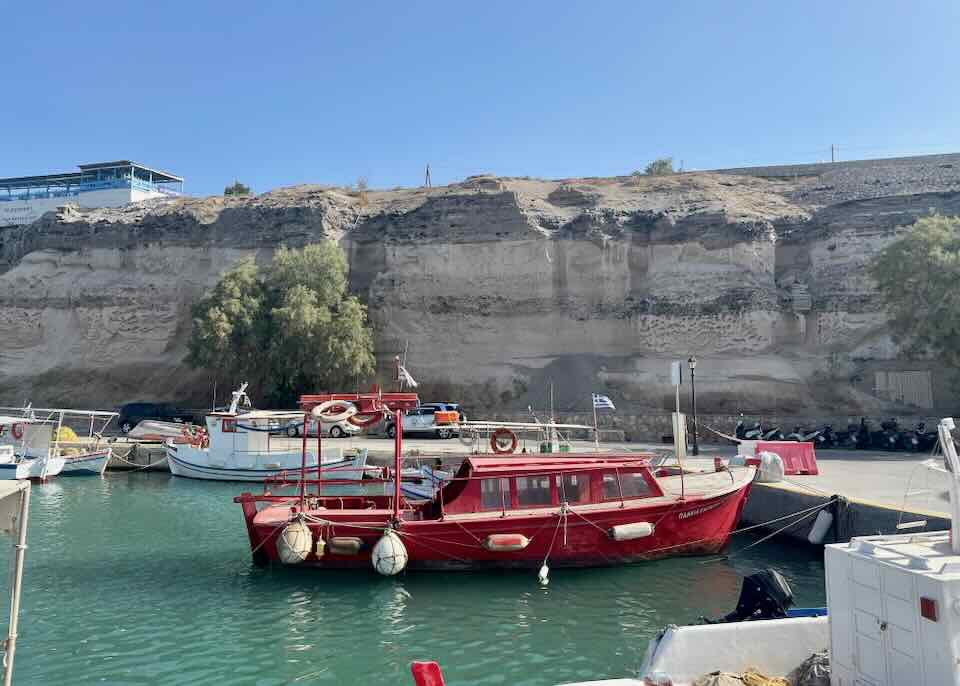
Vlychada marina with To Psaraki restaurant on the cliff above. (Great food.)

Santorini Brewing Company in Mesa Gonia.
June 25, 2024

Oia.
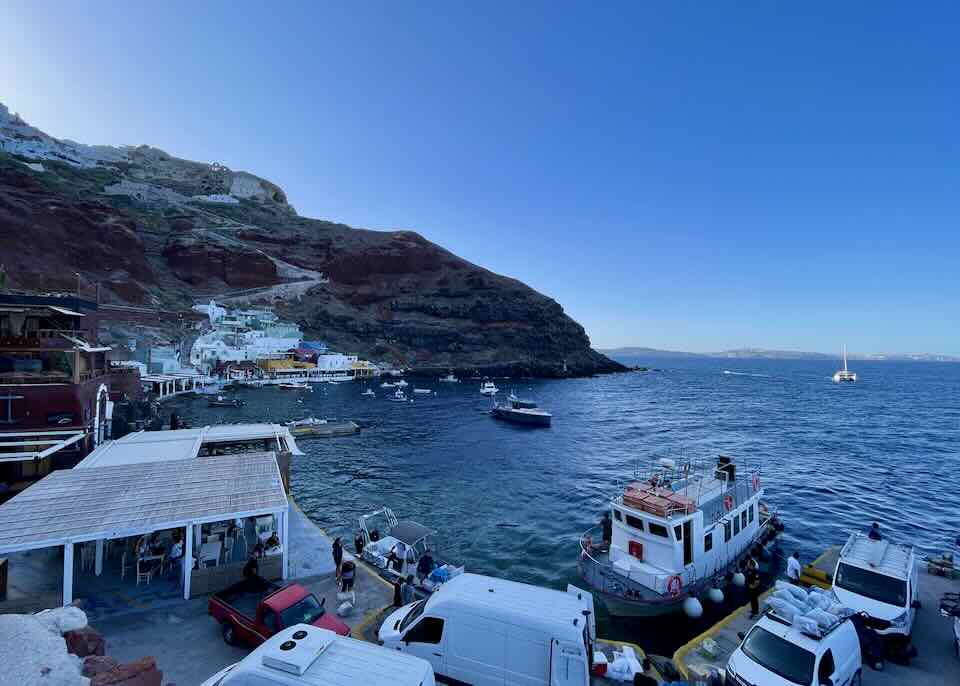
The Ammoudi Bay port busy with deliveries and the morning ferry to Thirassia (daily departures at 8:00 AM, 12:30 PM, and 5:20 PM).

Even early morning can be busy in Oia.
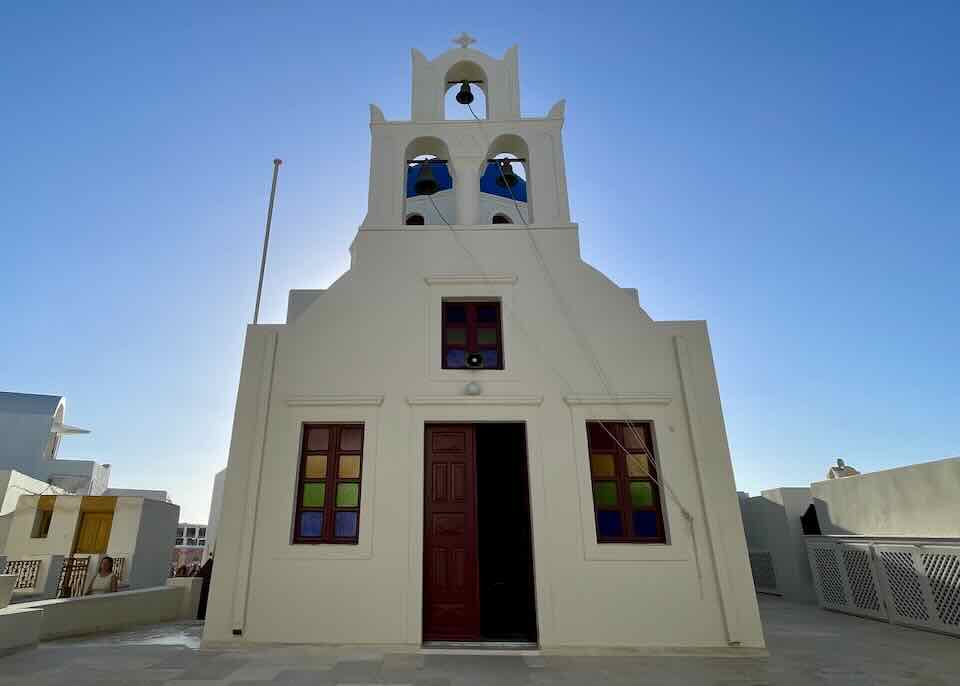
Staurós Church in Oia.
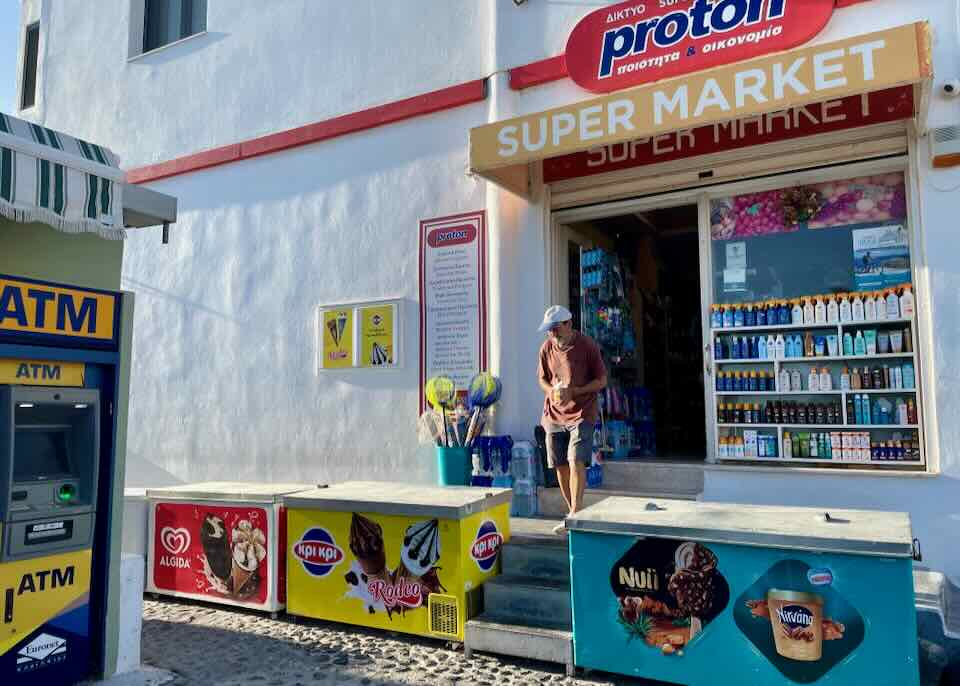
Proton Minimarket in Oia. Open 7 AM to 1 PM.

A couple of tourists at the Milopetra bakery in Fira.

Locals picking cherry tomatoes.
June 24, 2024
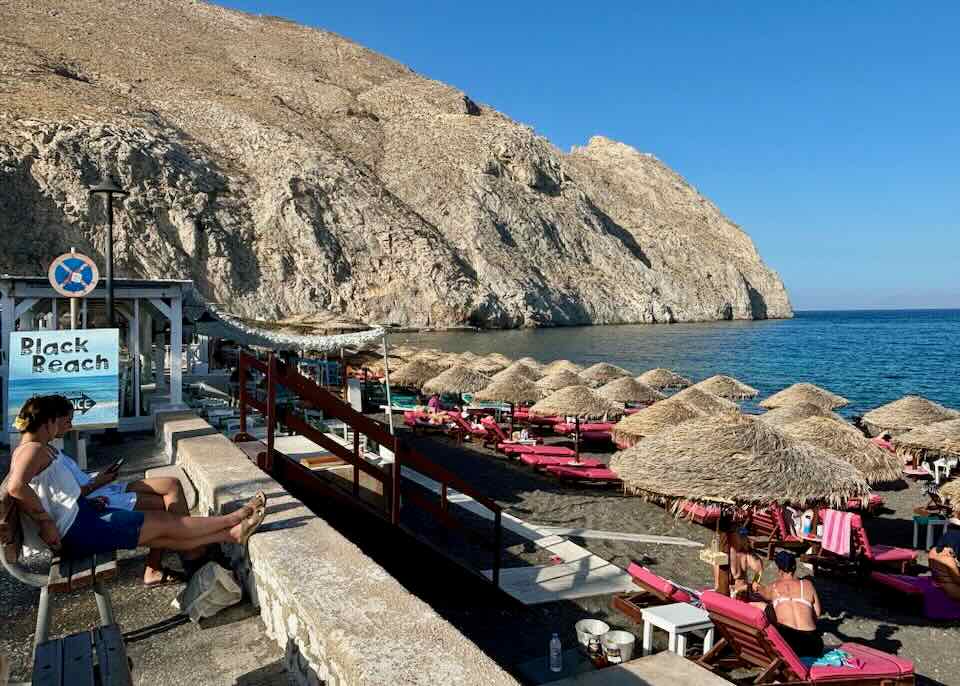
Perissa Beach.
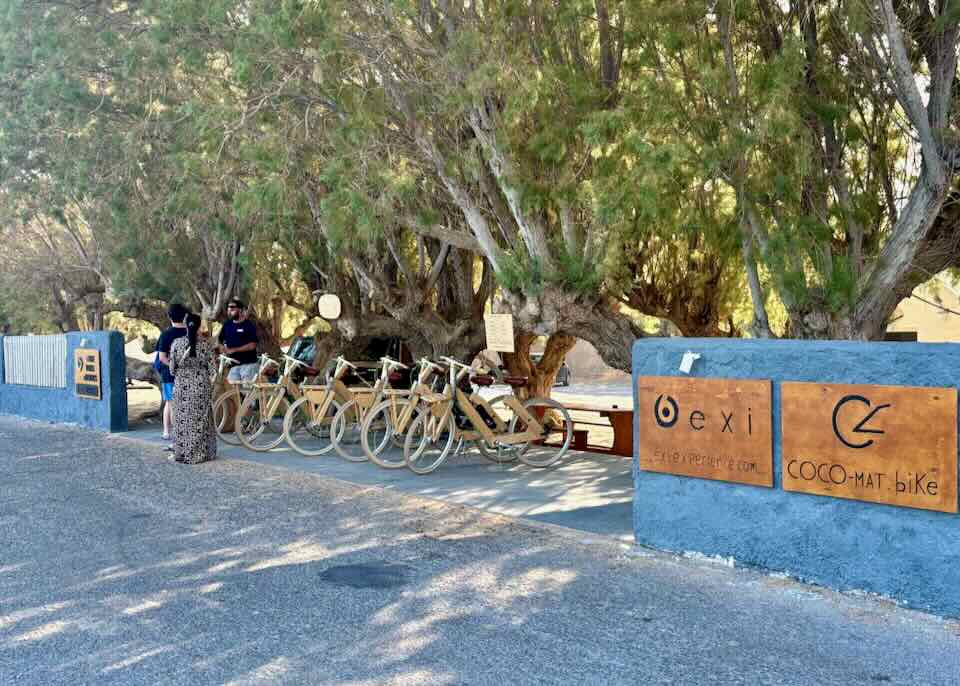
Bikes to rent at Perissa Beach from Exi Experiences.
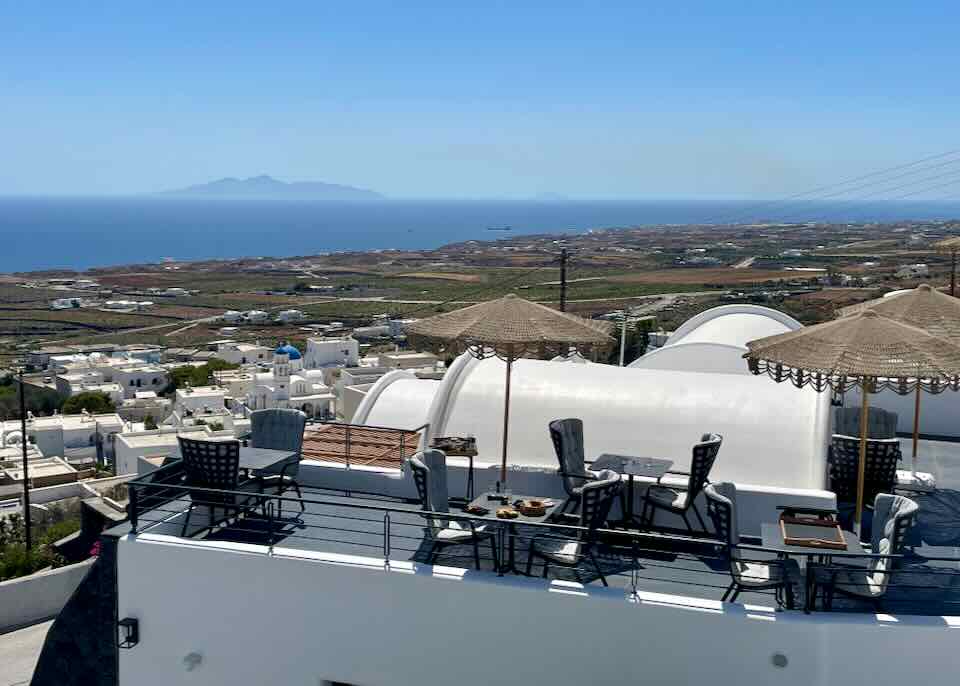
Venus Sunrise Suites & Villas in Vourvoulos Village. This is the quiet side of the island and not on the caldera. Sunrise views instead of sunset.
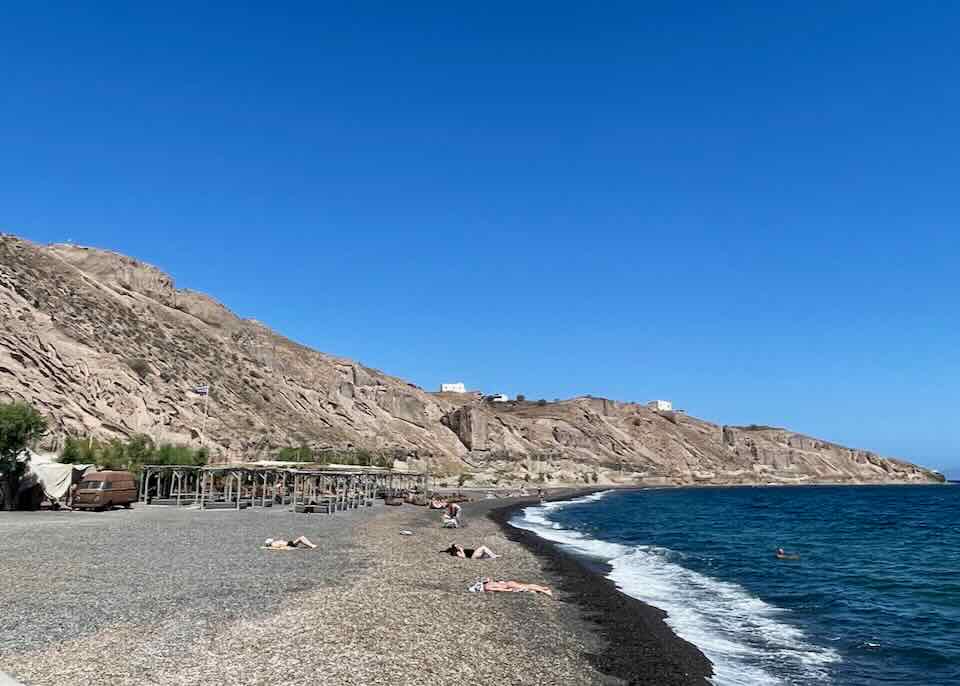
Paralia Agios Nikolaos, next to Exo Gialos harbor.
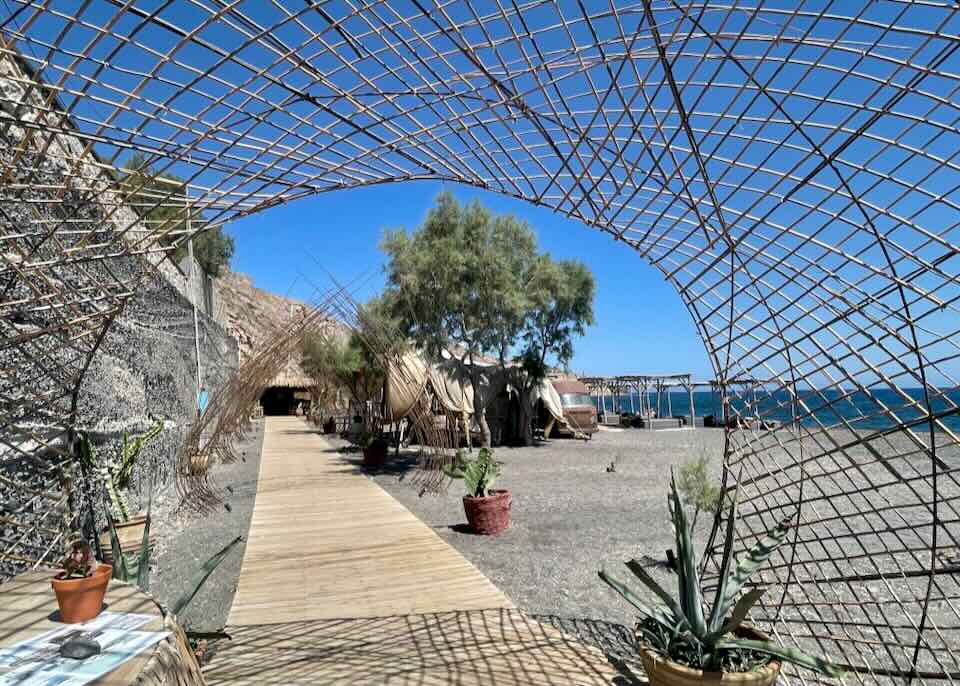
Yalos in Exo Gialos. One of our favorite beach restaurants in Santorini. Delicious!
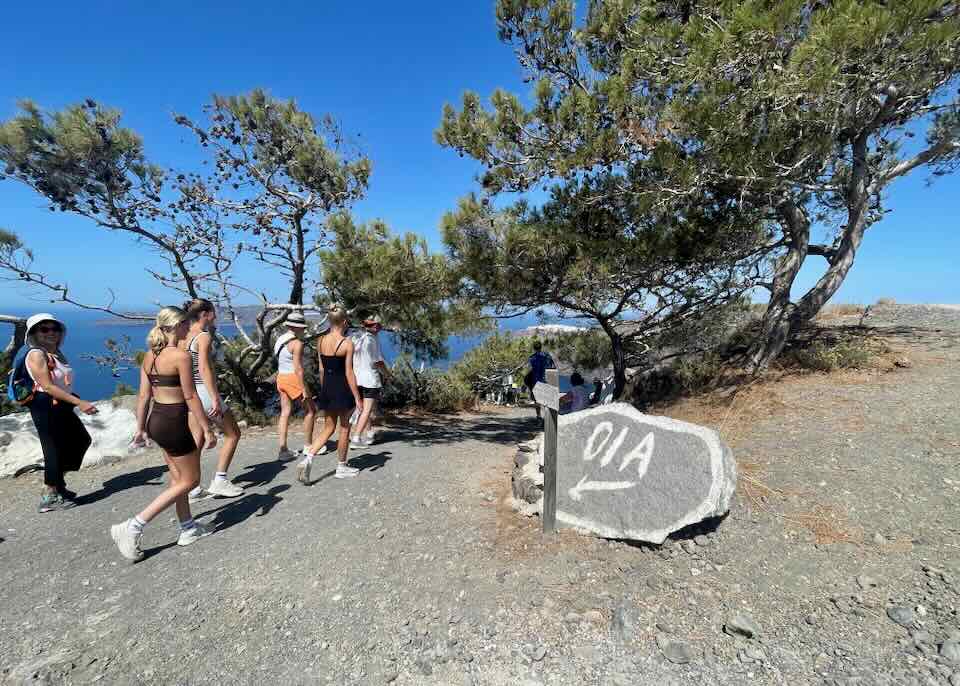
Walkers on the Fira-Oia path.
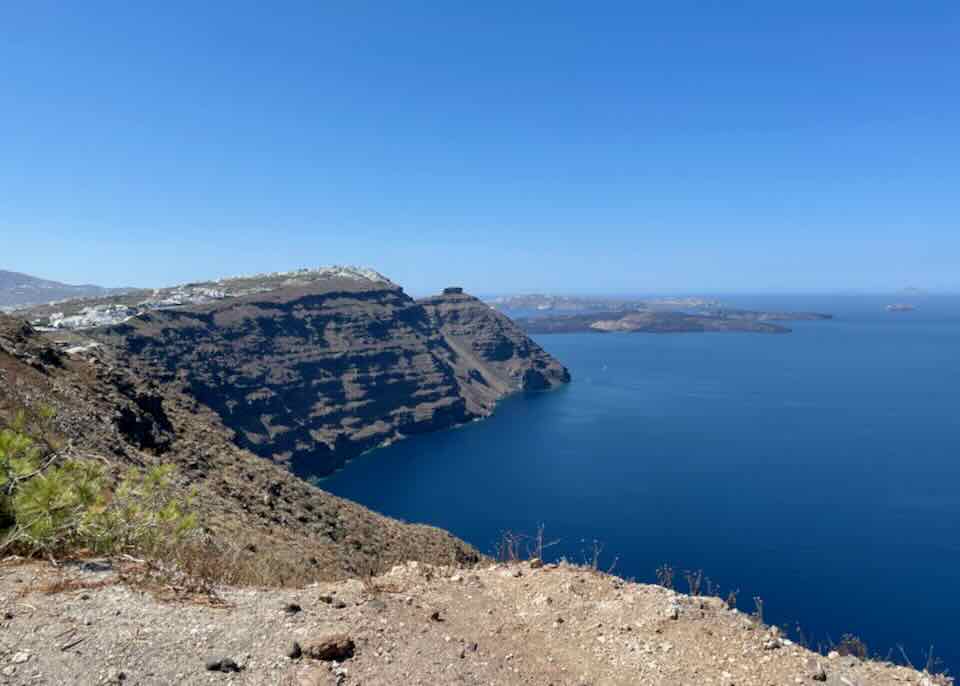
A view of Skaros Rock and the caldera on the path between Imerovigli and Oia.
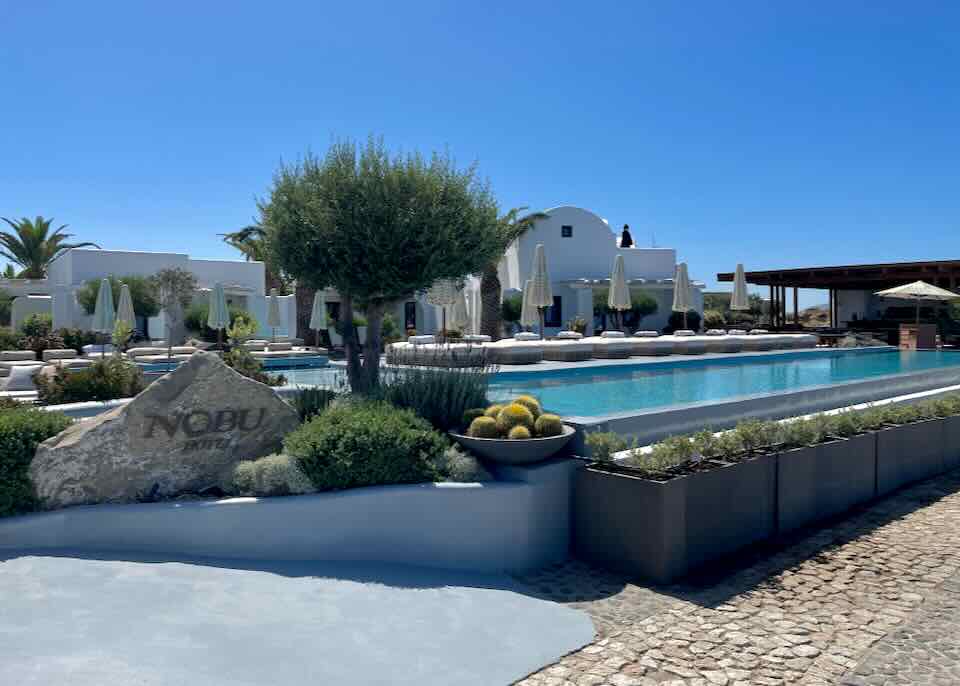
Nobu Hotel in Imerovigli, directly on the hiking path.
June 23, 2024
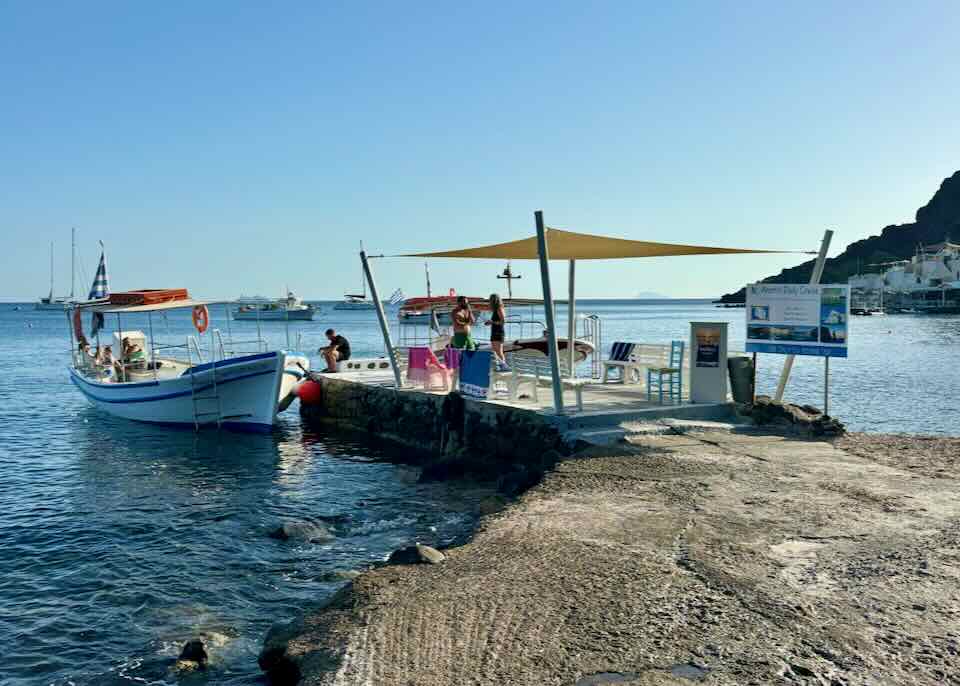
Akrotiri pier where daily boat trips to Red Beach and White Beach depart from.
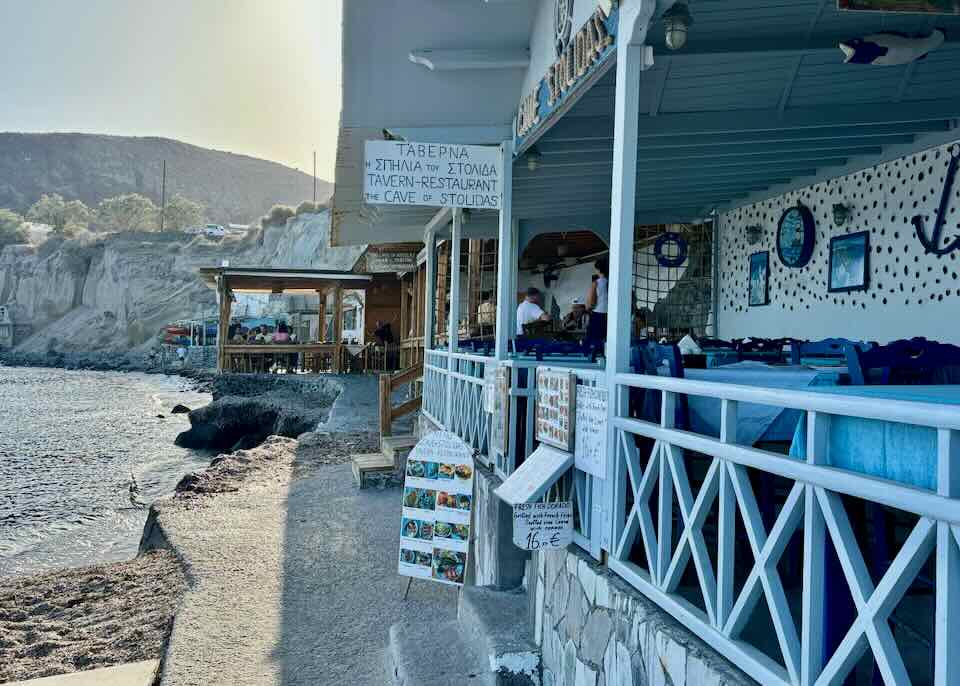
Water side taverns on the beach of Akrotiri – Cave of Stolida and Cave of Nikolas.
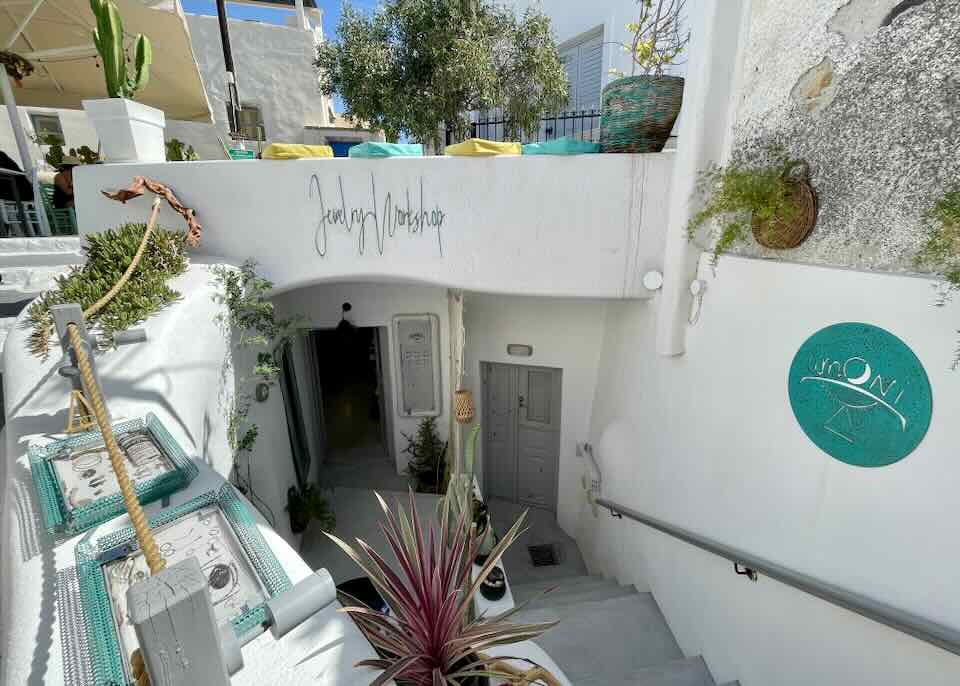
Amoni Jewelry Workshop in Emporio Kastelli.

Owned and operated by Angeliki Katsira. Handmade and custom-made jewelry.
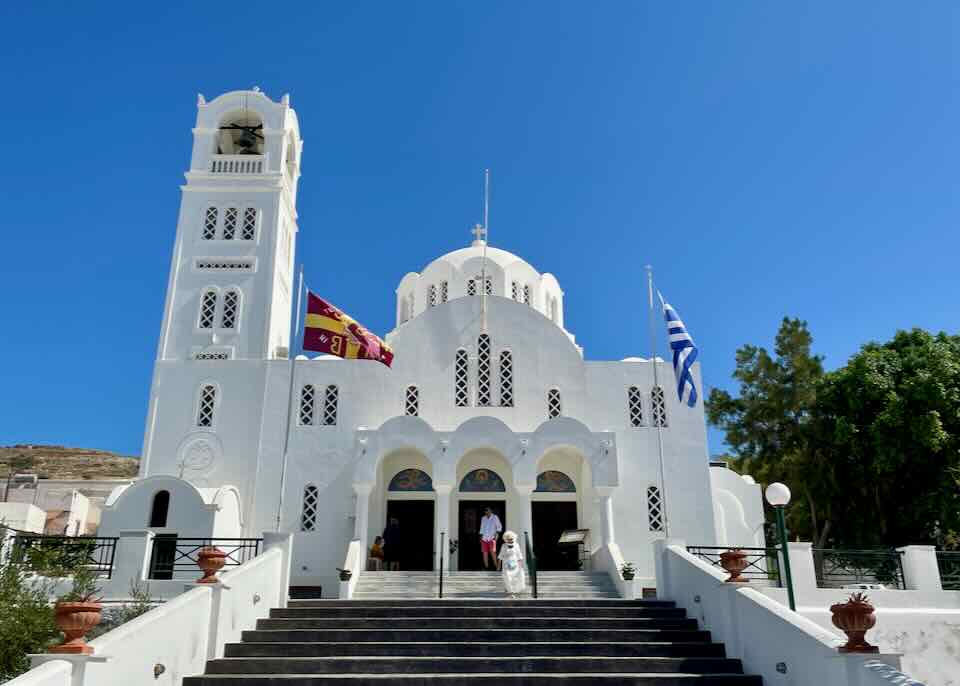
Sunday Mass at the Panagia Mesani Church in Emporio.
June 22, 2024
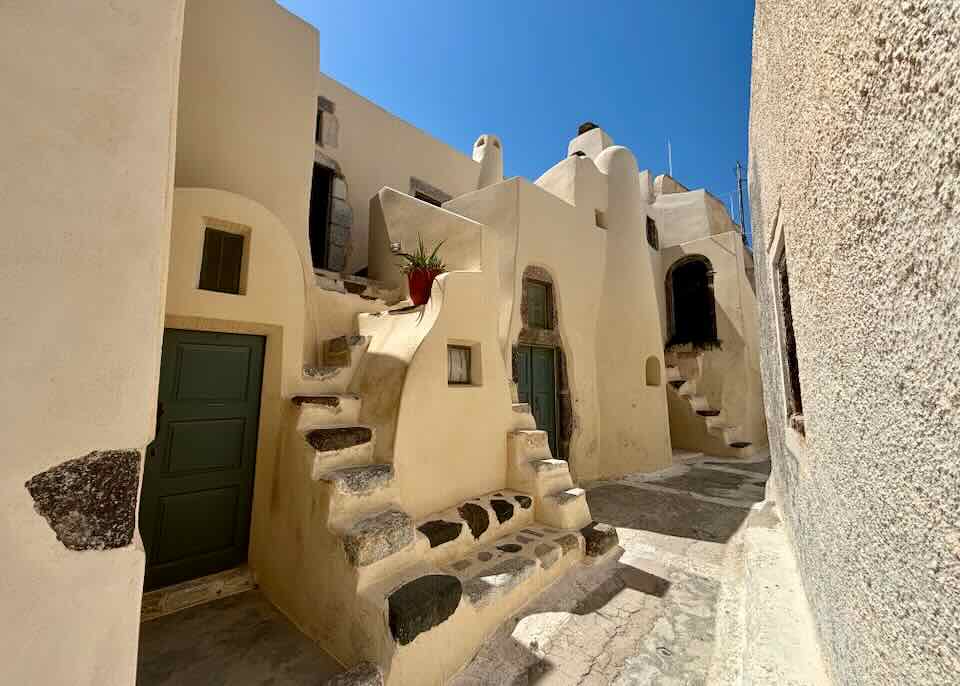
Traditional houses in Emporio.
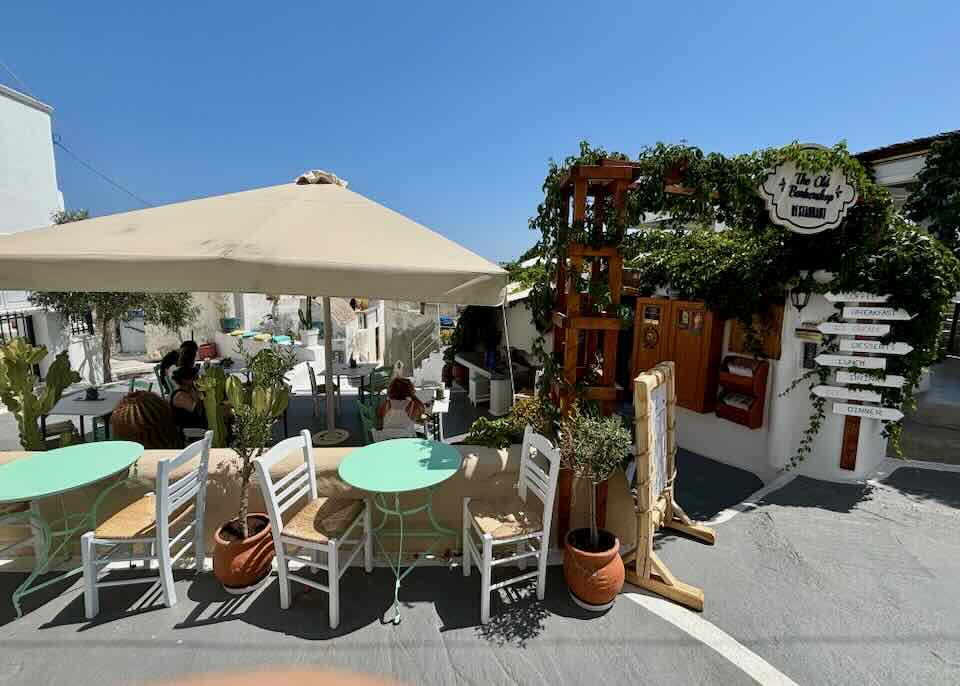
The Old Barbershop kafeneio inside the Kastelli of Emporio

Agios Charalambos Church in Exo Gonia.

Leather shoes, wallets, and belts at Kamari Sandal Workshop.

A three-generation family business run by Georgos Vlachos.
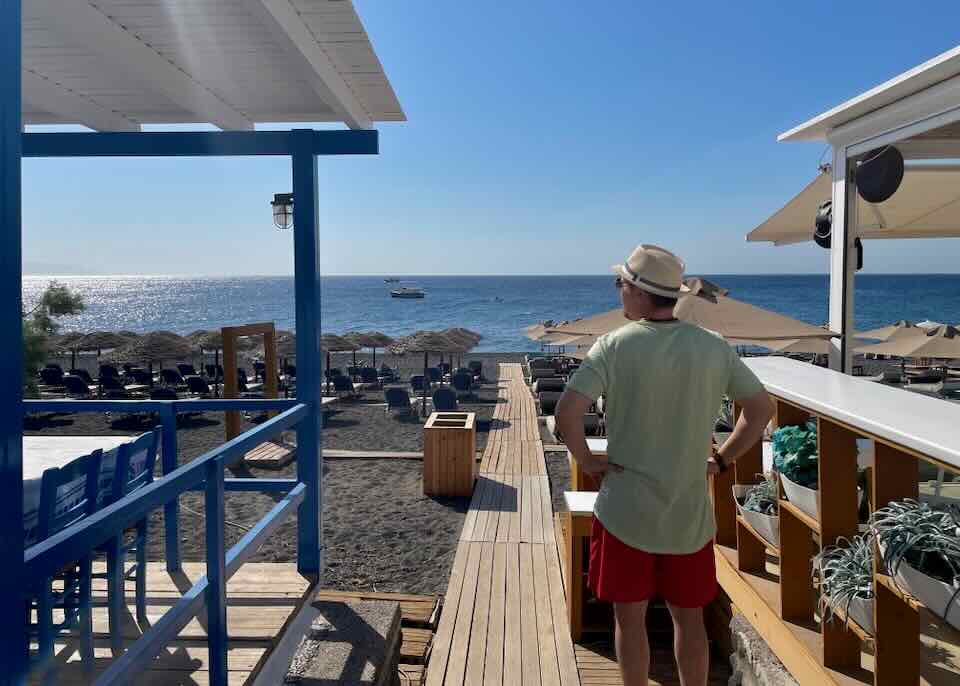
Early morning at Kamari beach.
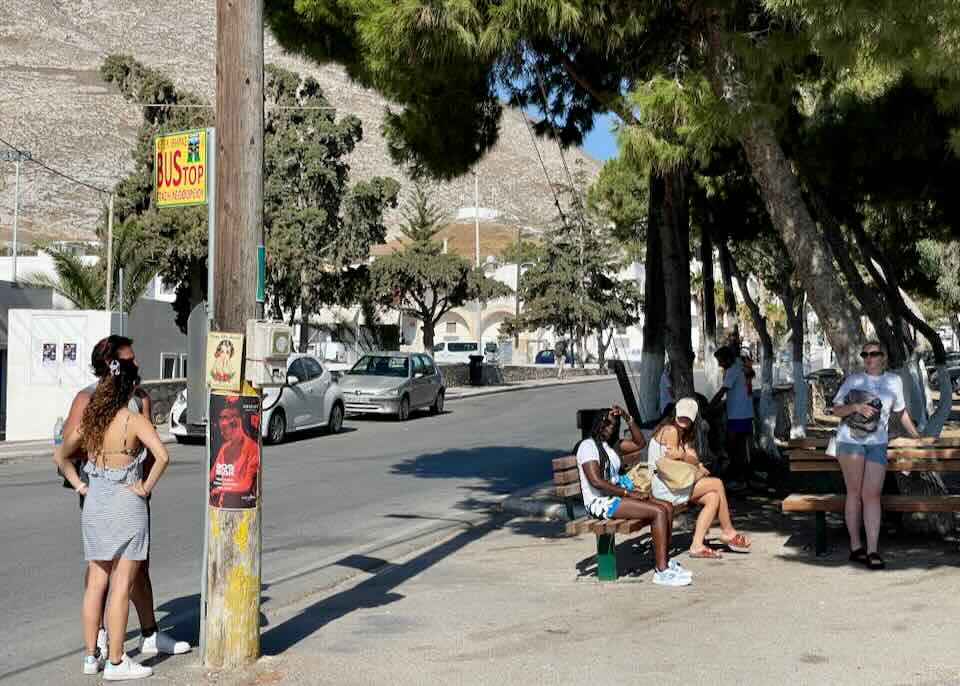
Waiting for the bus to Fira.
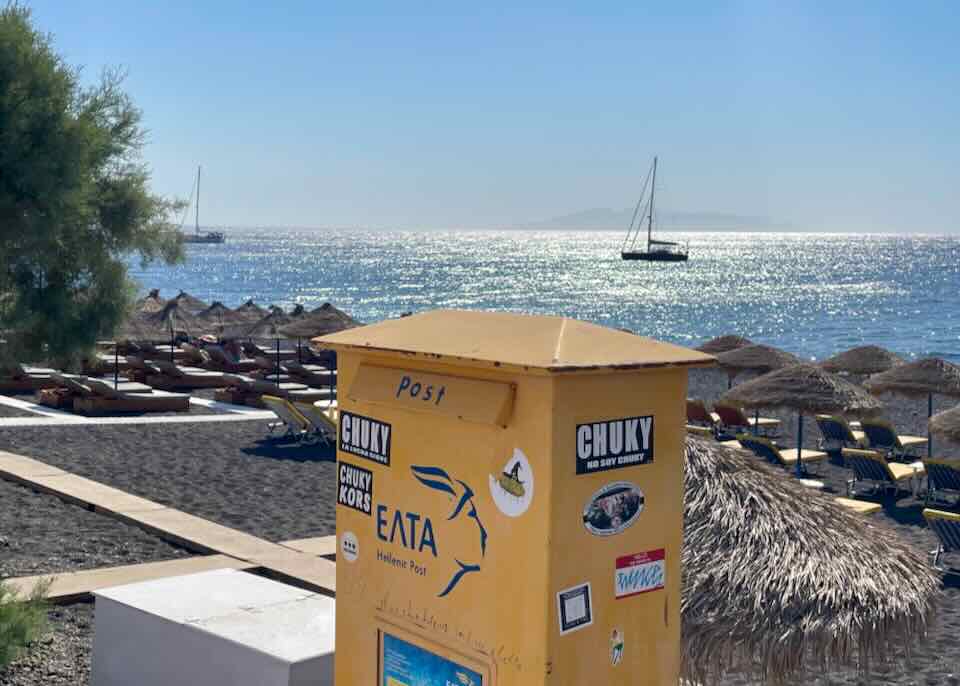
A mailbox on Kamari beach. Don’t forget to send your postcards.
June 21, 2024
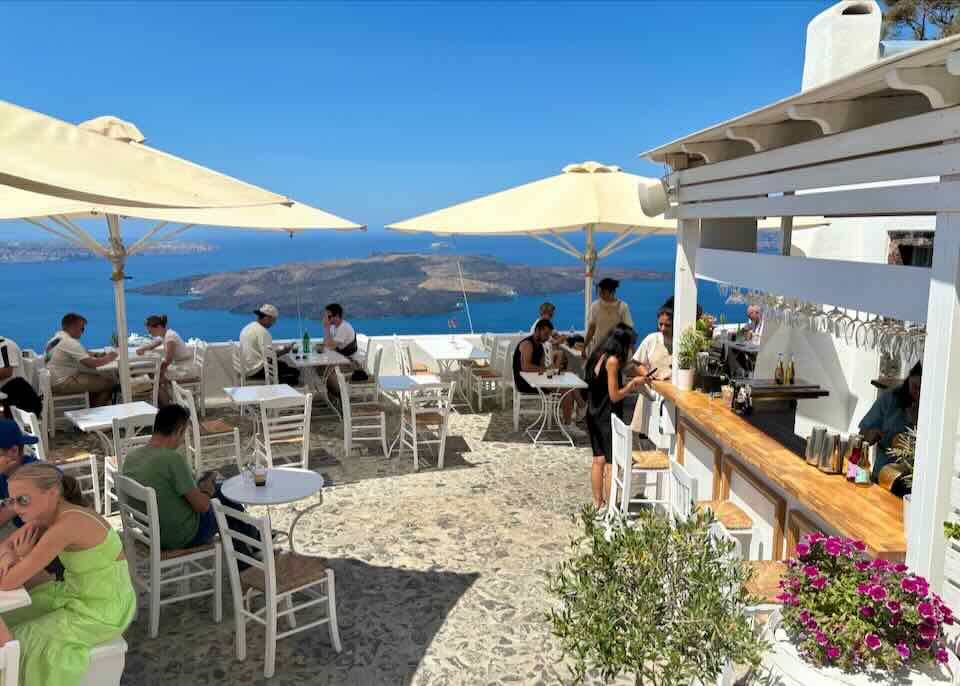
The view of the volcano from Volkan On The Rocks in Firostefani.

Volkan plays Mamma Mia every night at 9pm. (Reserve in advance.)
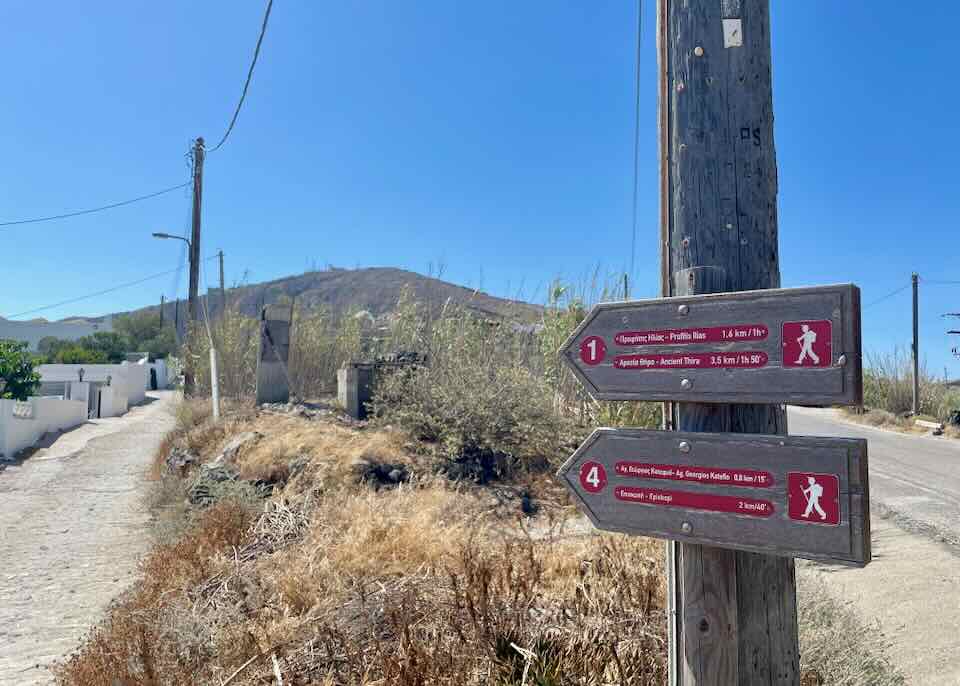
Hiking sign in Pyrgos village for the path to Profitis Ilias, Ancient Thira, and two other churches.
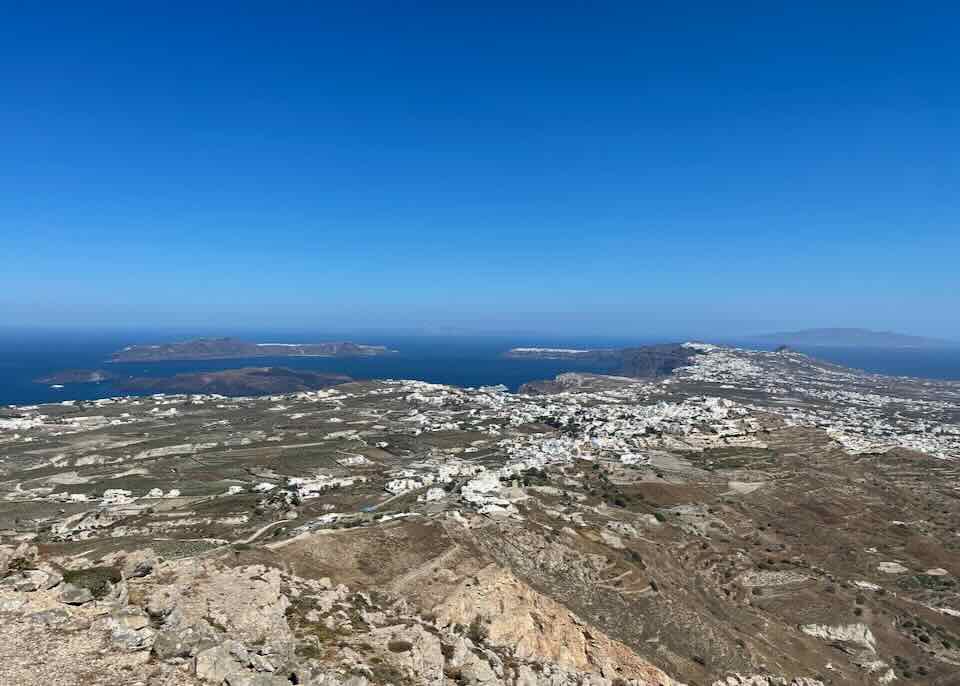
View towards Fira and Oia from Profitis Ilias.
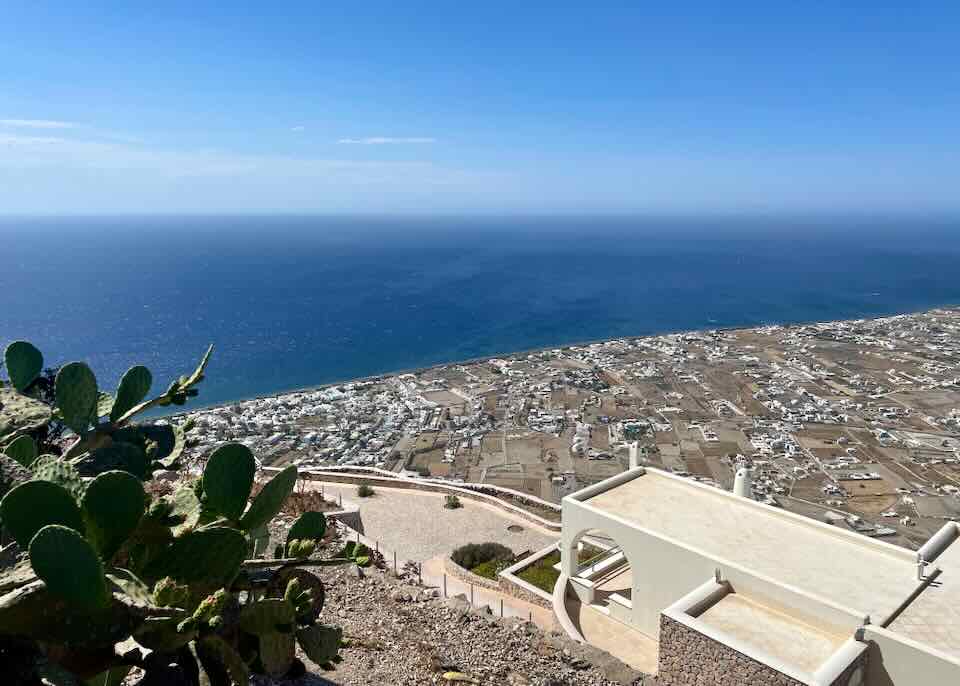
View towards Perissa from Profitis Ilias.
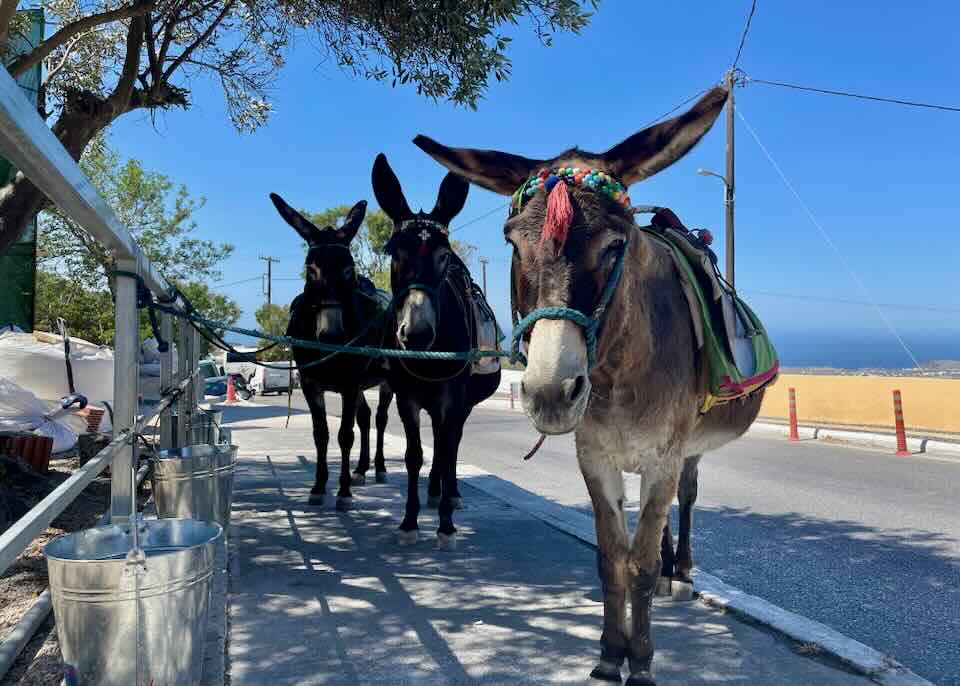
Donkeys in Pyrgos village.
June 20, 2024
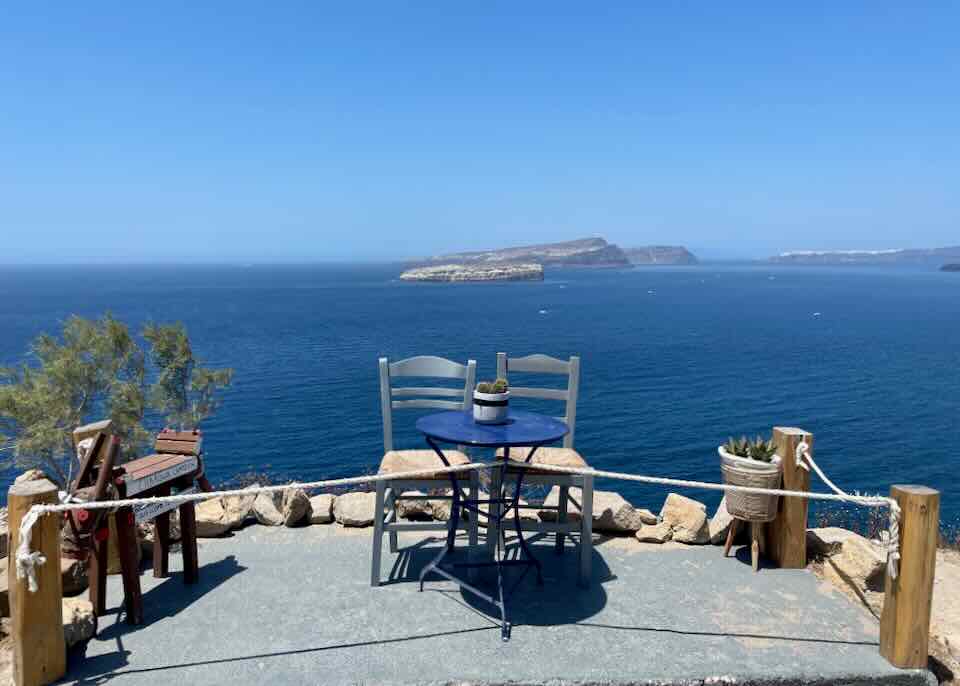
Table and chairs at Charoula Canteen near the Akrotiri Lighthouse.
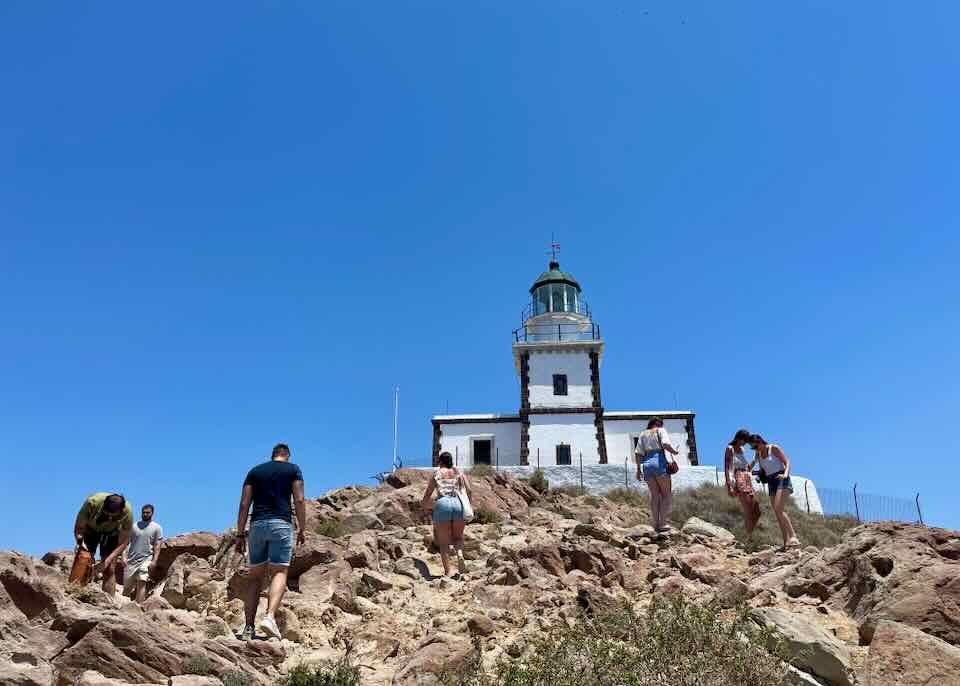
Akrotiri Lighthouse.
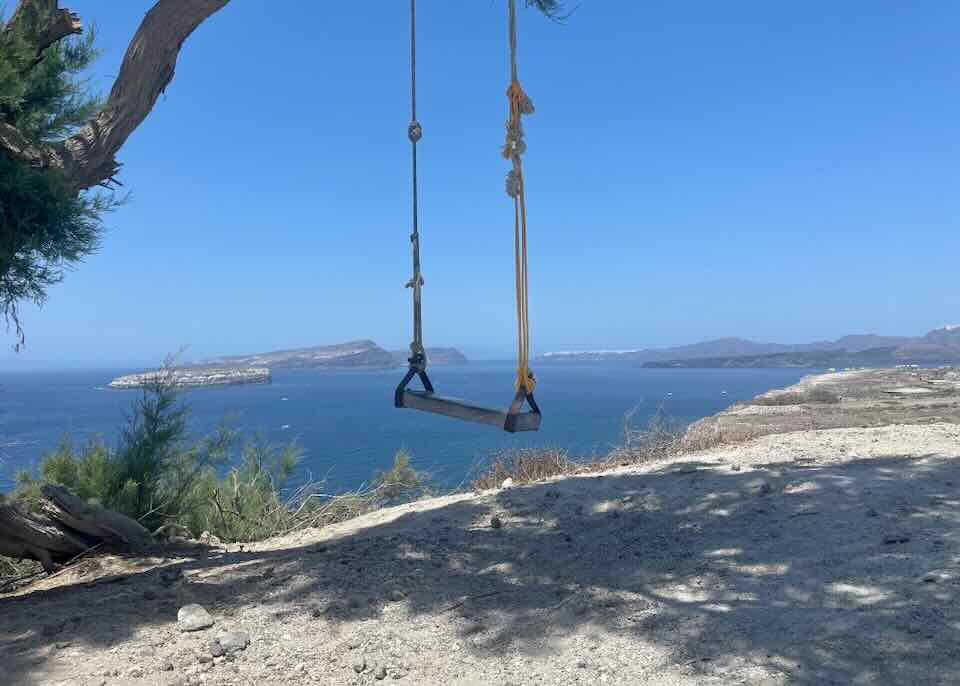
A swing with a view.
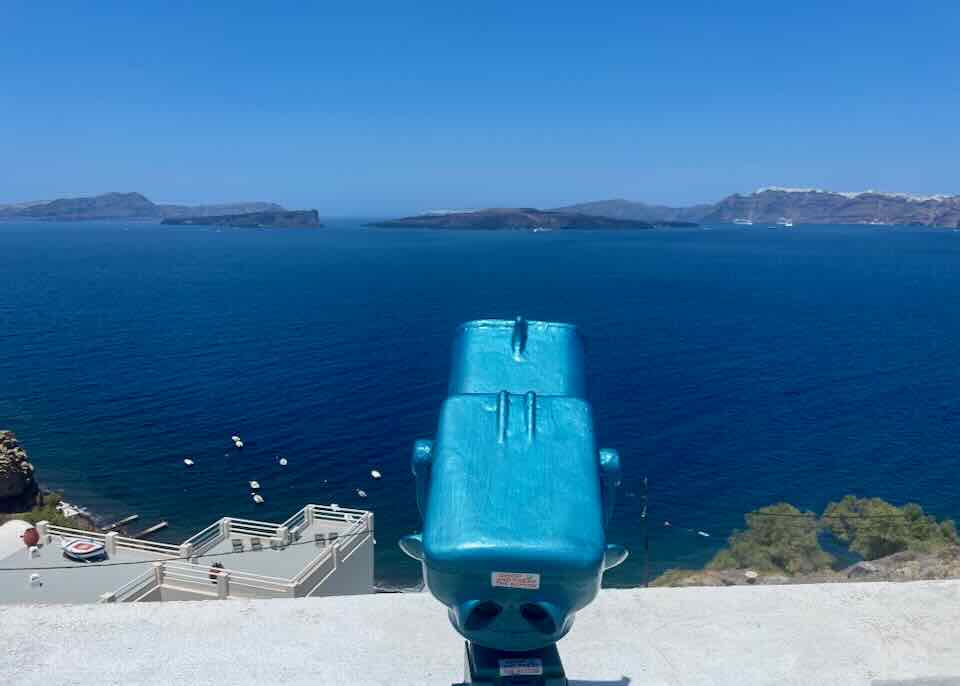
Looking north from Akrotiri into the caldera.
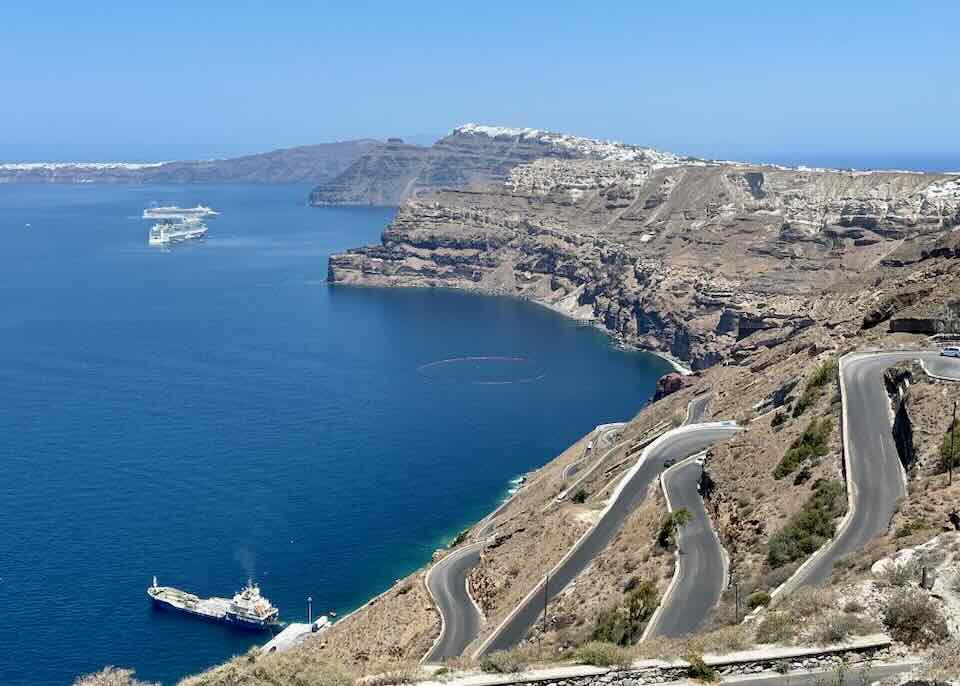
The winding road down to the ferry port.
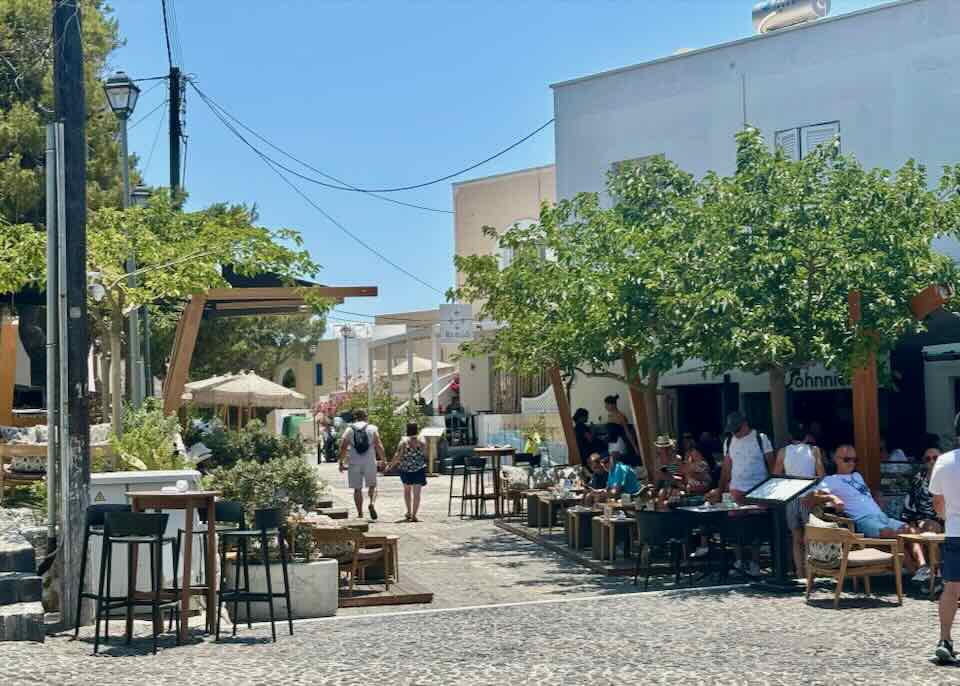
Johnnie’s Cafe in Pyrgos.
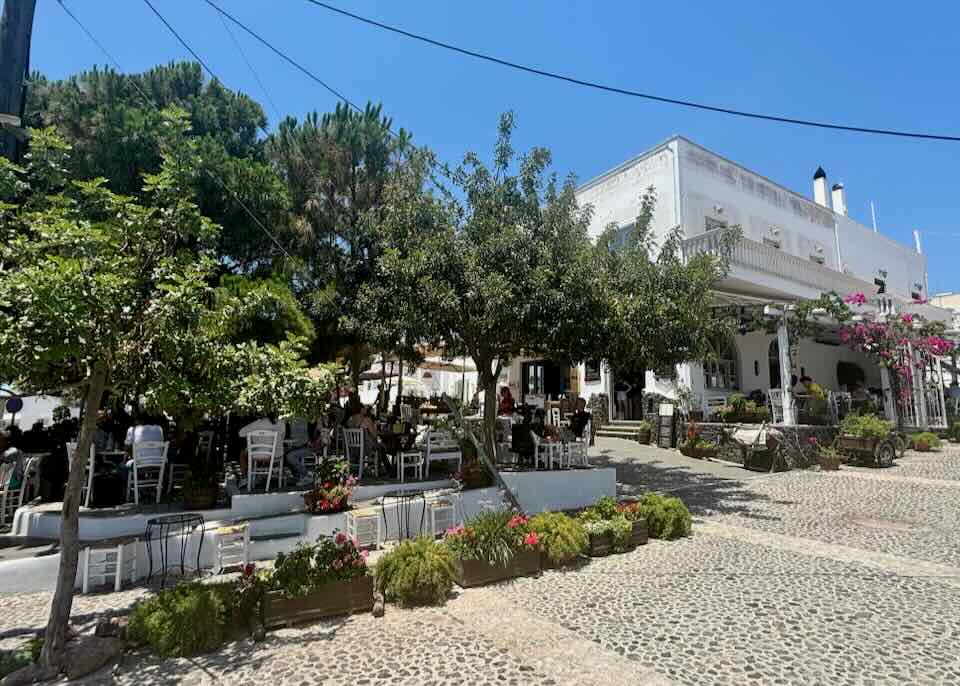
Brusco Wine & Coffee Deli in Pyrgos.
June 19, 2024
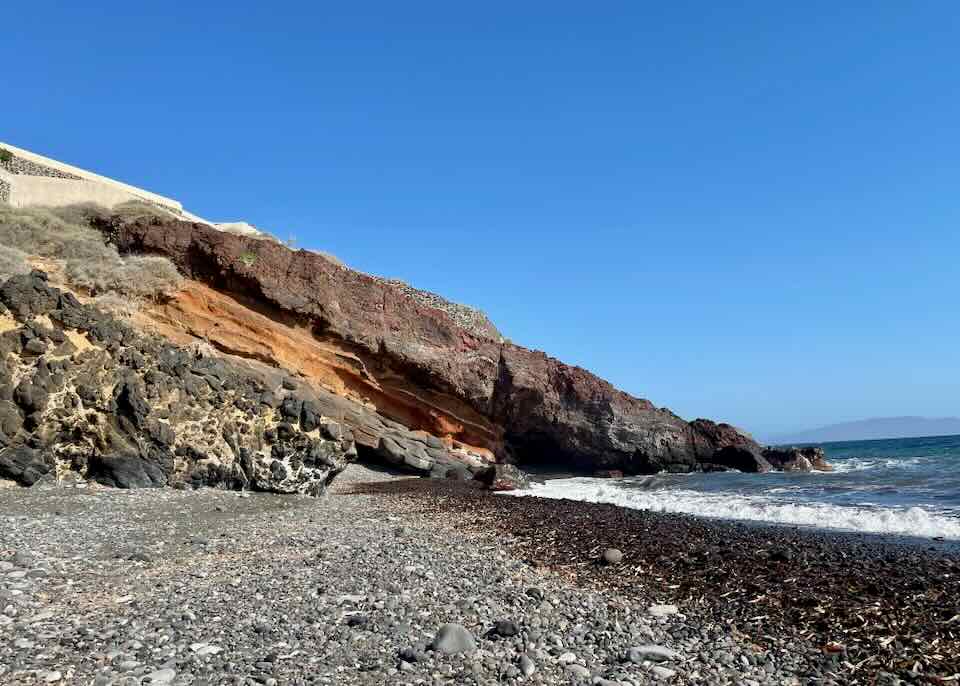
Pori Beach.
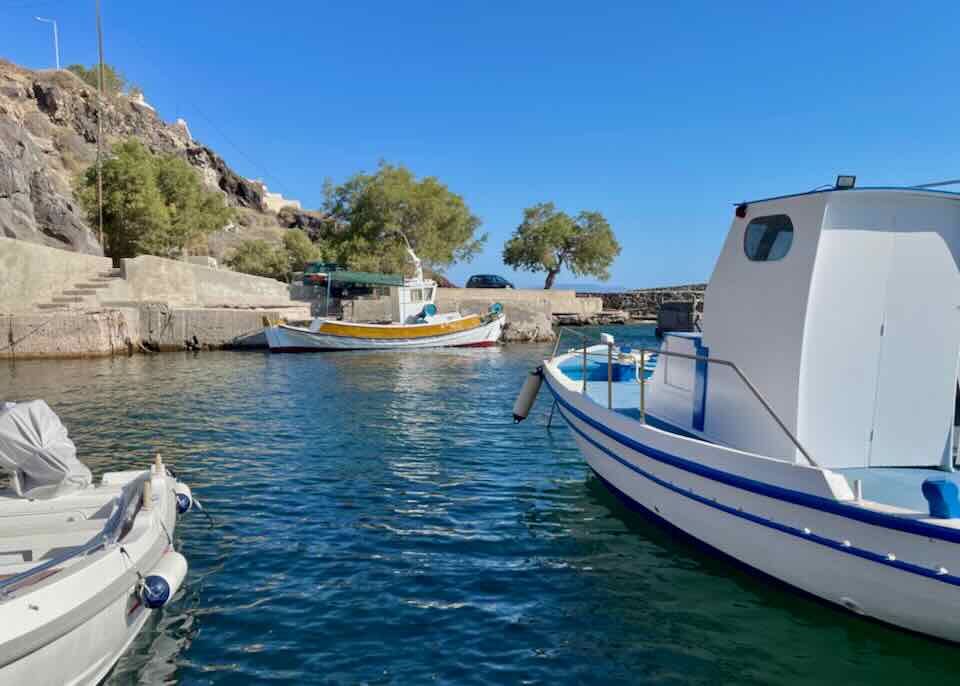
Pori Port.
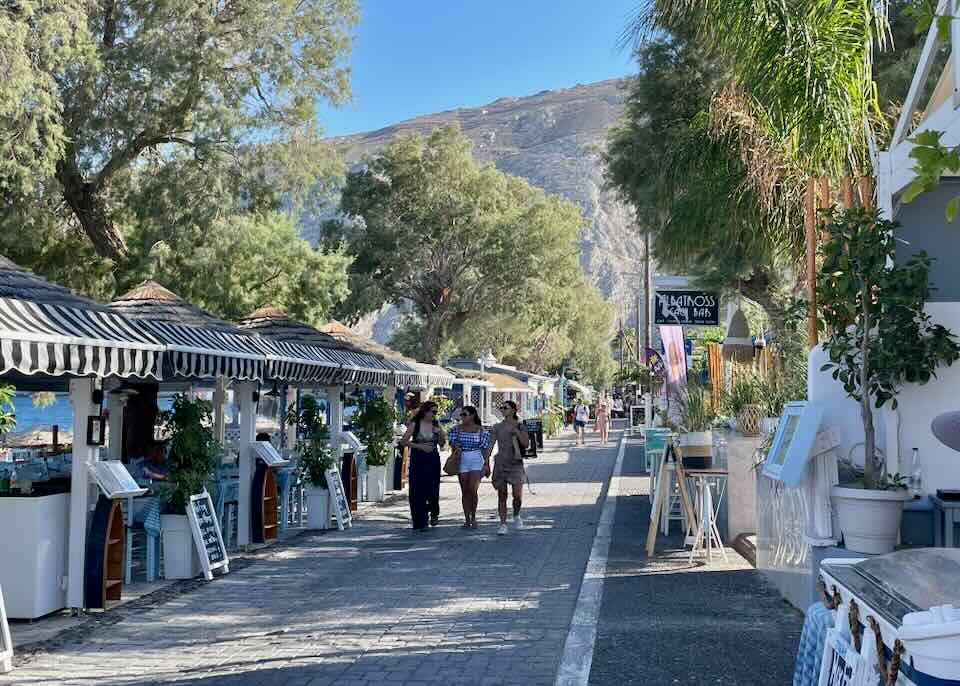
Restaurants and beachfront walkway in Kamari.

Ice cream in Kamari.
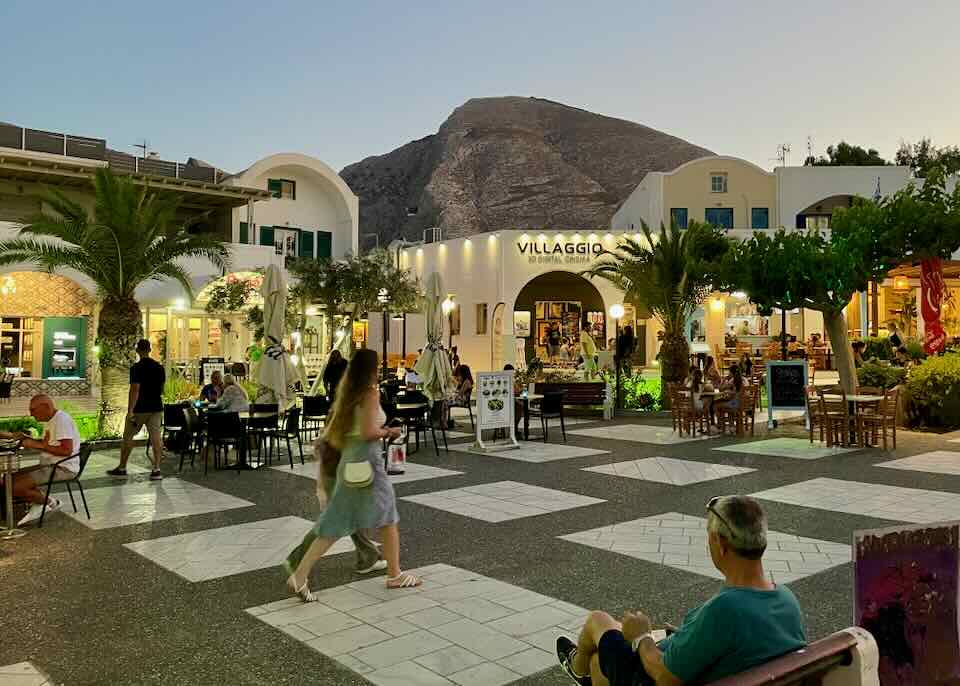
Kamari Square.
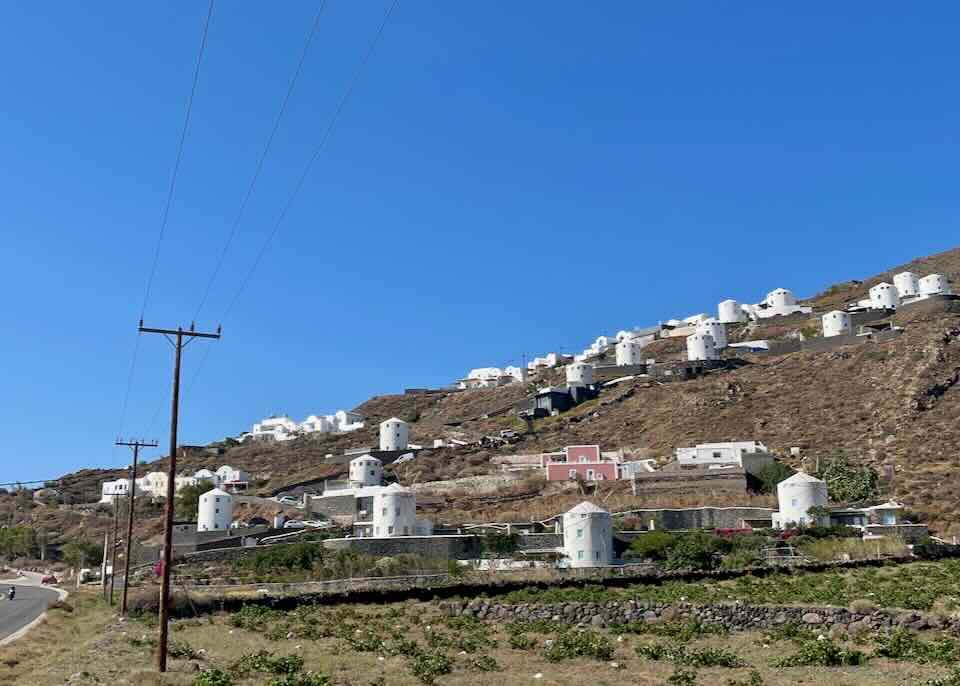
Windmills outside of Oia.

Passaris Bakery in Oia.
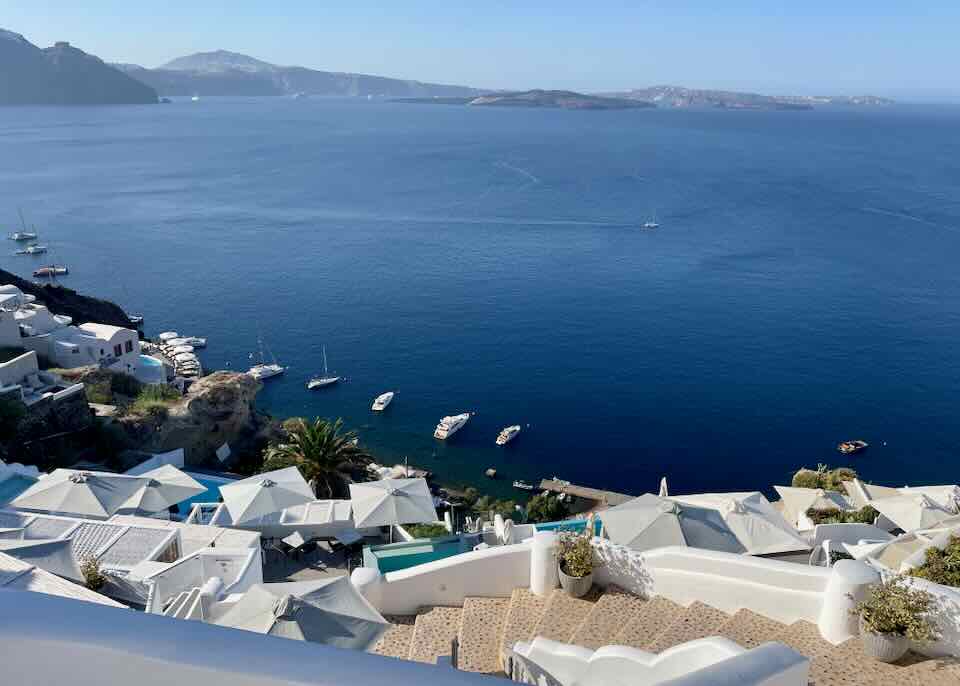
Looking towards Imerovigli from Oia.

A flying dress photoshoot in Imerovigli.
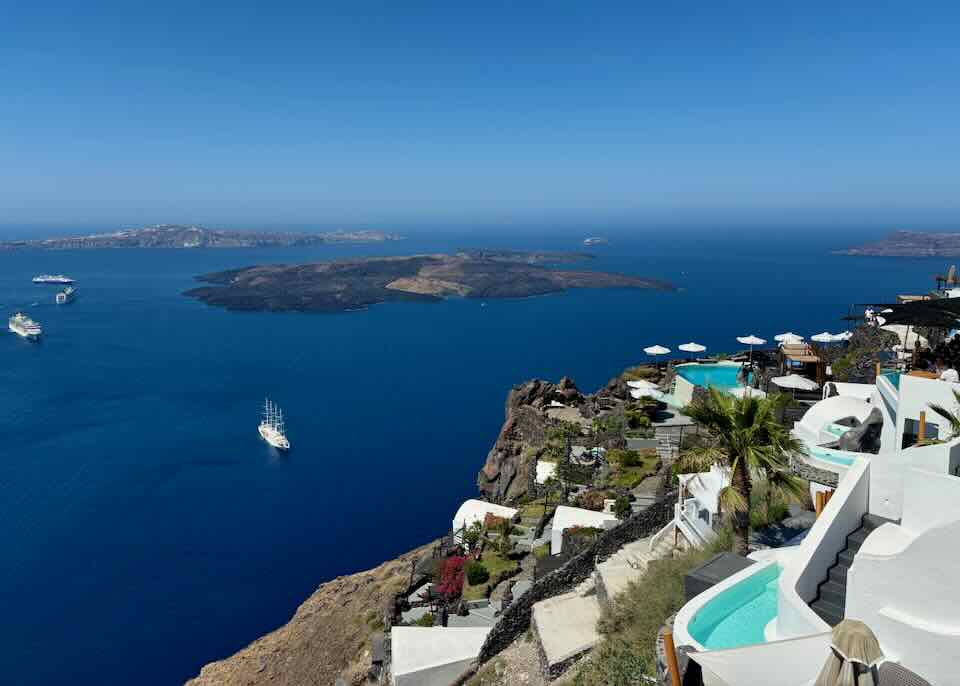
Honeymoon Petra Villas (with the volcano in the background) in Imerovigli.

Imerovigli looking towards Oia, with the pools at Tholos Resort and Astra Suites visisble.
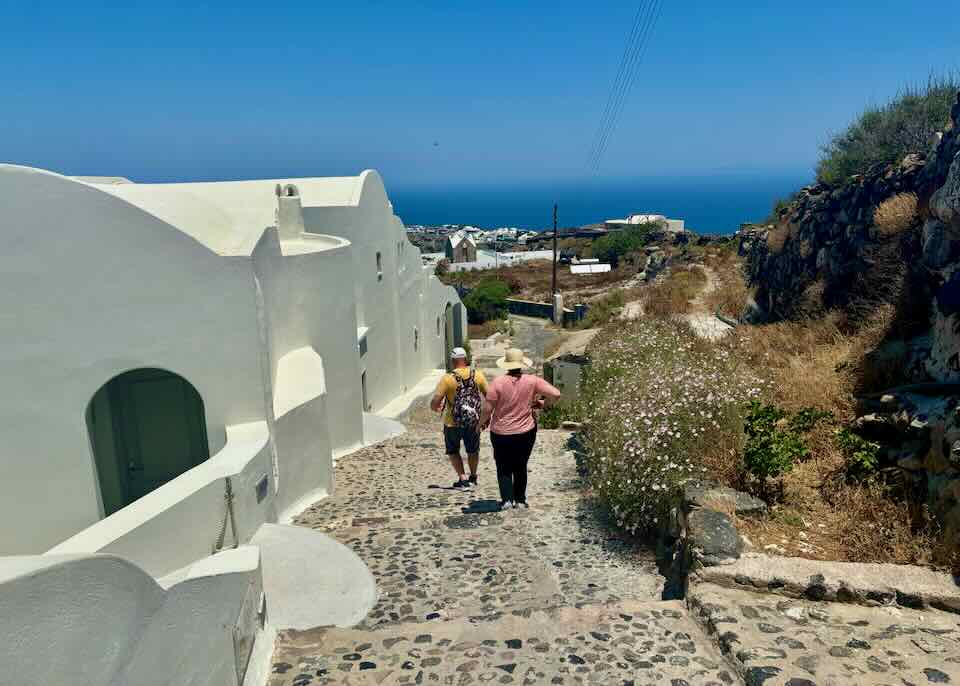
Avaton Resort in Imerovigli and the start of the walking path to Oia.
June 18, 2024

Breakfast at Vitrin Cafe in Oia.

Oia.

Oia.

A lineup for photos in Oia.

Art gallery in Megalochori.
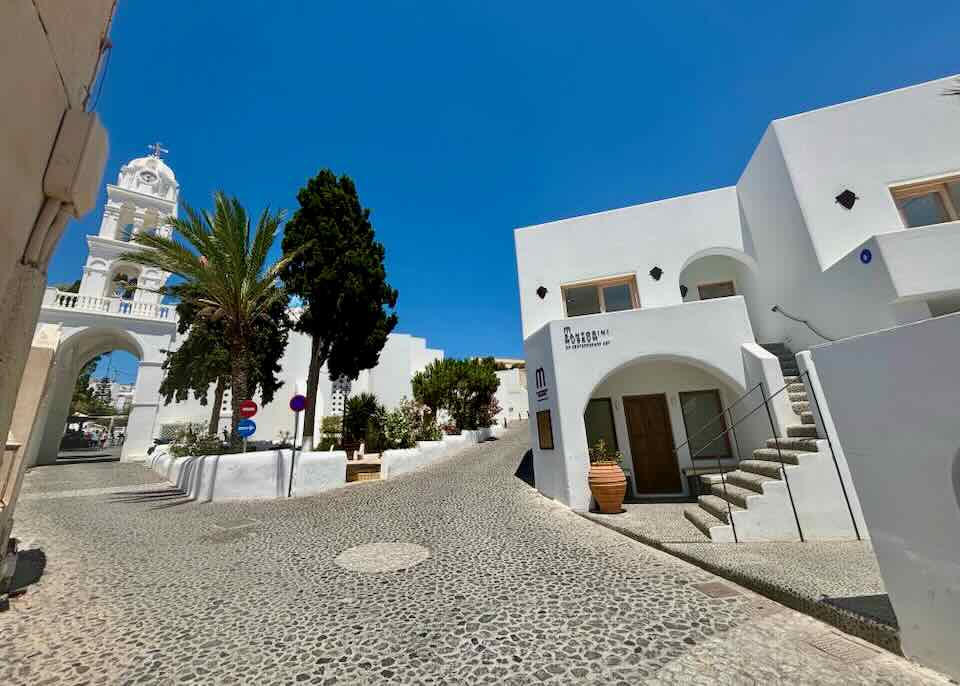
Santorini Museum of Contemporary Art in Megalochori.
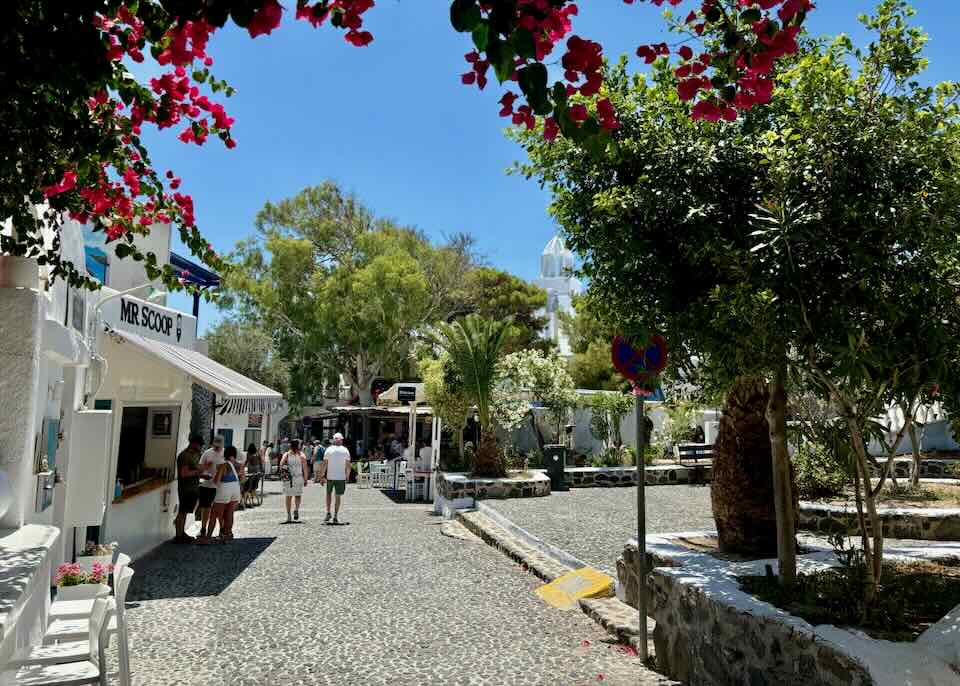
Mr Scoop for great ice cream in Megalochori’s main square.
June 17, 2024
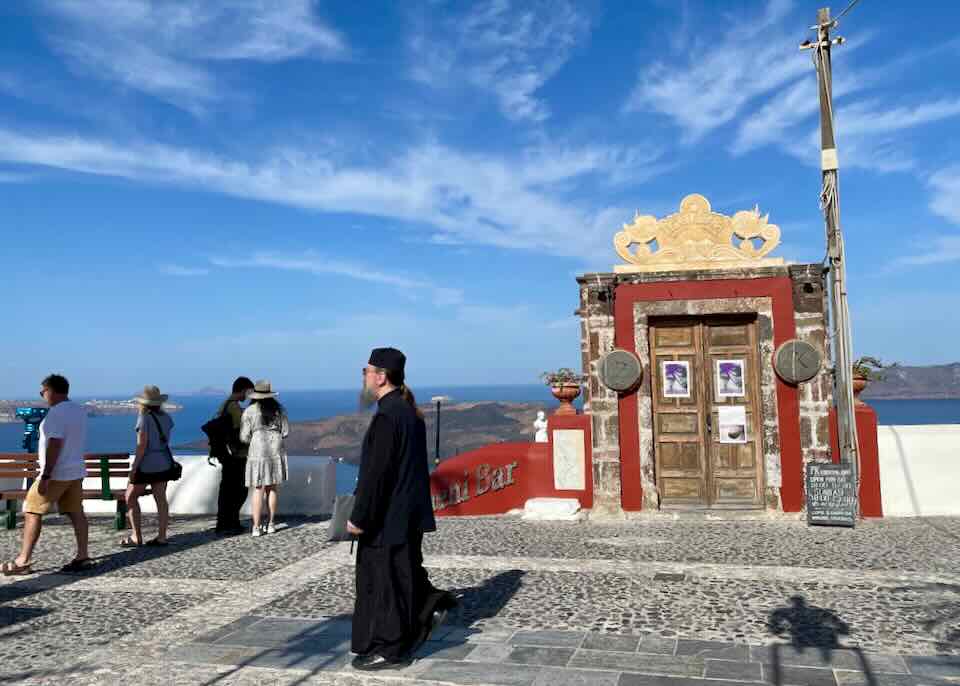
A Greek Orthodox priest walking to work in Fira.

Tourists grabbing some photos.
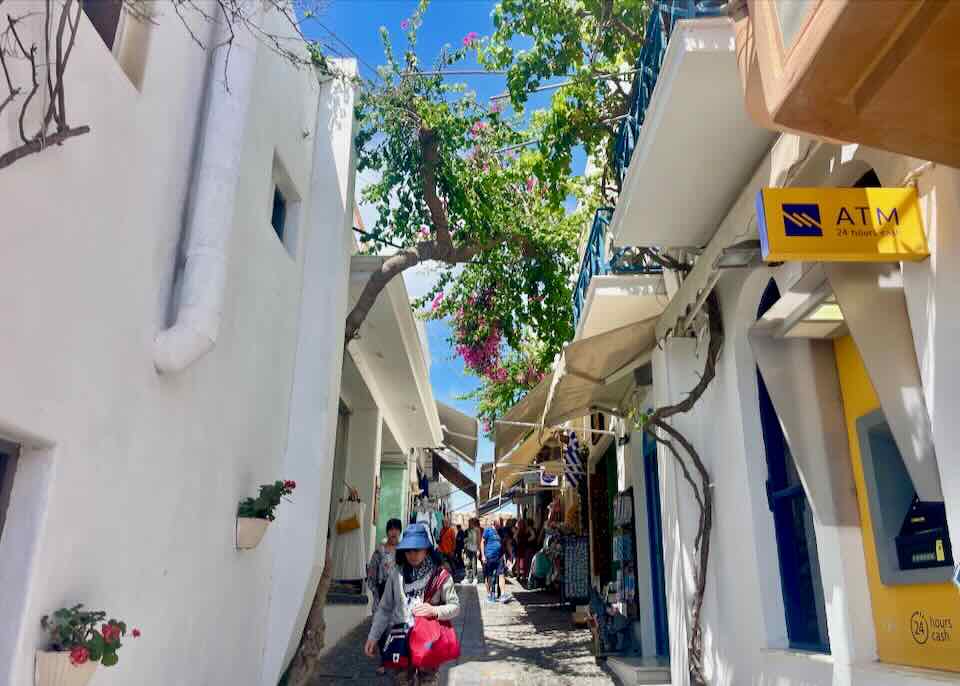
A back alley in Fira.
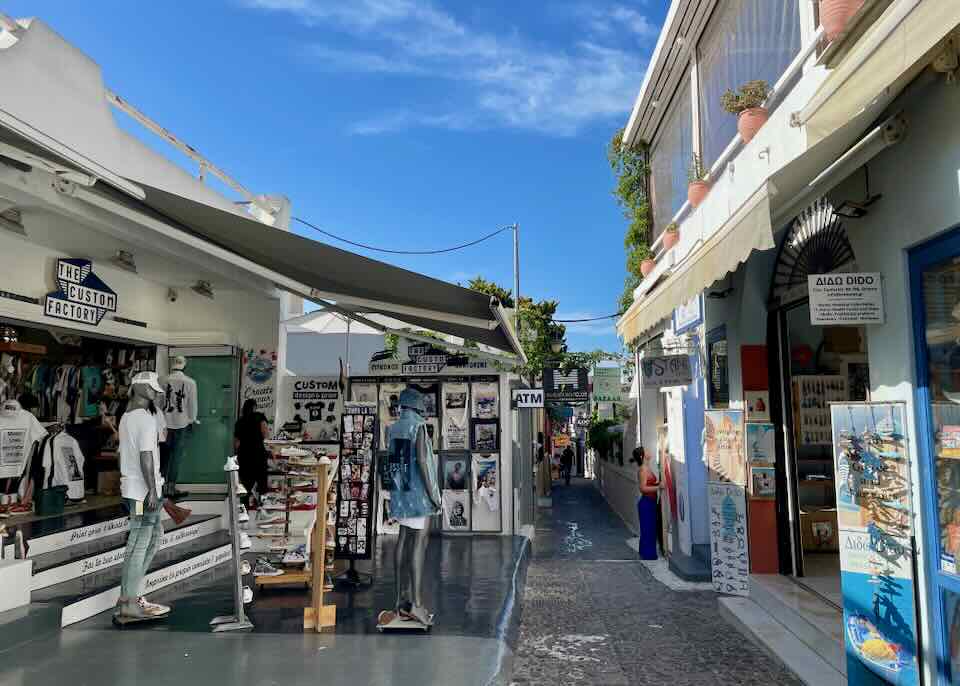
Stores opening for the day in Fira.
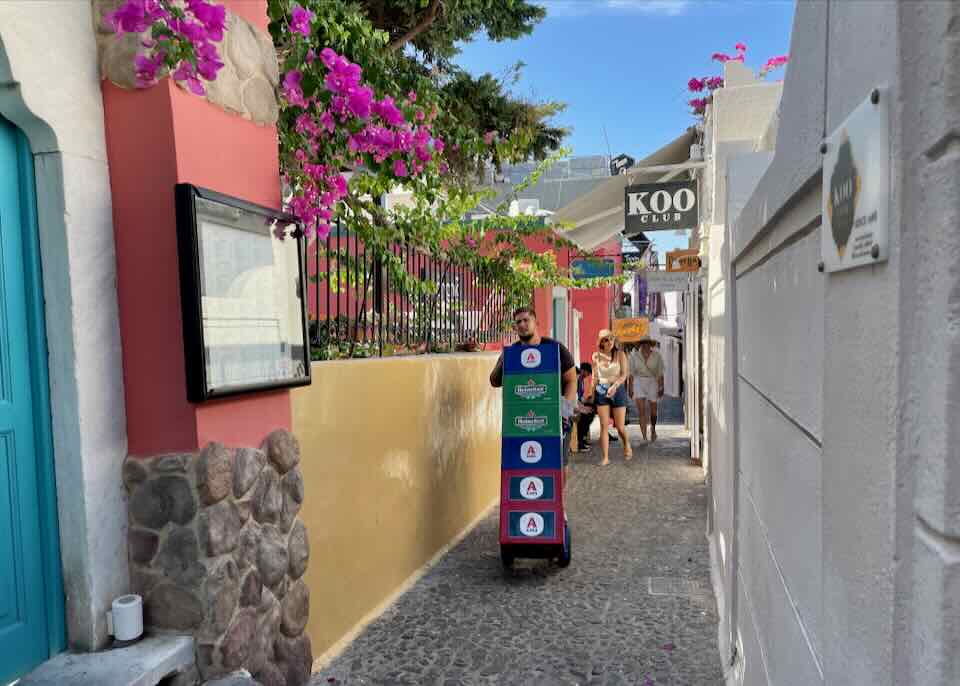
Early morning deliveries in Fira.
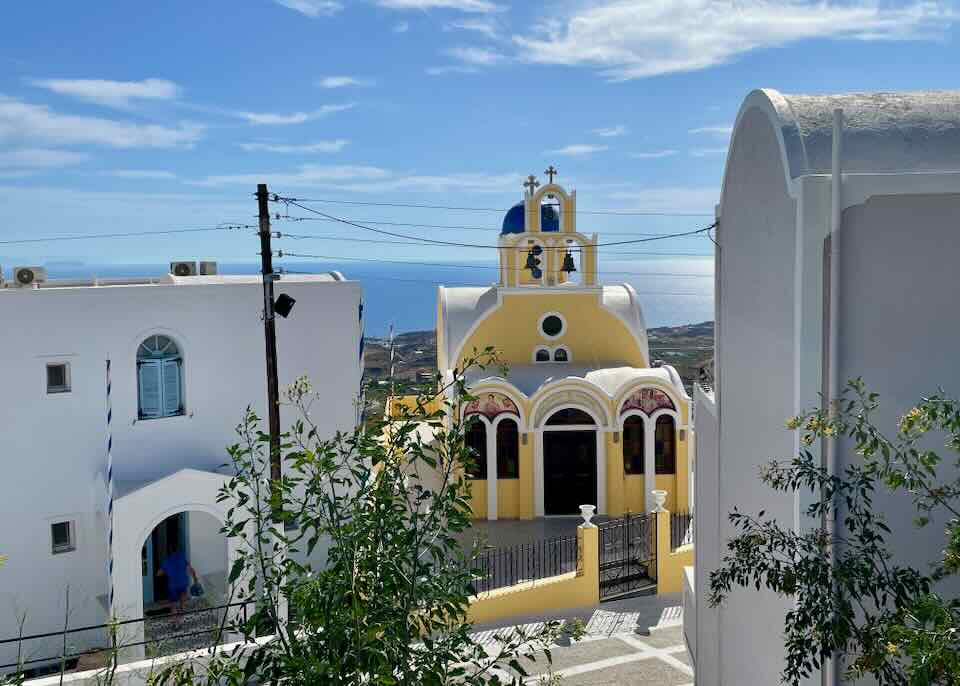
A church in Firostefani.
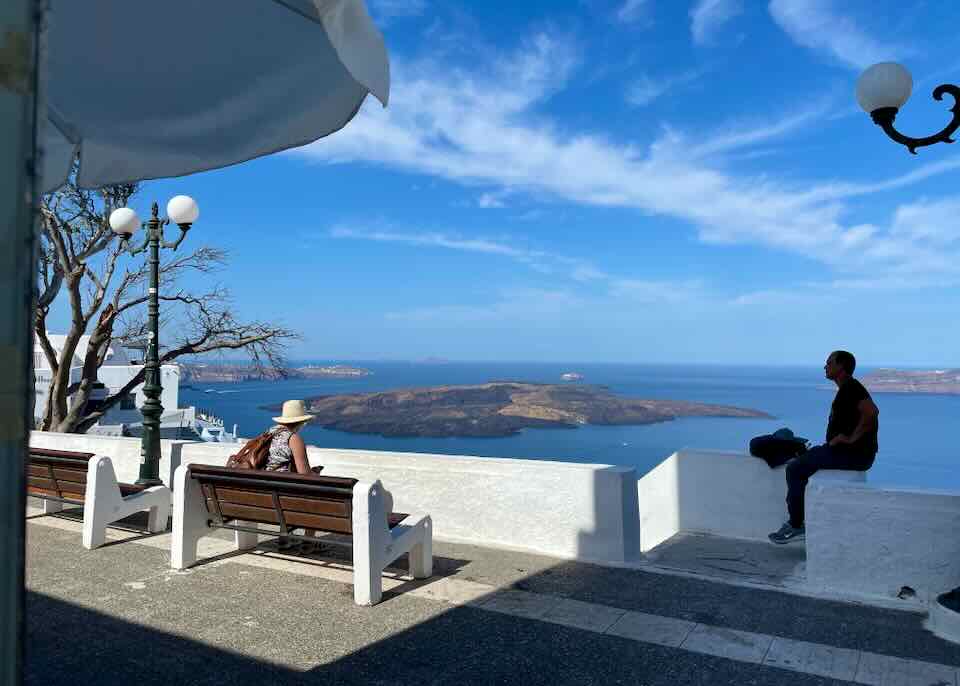
Enjoying the caldera view in Firostefani.
June 16, 2024
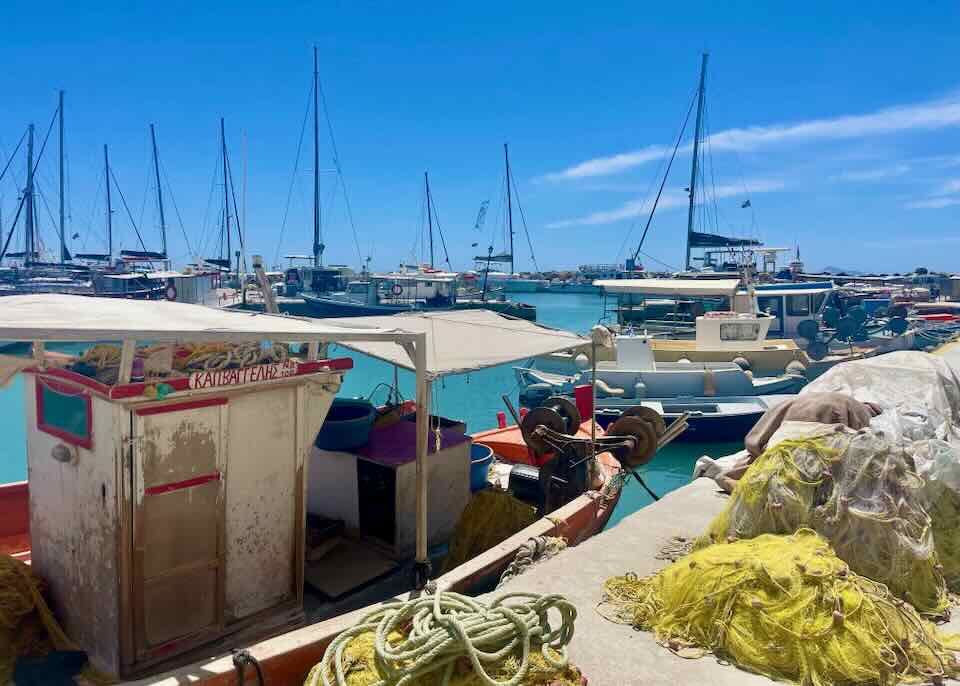
Fishing boat in Vlychada.
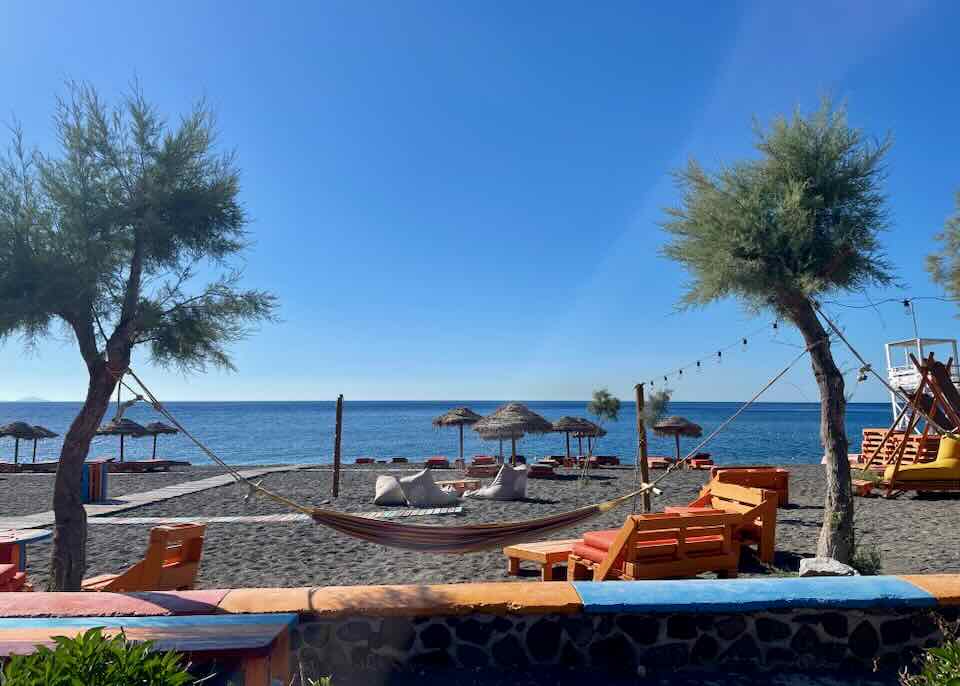
Tranquilo Bar in Perissa.
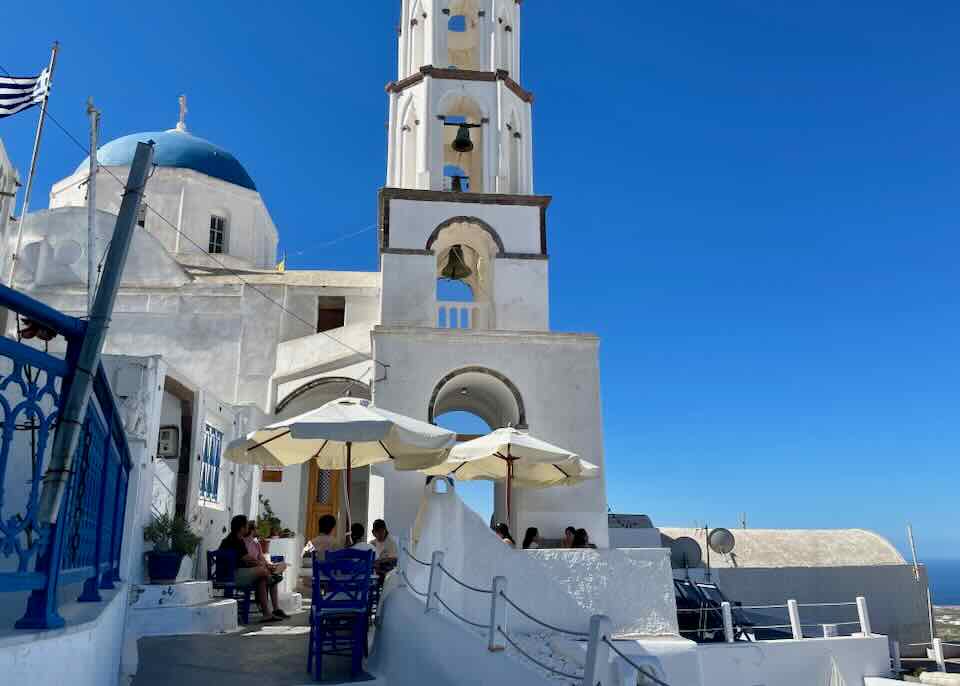
Morning coffee at Penelope’s Ouzeri in Pyrgos.
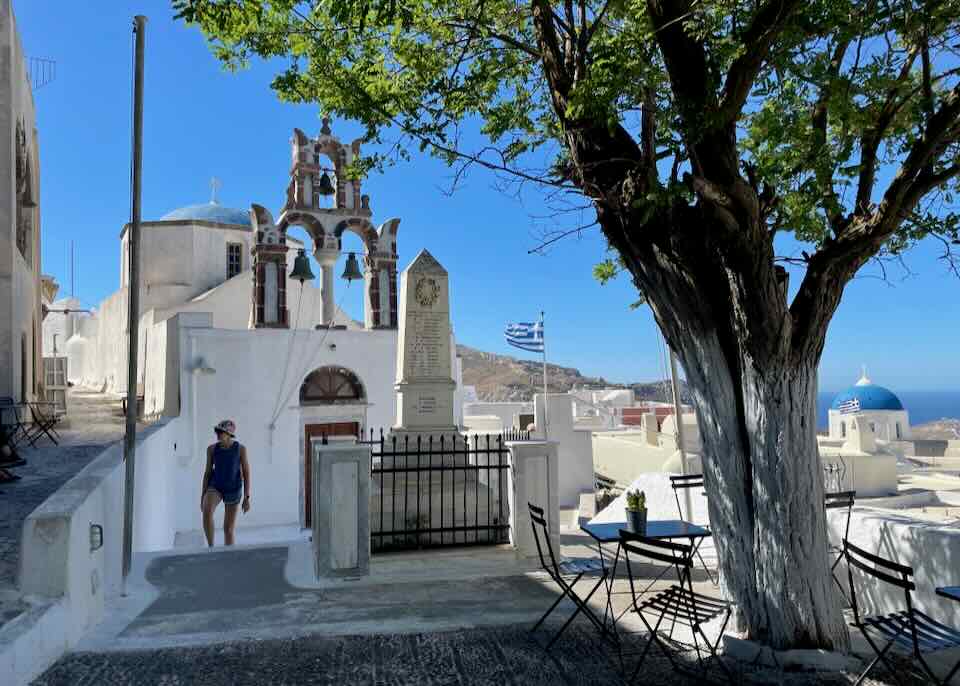
Monument of the Fallen next to the Church of Agios Nikolaos in Pyrgos.
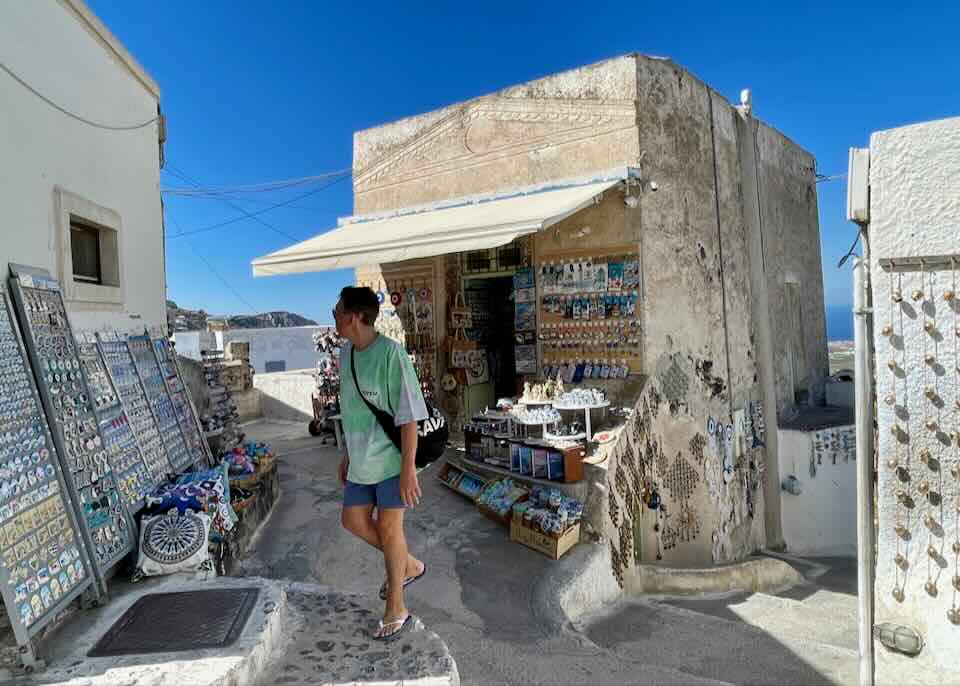
Browsing for souvenirs in Pyrgos.
June 15, 2024

Atlantis Books new location in Firostefani is now open.
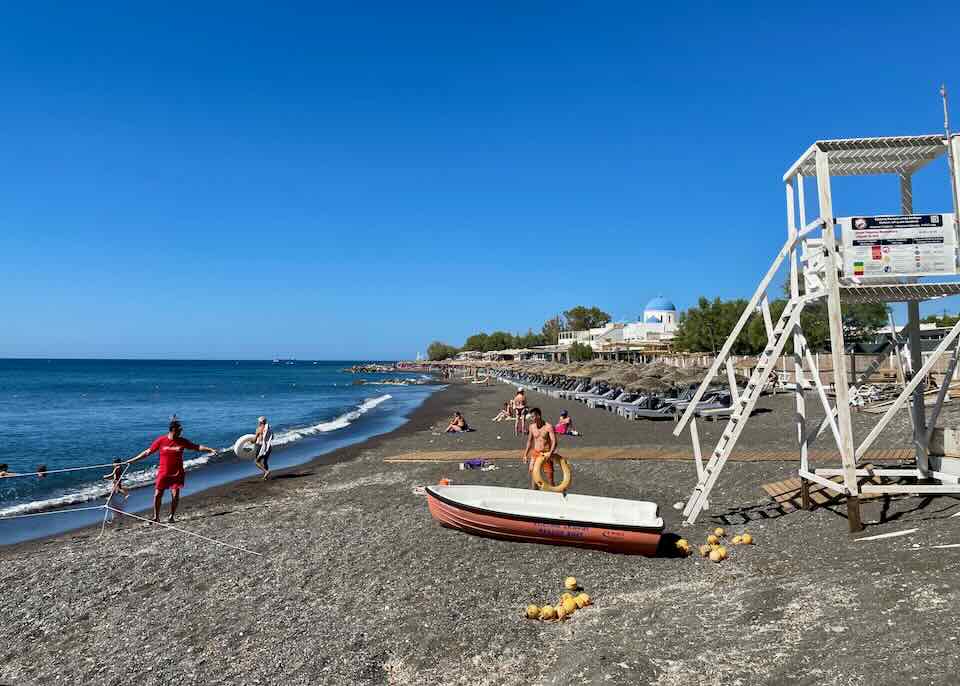
Lifeguards preparing for the day at Perissa Beach.

Santa Irini Bakery in Persissa. Inexpensive and authentic Greek pastries.
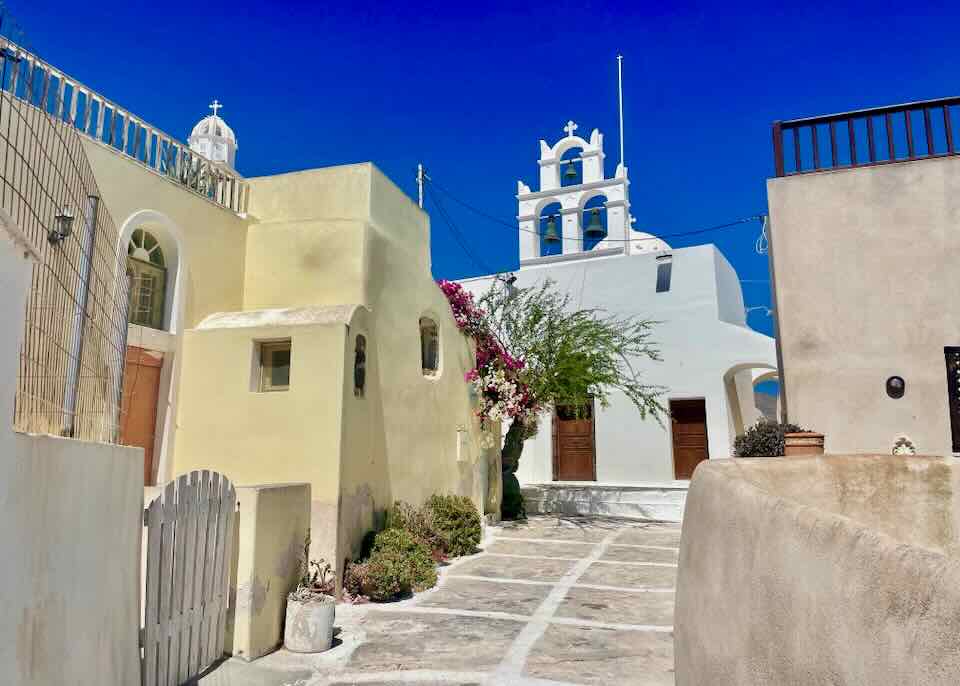
The winding lanes of Emporio’s Kastelli.

Looking from Emporio towards Perissa Beach – the best sand of all the Santorini beaches.

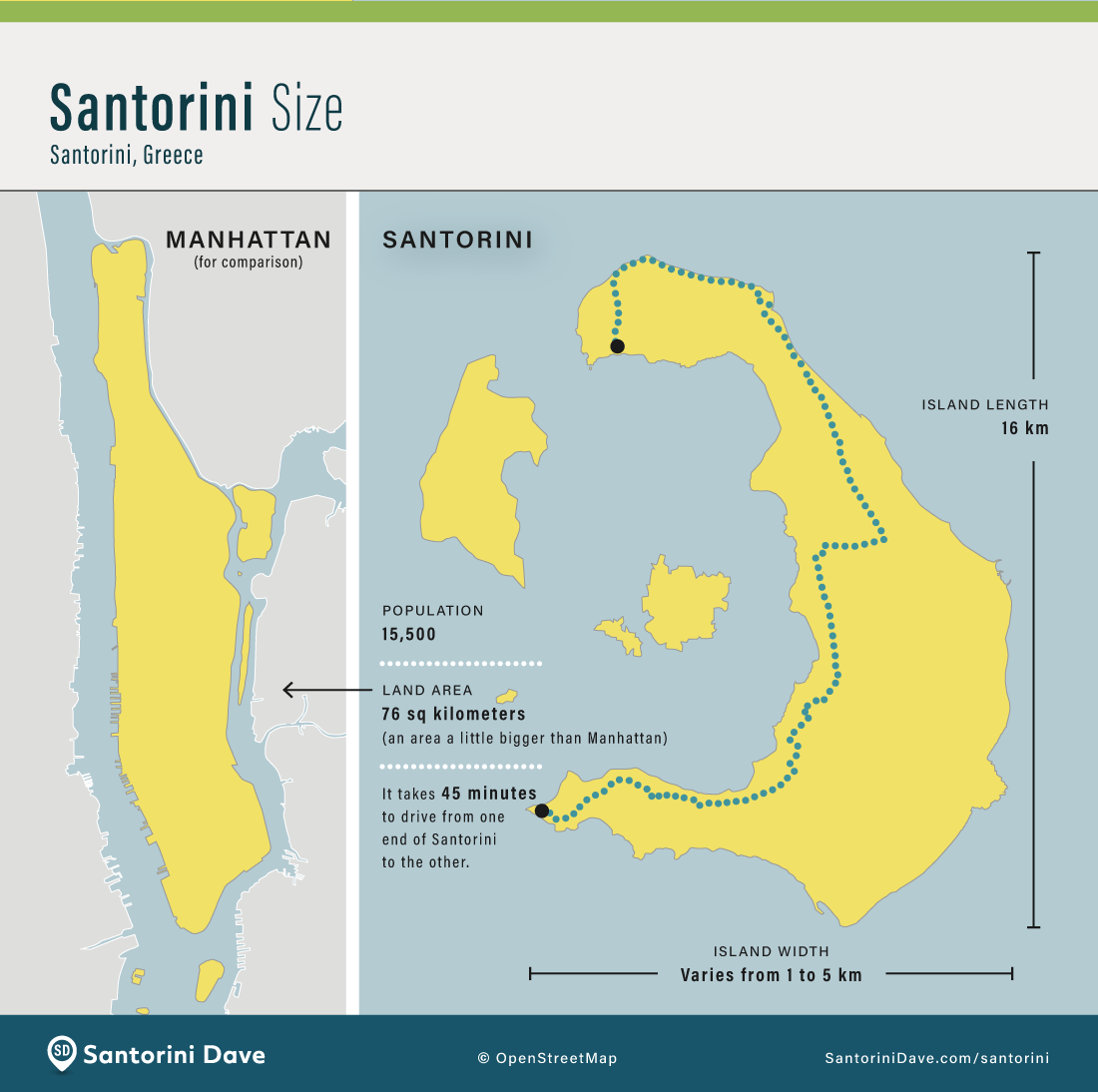


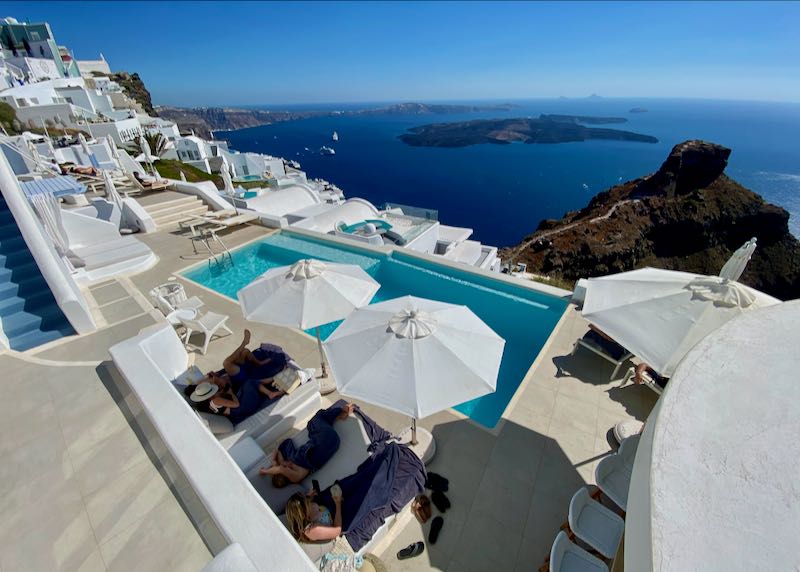
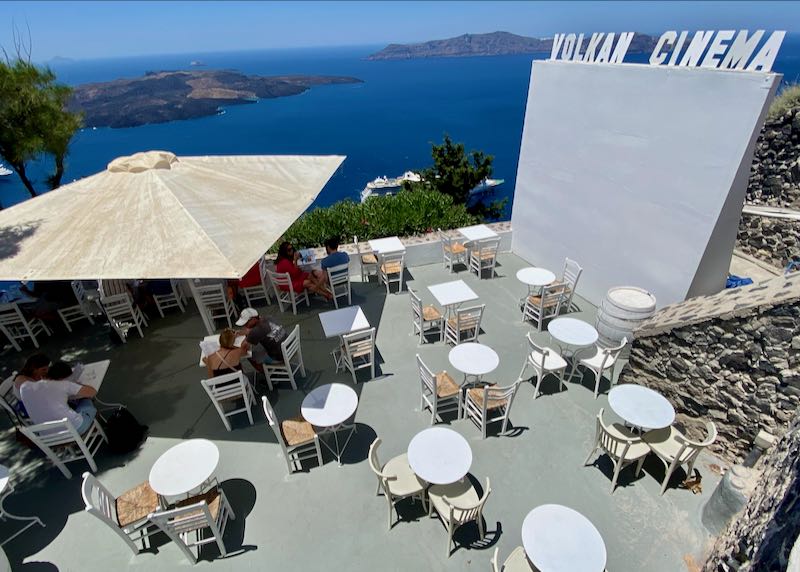
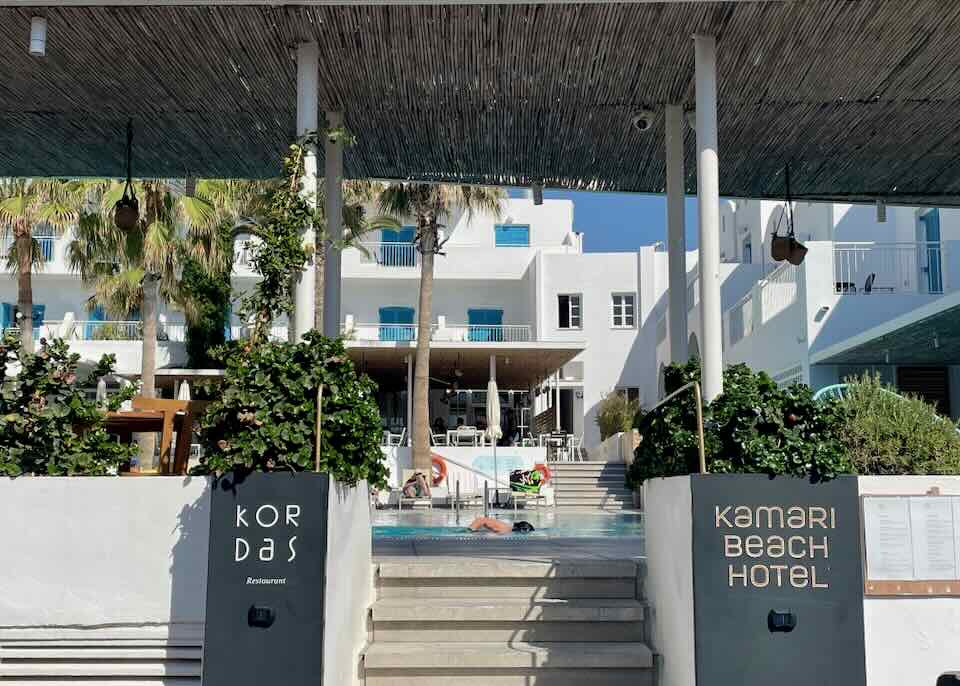
About Santorini Dave